Meeting of the Corporate and Strategic Committee
Date: Wednesday 2 September 2020
Time: 9.00am
|
Venue:
|
Council Chamber
Hawke's Bay Regional Council
159 Dalton Street
NAPIER
|
Agenda
Item Title Page
1. Karakia/Welcome/Notices/Apologies
2. Conflict
of Interest Declarations
3. Confirmation of
Minutes of the Corporate and Strategic Committee meeting held on 10 June 2020
4. Follow-ups from
Previous Corporate & Strategic Committee Meetings 3
5. Call for Minor
Items Not on the Agenda 7
Decision Items
6. Report and
Recommendations from the 12 August 2020 Finance Audit and Risk Sub-committee 9
7. Regional Water
Security Programme – CHB Project 45
8. Cycleway
Co-funding 147
18. 2019-20
Annual Interim Results and Carry Forwards for 2020-21 (Late item to
follow)
Information or Performance Monitoring
9. Organisational
Performance Report for period 1 April to 30 June 2020 153
10. Update on Covid-19: CDEM
Financial Report and Resurgence Planning 235
11. HBRC Covid-19 Response Review
Update 257
12. Regional Drought Relief Fund 261
13. Regional Economic Recovery 265
14. 11.30am Eastern Screen Alliance Deputation:
Building a Regional Screen Industry in Hawke's Bay 277
15. Discussion of Minor Matters
Not on the Agenda 283
Decision Items (Public Excluded)
16. 1.30pm HBRIC Ltd and Napier Port Quarterly Update 285
17. Confirmation of Public
Excluded Minutes of the 10 June 2020 Corporate and Strategic Committee Meeting 287
HAWKE’S BAY REGIONAL COUNCIL
Corporate
and Strategic Committee
Wednesday 02 September 2020
Subject: Follow-ups from
Previous Corporate & Strategic Committee Meetings
Reason for Report
1. On the
list attached are items raised at previous Corporate & Strategic Committee
meetings that staff have followed up on. All items indicate who is responsible
for follow up, and a brief status comment. Once the items have been reported to
the Committee they will be removed from the list.
Decision Making Process
2. Staff
have assess the requirements of the Local Government Act 2002 in relation to
this item and have concluded that, as this report is for information only, the
decision making provisions do not apply.
|
Recommendation
That the Corporate and Strategic Committee
receives and notes the “Follow-up Items from Previous Meetings”.
|
Authored by:
|
Leeanne
Hooper
Team Leader Governance
|
|
Approved by:
|
James Palmer
Chief Executive
|
|
Attachment/s
|
⇩1
|
Followups for
September 2020 CorpStrat meeting
|
|
|
|
Followups
for September 2020 CorpStrat meeting
|
Attachment 1
|
Follow-ups
from Previous Corporate and Strategic Committee Meetings
10 June 2020
|
|
Agenda Item
|
Follow-up /
Request
|
Responsible
|
Status Comment
|
|
1
|
Remit to Local Government New Zealand Annual General
Meeting
|
Support for Hauraki District
Council’s Coastal Hazards remit was emailed within timeframes.
|
J
Palmer /R Graham
|
Support
emailed on 12 June and remit passed by LGNZ AGM
|
|
2
|
Risk Maturity Roadmap
|
Formal launch the proposed Risk Management
Maturity Roadmap with the goal of embedding consistency in risk-intelligent
decision making across all levels and functions of the organisation
|
H
Marsden/ J Ellerm
|
Council
resolved agreement to the implementation of the Risk Management Maturity
Roadmap on 24 June.
FARS
meeting on 12 August received.
|
|
3
|
Health and Safety Governance Charter
|
Report on the status of 2018 Health &
Safety internal audit recommendations
|
K
McInnes /J Palmer
|
Report
provided to 12 August FARS meeting.
|
11 March 2020
|
|
Agenda Item
|
Follow-up /
Request
|
Responsible
|
Status Comment
|
|
4
|
Strategic Bi-lateral Arrangements
|
Chairman
and Chief Executive to put forward a proposal to the HB Local Government
Leaders Forum to establish regular bilateral meetings with each of the four
territorial authorities in the region
|
J
Palmer/
|
Scheduling
has been delayed due to the Covid19 response but will be developed for the
2020-21 financial year.
|
|
5
|
HBRC Agrichemical Collection Service Funding
|
Staff
to investigate options to continue Agrichemical collection on a user pays
basis for commercial users, and contributing to HazMobile collection
events held annually by the district and city councils which target residential
users.
|
J
Blunden / L Lambert
|
Staff
are engaging with District and City Councils around possible contributions or
joint operation of hazmobile collection events. It is anticipated that a new
process will be put forward for implementation in 2021-22.
|
HAWKE’S BAY REGIONAL COUNCIL
Corporate
and Strategic Committee
Wednesday 02 September 2020
Subject: Call for Minor Items
Not on the Agenda
Reason
for Report
1. This item provides the means for committee members to raise minor
matters they wish to bring to the attention of the meeting.
2. Hawke’s Bay Regional Council standing order 9.13
states:
2.1. “A
meeting may discuss an item that is not on the agenda only if it is a minor
matter relating to the general business of the meeting and the Chairperson
explains at the beginning of the public part of the meeting that the item will
be discussed. However, the meeting may not make a resolution, decision or
recommendation about the item, except to refer it to a subsequent meeting for
further discussion.”
Recommendations
3. That the Corporate and Strategic Committee accepts the following
“Minor Items Not on the
Agenda” for discussion as Item 15:
|
Leeanne Hooper
GOVERNANCE LEAD
|
James Palmer
CHIEF EXECUTIVE
|
HAWKE’S BAY REGIONAL COUNCIL
Corporate
and Strategic Committee
Wednesday 02 September 2020
Subject: Report and
Recommendations from the 12 August 2020 Finance Audit and Risk Sub-committee
Reason
for Report
1. The following
matters were considered by the Finance Audit and Risk Sub-committee (FARS)
meeting on 12 August 2020 and are now presented for the Committee’s
consideration alongside any additional commentary the
Sub-committee Chair wishes to offer.
2. The purpose of
the Finance, Audit and Risk Sub-committee, in accordance with its Terms of
Reference, is to report to the Corporate and Strategic Committee to fulfil its
responsibilities for:
2.1. The provision
of appropriate controls to safeguard the Council’s financial and
non-financial assets, the integrity of internal and external reporting and
accountability arrangements
2.2. The review of
Council’s revenue and expenditure policies and the effectiveness of those
policies.
2.3. The
independence and adequacy of internal and external audit functions
2.4. The
robustness of risk management systems, processes and practices
2.5. Compliance
with applicable laws, regulations, standards and best practice guidelines.
Procurement Policy
Amendments to Support the HB Economic Recovery
3. This item provided an update on
progress implementing the management actions in response to recommendations
from the 2018 Internal Audit, the amended HBRC Procurement Policy and Manual,
and provided a 2019-20 year-end report of procurement metrics requested by the
sub-committee.
4. In relation to
amendments made to the Procurement Policy and Manual to strengthen HBRC’s
ability to support the region’s economic recovery,
these included adding evaluation weighting to local purchasing, amending the
Principles to add and emphasise Climate Smart Recovery and best practice
procurement advised by OAG for achieving Broader Outcomes. In addition,
the Policy was amended to raise the CE’s delegation from $50k to $100k
for capital expenditure if funded from the asset replacement reserve.
5. Following
discussions, the meeting resolved to recommend the Policy and Manual for
adoption by the Corporate and Strategic Committee as proposed to FARS.
Risk Assessment and Management
6. In the area of
Risk Assessment and Management, the Finance, Audit and Risk Sub-committee, as
per its Terms of Reference, has responsibility and authority to:
6.1. review
whether Council management has a current and comprehensive risk management
framework and associated procedures for effective identification and management
of the council’s significant risks in place, and
6.2. undertake
periodic monitoring of corporate risk assessment, and the internal controls
instituted in response to such risks.
7. The Risk
Maturity item introduced the draft Risk Management policy and framework in
accordance with the Risk Maturity Roadmap approved by the 10 June C&S and
confirmed by Council resolution on 24 June, as well as outputs of risk maturity
activities completed as outlined in the roadmap. In addition, the agenda item
also provided Crowe’s finalised report on its assessment of HBRC’s
enterprise risk management maturity and reconciled the approved phases in the
risk maturity roadmap recommendations identified in Crowe’s internal
audit report.
7.1. Through
discussions at the meeting it was agreed that the approved risk maturity
roadmap addresses the recommendations from the Crowe Audit report with one
exception being that an internal audit on the assurance framework will now have
to be added to phase three of the roadmap.
7.2. The
Sub-commmittee resolved “confirms it is comfortable that management
actions undertaken or planned for the future adequately respond to the findings
and recommendations of the Crowe Internal Audit – Risk Management
Maturity Assessment report”.
8. The Six-Monthly
Enterprise Risk Management Report provided the six-monthly update of
Council’s enterprise risk profile in a new format. Elements of the
new format risk report included a residual risk rating for each enterprise
risk, control corrective actions and supporting risk information such as known
emerging issues or uncertainties that may impact Council’s risk profile.
8.1. Through the
meeting discussions it was agreed that the new format risk report reflects risk
maturity activities undertaken as outlined in the approved risk maturity roadmap.
It was also noted that the new format risk report will continue to improve and
evolve as the phases in the risk maturity roadmap are delivered, and as the
recently drafted risk management framework is embedded into the business.
8.2. The
sub-committee resolved to receive the report and “confirm
its confidence that Council management has undertaken an effective risk
identification and risk management process for Council’s significant
risks, and that actions taken to date to mature HBRC’s risk management system
are in line with Council’s expectations as provided to the 10 June 2020
Corporate and Strategic Committee meeting in the Risk Maturity Roadmap.”
Internal Audit
9. The
Sub-committee was provided with four items relating to Internal Audit. The Finance, Audit and Risk Sub-committee has responsibility and
authority, in accordance with its Terms of Reference, to:
9.1. confirm the
terms of appointment and engagement of external auditors, including the nature
and scope of the audit, timetable, and fees
9.2. receive the
internal and external audit report(s) and review actions to be taken by
management on significant issues and recommendations raised within the
report(s), and
9.3. ensure that
recommendations in audit management reports are considered and, if appropriate,
actioned by management.
10. The Annual 2020-21
Internal Audit Work Plan presented the proposed work plan for the financial
year along with an overview of similar review/audit activities underway across
the organisation, highlighting:
10.1. Internal audits to be
undertaken in the 2020-21 financial year are a People, Recruitment, Retention
and Wellbeing review, and Data Analytics, and 40 hours will be retained in
order to address any specific new risk area that may arise during the financial
year
10.2. two Section 17a reviews
are in progress, Works Group and Biosecurity, and will be finalised and
reported during 2020-21
10.3. through discussions, the
sub-committee agreed to the Internal Audit programme for the 2020-21 financial
year as proposed.
11. The Cyber
Security Internal Audit Follow-up item provided the sub-committee with
an update on the status of recommendations arising from the Crowe Cyber
Security internal audit report and management actions were taken to address the
risks identified which have been side-tracked by the Covid-19 response.
Also comfortable that IT is addressing the telephone and finance system risks
through implementation of the new systems.
11.1. IT will work with Risk
and Assurance Lead to address IT risks and prioritise IT projects using a risk
based approach
11.2. A resource was requested
through the Annual plan to develop and implement an ICT disaster recovery plan
11.3. Will be presenting an IT
strategy through the long term plan.
12. Following discussions, the
sub-committee resolved “confirms it is comfortable that management
actions undertaken or planned for the future adequately respond to the findings
and recommendations of the Crowe Internal Audit – IT Security
report.”
13. The Data Analytics
Internal Audit Report did not note any significant issues or concerns.
14. The Internal Audits Review
and Action Plan item updated the sub-committee on the status of the Crowe
recommendations arising from previous Water Management, Health & Safety,
Procurement and Contracts Management internal audits, highlighting:
14.1. Of the 18 Health &
Safety management actions identified in the September 2018 Health and Safety
internal audit, seven were partially implemented, and two were yet to be
action. The Health, Safety and Well being work programme for 2019-21 was
updated to address the open actions.
14.2. Management actions in
response to recommendations made in the Water Management internal audit and
subsequent follow-up audit had been closed.
14.3. Two management actions
from the Crowe Procurement and Contract Management internal audits were still
in progress. The contract evaluation performance template is on track to
be implemented n October 2020. While the internal audit monitoring
process to ensure procurement and contract compliance now aligns to the rollout
of an internal assurance framework as part of risk maturity.
2019-20 Annual Report
Audit Plan
15. This item provided an
update on the 2019-20 Annual Report process that Audit NZ is undertaking,
highlighting:
15.1. Despite Central
Government extending the timeframes within which councils must adopt their
2019-20 annual reports, this Council is working toward adoption within the
normal requirement, being on 28 October 2020
15.2. This year the following
key risks and issues will be a main focus of the audit:
15.2.1. Valuation of investments in
HBRIC
15.2.2. COVID-19 impact on public
sector accounting standards
15.2.3. Revaluation of
Infrastructure Assets
15.2.4. Fair Value of other revalued
assets
15.2.5. Changes in the Group capital
structure
15.2.6. Managed Funds Investments
15.2.7. Consolidation process
15.2.8. Adjustments to ensure HBRIC
and NPHL results are correctly incorporated into HBRC's group results
15.2.9. Valuation of investment
properties.
Treasury Report to 30 June
2020
16. This item provided an
update of compliance monitoring of treasury activity and the performance of
Council’s diversified investment portfolios, which highlighted:
16.1. As at June 30, HBRC had
one $2.5m Term Deposit and held $3.6m in its Cheque Accounts. There is a
currently a $5m facility available if required
16.2. In July 2020, HBRC
raised $6.3m in loans with the LGFA as part of normal procedure under the
Revenue & Financing Policy.
16.3. The total capital
invested in Managed Funds at 30 June 2020 was $156.6m, this represents a true
return of $2.6m (1.68%) return on the original investment after adjusting for
inflation & fees, which is available to be returned to the Council
16.4. The Annual Treasury
Reporting requirements will be delivered as part of Annual Report, due to
timing of the year end process and the revaluations of the other investment
assets. This is schedule to be presented in October 2020.
16.5. Further enhancements
will continue to be developed as part of the FARS work programme.
Decision
Making Process
17. These
items were specifically considered by the Finance, Audit and Risk Sub-committee
on 12 August 2020 and are now the subject of the following recommendations to
the Corporate and Strategic Committee.
|
Recommendations
The Finance,
Audit and Risk Sub-committee recommends that the Corporate and Strategic
Committee:
1. Receives and
considers the “Report and Recommendations from the 12 August
2020 Finance, Audit and Risk Sub-committee Meeting”
2. Agrees that
the decisions to be made are not significant under the criteria contained in
Council’s adopted Significance and Engagement Policy, and that the
Committee can exercise its discretion and make decisions on these items
without conferring directly with the community or persons likely to have an
interest in them.
Procurement
Policy Amendments to Support the HB Economic Recovery
3. Adopts the Procurement Policy
and Manual with amendments as proposed.
Risk Maturity
4. Approves both the Risk
Management Policy and the Risk Management Framework as proposed, and as being
appropriate and sufficiently robust to manage Council’s significant
risks.
Reports
Received
5. Notes that the following reports were provided to the Finance
Audit and Risk Sub-committee.
5.1. Six Monthly Enterprise Risk Management Report (resolved: confirms its confidence that Council
management has undertaken an effective risk identification and risk
management process for Council’s significant risks, and that actions
taken to date to mature HBRC’s risk management system are in line with
Council’s expectations as provided to the 10 June 2020 Corporate and
Strategic Committee meeting in the Risk Maturity Roadmap)
5.2. Annual 2020-21 Internal Audit Work Plan (resolved: adopts the 2020-21 Internal
Audit Work Plan as proposed)
5.3. Cyber Security Internal Audit Follow-up (resolved: confirms it is comfortable that
management actions undertaken or planned for the future adequately respond to
the findings and recommendations of the Crowe Internal Audit – IT
Security report)
5.4. Data Analytics Internal Audit Report (resolved: receives and notes the Data
Analytics Internal Audit Report)
5.5. Internal Audits Review and Action Plan (resolved:
confirms it is comfortable that management actions undertaken or planned for
the future adequately respond to the findings and recommendations of the
Crowe Internal Audit Follow-up Audit report).
5.6. 2019-20 Annual Report Audit Plan (resolved: receives and notes the “2019-20
Annual Report Audit Plan” staff report and agrees the Audit Plan as
proposed)
5.7. Treasury Report to 30 June 2020 (resolved: receives and notes the
“Treasury Report to 30 June 2020).
5.8. Sub-committee work programme August 2020 update (resolved:
To receive and notes the
“Sub-committee Work Programme August 2020 Update” staff report).
|
Authored by:
|
Tim Chaplin
Senior Group Accountant
|
Mark Heaney
Manager Client Services
|
|
Leeanne
Hooper
Team Leader Governance
|
Geoff Howes
Treasury & Funding Accountant
|
|
Helen Marsden
Risk and Assurance Lead
|
Annelie Roets
Governance Administration Assistant
|
|
Andrew
Siddles
Chief Information Officer
|
Bronda Smith
Chief Financial Officer
|
Approved by:
|
Jessica
Ellerm
Group Manager Corporate Services
|
|
Attachment/s
|
⇨1
|
Procurement
Policy - Revised Aug 2020
|
|
Under
Separate Cover
|
|
⇨2
|
Procurement
Manual - Revised August 2020
|
|
Under
Separate Cover
|
|
⇩3
|
August 2020
Risk Management Policy
|
|
|
|
⇩4
|
August 2020
HBRC Risk Management Framework
|
|
|
|
August
2020 Risk Management Policy
|
Attachment 3
|






|
August 2020 HBRC Risk
Management Framework
|
Attachment 4
|
















|
August
2020 HBRC Risk Management Framework
|
Attachment 4
|





|
August
2020 HBRC Risk Management Framework
|
Attachment 4
|


HAWKE’S BAY REGIONAL COUNCIL
Corporate
and Strategic Committee
Wednesday 02 September 2020
Subject: Regional Water Security
Programme – CHB Project
Reason for Report
1. This item reports on the outcome of a targeted engagement with the
Tukituki Leaders’ Forum (TTLF) on water storage options in Central
Hawke’s Bay, and presents ‘next-steps’ recommendations for
the CHB Water Storage project, as a subset of the HBRC Regional Water Security
Programme, based on technical analysis while taking into account the outputs of
the TTLF and the views of staff.
Officers’ Recommendation(s)
2. Council officers recommend that the Committee agrees to:
2.1. temporarily
suspend any further investigations or assessment of above-ground water storage
sites (as shortlisted by T&T) pending the earlier of either further
analysis of the costs and benefits of smaller scale storage or the outcome of
the Managed Aquifer Recharge Pilot Study
2.2. urgently
progress the Managed Aquifer Recharge Pilot, and
2.3. requests that staff undertake further engagement with the CHB
community to develop broader non-storage policy solutions and interventions for
achieving water security in that District.
Executive Summary
3. At the request
and recommendation of the Central Hawke’s Bay District Council (CHBDC)
project staff initiated an independently-facilitated process with the Tukituki
Leaders’ Forum. The purpose of this engagement was to help inform
investigations into potential above-ground water storage options for the
Ruataniwha plains area. CHBDC felt this approach was the most appropriate way
to re-visit water storage solutions in a post-Ruataniwha Water Storage Scheme
(RWSS) operative Plan Change Six environment.
4. On 31 July,
after five workshops (including two conducted online through the national
lockdown period), an independent facilitator conducted an options evaluation
conference. Valuable insights were gained through the process and the final
outputs provide staff with confidence to recommend that this project does not
progress any of the shortlisted small to medium scale storage sites to
prefeasibility at this time.
5. The technical
assessment has highlighted just how challenging above-ground water storage is
in CHB. With a clear preference from the TTLF in creating a higher volume of
water through storage, the smaller sites as a multi-storage option, even if
technically viable, are unlikely to be economic.
6. The original
RWSS site, either at the 90M m3 or as a low dam option at 19M m3 (which is
below the level that inundates the DoC land), is subject to challenges and
constraints beyond the influence of staff. Without both a change of policy and
political will at national level further investigations of this site are
outside the scope of the project by virtue of funding arrangements with the
Provincial Growth Fund.
7. Accordingly, staff believe, in the absence of a specific change of
policy or direction from central government, that the Managed Aquifer Recharge
Pilot which has continued to be advanced since being presented to Council
proceed with urgency so that its technical viability and social license can be
tested.
Water Security Programme - Recap
8. At a strategic level, the ambition of the Regional Water Security
Programme is to deliver freshwater supply and demand solutions/interventions to
ensure the sustainable management of this most critical resource. The objective
of the programme has been defined as “Hawke’s Bay has
long-term, climate resilient and secure supplies of freshwater, for all.”
9. The core of the
programme is the HBRC’s Regional Water Assessment. This project combines
detailed data analysis from across the region and analyses a range of water
security options to create a decision-making tool and report that in turn will
inform a community engagement process. The broader Hawke’s Bay community will
be engaged on this report and its recommendations. We intend to hold an
informed community conversation to understand community preferences for
interventions on both the demand and supply side of the water
balance equation.
10. In parallel with the development
of the Regional Water Assessment, the project team is investigating and
validating a range of viable water storage options that could, if and when
appropriate, be advanced through to feasibility and construction alongside the
community’s preferred non-storage solutions. Based on hydrological
studies and the absence of a range of potential above ground storage sites, in
the case of CHB we are also exploring the viability of below-ground water
storage through a Managed Aquifer Recharge Pilot.
11. The structure and approach
of the Regional Water Security Programme can best be illustrated as follows.

12. Staff have engaged
Wallbridge Gilbert Aztec, who specialise in groundwater replenishment hydrology
and engineering projects, to support an ambitious work programme to establish a
full MAR site as a field pilot within the next 12 months.
13. Establishment of a MAR
site is technically, politically, and culturally complex and involves much of
the same activity to establish any other storage site including technical
identification and verification of site, environmental assessment and consent
processes. A key focus of the field trial is to not only test the technical
viability and effectiveness of MAR to replenish the aquifer and “add more
water to the system” but also to confirm social license to operate.
14. The project has been
progressing technical investigations to identify promising areas to establish a
potential MAR site. Staff are commencing engagement with selected groups
and iwi to gauge their support and concerns. This represents the critical path,
as whilst it has been used more extensively overseas, it is relatively new to
New Zealand and requires community support and acceptance if it is to be a
potentially viable option.
Discussion
Tukituki Leaders’ Forum
15. The
Tukituki Leaders’ Forum (TTLF) was established as a joint initiative
between CHBDC and HBRC. The forum operates under Terms of Reference which
describes its purpose as follows.
15.1. “The
Forum has been convened to provide community views, perspectives and insights
on the options and impacts of Hawke’s Bay Regional and Central
Hawke’s Bay District councils’ (The Councils) policies, plans and
practices with regard to water, land and infrastructure management in the
Tukituki catchment.
15.2. The
Forum was formed by invitation from the Chair of the Hawke’s Bay Regional
Council and Mayor of the Central Hawke’s Bay District Council.
15.3. The
Forum is an invited group of community leaders who are being asked to think to
the future and to provide feedback that influences the Councils’
activities relevant to the group’s mission statement:
15.3.1. To create a unified
approach to enhancing the mauri of the river by improving water quality and
security through proactive land and water management in the Tukituki catchment.
15.4. The
Forum is not a decision making group and are not able to direct Council
resources nor write or change Council policy. Instead, the group will meet
regularly and form an important reference and feedback panel for Council
activities with respect to water, land and infrastructure management in the
Tukituki catchment.
15.5. The
Forum will consider and discuss issues to ensure that local iwi/hapu, community
and primary sector groups are involved and have the opportunity for input and
to provide comment on the work of the group.”
16. The group
comprises 17 ‘voting’ members with considerable resourcing,
attendance and support being provided by both Councils. The ToR records the
following position statement in relation to membership:
16.1. “As
a community leaders’ Forum, members are expected to convey ideas and
perspectives from their wider community networks. However, the views expressed
by members will be assumed to be their own and not attributed to any group. As
the Forum is not a decision making body no attribution of views is
required.”
17. In anticipation of the
formal execution of the CHB Water Security Project funding agreements with the
PGF, on 13 February HBRC presented an outline of the project to a CHBDC
councillor workshop. It was CHBDC’s firm view that the CHB project be
initially worked up with the TTLF and that a preferred independent facilitator
be engaged to direct this work. As a result of that workshop, members of the
water security project attended a meeting of the TTLF on 18 February where an
overview of the Water Security Programme was provided and the forum’s
consent to incorporate water security into its own work was sought and granted.
18. An independent
facilitator, Catalyze APAC Ltd, was engaged on the basis of its expertise in an
approach to structured decision making known as ‘Multi Criteria Decision
Analysis’ and guided the TTLF through the following steps.
18.1. agree a problem
statement
18.2. develop evaluation
criteria for water storage options
18.3. review a recommended set
of desktop water storage options provided by Tonkin and Taylor.
18.4. evaluate the options
using Multi Criteria Decision Analysis (MCDA) and Decision Conferencing.
19. The first
independently-facilitated session took place online on 28 April with four
attended sessions on 12, 19, 26 May and 16 June. A final Options Evaluation
Conference took place on 31 July, the results of which will be summarised
shortly and are attached.
Tonkin and Taylor CHB Water Storage
Assessment
20. Immediately prior to the
March Covid-19 lockdown, Tonkin and Taylor (T&T) were engaged to complete
an engineering assessment of potential community storage sites for the
Ruataniwha Plains. The storage sizes considered were to reflect the required
storage volume(s) to maintain current water availability and reliability, and
the opportunity to supply additional water (‘new’ water) where a
site appeared to support that.
21. This study considered and
built on previous water storage work in the area by HBRC and, specifically, the
Ruataniwha Plains prefeasibility studies undertaken by T+T in 2008, 2009 and
2011. While those prefeasibility studies were focused on larger scale community
storage schemes to service increased water demand and development on the
Ruataniwha Plains, a number of previously considered sites were deemed
potentially suitable for smaller community scale storage. These smaller schemes
were reassessed against the 2020 Regional Water Security Programme
project’s objectives and criteria.
22. Specifically,
T&T’s brief was to identify and provide a high level assessment of
potential water storage sites to release water into the Tukituki River and its
main tributaries across the Ruataniwha Plains (i.e. Mangaonuku Stream, and the
Waipawa, Tukipo and Makaretu rivers) to meet the following objectives.
22.1. Provide current consent
holders with a more secure and reliable water supply that reduces the
likelihood and severity of minimum flow restrictions (as set by the operative
Plan Change 6).
22.2. Support stream flows
sufficient to protect water dependent ecosystems and improve the overall health
of the Tukituki catchment’s waterways.
22.3. Identify and deliver a
means of providing ‘new’ water to the catchment sufficient to:
22.3.1. Promote community and iwi well-being
through improved access to a new allocation of water available at times of high
and medium flow.
22.3.2. Support the region’s
economic growth and resilience to changing climatic/economic environments.
23. It is important to note
that T&T’s approach was to assess and rank potential sites on typical
technical engineering considerations for water storage projects.
Non-engineering criteria were to be developed and assessed by the TTLF. In
addition to a TTLF workshop presentation in June, the final report was provided
to forum members prior to the 31 July Evaluation conference. The report was
provided in-confidence on the basis that potentially affected landowners
had not been advised of the report’s initial findings.
24. However, based on
staff’s recommendation that no site is investigated further at this stage
the full report is attached for reference.
Options Evaluation Conference 31 July 2020
25. Guided by
T&T’s engineering-focussed desktop analysis, the evaluation
conference ‘bench-tested’ decision criteria for CHB water storage
developed and agreed by the TTLF and reproduced here (see section 4.4. of
Appendix A in the T&T report).
|
Criterion
|
Description
|
|
Environmental
impact
|
The
extent to which the option creates negative impacts on the environment within
the catchment area, because of the facilities created and areas downstream
from the storage facility(ies).
This
criteria excludes any consideration of land use impacts from the use of the
stored water.
|
|
Environmental
benefits
|
The
extent to which the option creates positive impacts to the environment within
the catchment area. Considerations include (amongst others) benefits to
surface and groundwater, the creation of habitat, the extent to which the
option fosters biodiversity, and the extent to which the options benefits the
mauri of the river(s).
|
|
Social
Benefits
|
The
extent to which the option provides social benefits such as access to healthy
drinking water and other community benefits, including those specifically
applicable to Maori (Tikanga and mahinga kai)[1]
|
|
Supply
Certainty Benefits
|
The
certainty that the storage will be filled. This includes consideration of the
probability of recharge both now and in the face of climate change.
|
|
Economic
Benefits
|
The
extent to which the option provides economic benefits. This includes both
consideration of the amount of economic benefit created and the diversity of
the economic benefits.
|
|
Future
Proofing
|
The
extent to which the option is adaptable, will be sustainable and resilient to
environmental catastrophes such as earthquakes and other natural events that
could impact its continued operation.
|
|
Establishment
Risks
|
The
extent to which the option is exposed to risks in its establishment
|
|
Ongoing
Risks
|
The
extent to which the option is exposed to risks in its on-going operation.
This
excludes risks associated with natural events which are considered under
future proofing.
|
26. Considerable thought was
given as to the inclusion or exclusion of the original RWSS Makaroro site (A7)
for the purpose of the exercise. This site presented a theoretically viable
option denoted A7 (19) – namely a 19m m3 “low dam” option
that did not impinge on the DoC land that the Supreme Court effectively excised
from the RWSS project.
27. In addition, the TTLF
facilitator was of the view that the time and effort invested in conducting an
Evaluation Conference is relatively significant compared to the incremental
time in evaluating an additional option. It was felt the advantage of comparing
A7(90Mm3) as a hypothetical option against other options is it enabled Forum
members and other stakeholders to understand how A7(90Mm3) would compare if it
were possible to construct and fill it. Noting that several of the shortlisted
sites were only theoretically viable but needed to survive technical,
environmental, economic and social thresholds before becoming
“real” options, the decision was taken by the Forum to include the
original 90m m3 site – A7 (90) – in the interests of thoroughly
testing the evaluation criteria.
28. The
appended report provides a full account of the process and outcomes.
Importantly, the facilitator concluded that the criteria held up well to the
exercise and that the results indicated that the criteria were consistently
applied and provided stable results. The report has this to say (pg 27).
1.1.1 Overall Preferences
The overall preferences, all criteria
being considered, show us the following results.
The criteria in the list below drive the
overall results because of the differences in how options perform against these
criteria and the Forum’s preferences for those differences (the order is
from highest weight to lowest weight):
Environmental
Benefits
(reducing) Environmental
Impacts
Future Proofing
Economic Benefits.
The Forum weighed the benefits and risk
(minimisation) significantly greater than the costs.
Overall, the Forum preferred options
with more stored water than those with less – the one exception being the
Ongaonga site (where sites with lower volumes were still preferred over
Ongaonga). There
is also a definite preference for certain sites based on location. We see
this through a significant difference in preferences between sites which both
have the same volume of water.
29. Ultimately, the conference
identified the A7 (90) RWSS Makaroro site or a combination of two other sites,
M5 and C2 (with a combined storage total of 21m m3) as the sites that performed
best against the group’s evaluation criteria.
30. As a part of
T&T’s brief, a separate assessment of the indicative costs of
building the shortlisted sites was prepared before the conference but was not
shared with the group members for the purposes of the conference. The
reason this information was not tabled was to avoid the overwhelming tendency
of cost considerations to anchor or crowd out the consideration and assessment
of the qualitative criteria developed by the group and thereby distract from
the main purpose of the exercise. The Evaluation Conference was designed to
elicit the preferences of the TTLF for many different dimensions of value
(benefits) that the different options might offer as expressed through the
criteria.
Options Assessment
31. Through HBRC’s
Managed Aquifer Recharge Pilot study and the Regional Water Assessment staff
are continuing to progress initiatives that, collectively with this project,
aims to provide the community and decision makers with a broad range of
interventions and solutions that can underwrite water security for the CHB
community.
32. Any assessment of above
ground water storage options in CHB was likely to cover ground already
traversed extensively through the RWSS project. While this project sought to
identify other smaller scale sites that could operate to provide either
environmental objectives by enhancing or maintaining summer flows and/or modest
growth and resilience opportunities for extractive use, T&T’s
analysis ultimately confirmed earlier conclusions around the technical and
financial constraints of attempting to build medium-scale storage sites on the
Ruataniwha plains area.
33. This
process has highlighted the unique and significant challenges for establishing
water storage in a catchment with combined elements of a low ratepayer and a
narrow extractive water user base. These pre-conditions make it challenging to
spread or recover the lifetime cost of an expensive, small to medium scale
storage facility that provides predominantly environmental flows (with perhaps
modest growth water). By contrast, the RWSS adopted the following logic: the
most favourable water storage site from an engineering perspective was also the
most efficient site from a volume perspective, which in turn provided the
opportunity to create additional growth water via a visible commercial model
that ultimately funded the site. With this as context, while HBRC is not revisiting
the original RWSS, both because of previous Court rulings and PGF funding
conditions, HBRC also understands that the many in CHB community see value in
exploring what options may exist to progress the Makaroro site (as opposed to
original scheme in its entirety), within a framework that provides sufficient
benefit to all stakeholders.
34. Staff are tasked with
providing Committee members with recommendations as to sites suitable for
further assessment by way of a business case for a pre-feasibility study.
Ultimately, based on current information, we are unable to make any such
recommendation. The table below identifies the major constraints associated
with each option that sat outside of the TTLF assessment criteria.
|
Site
|
Conference Ranking
|
Constraint(s)
|
|
M4 Addis Rd (2Mm3)
|
6
|
Build and distribution
cost
|
|
M4 Addis Rd (8Mm3)
|
7
|
Build and distribution
cost
|
|
M5 Mangamate Stream
(8Mm3)
|
5
|
Build and distribution
cost
|
|
B2 Ongaonga (13Mm3)
|
8
|
Build and distribution
cost
|
|
C2 Sherwood (13Mm3)
|
4
|
Build and distribution
cost
|
|
A7(19Mm3) Makaroro
|
3
|
Build and distribution
cost
PGF funding prohibition
on material reinstatement of RWSS
|
|
A7(90Mm3) Makaroro
|
1
|
Legal prohibition on
access to DoC Land
PGF funding prohibition
on storage above 20m m3 in one site.
PGF funding prohibition
on material reinstatement of RWSS
|
|
Mixed site:M5+C2
(21Mm3)
|
2
|
Build cost
|
35. Based on the information
we have at this time staff cannot therefore make a recommendation to commit any
site(s) to a business case for prefeasibility. Based on T&T’s high level
costs assessments, even if they were technically viable, the smaller sites on
their own are extremely unlikely to meet current cost-benefit criteria based on
factors such as the cost to build, the cost to distribute water to the place of
need, or both. Staff do believe that further work needs to be done on the
cost-benefit analysis of sub-medium scale storage in the Ruataniwha catchment.
There are other examples nationally (the proposed Waimea Dam in the Tasman
district, for example) that might offer insights and information that could be
relevant to the fresh water sources and use profile of the Ruataniwha
catchment.
36. The A7 site is subject to
challenges and constraints that are beyond the influence of staff and that can
only be overcome by a change of policy and political will at a national level.
In the meantime, staff continue to operate in the framework set down by the PGF
under its funding agreements, i.e. that the project “must not involve
the reinstatement of any material aspect of the Ruataniwha water storage and
reticulation project.”
37. Nonetheless, in the face
of climate change and demand pressures, CHB water security remains of critical
importance to the district and the region and it is premature to rule out water
storage as forming a part of a suite of future-proofing solutions. Accordingly,
staff do recommend the following actions.
37.1. Temporarily
suspend any further investigations or assessment of above-ground water storage
sites (as shortlisted by T&T) pending the earlier of:
37.1.1. further
analysis of the costs and benefits of smaller scale storage, and
37.1.2. the outcome
of the Managed Aquifer Recharge Pilot Study.
37.2. Urgently progress the
Managed Aquifer Recharge Pilot, including comprehensive engagement with iwi,
landowners and the wider community on all aspects of the proposed pilot.
37.3. Further engage with the
CHB community through the Regional Water Assessment project to develop broader
non-storage policy solutions and interventions for achieving water security in
that District.
Strategic Fit
38. Climate change will impact
our freshwater systems in many ways and a transition to more extreme
drought-flooding hydrological patterns could have profound consequences for
freshwater ecosystems, and severe social and economic impacts. The effects of
higher temperatures, declining precipitation and more frequent extremes will
have implications not only for land and water management, but also community
resilience and well-being
39. That HBRC carries the
highest level of responsibility for meeting this challenge in this region is
reflected in the significance of its resourcing dedicated to improving
freshwater quality and quantity, which is in turn driven by its statutory
obligations under legislation, national direction and regulation. A qualitative
analysis of the Strategic Plan demonstrates that over 50% of the organisations
23 Strategic Goals are directly linked to freshwater objectives. A similar
exercise for the Long Term Plan identifies approximately 35% of HBRC’s 48
core function Level of Service Measures as contributing to and resourcing
improved freshwater outcomes.
Climate Change
Considerations
40. MfE’s National
Climate Change Risk Assessment for New Zealand (NCCRA),
(https://www.mfe.govt.nz/publications/climate-change/national-climate-change-risk-assessment-new-zealand-main-report)
published in August of this year, identifies the risk to freshwater water
supplies as being central to the most extreme risk – “Risk to
potable water supplies (availability and quality) due to changes in rainfall,
temperature, drought, extreme weather events and ongoing sea-level rise”.
Specific reference is made that “[r]ural water supplies are also
sensitive to climate change hazards, particularly where reticulated systems are
limited or absent.”
41. The NCCRA categorised the
following as priority risks for the Natural Environment domain.
41.1. N3 - Risks to riverine
ecosystems and species from alterations in the volume and variability of water
flow, increased water temperatures, and more dynamic morphology (erosion and
deposition), due to changes in rainfall and temperature;
41.2. N4 - Risks to
wetland ecosystems and species, particularly in eastern and northern parts of
New Zealand from reduced moisture status, due to reduced rainfall;
41.3. N7 - Risks to
terrestrial, freshwater and marine ecosystems, due to increased extreme weather
events, drought and fire weather.
42. The NCCRA records, among others, the following Human Domain risks.
42.1. H2 - Risks of
exacerbating existing inequities and creating new and additional inequities,
due to differential distribution of climate change impacts;
42.2. H3 - Risks to physical
health from exposure to storm events, heatwaves, vector-borne and zoonotic
diseases, water availability and resource quality and accessibility, due to
changes in temperature, rainfall and extreme weather events;
42.3. H4 - Risks of conflict,
disruption and loss of trust in government from changing patterns in the value
of assets and competition for access to scarce resources, primarily due to
extreme weather events and ongoing sea-level r
42.4. H6 - Risks to Māori
social, cultural, spiritual and economic wellbeing from loss of species and
biodiversity, due to greater climate variability and ongoing sea-level rise;
43. The NCCRA
records, among others, the following Economy Domain risks.
43.1. E3 -
Risks to land-based primary sector productivity and output due to changing
precipitation and water availability, temperature, seasonality, climate
extremes and the distribution of invasive species.
44. Climate change will impact
our freshwater systems in many ways and a transition to more extreme
drought-flooding hydrological patters could have profound consequences for
freshwater ecosystems, and severe social and economic impacts. The effects of
higher temperatures, declining precipitation and more frequent extremes will
have implications not only for land and water management, but also community
resilience and well-being.
45. It is safe to say that we
expect more extremes, which includes becoming more drought prone and more
severe rainfall events leading to flooding, and this impacts the reliability
and quality of the region’s water resources. We expect temperatures
to increase in our lakes, rivers and streams which will affect the freshwater
ecology.
Considerations of Tangata Whenua
46. The Provincial Development
Unit’s position paper “Water Storage and the Provincial Growth
Fund” includes the following statement under the heading “PGF
Investment Principles”
46.1. Māori land
development: Projects will be prioritised that support Māori to
achieve higher returns from their land by addressing access to water. There are
catchments where Māori have undeveloped land but low levels of access to
water, which creates a barrier to Māori land development. A comparison of
Kerikeri and Kaikohe illustrates the issues, where differences in levels of
water storage and Māori ownership of land drive very different land prices
and economic returns between the two towns. In parts of Northland and East
Coast, Māori communities lack water as a key enabler of development.
47. HBRC’s applications
to the PGF specifically references the opportunities for these projects to
contribute to Māori.
48. It is well understood that
higher temperatures and declining rainfall may reduce water availability, while
demand for water is likely to increase. Freshwater resources also have
significant cultural significance for Māori. Shading along riverbanks,
stream flow and water quality have effects on aquatic habitats which support
mahinga kai – food gathering – which is highly valued.
Financial and Resource Implications
49. The
recommendations are aligned with existing LTP and PGF funded commitments and do
not require a departure or variation to programmed workstreams.
Decision Making
Process
50. Council
and its committees are required to make every decision in accordance with the
requirements of the Local Government Act 2002 (the Act). Staff have assessed
the requirements in relation to this item and have concluded:
50.1. The
decision does not significantly alter the service provision or affect a strategic
asset, nor is it inconsistent with an existing policy or plan.
50.2. The use
of the special consultative procedure is not prescribed by legislation.
50.3. The
decision is not significant under the criteria contained in Council’s
adopted Significance and Engagement Policy.
50.4. The
persons affected by this decision are all persons with an interest in the
region’s management of natural and physical resources under the RMA.
50.5. Given
the nature and significance of the issue to be considered and decided, and also
the persons likely to be affected by, or have an interest in the decisions
made, Council can exercise its discretion and make a decision without
consulting directly with the community or others having an interest in
the decision.
|
Recommendations
1. That the Corporate and Strategic Committee receives and considers
the “Regional Water Security Programme
– CHB Project” staff report.
2. The Corporate and Strategic Committee
recommends that Hawke’s Bay Regional Council:
2.1. Agrees that the decisions to be made are not significant under the
criteria contained in Council’s adopted Significance and Engagement
Policy, and that Council can exercise its discretion and make decisions on
this issue without conferring directly with the community or persons likely
to have an interest in the decision.
2.2. temporarily
suspends any further investigations or assessment of above-ground water
storage sites (as shortlisted by T&T) pending the earlier of:
2.2.1.1. further analysis of the costs
and benefits of smaller scale storage, and
2.2.1.2. the outcome of the Managed
Aquifer Recharge Pilot Study.
2.3. urgently
progresses the Managed Aquifer Recharge Pilot, including comprehensive
engagement with iwi, landowners and the wider community on all aspects of the
proposed pilot.
2.4. further engages with the CHB community through the Regional Water
Assessment project to develop broader non-storage policy solutions and
interventions for achieving water security in that District.
|
Authored by:
|
Tom Skerman
Acting Manager Regional Water Security
|
|
Approved by:
|
Tom Skerman
Acting Manager Regional Water Security
|
|
Attachment/s
|
⇩1
|
Catalyze
August 2020 CHB Water Storage Options Evaluation Report
|
|
|
|
⇩2
|
August 2020
Tonkin + Taylor CHB Water Security Project - Stage 1 Water Storage Options
Assessment
|
|
|
|
Catalyze
August 2020 CHB Water Storage Options Evaluation Report
|
Attachment 1
|
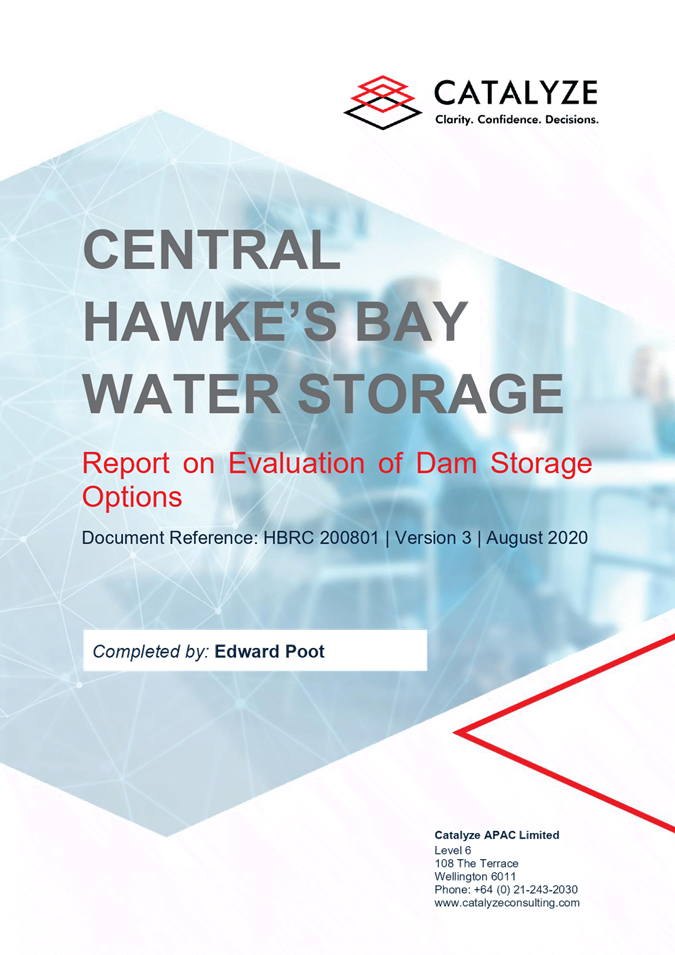
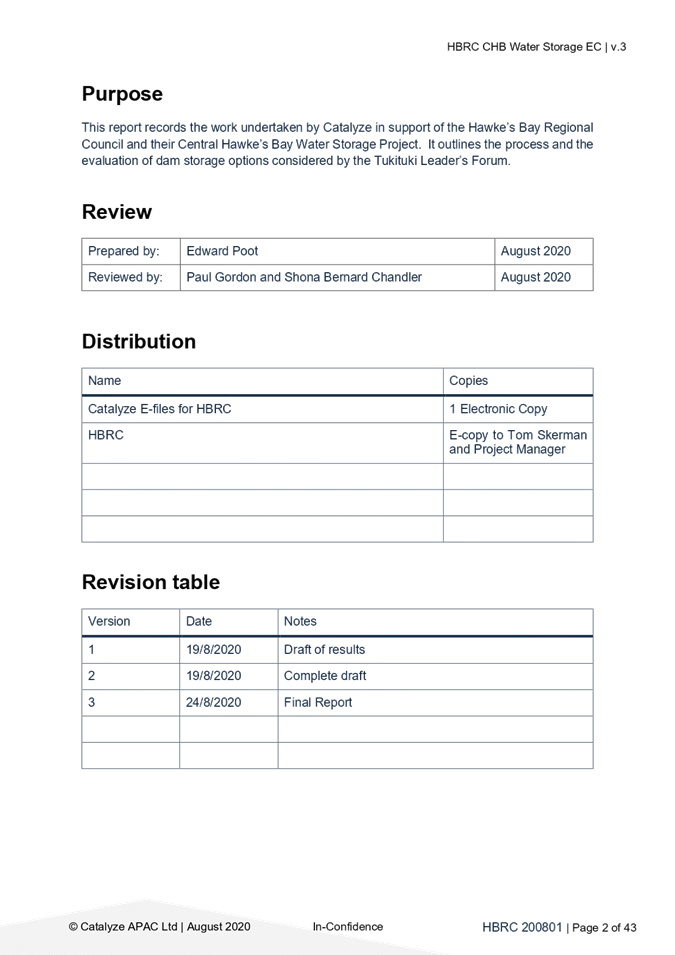
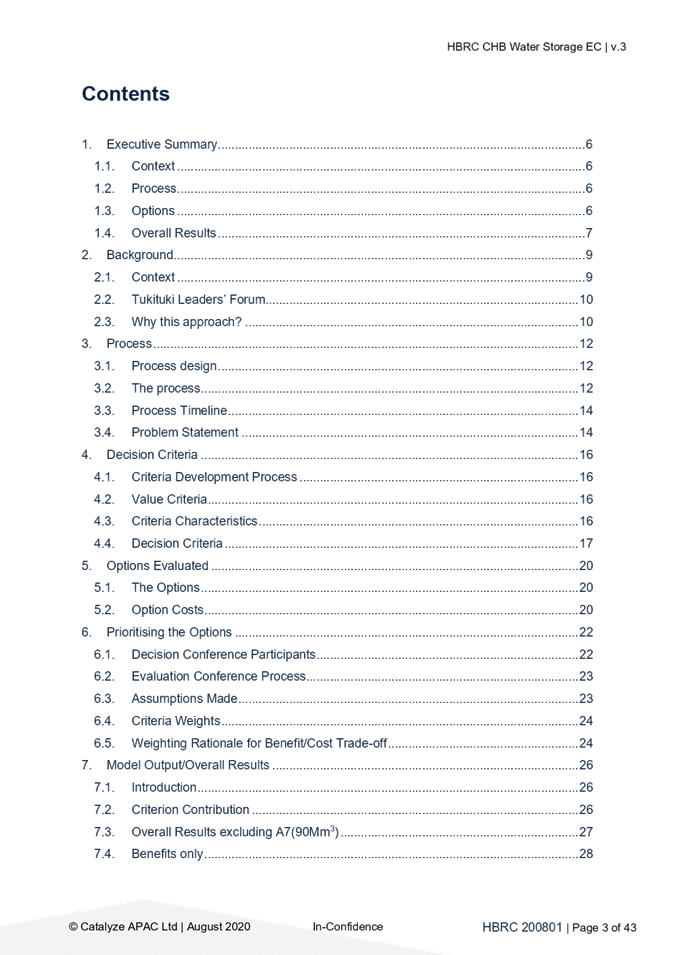
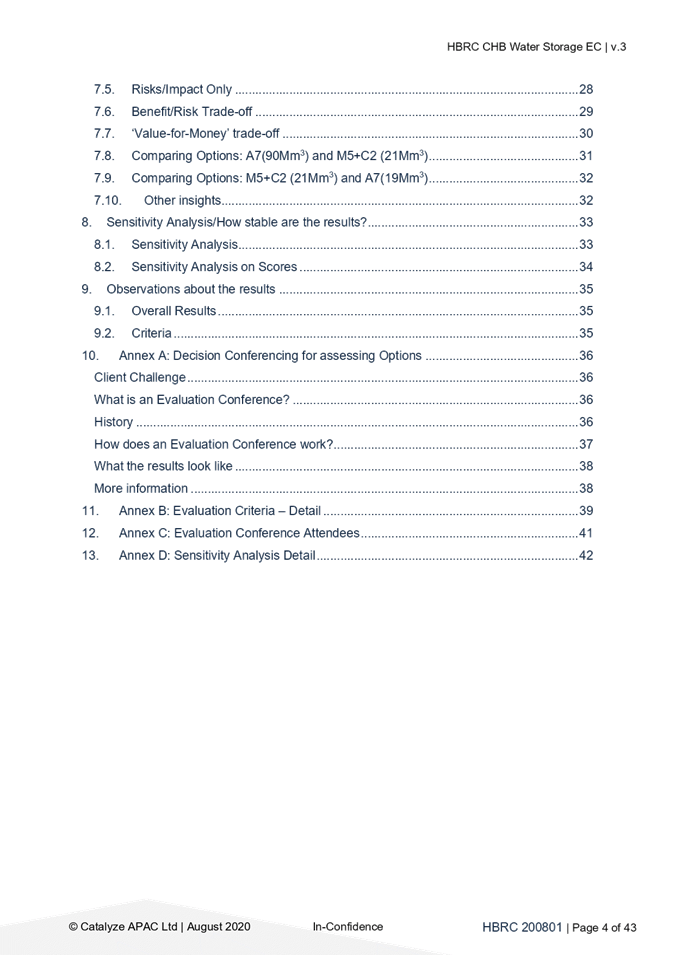
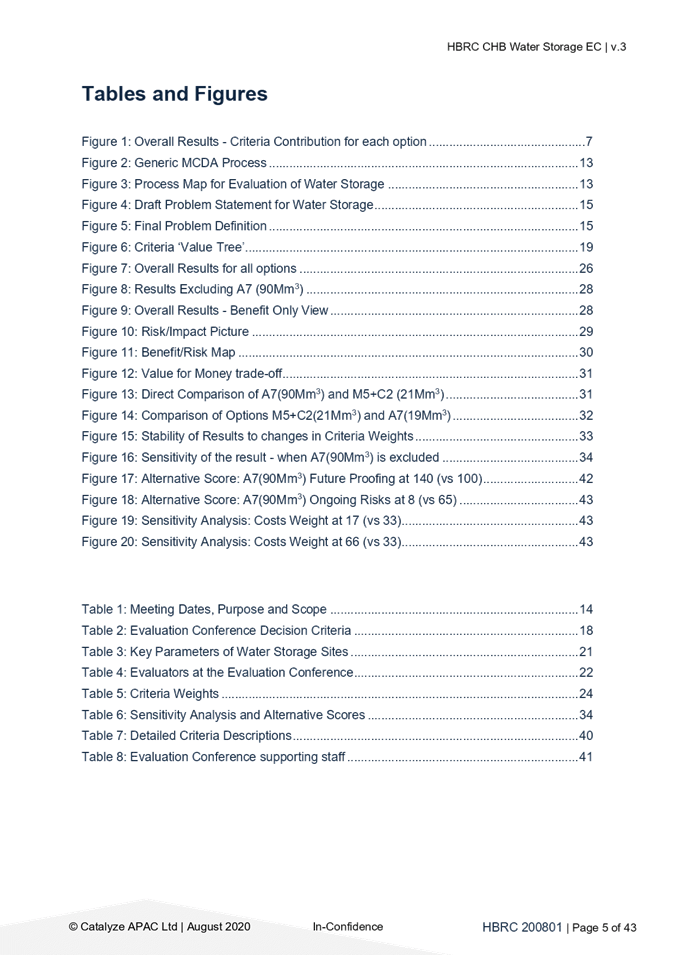
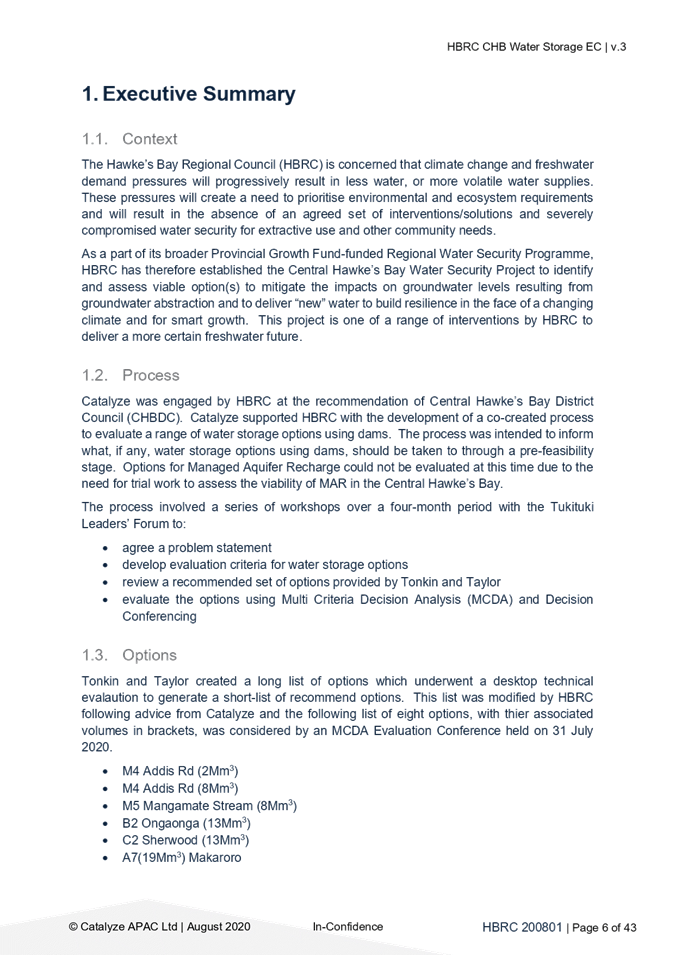
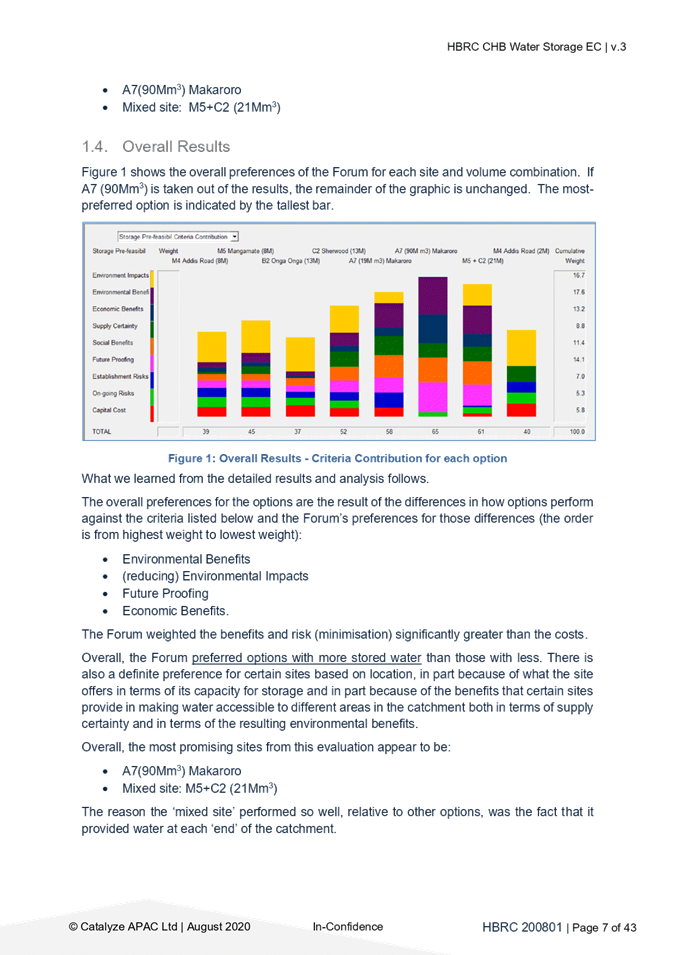

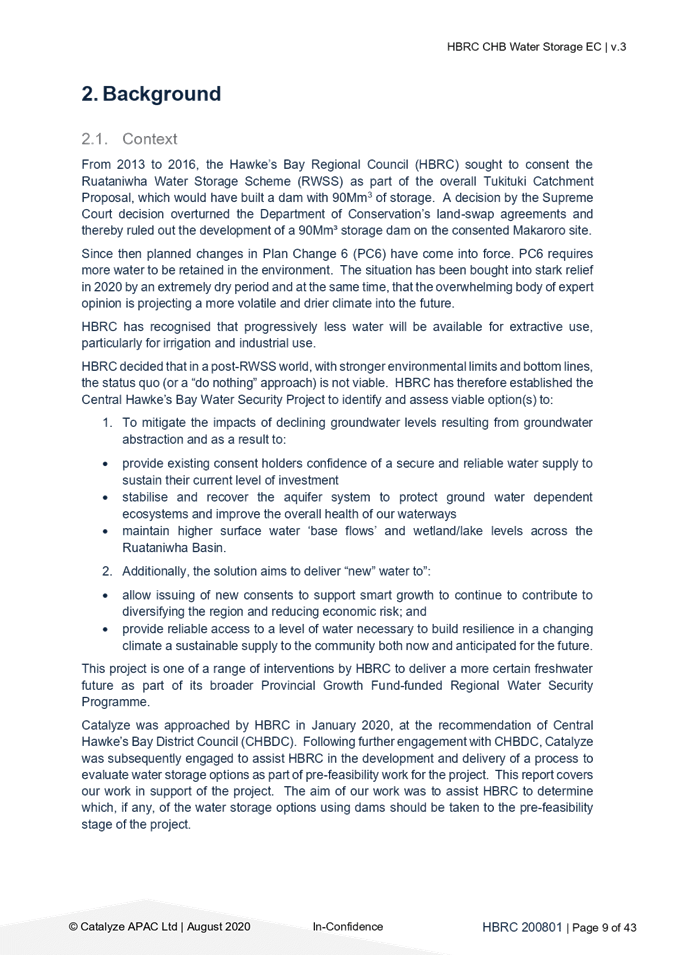
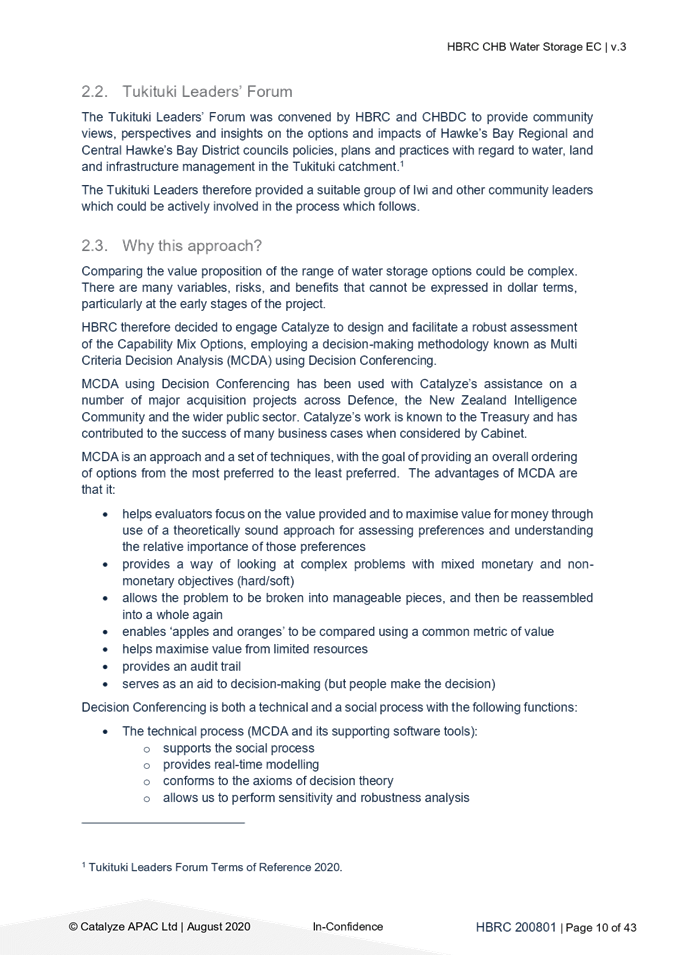

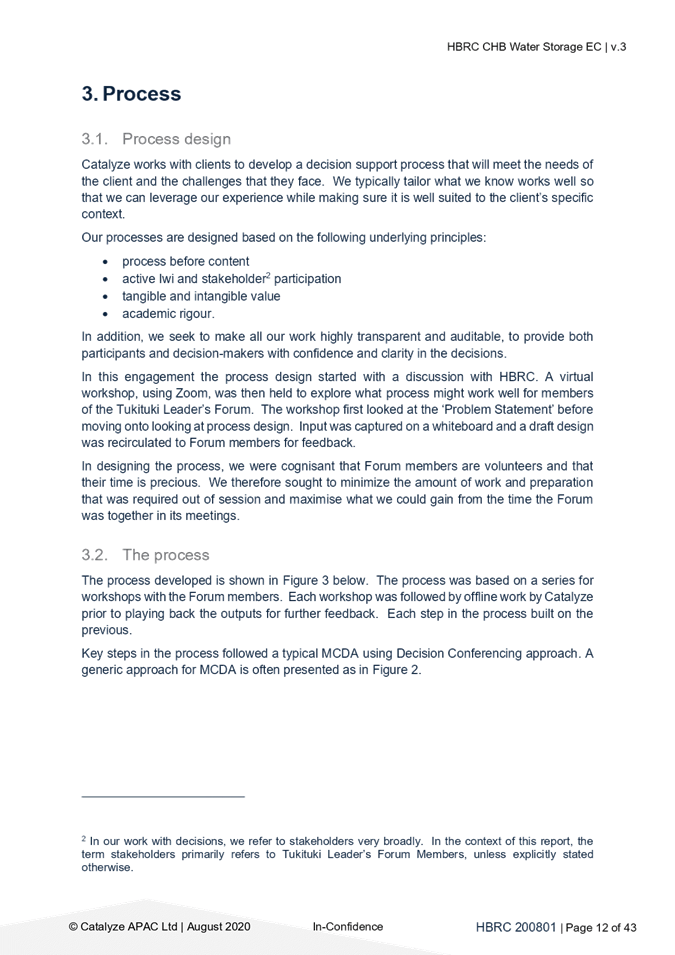
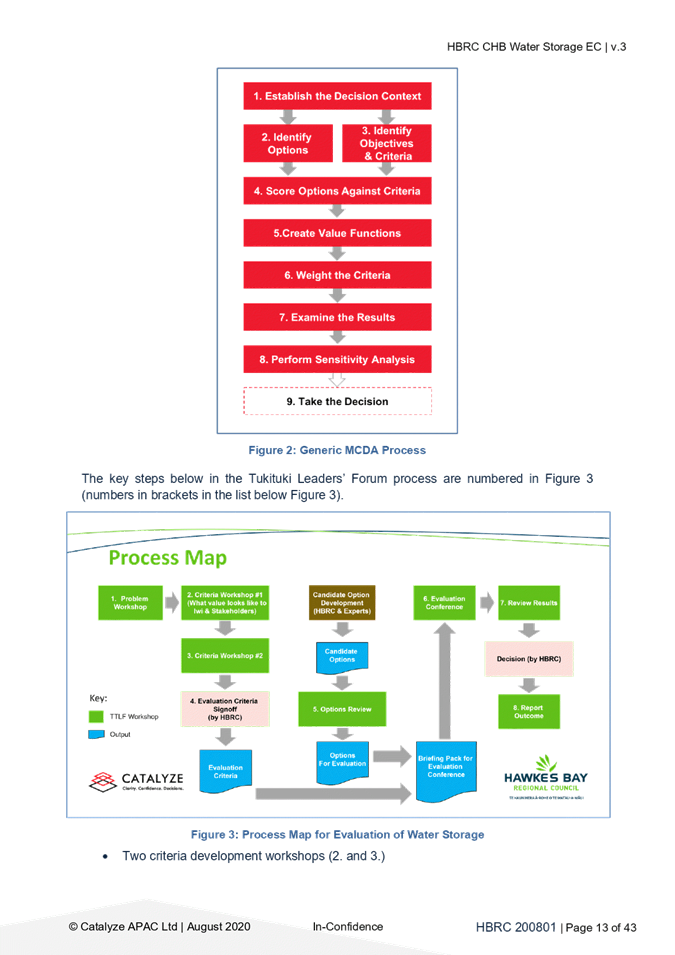
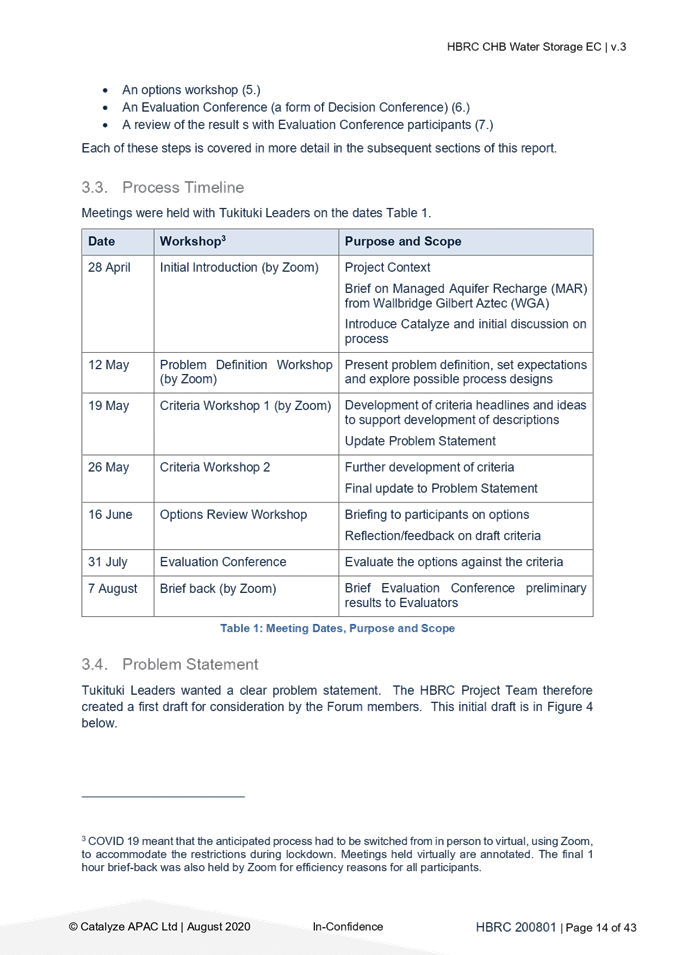
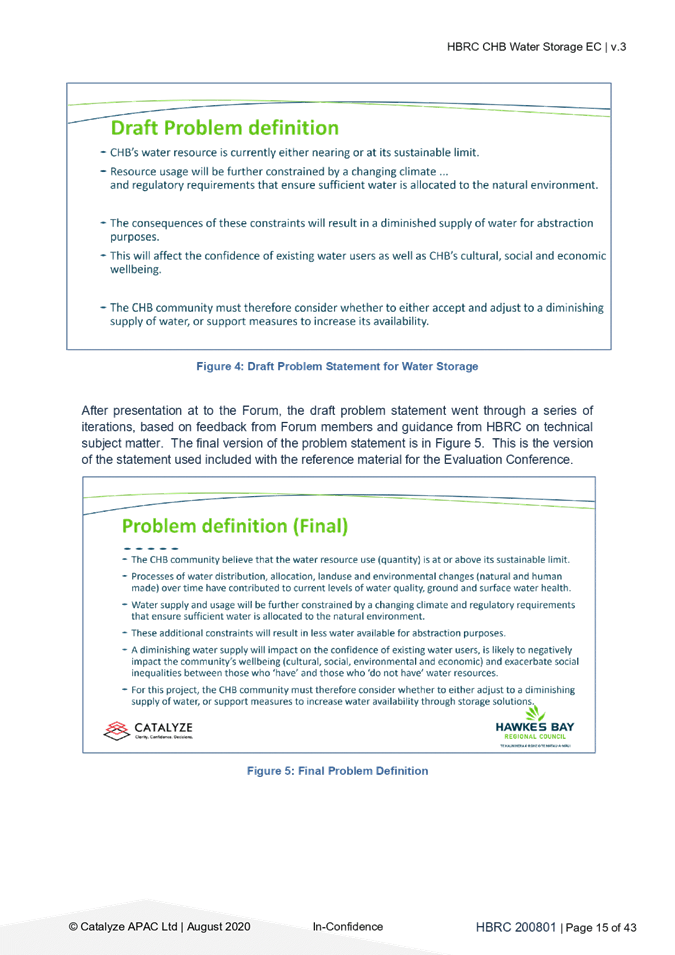
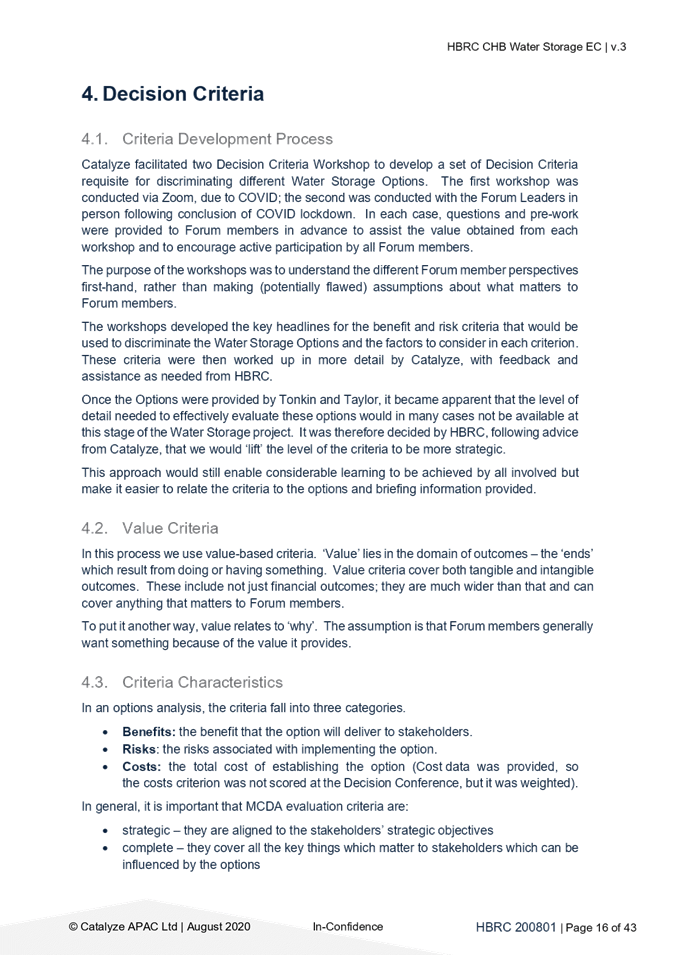
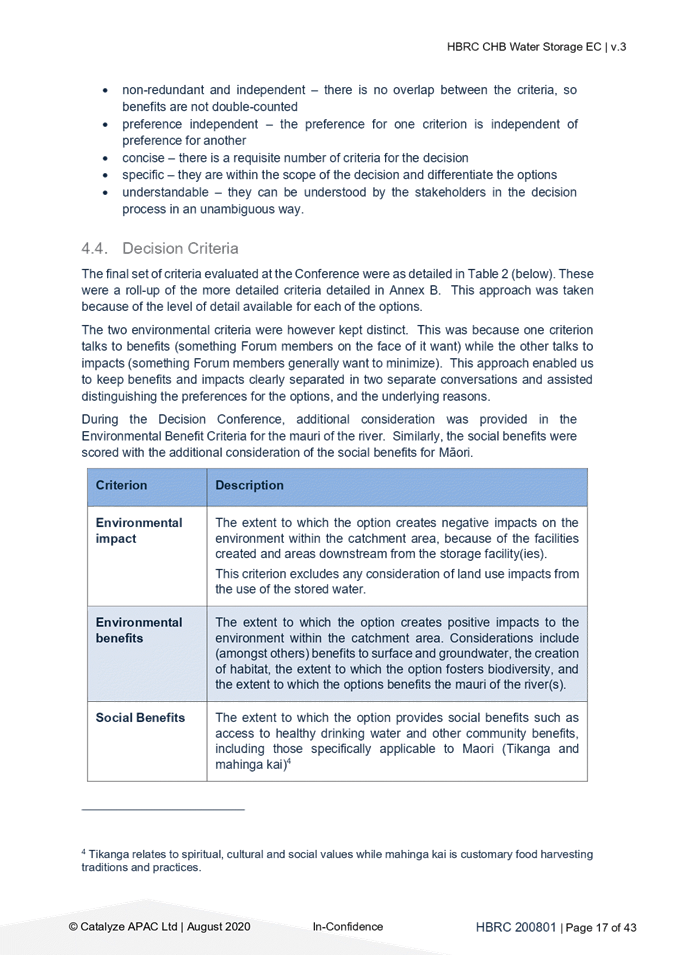
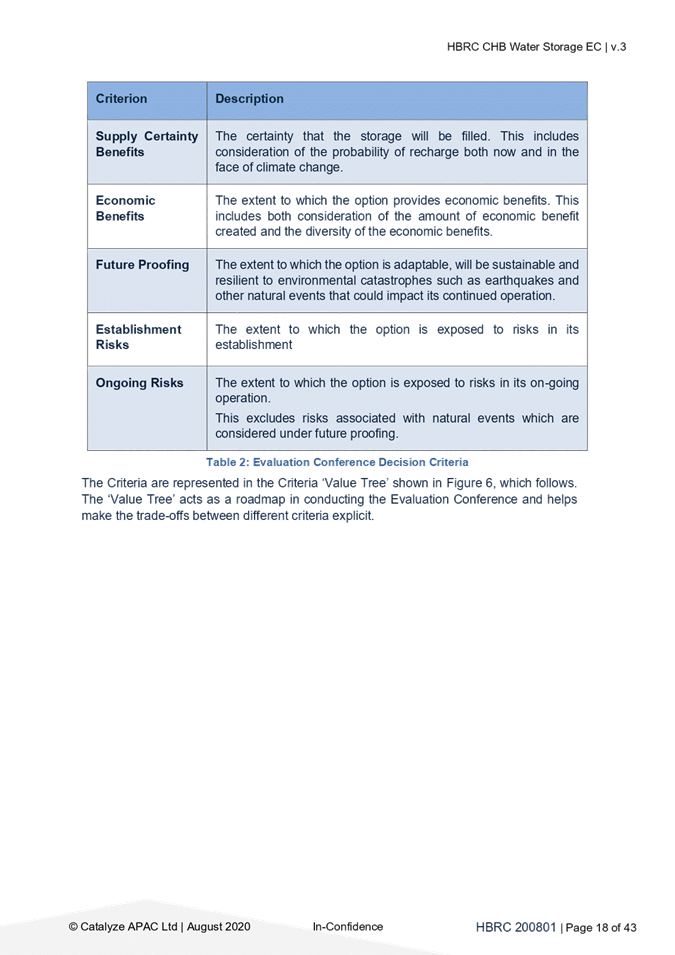
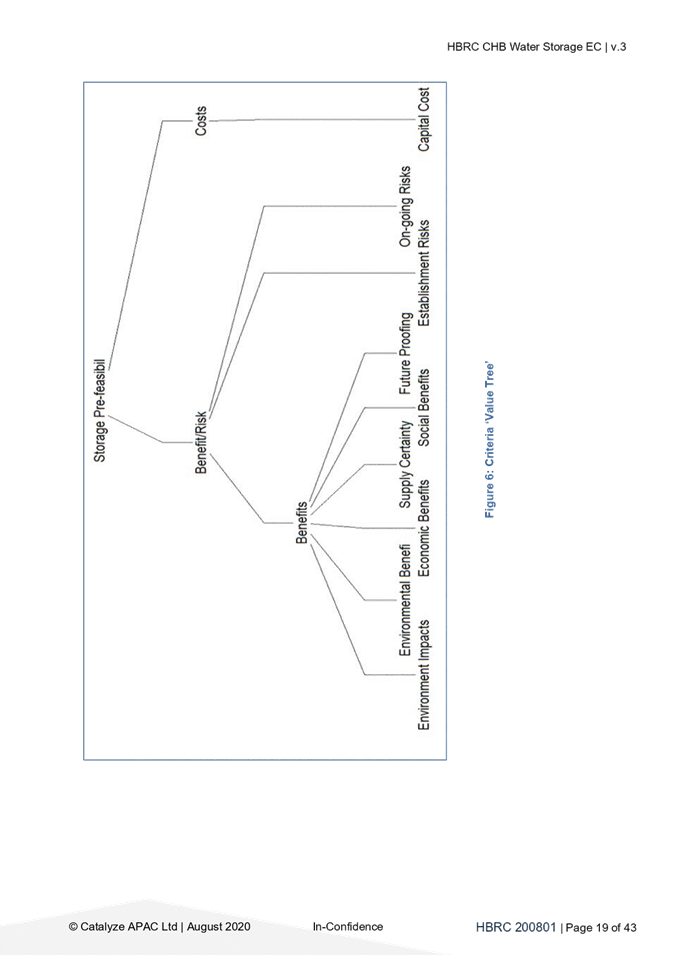
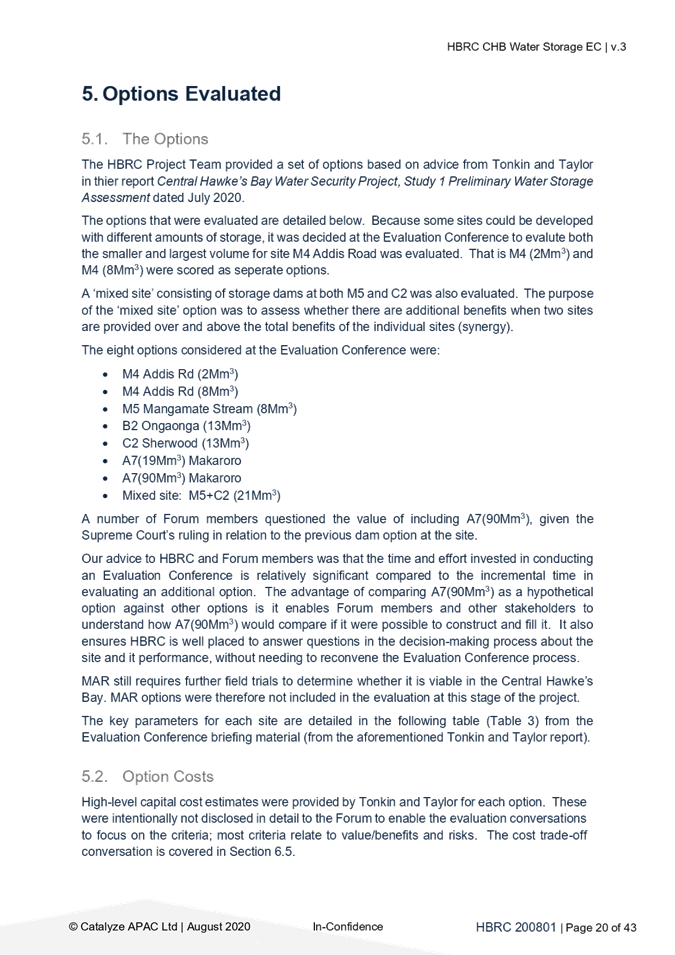
|
Catalyze
August 2020 CHB Water Storage Options Evaluation Report
|
Attachment 1
|
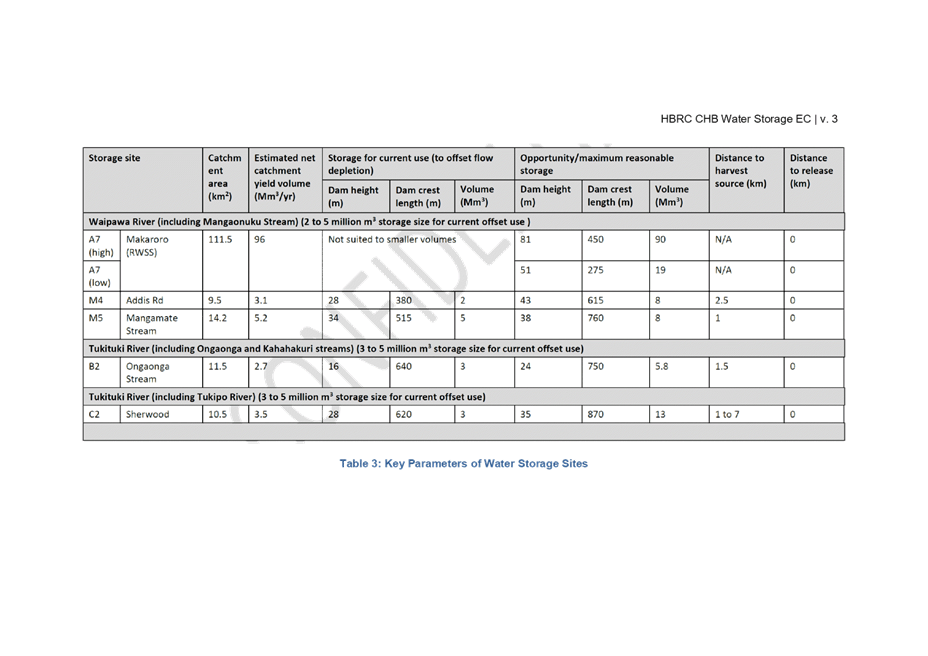
|
Catalyze
August 2020 CHB Water Storage Options Evaluation Report
|
Attachment 1
|
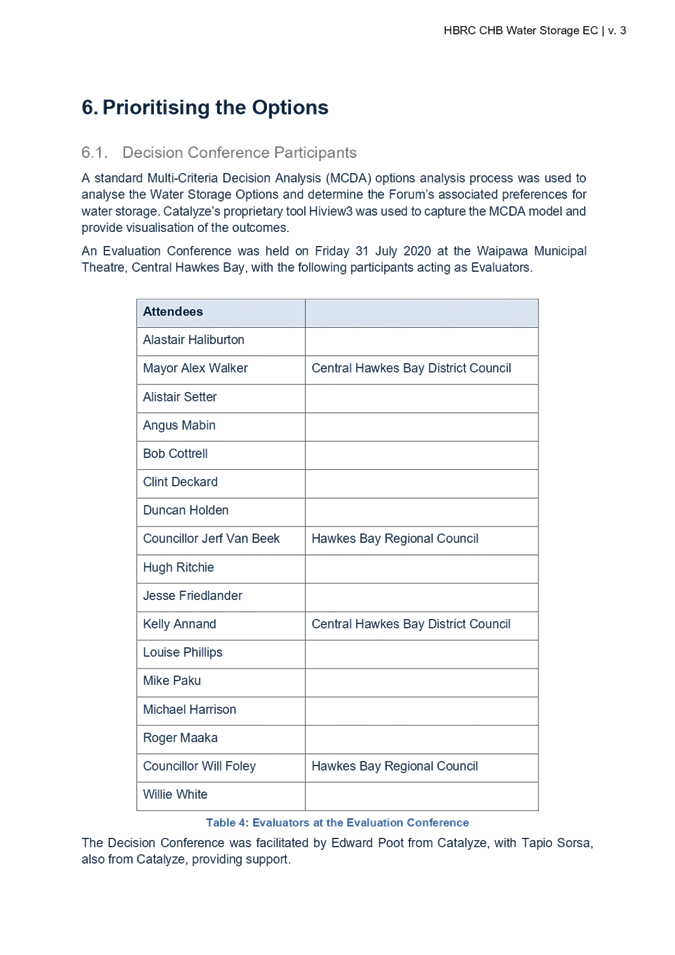
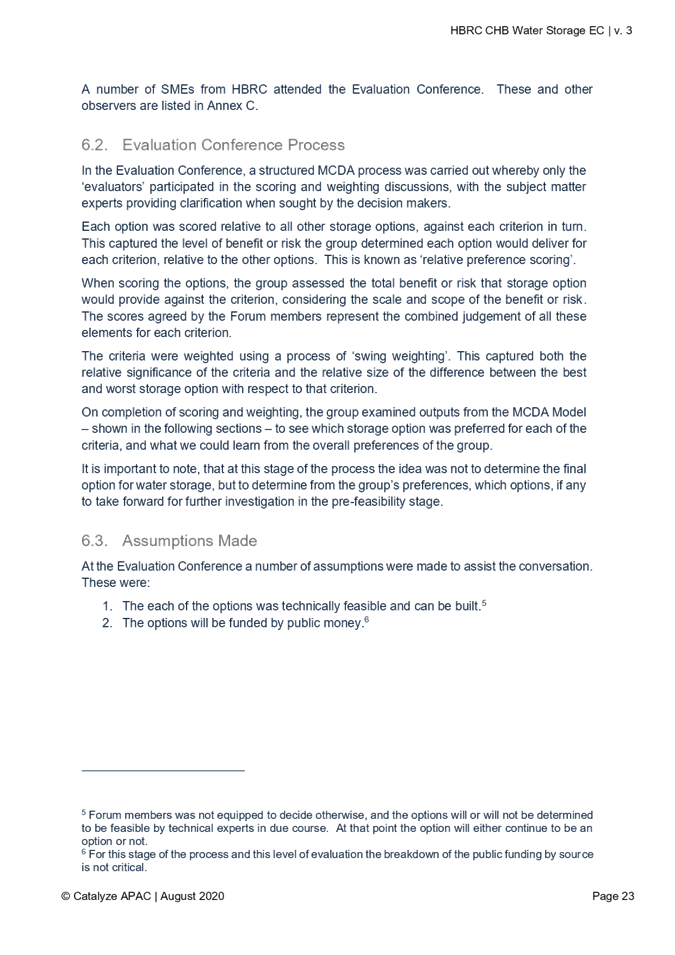
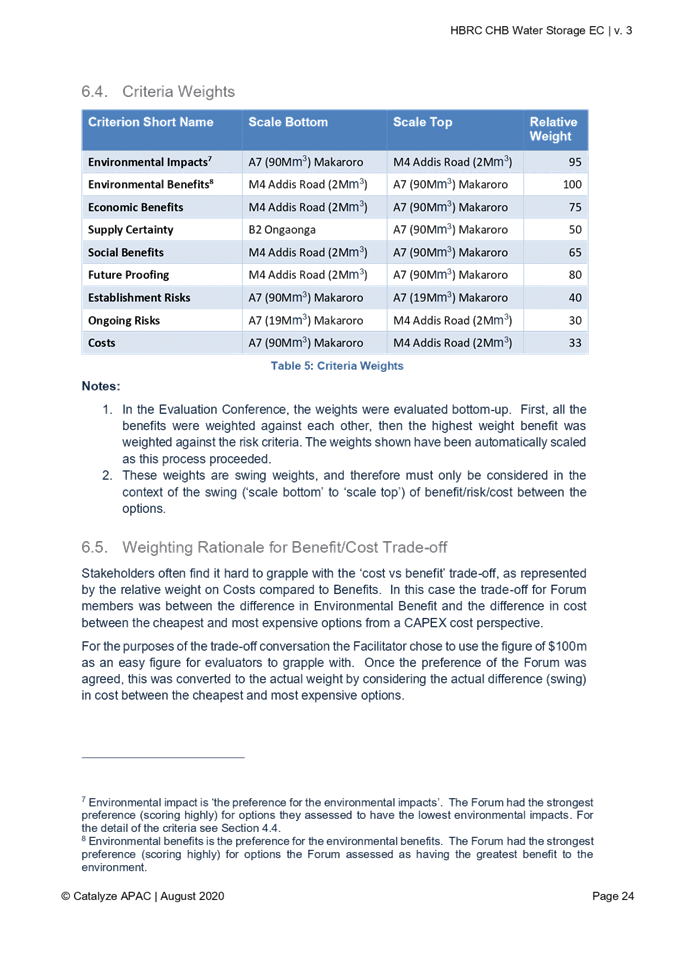

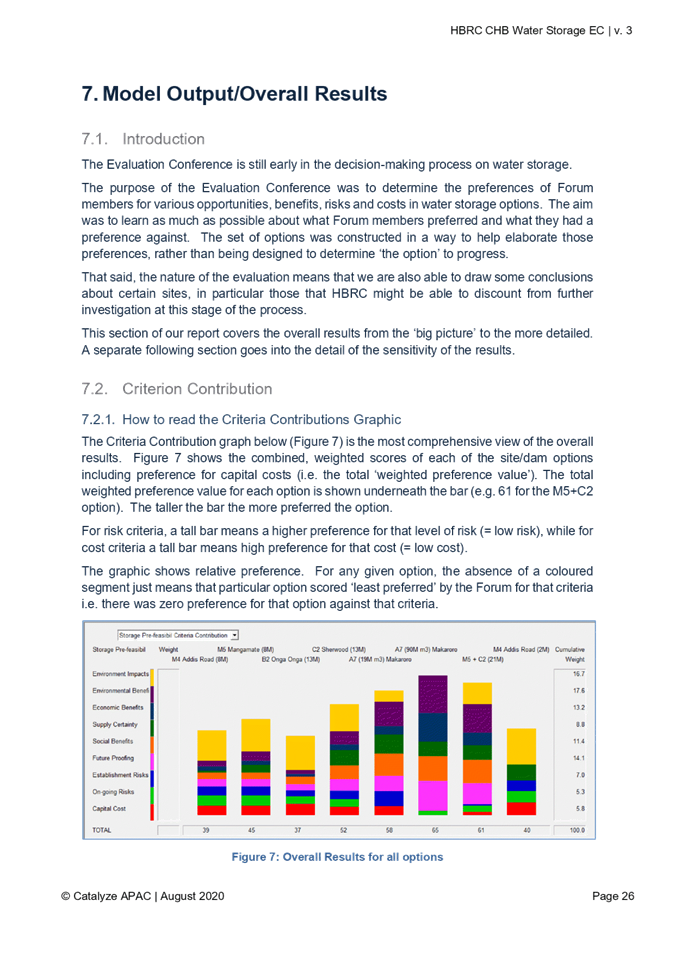
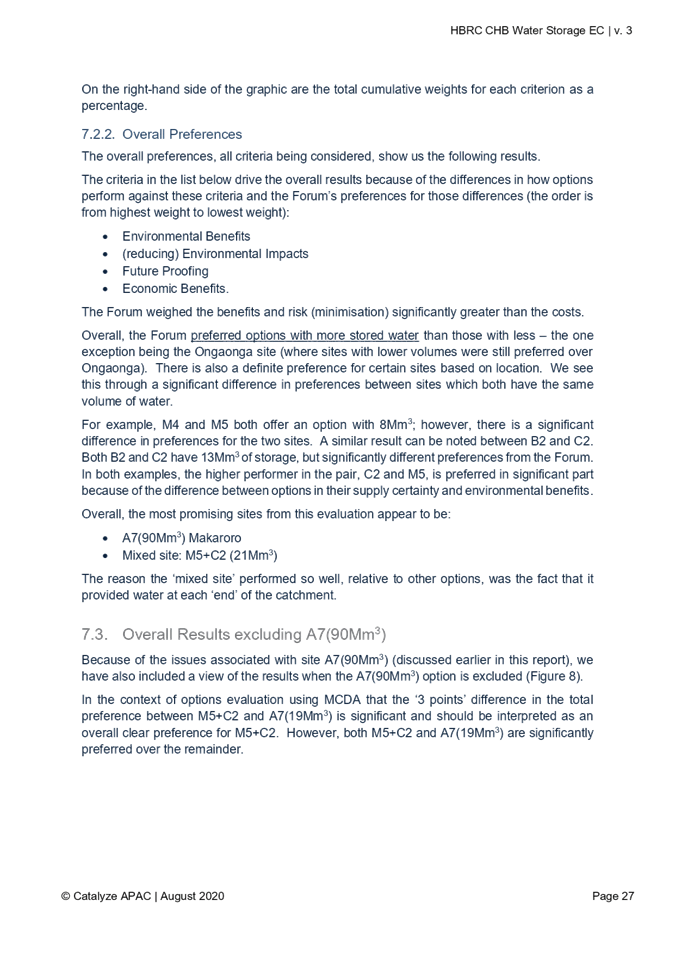
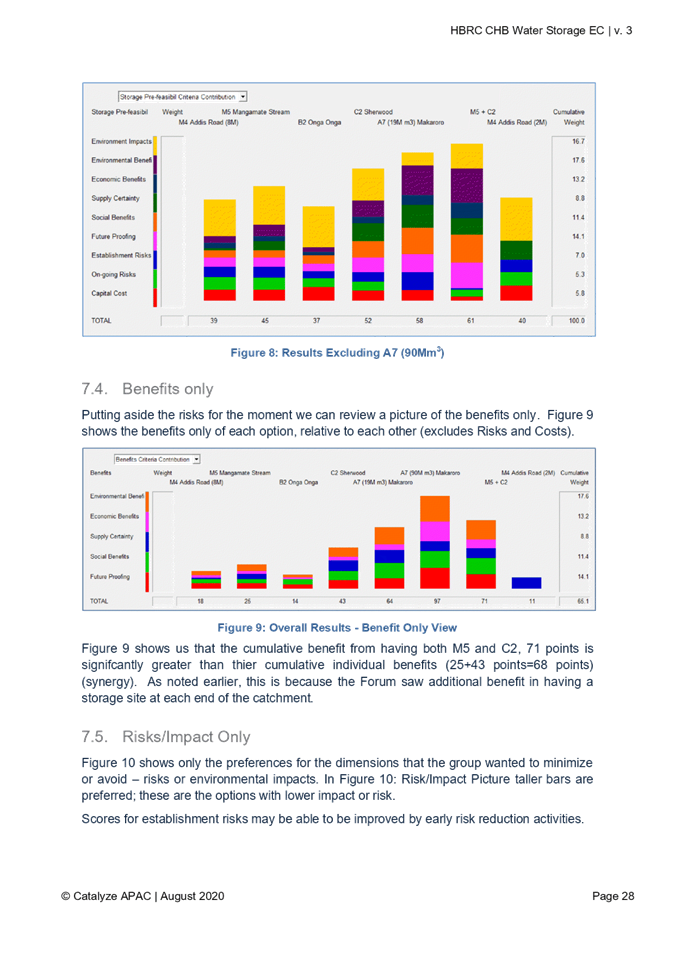
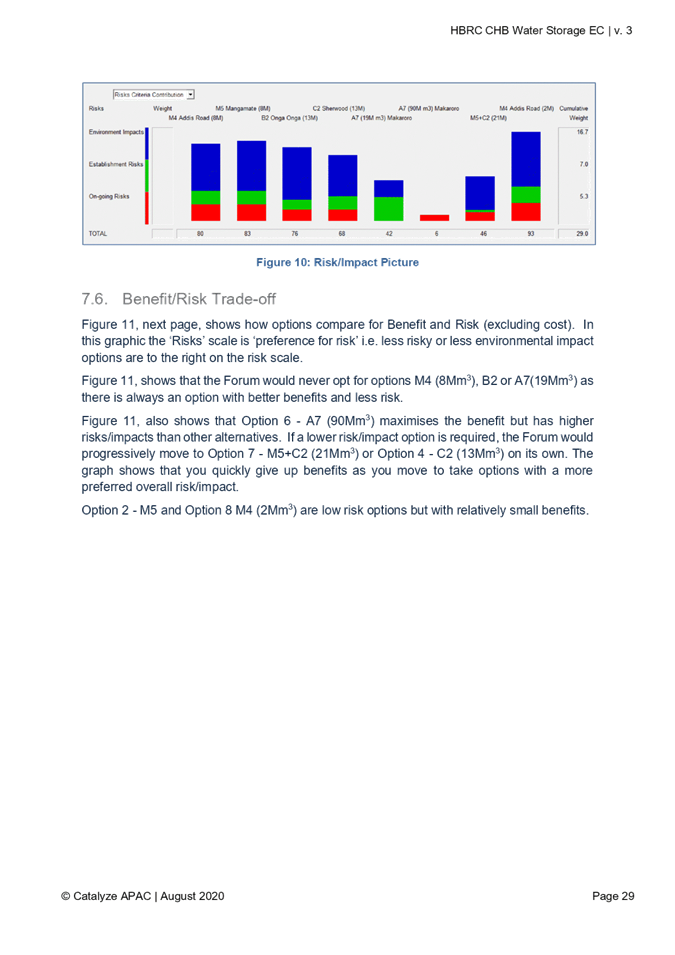
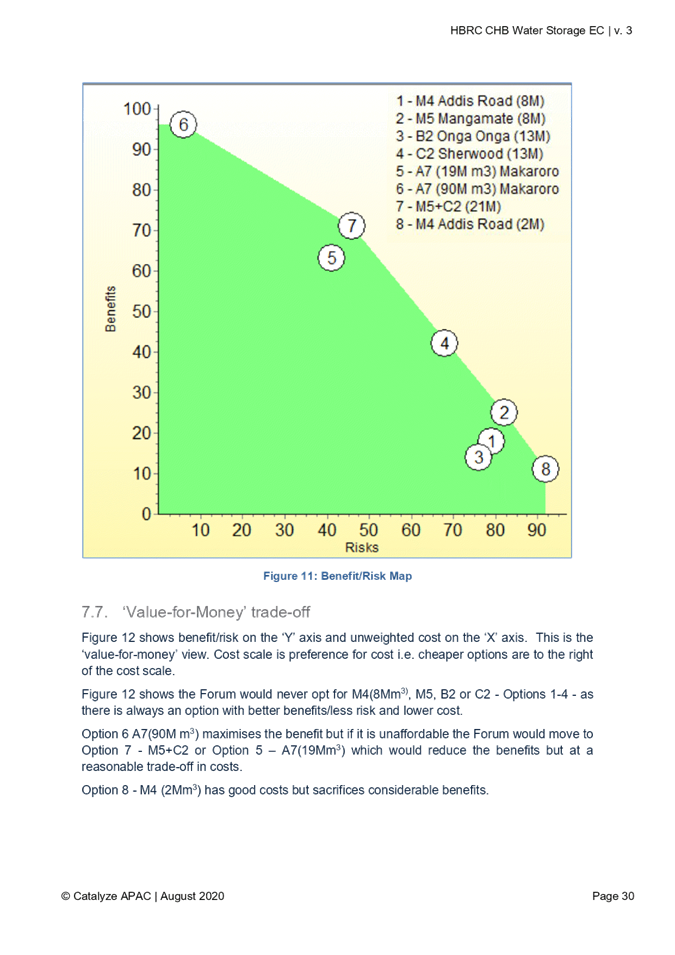
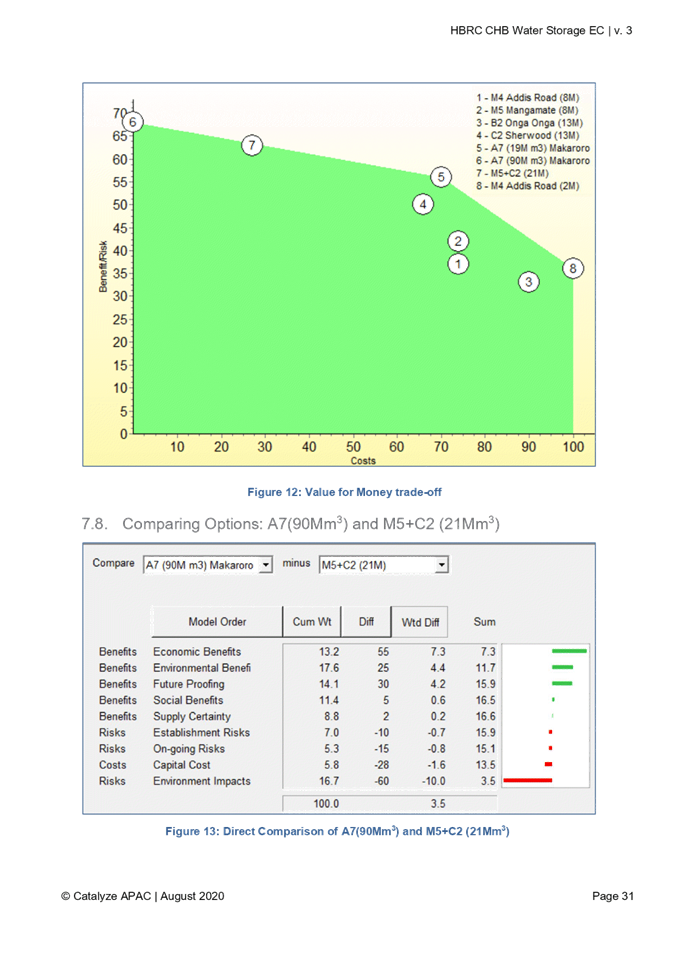
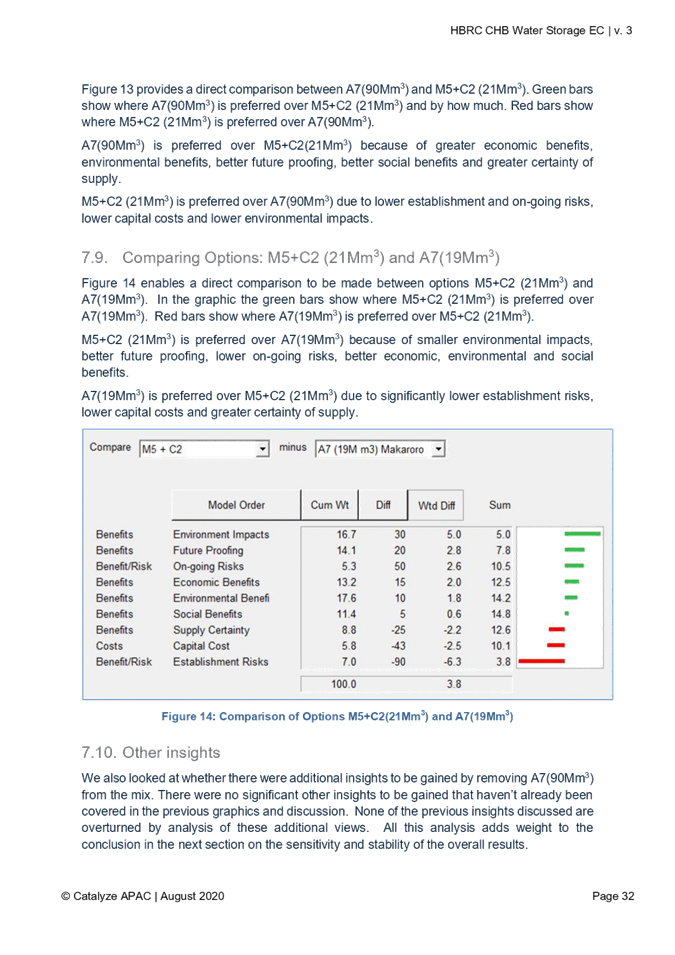
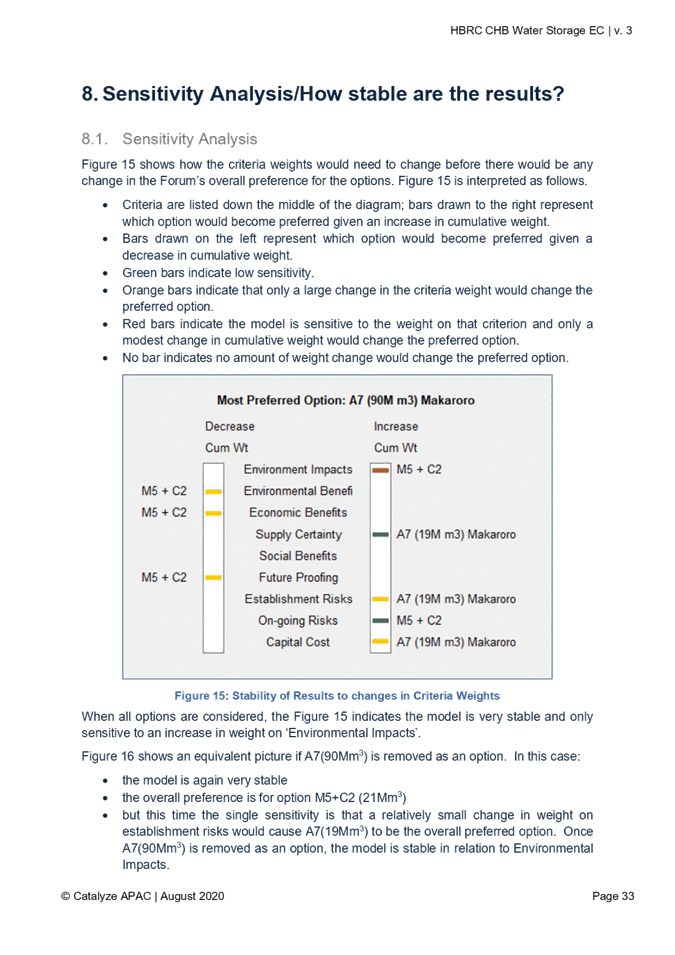
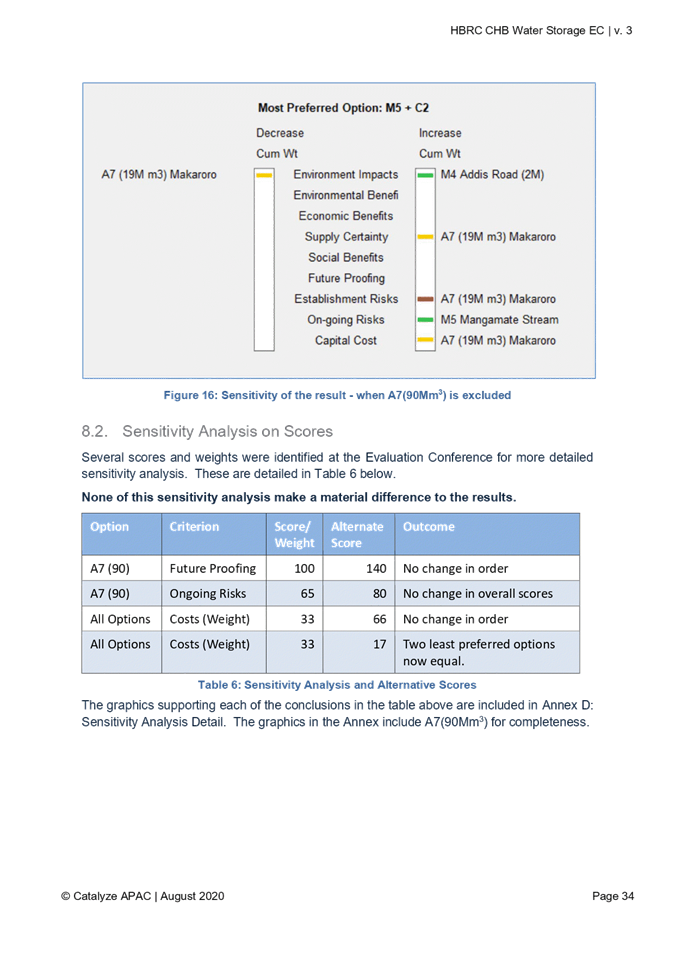
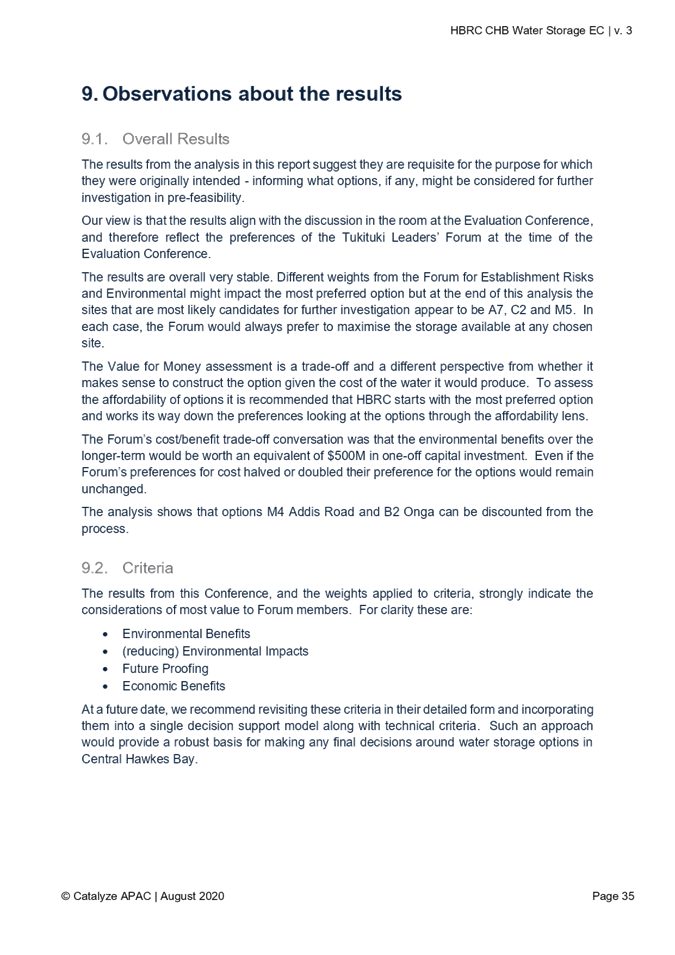
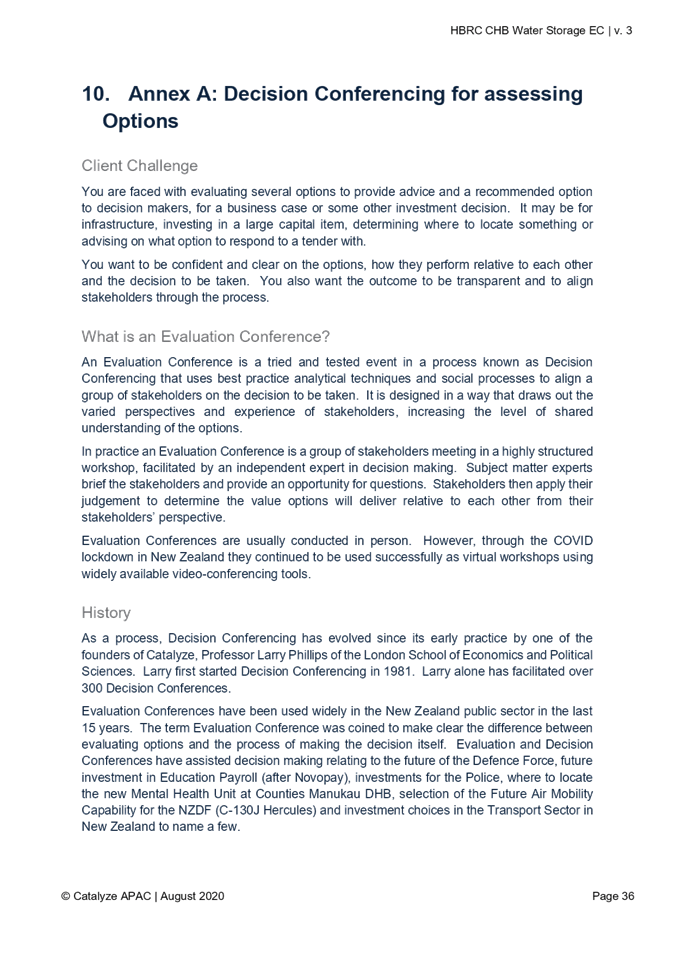
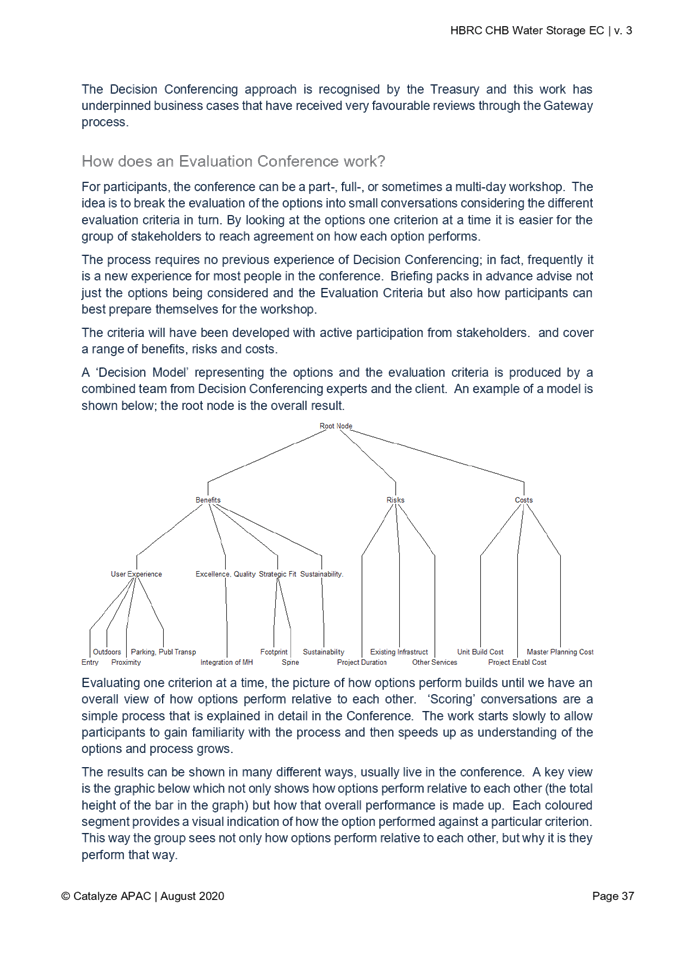
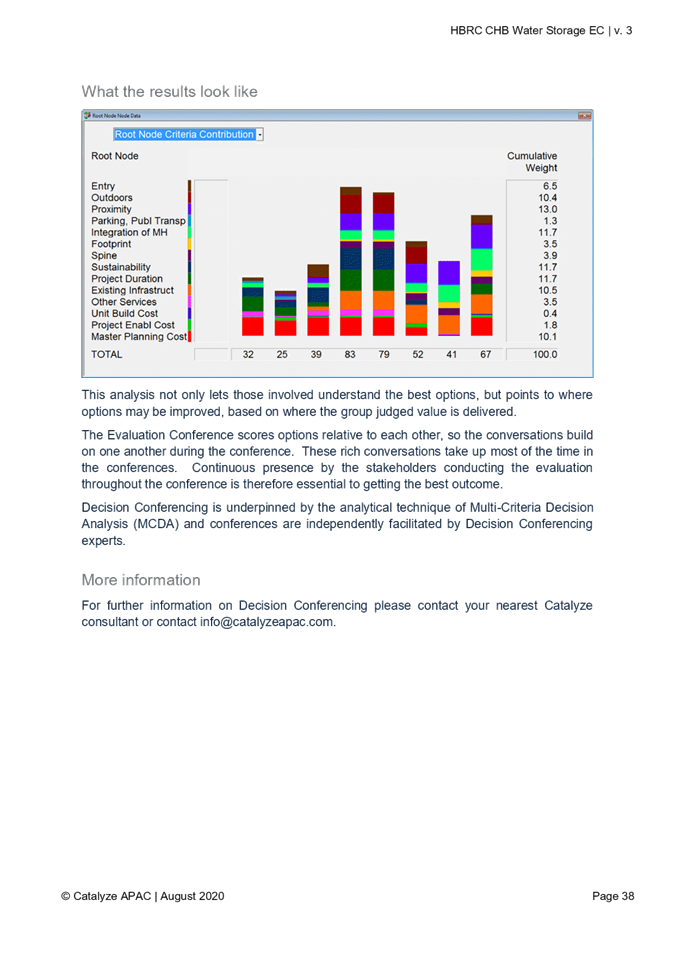
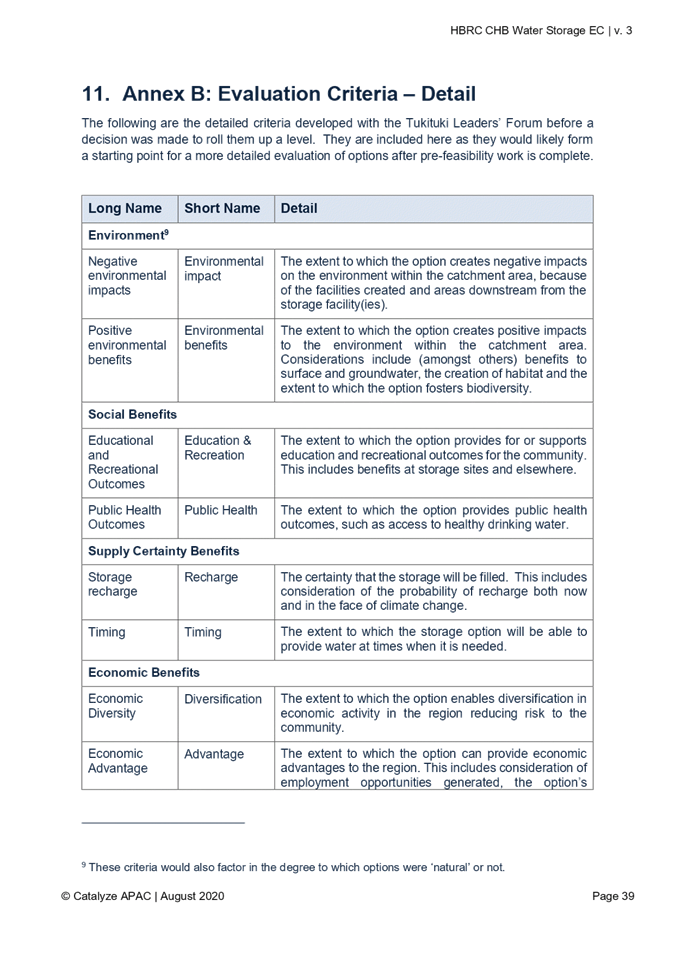
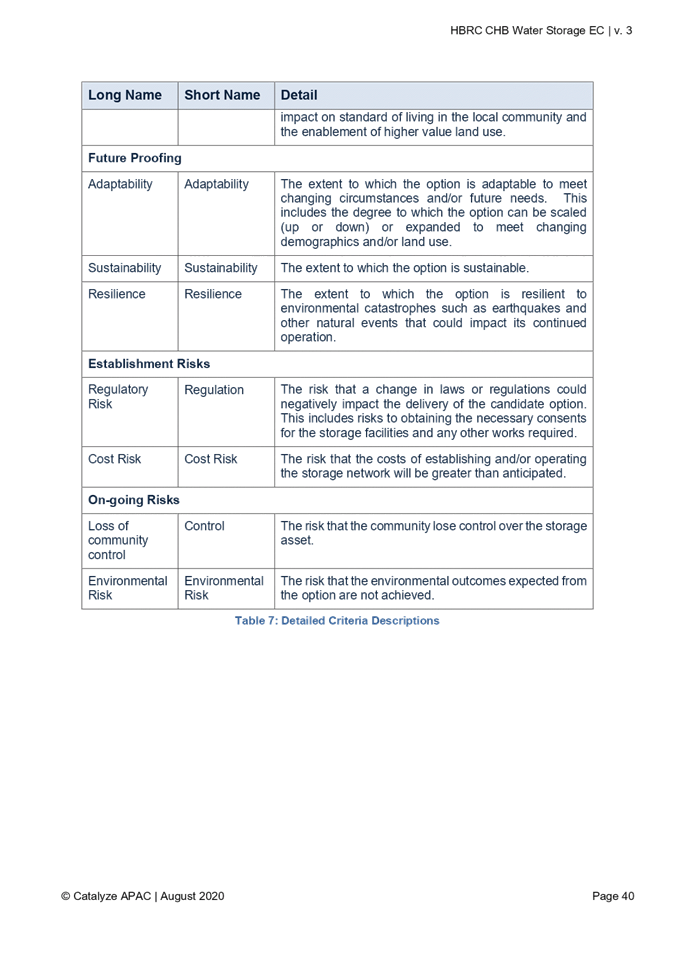
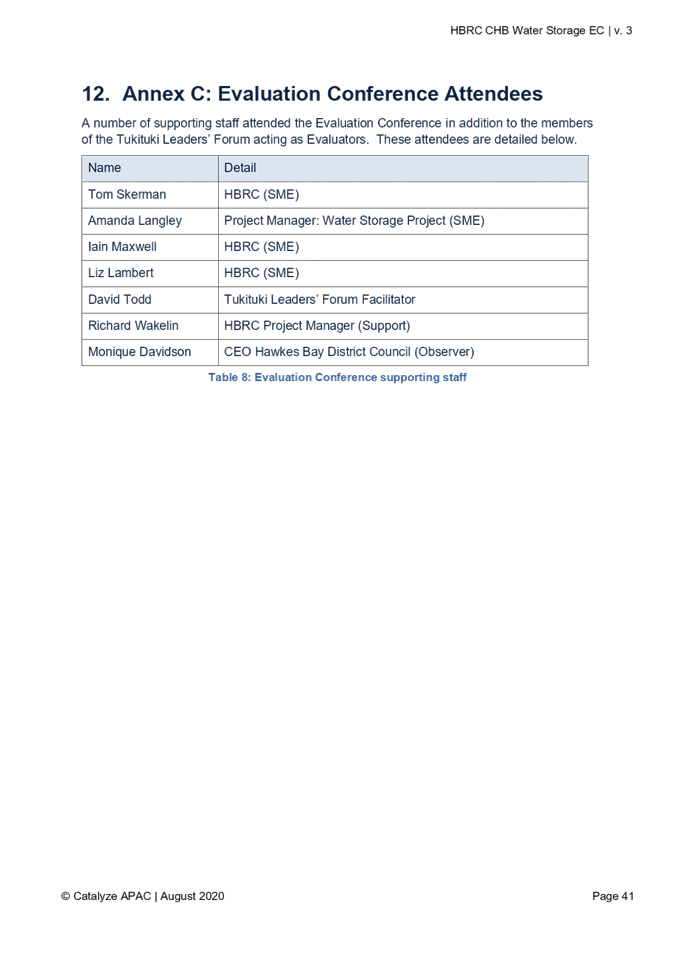
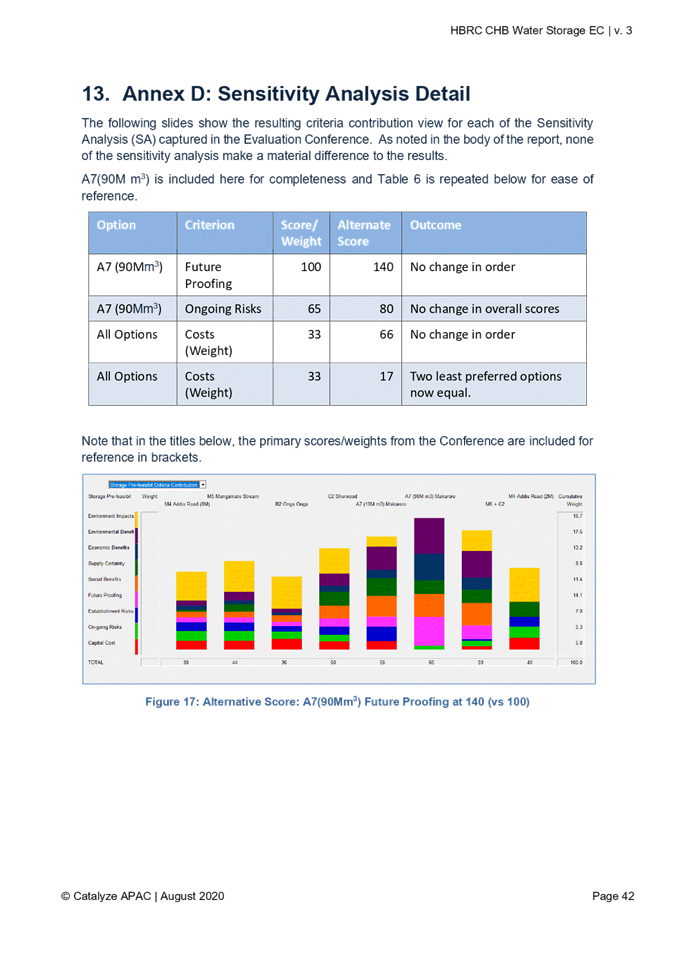
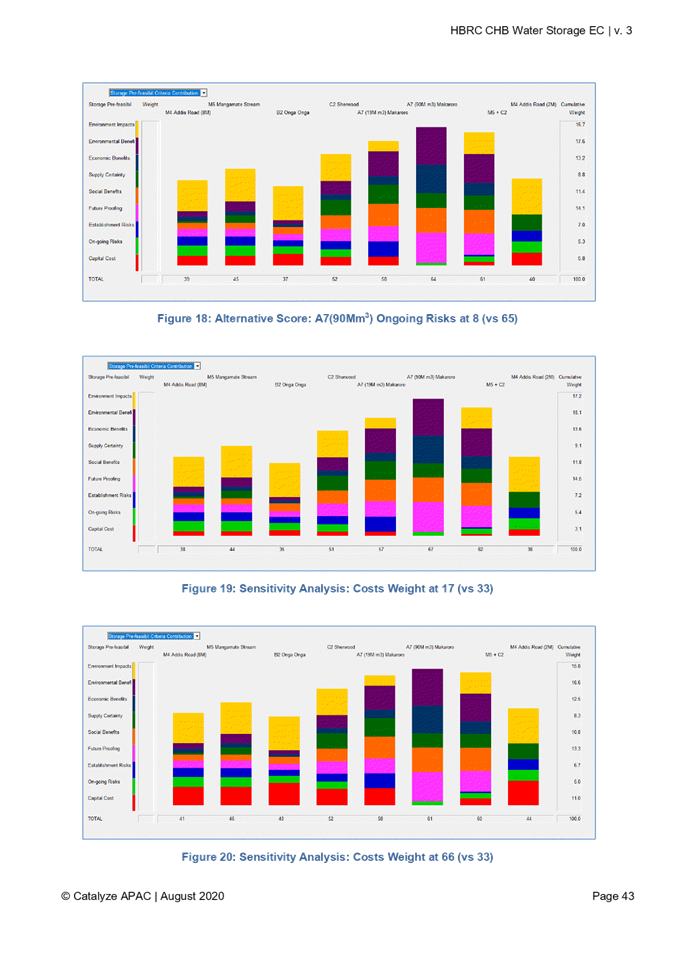
|
August
2020 Tonkin + Taylor CHB Water Security Project - Stage 1 Water Storage
Options Assessment
|
Attachment 2
|
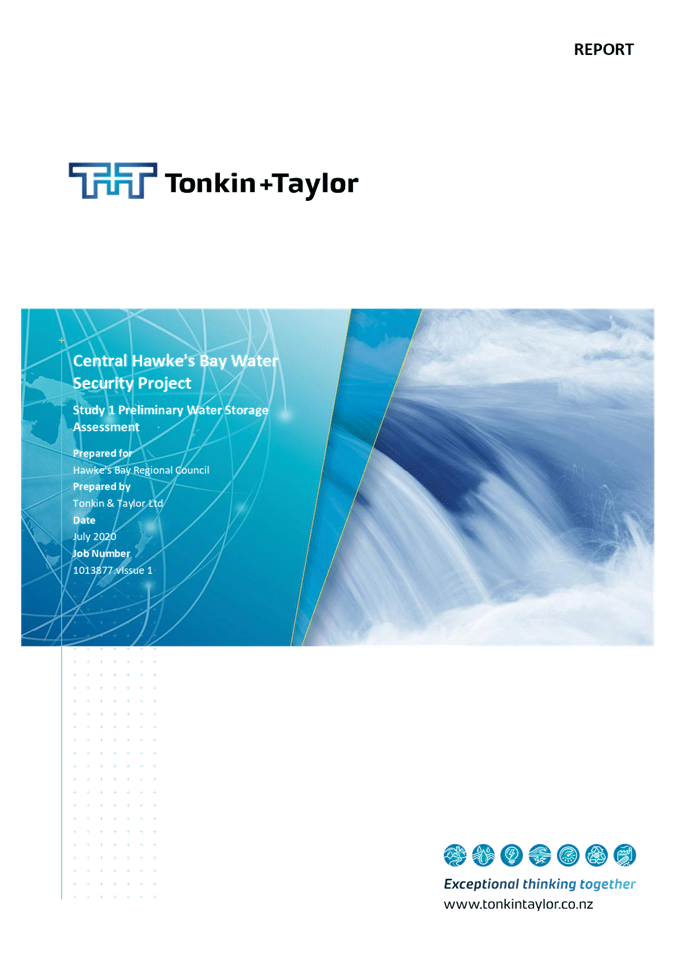

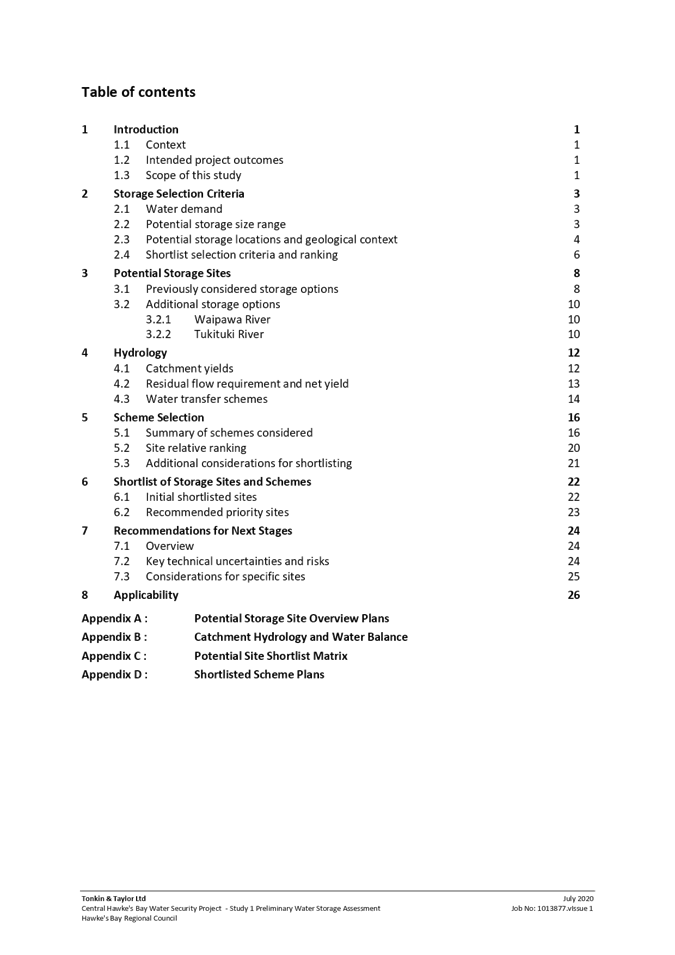
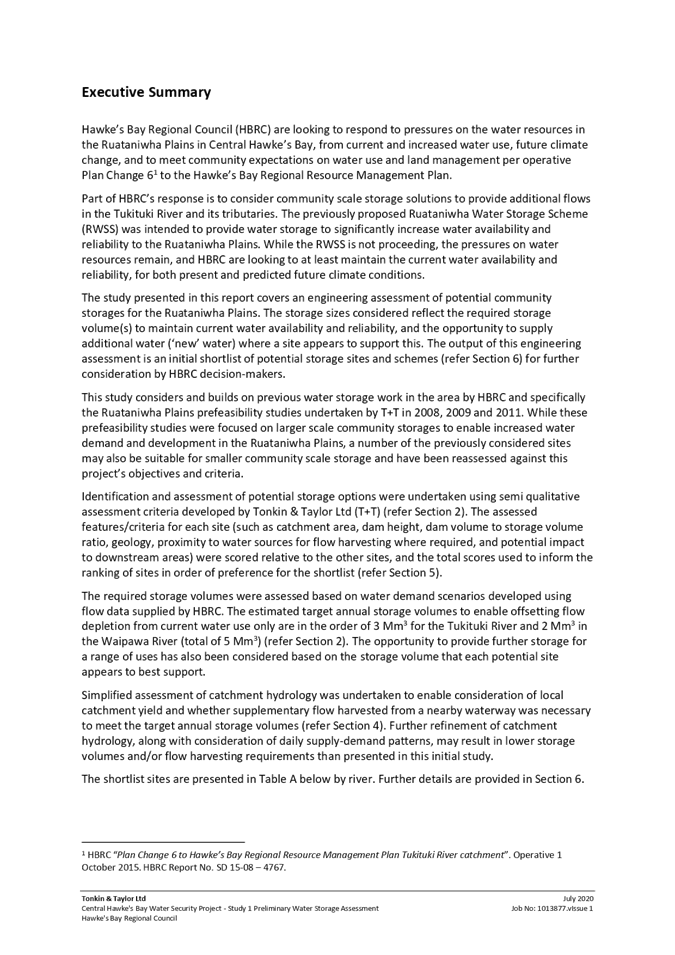
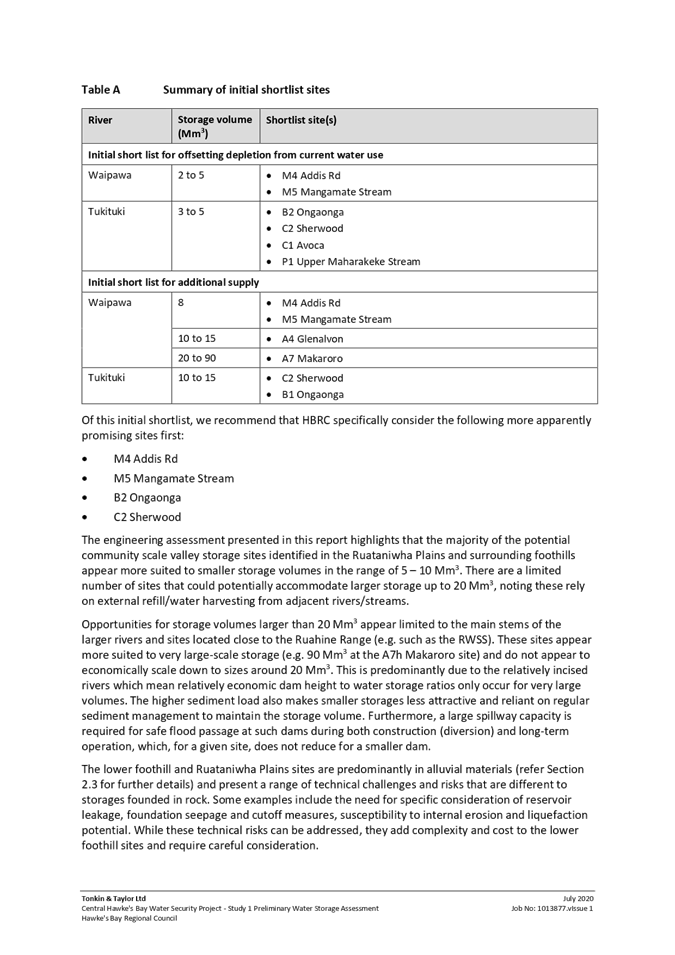

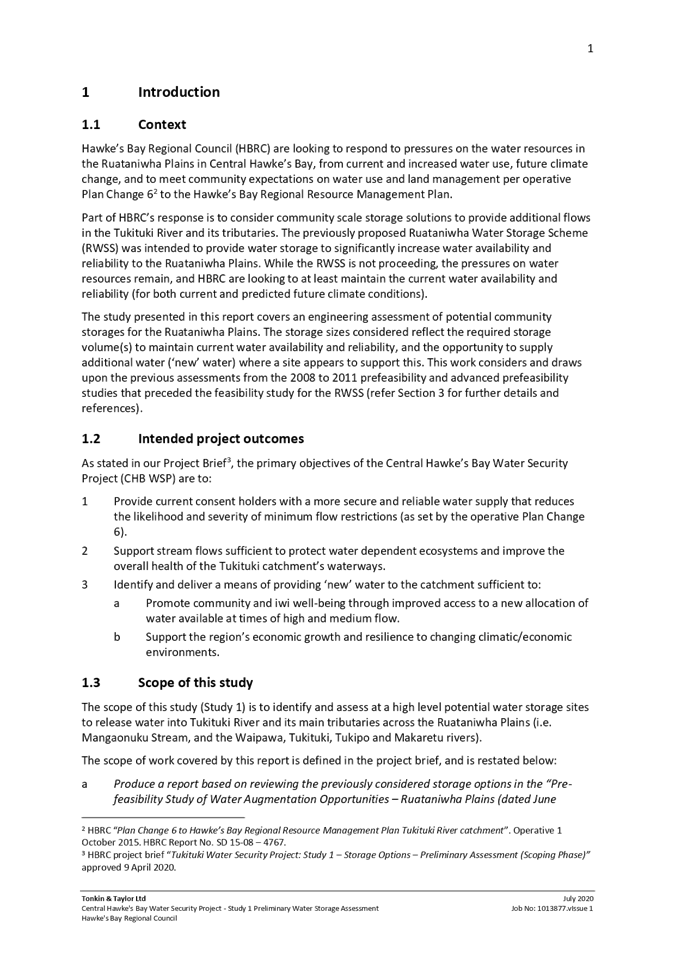
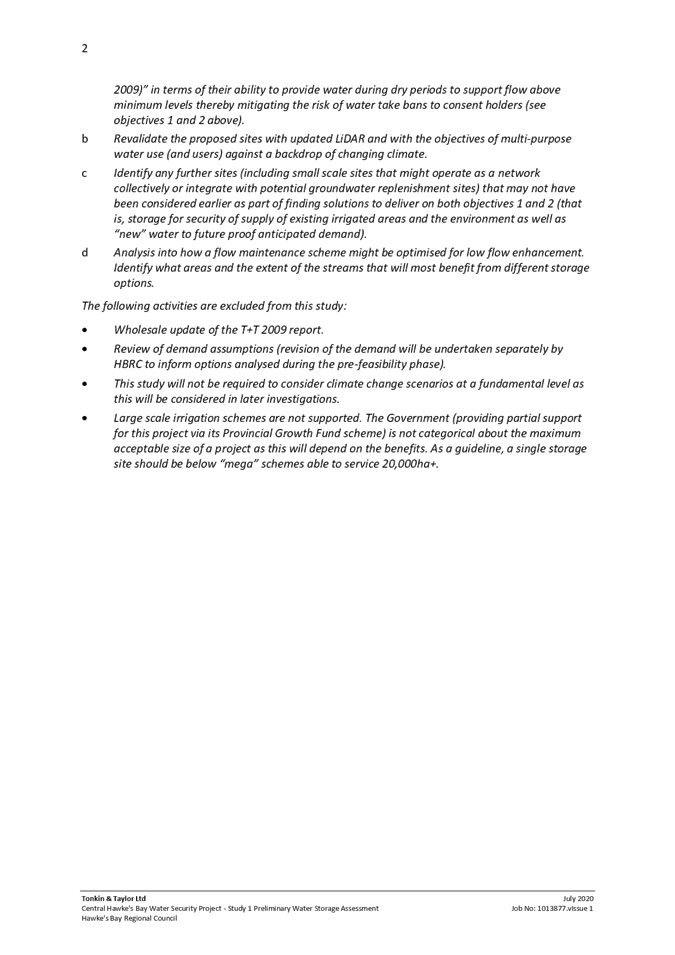
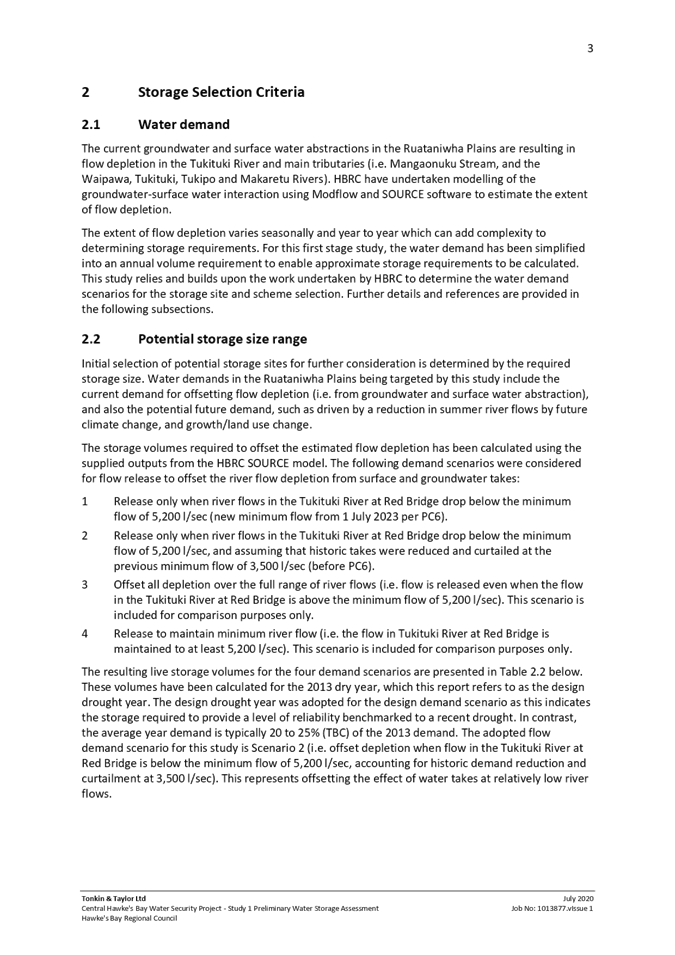
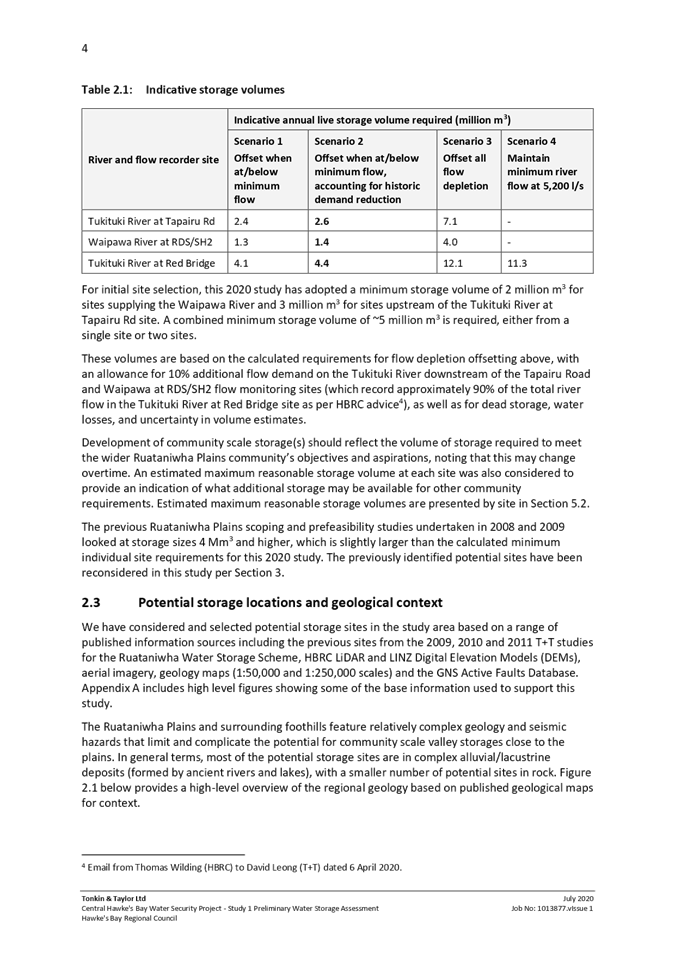
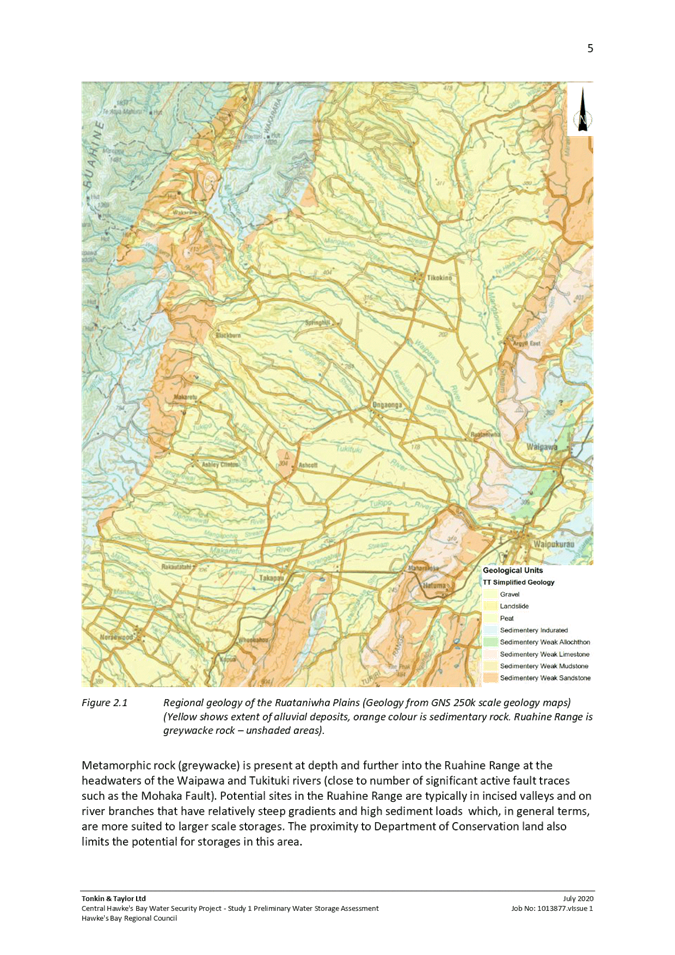
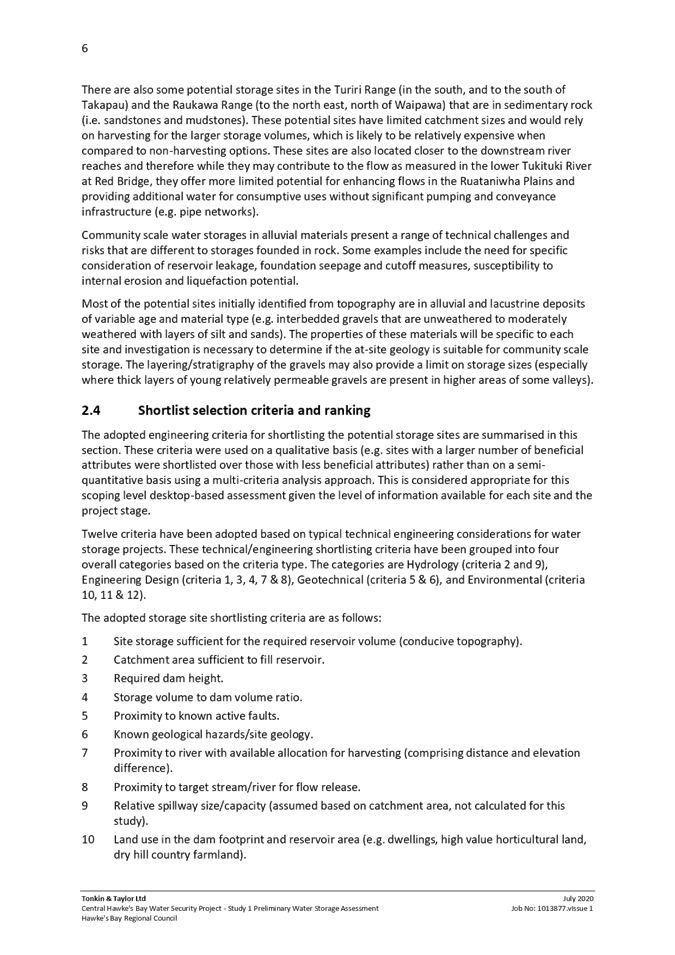
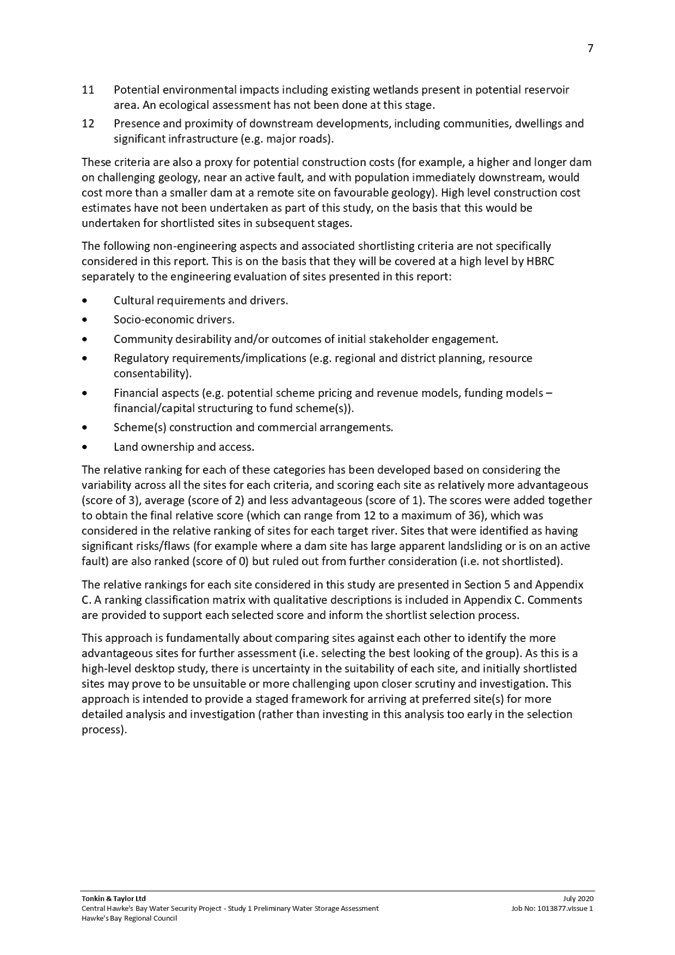
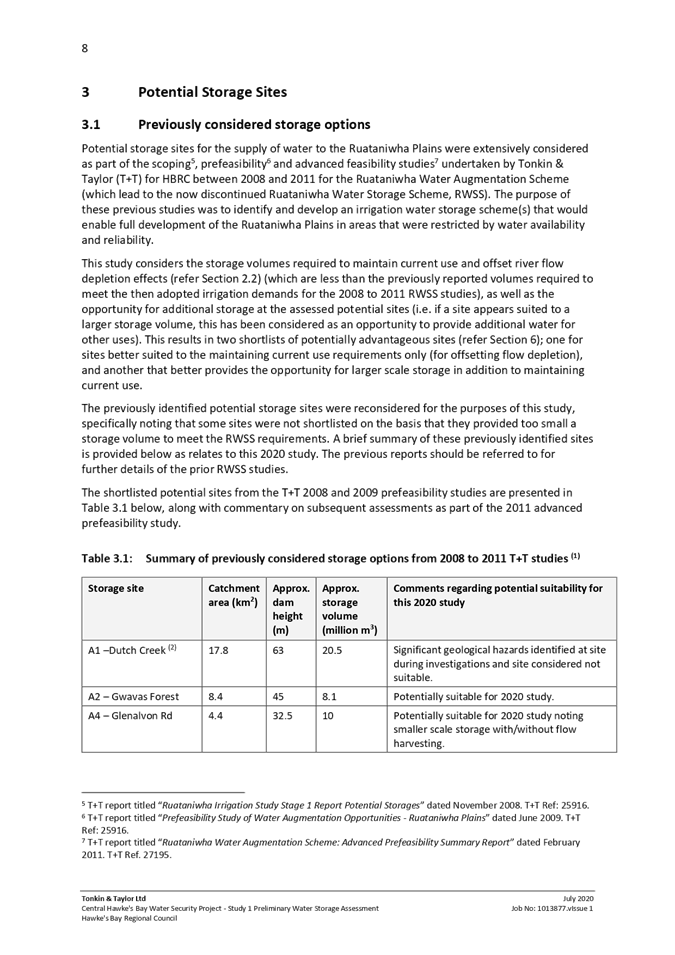
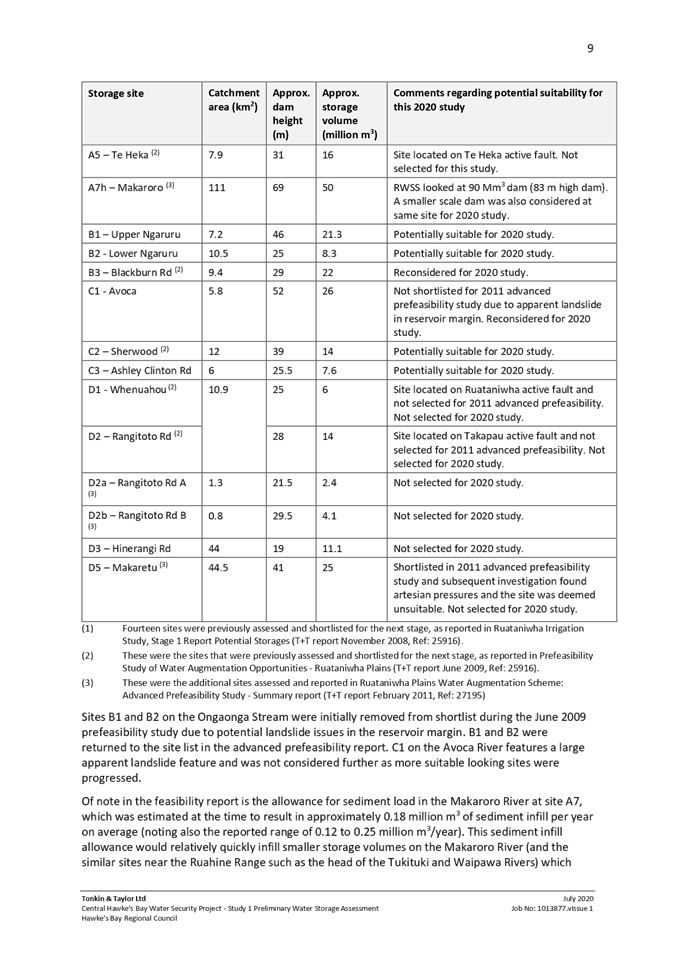
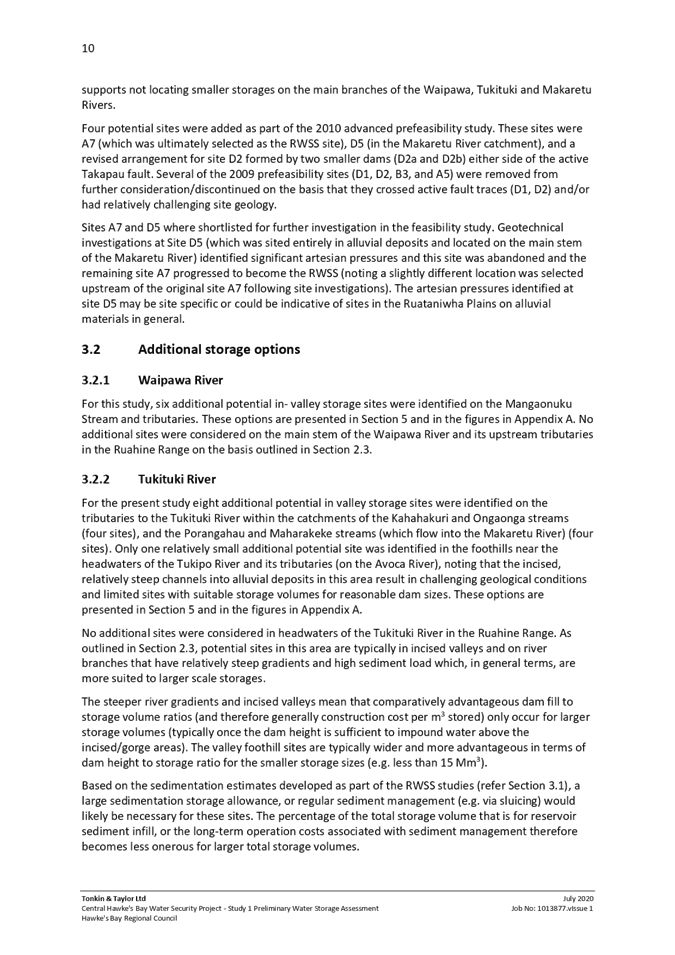

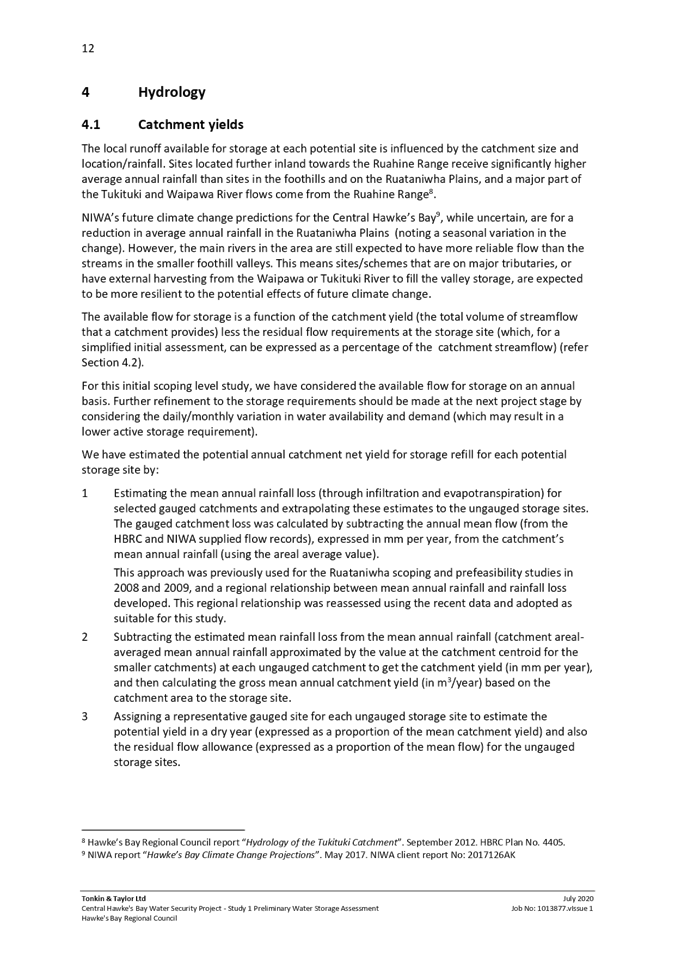
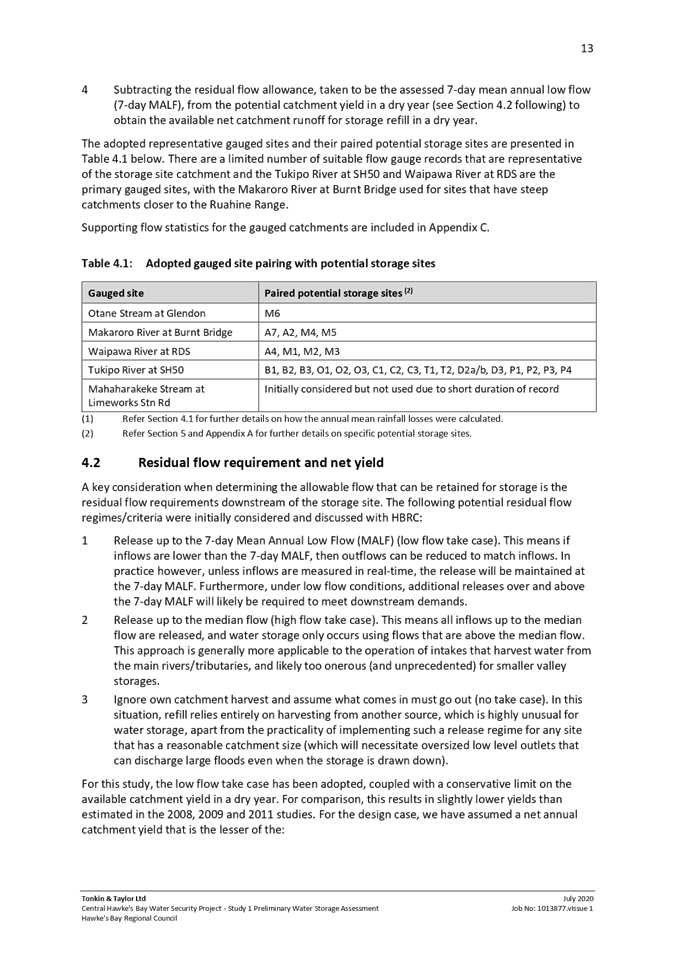
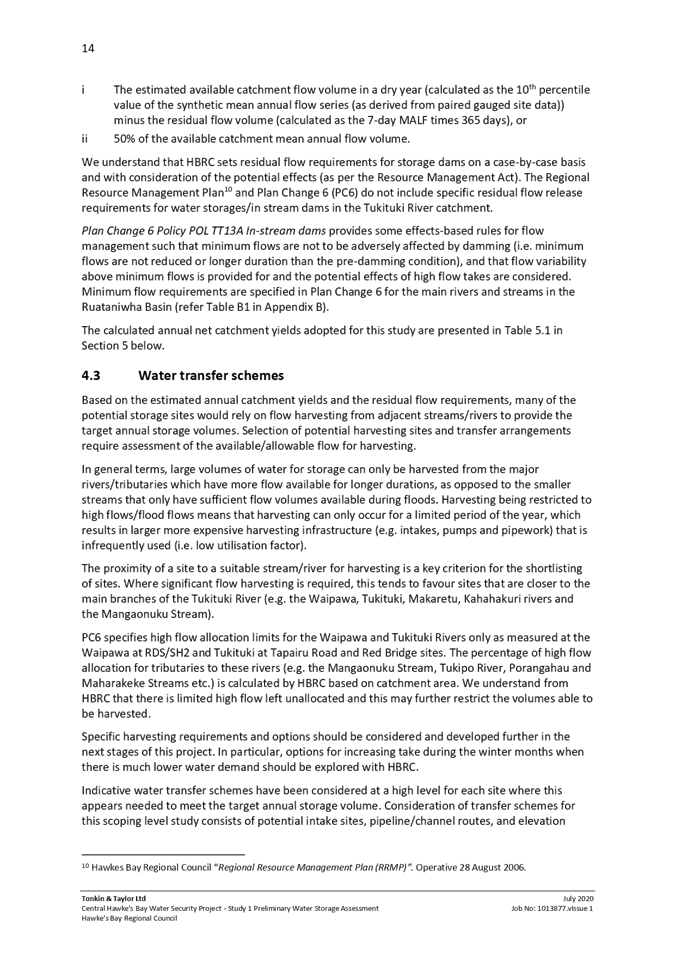

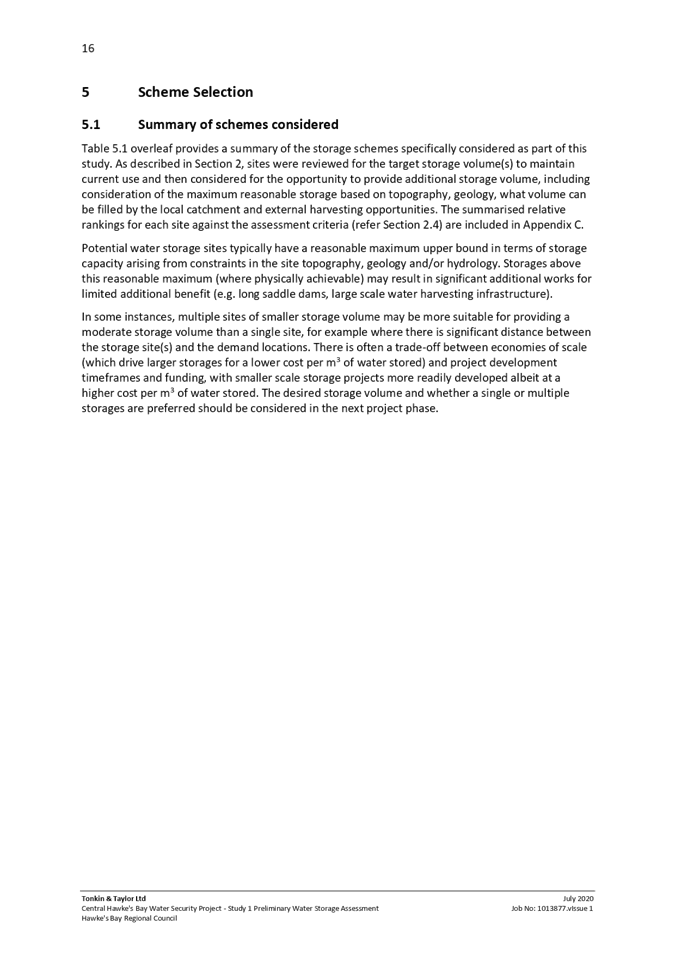
|
August
2020 Tonkin + Taylor CHB Water Security Project - Stage 1 Water Storage
Options Assessment
|
Attachment 2
|
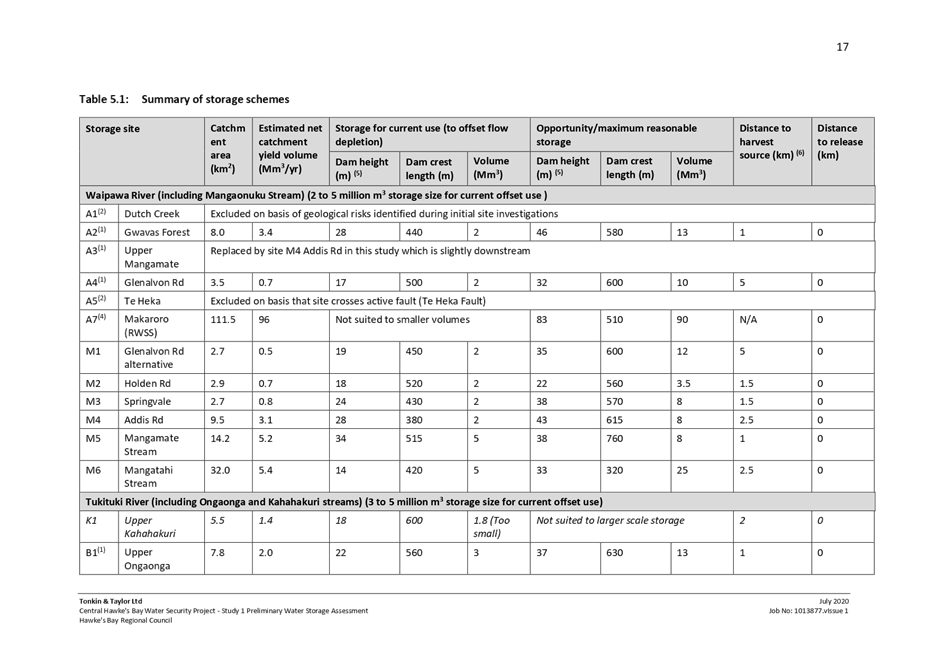
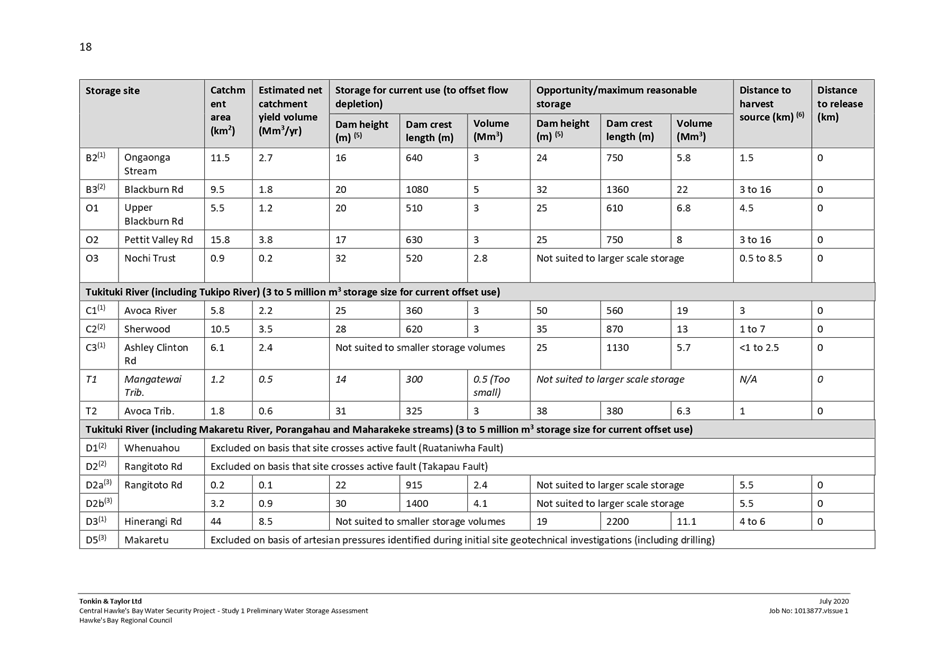
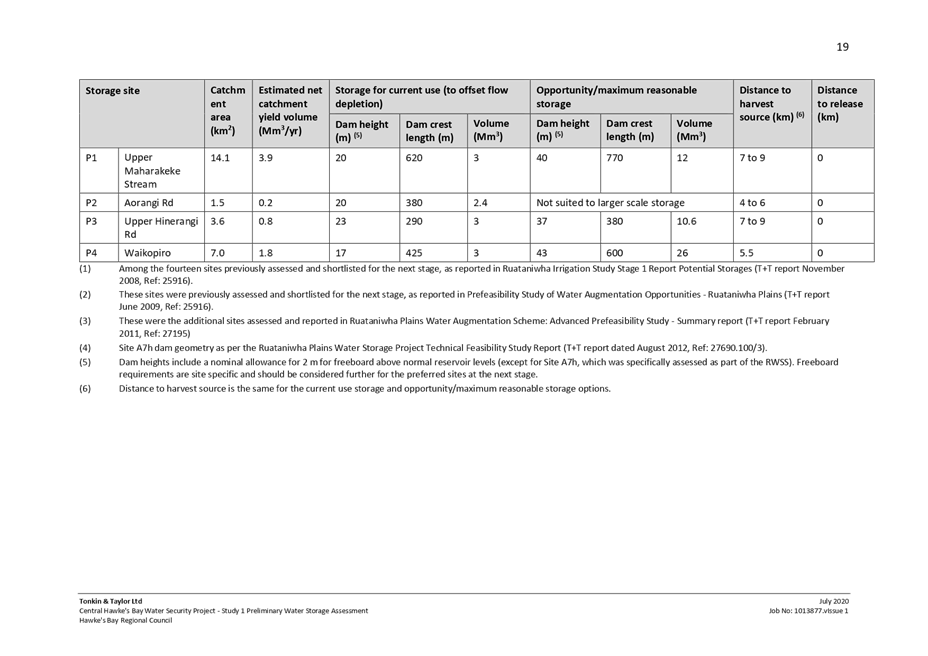
|
August
2020 Tonkin + Taylor CHB Water Security Project - Stage 1 Water Storage
Options Assessment
|
Attachment 2
|
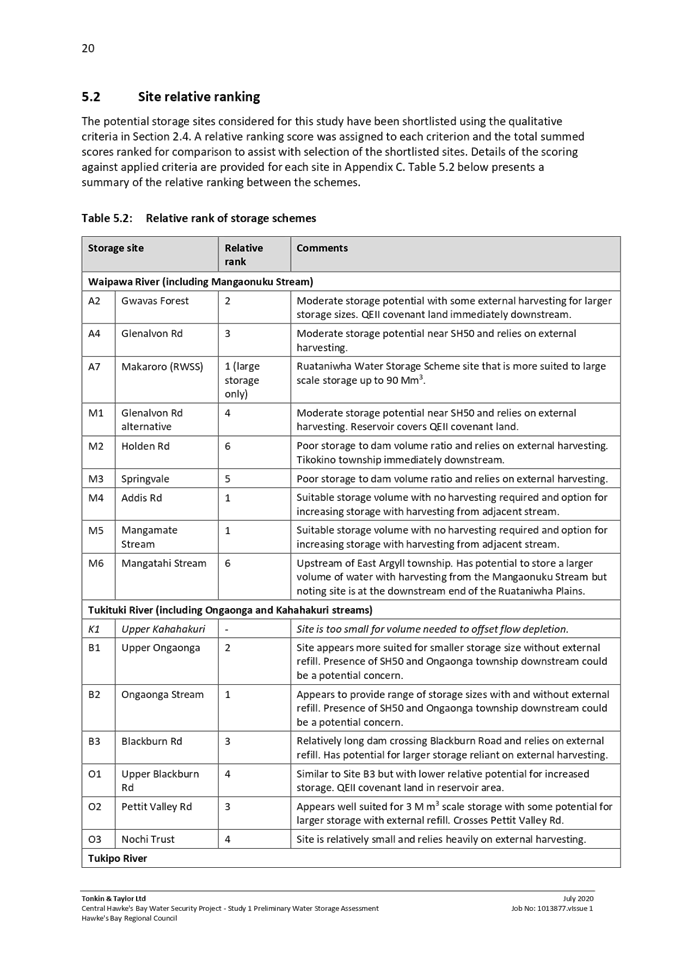
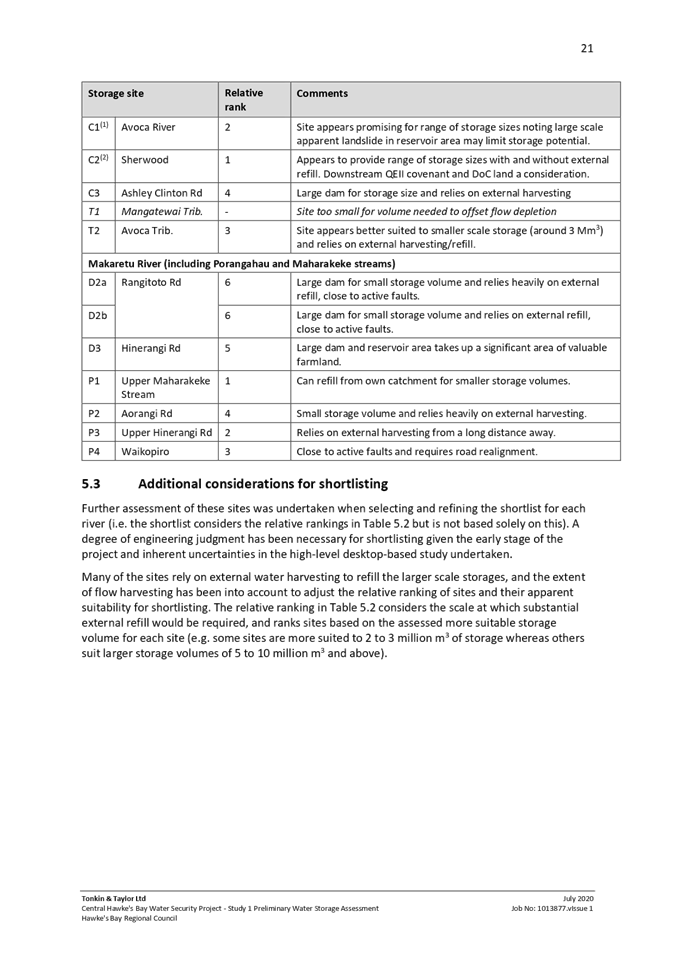
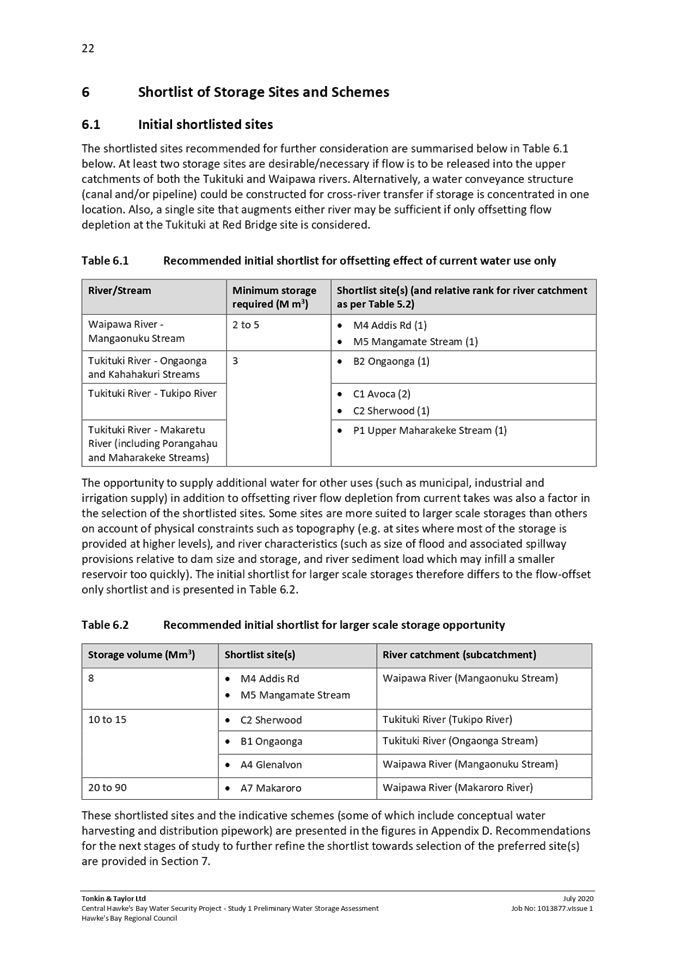
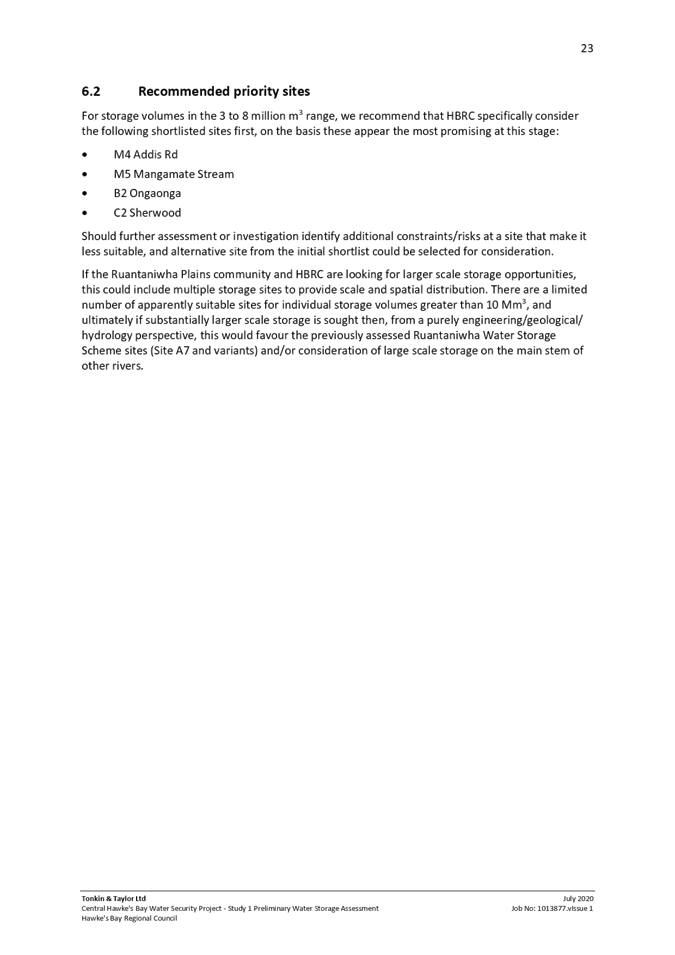
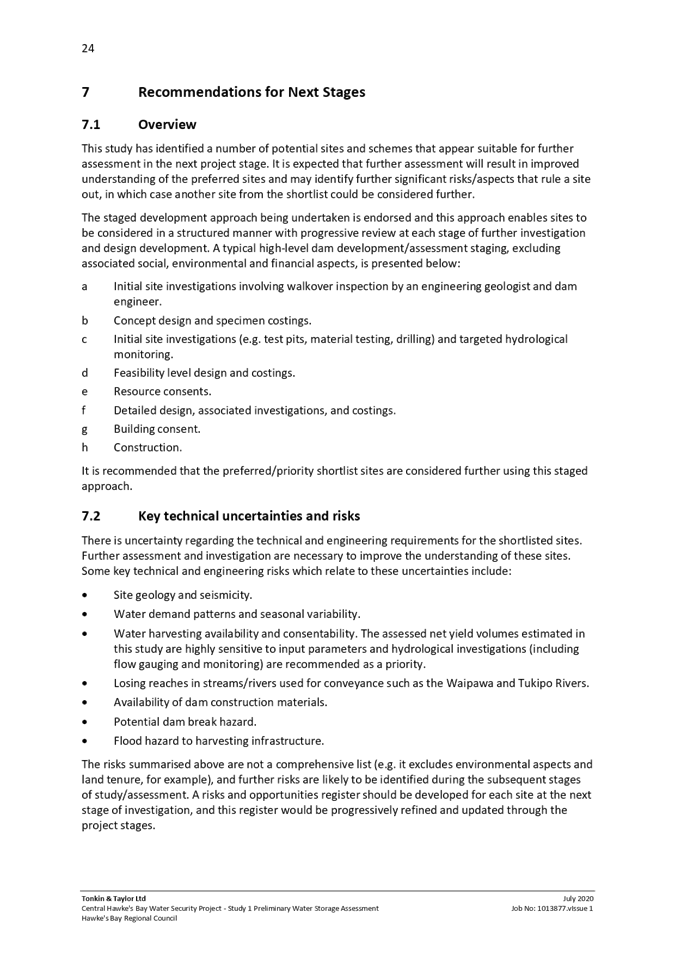
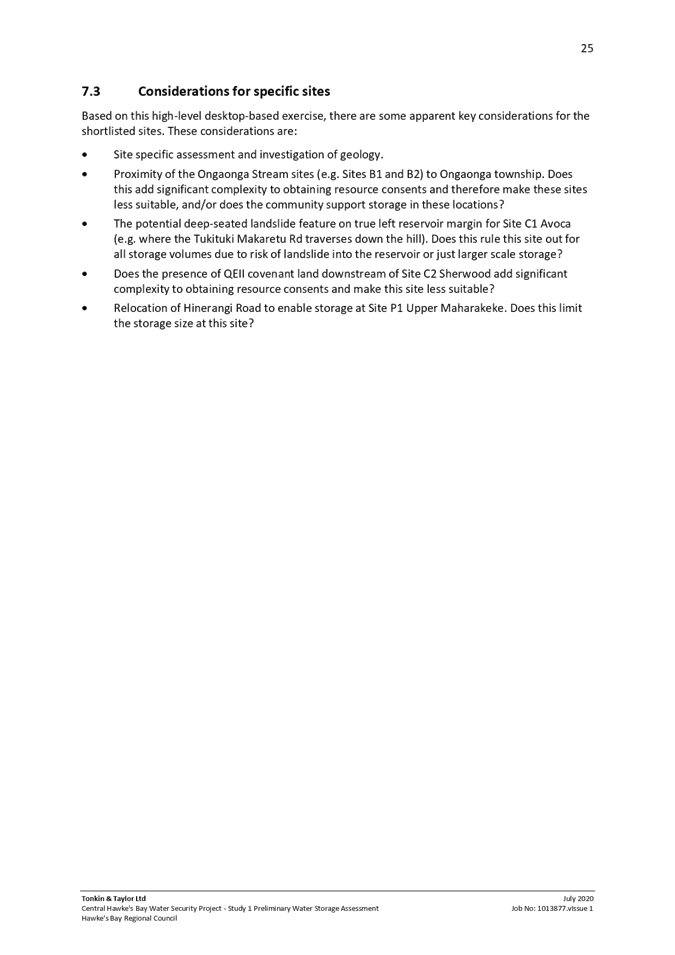
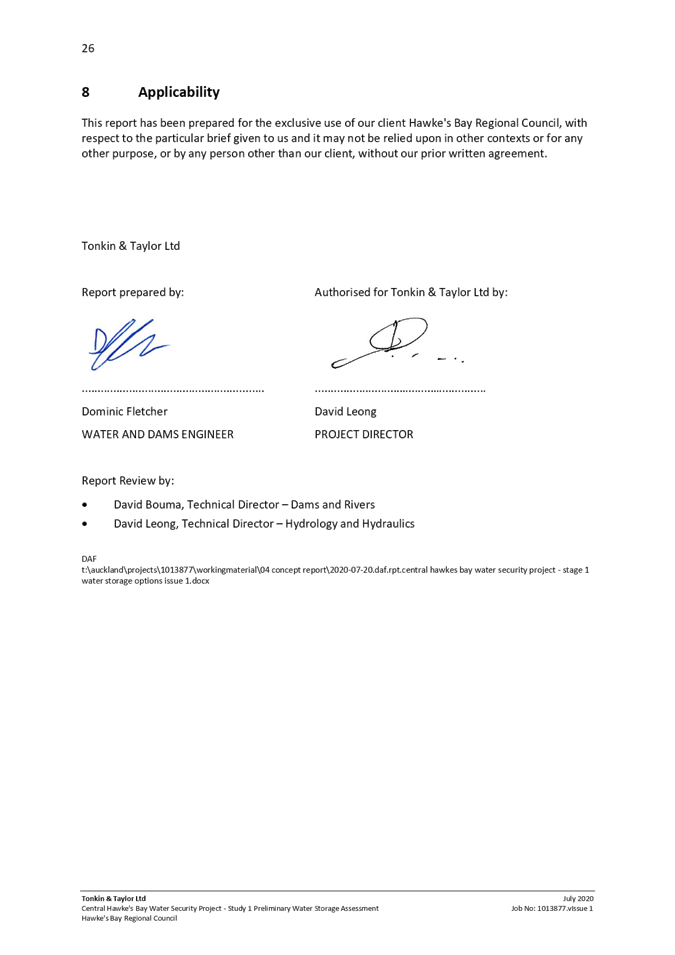


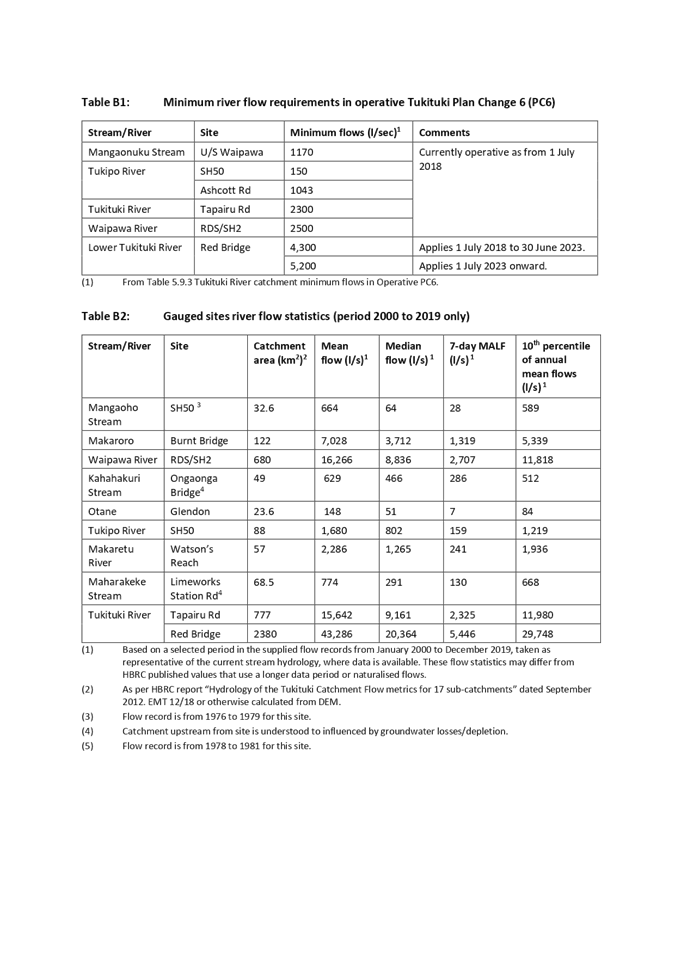

|
August
2020 Tonkin + Taylor CHB Water Security Project - Stage 1 Water Storage
Options Assessment
|
Attachment 2
|
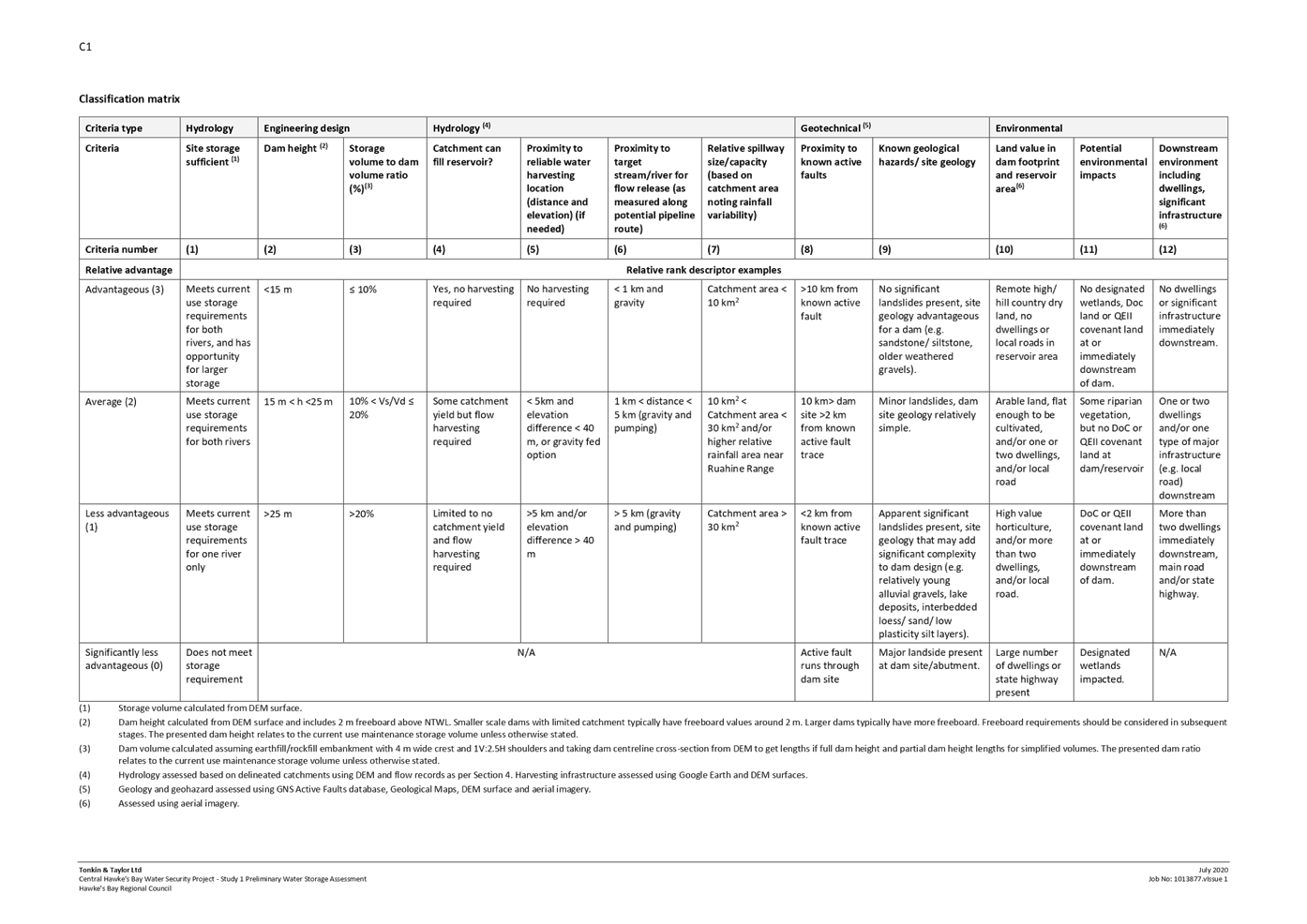
|
August
2020 Tonkin + Taylor CHB Water Security Project - Stage 1 Water Storage
Options Assessment
|
Attachment 2
|
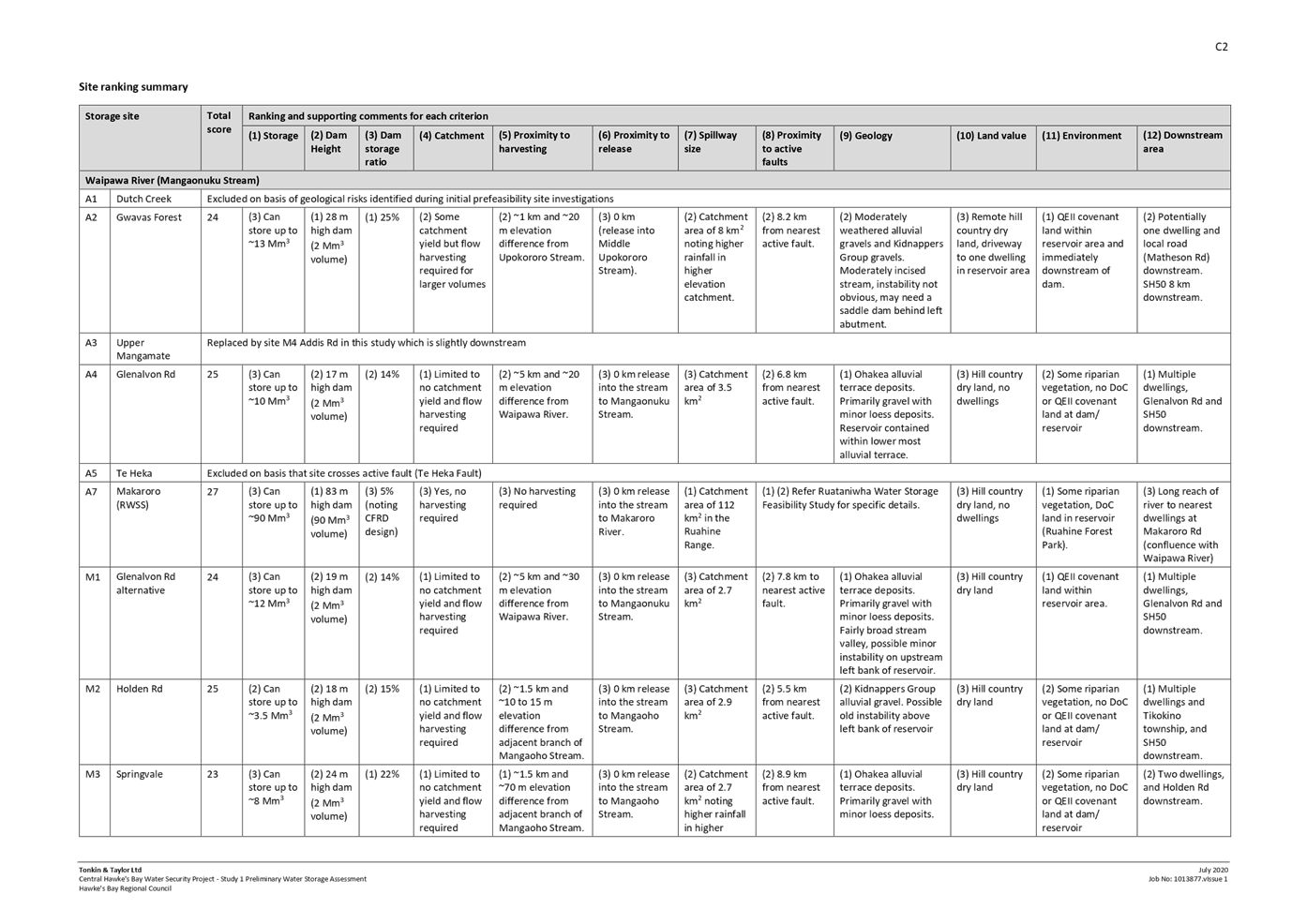
|
August
2020 Tonkin + Taylor CHB Water Security Project - Stage 1 Water Storage
Options Assessment
|
Attachment 2
|
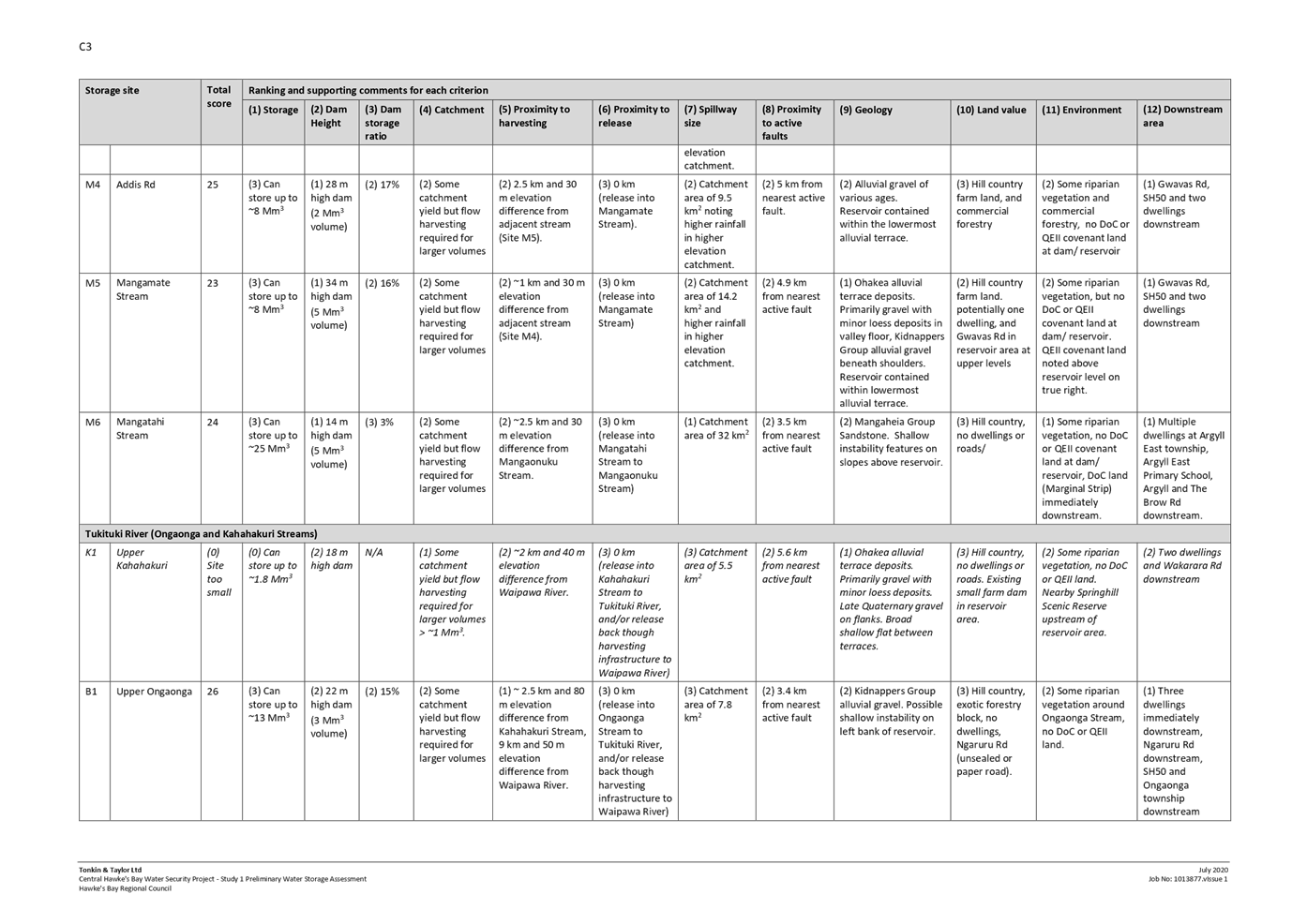
|
August
2020 Tonkin + Taylor CHB Water Security Project - Stage 1 Water Storage
Options Assessment
|
Attachment 2
|
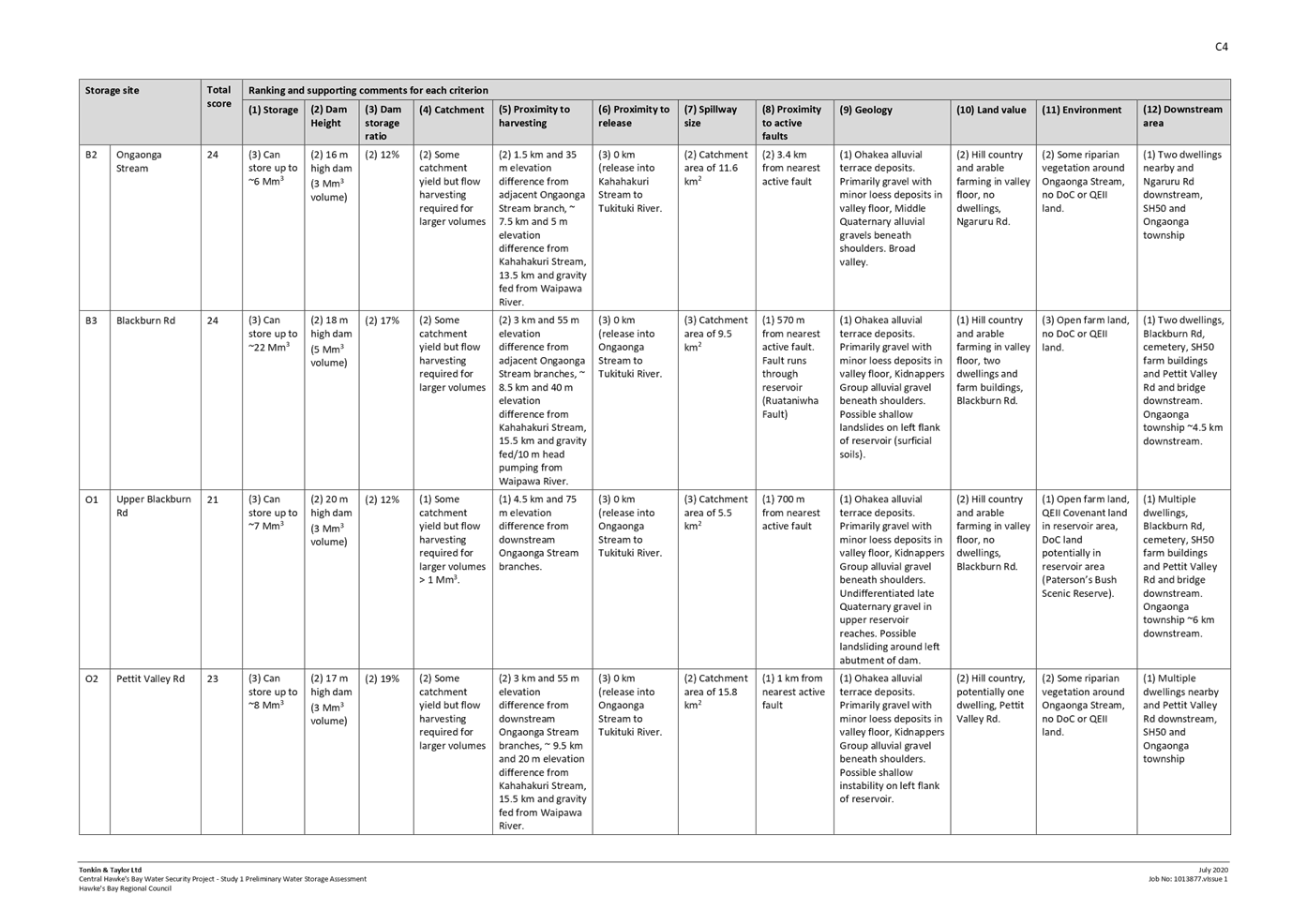
|
August
2020 Tonkin + Taylor CHB Water Security Project - Stage 1 Water Storage
Options Assessment
|
Attachment 2
|
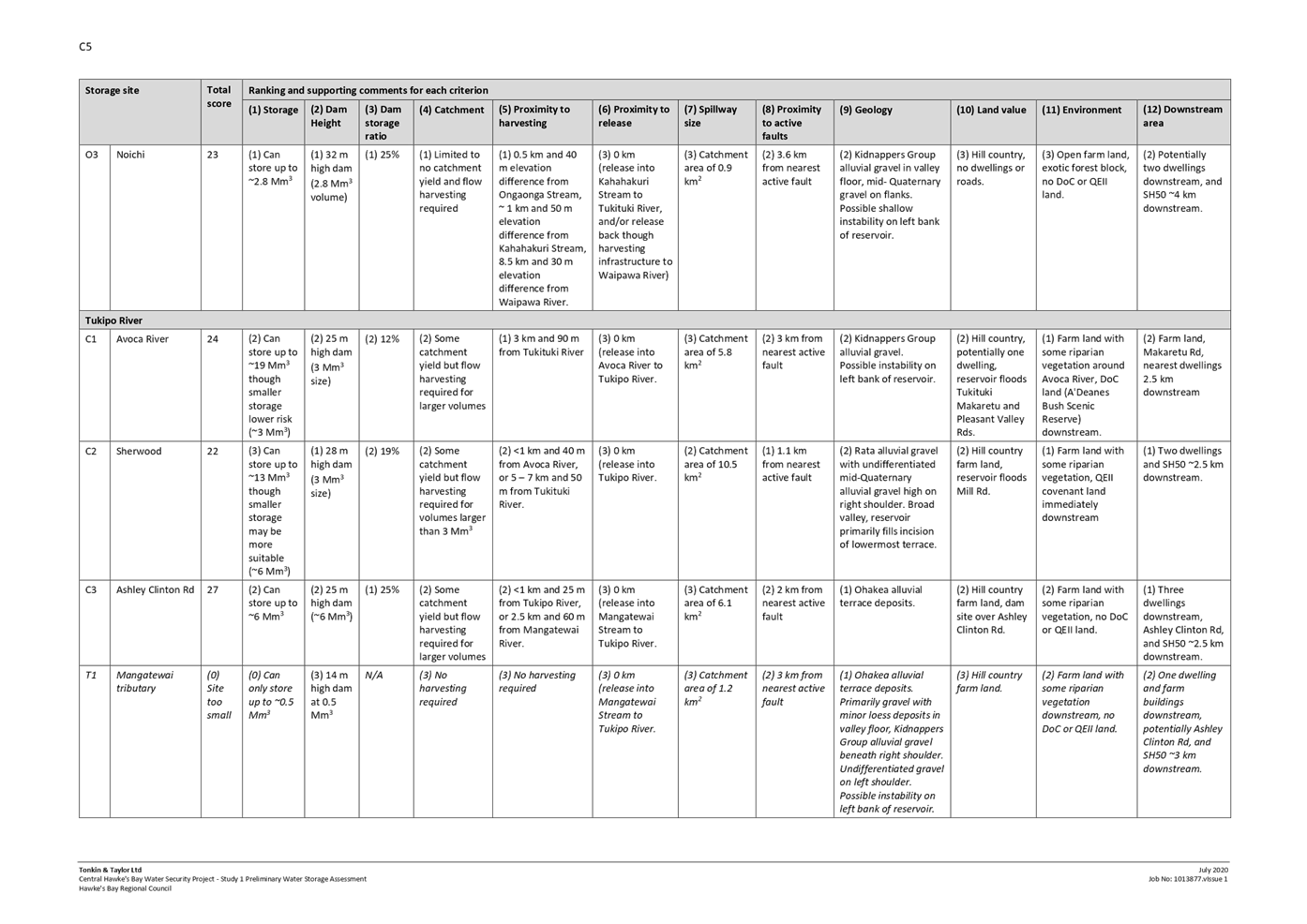
|
August
2020 Tonkin + Taylor CHB Water Security Project - Stage 1 Water Storage
Options Assessment
|
Attachment 2
|
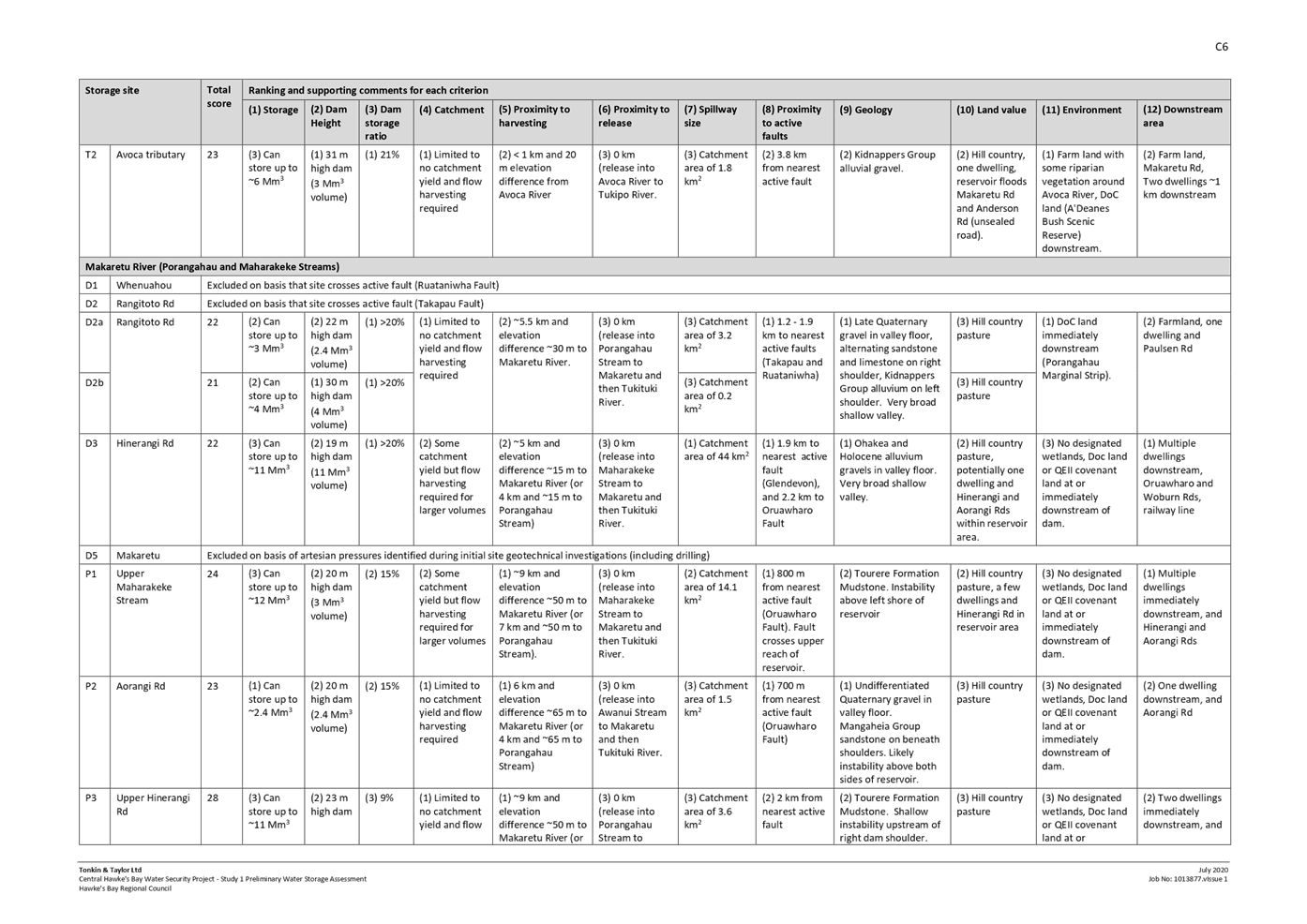
|
August
2020 Tonkin + Taylor CHB Water Security Project - Stage 1 Water Storage
Options Assessment
|
Attachment 2
|
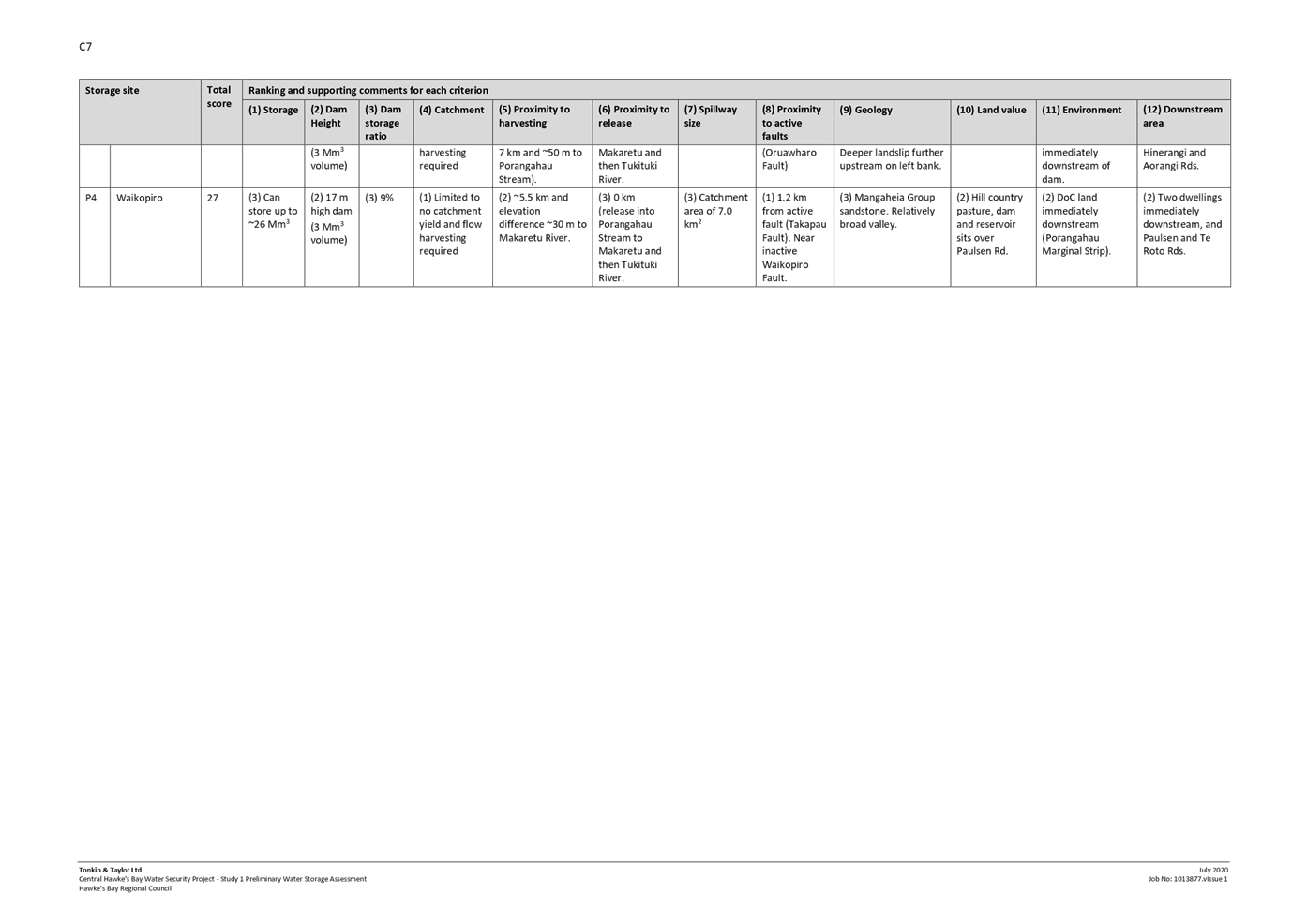
|
August
2020 Tonkin + Taylor CHB Water Security Project - Stage 1 Water Storage
Options Assessment
|
Attachment 2
|

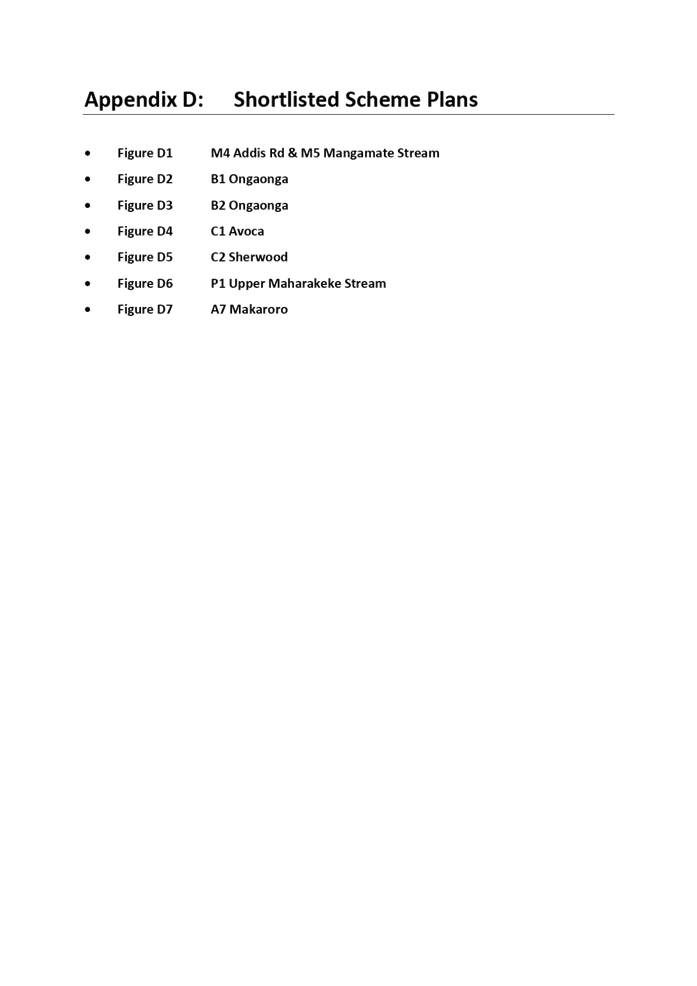

HAWKE’S BAY REGIONAL
COUNCIL
Corporate
and Strategic Committee
Wednesday 02 September 2020
Subject: Cycleway Co-funding
Reason for Report
1. This report
seeks support from the Council regarding the portion of funding required for
three priority Hawke’s Bay trail projects where this ensures that the
balance of funding already approved by MBIE can be accessed from Central
Government. These three projects were not considered in the LTP 2018-2028
but were subsequently outlined due to new government funding opportunities that
led to the Hawke’s Bay Trials Great Ride Business Case 2018-2023
approved by Council and the National Cycle Trail Network ‘Great
Rides’ body.
Officers’ Recommendations
2. Officers
recommend that the Council support the loan funding of $418,500 for the three
capital priority projects. This investment leads to the rest of the
required funding to be received.
Executive Summary
3. The
Hawke’s Bay Trails are the sum of three concept rides: The Water
Ride, The Wineries Ride and The Landscape Ride. Open all year round,
nearly 200kms of mostly off-road trail crisscross the plains and main rivers,
linking many of the sights in Napier, Ahuriri, Bay View, Taradale, Clive,
Haumoana, Te Awanga, Clifton, Havelock North, and Hastings. The trails
also form part of a public cycleway network that links the cities of the
region, connecting with the urban ‘I Way’ shared pathways of
Hastings and Napier and joining with the coastal and country settlements.
4. The trail
network, operates over multiple parcels of land owned by various entities,
including the Napier and Hastings Councils, DOC, Kiwirail, LandCorp and NZTA
with the HBRC owner of almost 84km of the network.
5. The
Hawke’s Bay Trails Great Ride Business Case 2018-2023 to Ministry
Business, Innovation and Employment outlined five new projects for the region
to improve safety, enhance and extend the trails over the next five
years. This was accompanied by Cost Benefit Analysis carried out by the
independent business management consultancy firm, Martin Jenkins. These
projects were approved by MBIE and 50% funding approved.
5.1. Safety
Priority Project Waimarama Road Improvements
5.2. Safety
Priority Project Ahuriri Underpass Improvements
5.3. Bay View to
Whirinaki Extension
5.4. Ngaruroro
Explorer
5.5. Karamū Stream
Extension.
Background/Discussion
6. The success of
the Hawke’s Bay Cycle Trails has been integrated with the ongoing
partnership between the key parties including HBRC, NCC and HDC and their
ability to work together and partner with Central Government to fund the
development of these trails as part of the NZ Great Rides network of trails.
7. After securing
central government funding for key extensions to the network, the objective of
this proposal is to ensure HBRC deliver on their responsibilities to fund the
supporting infrastructure required to bring the trails up to the level of the
other trails and ensure a consistent experience.
8. The extensions
will create greater connectivity between the trails and make it easier and
safer for riders to explore the Hawke’s Bay Region and continue to cement
Hawke’s Bay’s reputation as a cycling friendly region.
9. The Hawke's Bay
Trails officially opened in 2012 and consists of nearly 200km of off-road cycle
trails. There were more than 600,000 trips recorded across the network
last year, with research indicating 60 per cent of trail use is by locals and
40 per cent by visitors to the region.
10. The maintenance of the
trails is shared between other local authority partners. This will also
require contributions from district councils to trail surface renewal in the
future and their allowance for this in their respective LTPs.
11. Priority Project:
Waimarama Road Safety Improvements: Status – ready to build in
conjunction with Hastings District Council.
Sub-total
Estimated Budget: $717,000 2019/2020 HBRC
contribution required $93,500
|
Total
cost:
|
$717,000.00
|
HDC to
project manage/construct
|
|
Funding:
|
MBIE
|
$358,500.00
|
|
HDC
|
$230,000.00
(approved)
|
|
HBRC
|
$93,500.00
|
|
ECCT
|
$35,000.00
|
|
TOTAL
|
$717,000.00
|
12. Priority Project: Ahuriri
Underpass Improvements: Status – NZTA getting final consent and
ready to build seawall southern end, on existing trail.
Sub-total
Estimated Budget: $350,000 2019/2020 HBRC
contribution required $125,000
|
Total
cost:
|
$350,000.00
|
OPUS to
project manage/construct
|
|
Funding:
|
MBIE
|
$125,000.00
|
|
HBRC
|
$125,000.00
|
|
NZTA
|
$100,000.00
(NZTA consumed the design cost on top of the contribution)
|
|
TOTAL
|
$350,000.00
|
13. Priority Project: Bayview
Whirinaki trail: Status – Work underway this financial year.
Sub-total
Estimated Budget: $1,054,000 2020/2021
HBRC contribution required $200,000
|
Total
cost:
|
$1,054,000.00
|
NCC to
project manage/construct
|
|
Funding:
|
MBIE
|
$504,000.00
|
|
NCC
|
$250,000.00
(annual plan -approved)
|
|
HDC
|
$100,000.00
(annual plan- approved)
|
|
HBRC
|
$200,000.00
|
|
TOTAL
|
$1,054,000.00
|
14. Total Estimated HBRC
Budget 2020-21 and sum sought in this recommendation: $418,500
Options Assessment
15. The alternative option is
to not proceed with the providing partner funding to the projects and thus put
in jeopardy both the $848,500 of specific project funding for these three trail
projects for the Hawke’s Bay Region and potentially the overall $1.3M of
Central Government Funding:
15.1. Option 1 – HBRC
does not fund the share which may lead to the project not proceeding.
15.2. Option 2 – Raise
a loan for the required $418,500 during the 2020-21 financial year and repay
this over 10 years. The long-term benefits of improving the various cycleways
triggers an intergenerational component, therefore a 10-year loan would be
appropriate. Repayments assume a 3% Interest Rate over the life of the loan.
|
Increase in
General Rate requirement
|
$48,596
|
|
Total
Repayment over 10 years
|
$485,964
|
Strategic Fit
16. These projects align with
councils’ priorities of: Smart, sustainable land use, healthy and
functioning biodiversity and sustainable services and infrastructure.
17. Specifically, the Cycle
Trails network contributes to the Community Outcome of:
17.1. Sustainable Services and
Infrastructure
17.2. As per the Hawke’s
Bay Regional Cycle Plan 2015, the vision for cycling in the region is:
“To recognise
cycling in Hawke’s Bay to such an extent that the region is nationally
and internationally recognized as providing the most bike-friendly experience
in New Zealand”
18.3 HBRC,
along with other key partners, developed this strategy with the aim to maximise
the financial and social returns from cycling in the areas of:
18.3.1 Liveability
18.3.2 Health
18.3.3 Tourism.
18. The benefits are extensive
and deliver on HBRC’s Long Term Plan Community Outcomes:
18.1. Vibrant Community:
An opportunity for safer cycle network connectivity allowing community
recreation, events and cycle commuting, thus reducing vehicle congestion, and
more liveable cities
18.2. Healthy Environment:
Providing an enduring infrastructure for cycling/walking/running; providing
safe off-road routes for recreation, sport and providing transport alternative
of cycle commuting, to reduce carbon emissions
18.3. Prosperous Economy:
These enhancements are highly integral to our tourism industry, these
improvements providing new routes, safer year-round, for local cycle tourism
operators, ensuring their survival, while connecting locals/visitors to local
business’s like hospitality, retail and accommodation.
Financial and Resource Implications
19. This proposal is for new
budget currently not allowed for in the Annual Plan (but have been raised as an
issue). The budget is specifically supporting infrastructure including
trail building with wayfinding signage, fencing and maintenance overall,
covered by other budgets to be included in the LTP draft where these would
follow trail construction. There will be no impact on FTEs. Maintenance
cost will be minimal and only on HBRC land and HBRC owned asset. Majority of
the assets are vested in Hastings District Council and NZTA respectively.
|
Description
|
2020-21
|
Year 1
|
Year 2
|
Year 3
|
|
FTEs
|
|
|
|
|
|
|
OPEX
|
Internal time
|
|
|
|
|
|
Consultancy
|
|
|
|
|
|
Maintenance & Enhancement
|
|
$8,500
|
$8,500
|
$8,500
|
|
CAPEX
|
|
$418,500
|
|
|
|
Consultation
20. The key stakeholders
include Hastings District Council, Tāngata Whenua, Ministry of Business,
Innovation & Employment, private landowners and NZ Transport Agency.
Waimarama Road Safety Project team has completed an archaeological assessment
and hui-ā-hapū with mana
whenua of Heretaunga.
Other Considerations
Benefits
21. The benefits of the Great
Rides have been documented in an evaluation report in 2016 which show that:
21.1. around 1.3 million
people used the 22 Great Rides of Ngā Haerenga, the New Zealand Cycle
Trail
21.2. around 86.5% of users of
the Great Rides were New Zealanders, and just over 114,000 or 13.5% were
international visitors
21.3. for every dollar
attributed to construction and maintenance of the Great Rides during 2015,
approximately $3.55 of annual benefits were generated
21.4. the economic
contribution of the cycle trails in 2015 was estimated at $37.4 million
21.5. the social contribution
of the Great Rides was estimated to be $12 million. This includes reduced mortality
and cost savings from diseases associated with physical inactivity
21.6. key factors of
successful governance included having a clear strategy, marketing expertise and
dedicated resource for trail maintenance.
22. An extension of these
highly valued assets will continue to make them appealing to Hawke’s Bay
residents and form part of a strong domestic tourism offering which will
continue to attract visitors to the region and provide valuable economic
stimulus.
Strategic Context
23. The strategies and plans
used to inform this report are as follows;
23.1. Hawke’s Bay Trails
Great Ride Business Case 2018-2023
23.2. Hawke’s Bay Trail
CBA Summary – Martin Jenkins report
23.3. Hawke’s Bay
Regional Cycle Plan 2015
23.4. Government Policy
Statement on land transport (GPS)2018
24. The trails’ purpose
is primarily recreation and supports both the Recreation and Economic outcomes
and values of the Regional Park Network Plan.
Linkage with Overall Investment and
Priority Projects
25. The other two trail projects
in (5) above have already attracted investment. In April 2019 Tourism Minister
Kelvin Davis, announced the investment to create an extra 27km of new cycle
ways around Napier and Hastings and extend the existing network of Cycle
Trails. The two projects to gain funding in Hawke's Bay were:
25.1. A 16km Ngaruroro
Explorer which will provide an attractive, easy and off-road loop route around
the Ngaruroro River. ($764, 500 initial estimation - Hawke’s Bay Trails
Great Ride – Business Case 2018 to 2023)
25.2. A 11km Karamū
Stream extension which will create a safe, off-road link to the Wineries
Ride.($913,000 initial estimation Hawke’s Bay Trails Great Ride –
Business Case 2018 to 2023)
25.3. Funding decision for
these projects will be advanced through the 2021-2031 LTP.
Decision
Making Process
26. Council
and its committees are required to make every decision in accordance with the
requirements of the Local Government Act 2002 (the Act). Staff have assessed
the requirements in relation to this item and have concluded:
26.1. The
decision does not significantly alter the service provision or affect a
strategic asset, nor is it inconsistent with an existing policy or plan.
26.2. The use
of the special consultative procedure is not prescribed by legislation nor required
under HBRC’s policies with respect to this legislation.
26.3. The
decision is not significant under the criteria contained in Council’s
adopted Significance and Engagement Policy.
26.4. The persons affected by
this decision are all persons with an interest in the region’s cycle
trail use and network opportunities.
26.5. Given
the nature and significance of the issue to be considered and decided, and also
the persons likely to be affected by, or have an interest in the decisions
made, Council can exercise its discretion and make a decision without
consulting directly with the community or others having an interest in
the decision. “One way’ communication may be used to inform project
partners and the community on council’s contribution to these existing
projects being led and undertaken by other agencies where HBRC is primarily a
funding partner.
|
Recommendations
1. That the Corporate and Strategic Committee receives and approved
the “Cycleway co-funding” staff report.
2. The Corporate and Strategic Committee recommends that
Hawke’s Bay Regional Council:
2.1. Agrees that the decisions to be made are not significant under the
criteria contained in Council’s adopted Significance and Engagement
Policy, and that Council can exercise its discretion and make decisions on
this issue without conferring directly with the community or persons likely
to have an interest in the decision.
2.2. Support and approves the loan funding of $418,500 for the
Waimarama Road Safety Improvements, Ahuriri Underpass Improvements, and
Bayview Whirinaki Trail capital priority projects to leverage Central
Government funding approved by the Ministry for Business Innovation and
Employment.
|
Authored by:
|
Martina
Groves
Acting Regional Asset Manager
|
|
Approved by:
|
Chris
Dolley
Group Manager Asset Management
|
|
Attachment/s
There are no
attachments for this report.
HAWKE’S BAY REGIONAL COUNCIL
Corporate
and Strategic Committee
Wednesday 02 September 2020
Subject: Organisational
Performance Report for period 1 April to 30 June 2020
Reason
for Report
1. The Organisational Performance Report provides the information
councillors need as governors to track performance against the level of service
measures set in the 2018 Long Term Plan. It provides essential business
intelligence and situation-specific factors affecting the organisation’s
ability to deliver on what it said it would. It also holds staff to
account for non-financial and financial performance and signals through traffic
light status reporting issues that may require management intervention.
2. The report is also useful in the preparation for the next long term
plan as it familiarises councillors with the current levels of service and how
we deliver them. Any significant changes to levels of service require
consultation with the community and are typically done during a long term plan.
Content of the Report
3. Attached is the Organisational Performance Report for Quarter 4 of
2019-20. The quarter is the three months from 1 April to 30 June 2020,
and contains three parts plus an Executive Summary with highlights and
lowlights for the quarter.
3.1. Part 1: Significant
Events or Programmes impacting this quarter. These tend to be
cross-council so sit outside the groups of activities section
3.2. Part 2: Business
Improvement measures which focus on how well we are performing across a
number of corporate-wide measures such as health and safety incidents, and
response to customer feedback
3.3. Part 3: Groups
of Activities –Traffic light status and commentary on level of service
measures and related 3-digit code workstreams.
4. This quarterly report includes commentary on the
impacts of COVID-19 and the drought on Council’s activities and related
budgets.
Background
5. This is the sixth Organisational Performance Report to be
presented. Improvements continue to be made to the content to ensure the
information is meaningful for governors and to the process for collating the
information to reduce reporting burden for staff.
6. Staff complete their reporting in a software tool called Opal3 once
actual financial results for the quarter are loaded on the 20th of
the month following the end of the quarter. Staff choose the status (red,
amber, green) of non-financial results, but it is fixed against agreed criteria
for financial results. For example, red is set at >$30,000 or >10%
over or under budget. Staff are then required to provide commentary on
what they did in the quarter in terms of actual non-financial performance and
to explain any variations to operating budgets.
7. A separate report going to the same council meeting presents
aggregated financial performance at the group of activities level for the year
end as well as carry forwards.
Change between quarters
8. When the Quarter 2 Organisational Performance Report was presented
to council, it was noted by a Councillor that it was difficult to see how we
are tracking. The following graphs attempt to show the change between
quarters.
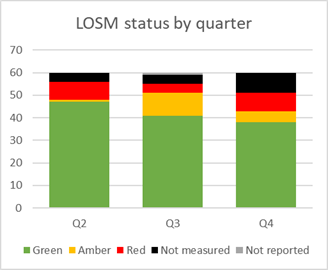
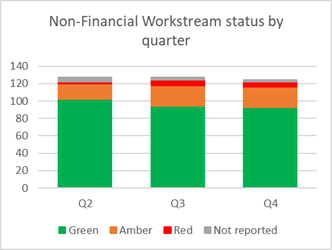
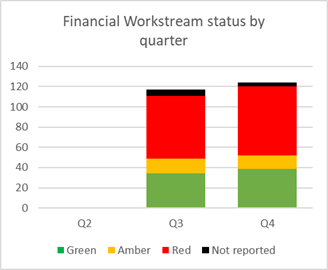
Next Steps
9. Further planned improvements to the Organisational Performance Report,
include setting targets for the business improvements measures, comparisons
with industry benchmarks where possible and the inclusion of capital
expenditure reporting next quarter.
10. Training with staff is ongoing to improve the quality of reporting.
Decision
Making Process
11. Staff have assessed the
requirements of the Local Government Act 2002 in relation to this item and have
concluded that, as this report is for information only, the decision making
provisions do not apply.
|
Recommendation
That Hawke’s Bay Regional Council
receives and notes the “Organisational
Performance Report for period 1 April to 30 June 2020”.
|
Authored by:
|
Kelly Burkett
Business Analyst
|
|
Approved by:
|
Desiree Cull
Strategy and Governance Manager
|
|
Attachment/s
|
⇩1
|
HBRC Organisational
Performance Report 1 April - 30 June 2020
|
|
|
|
HBRC
Organisational Performance Report 1 April - 30 June 2020
|
Attachment 1
|
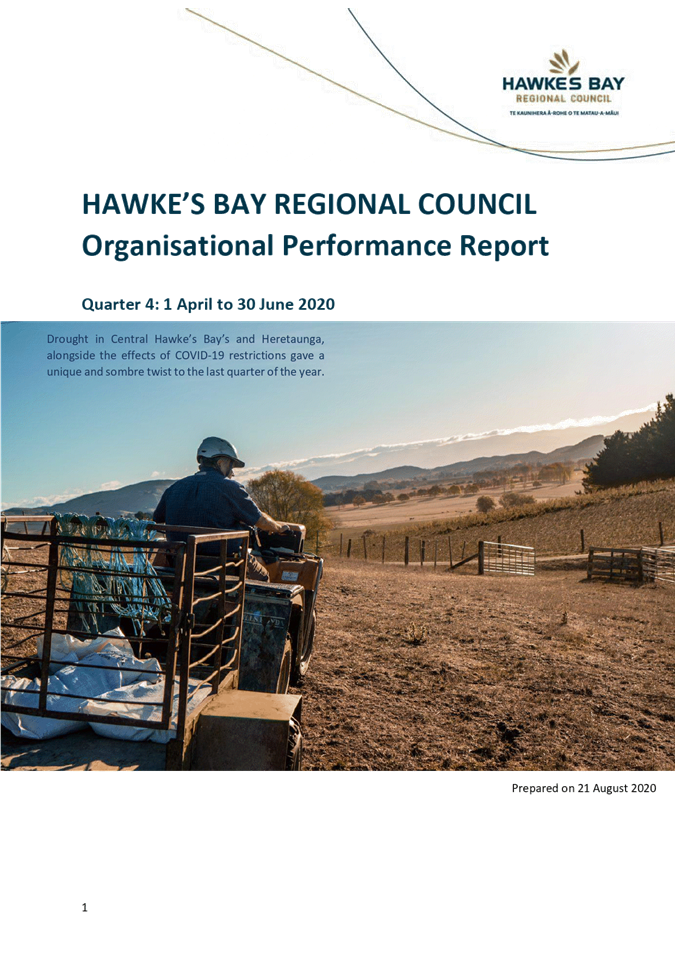
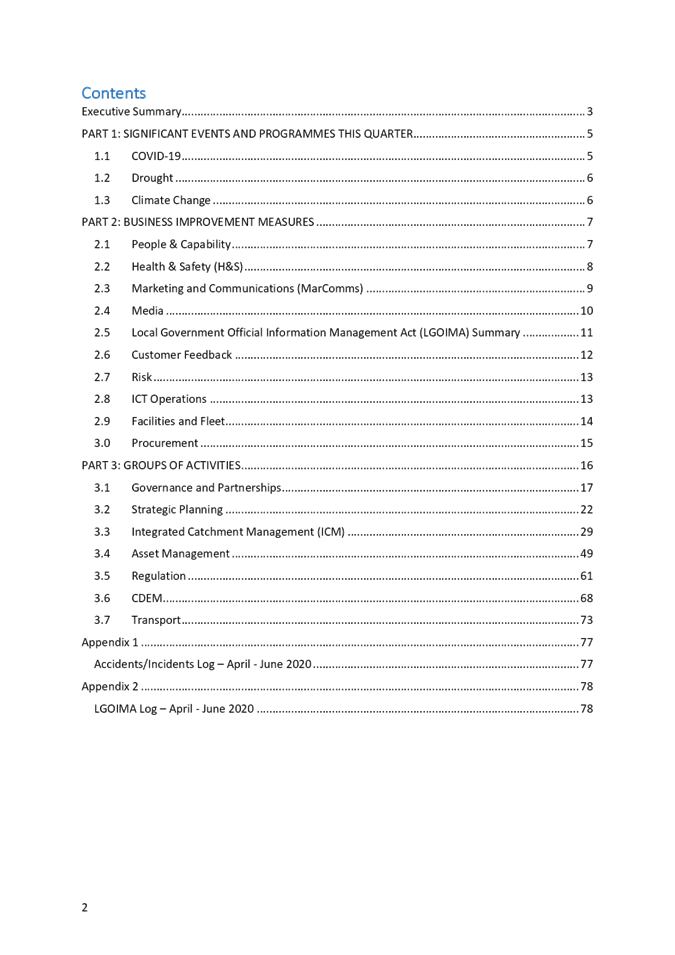
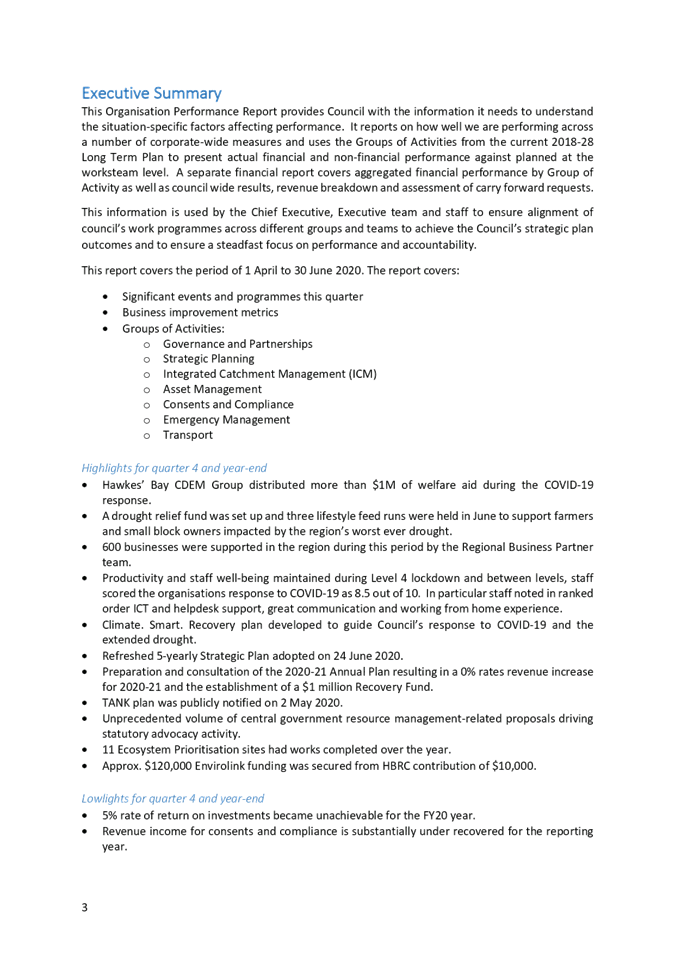

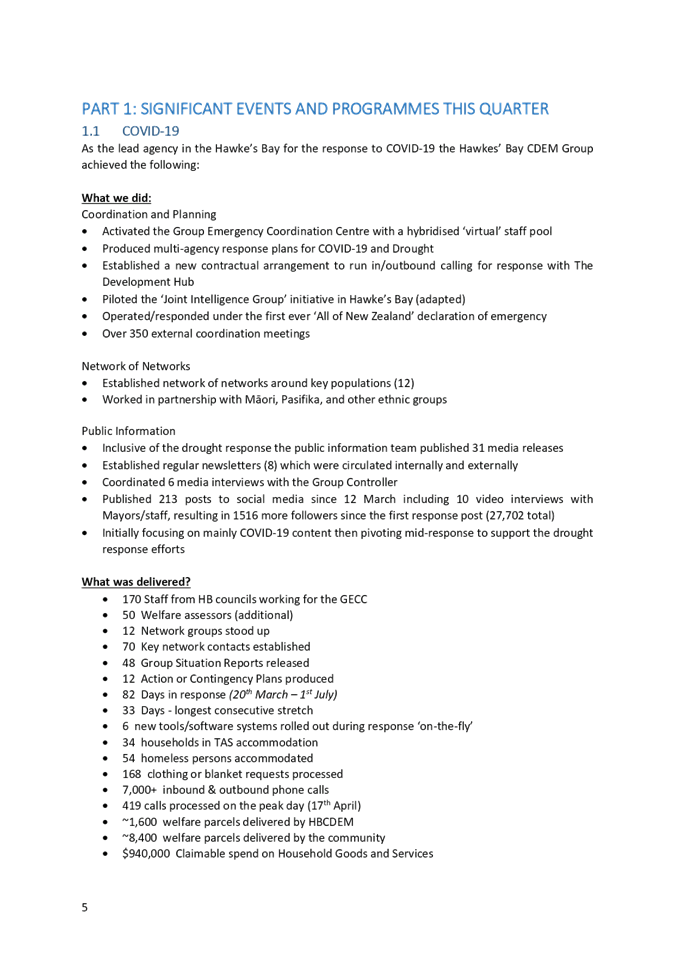

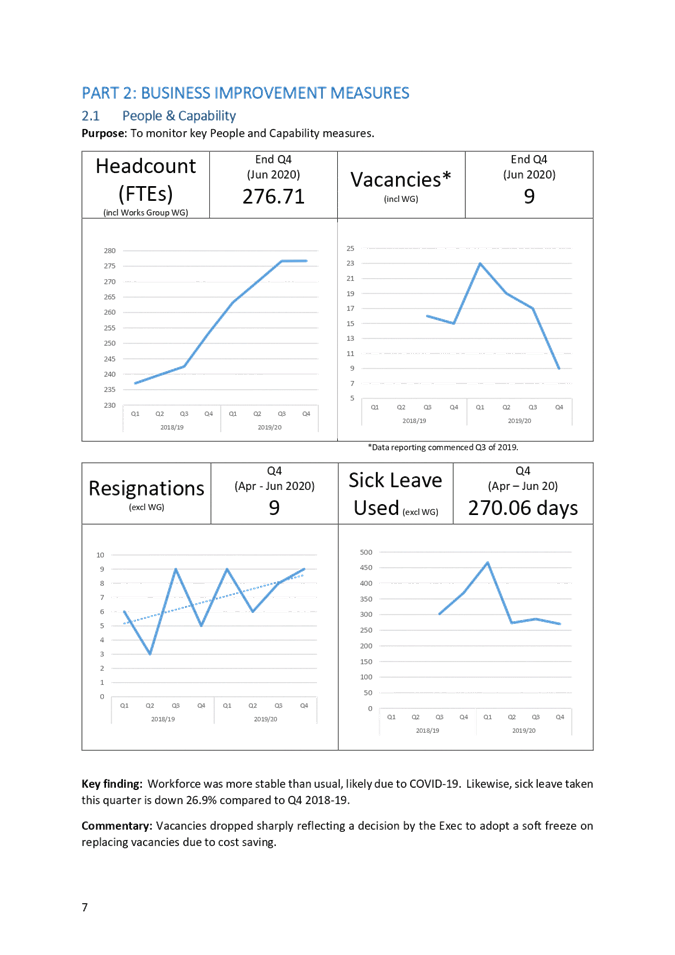
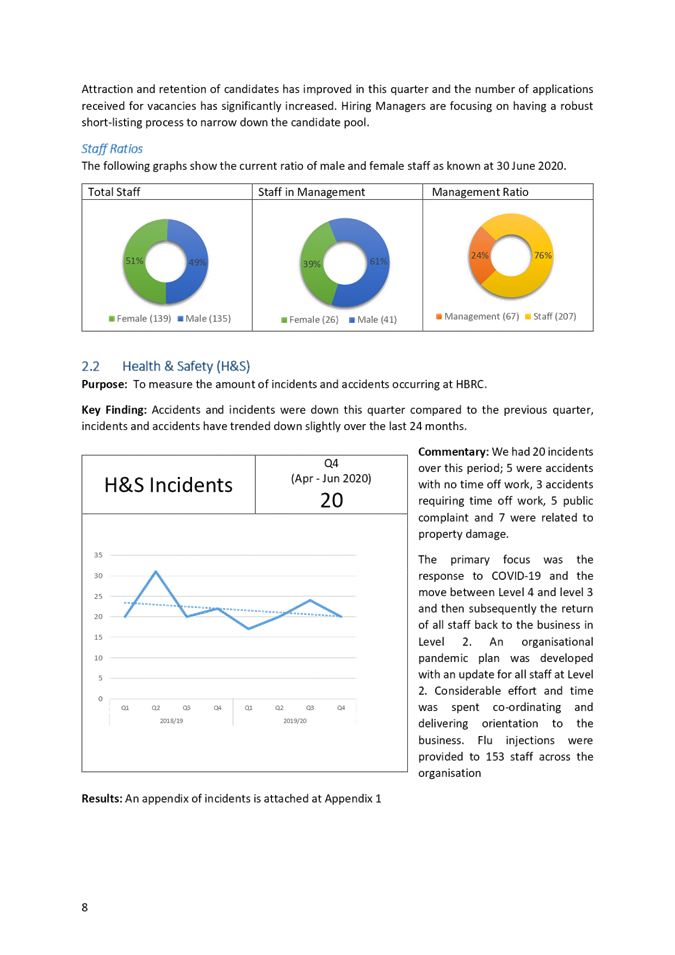
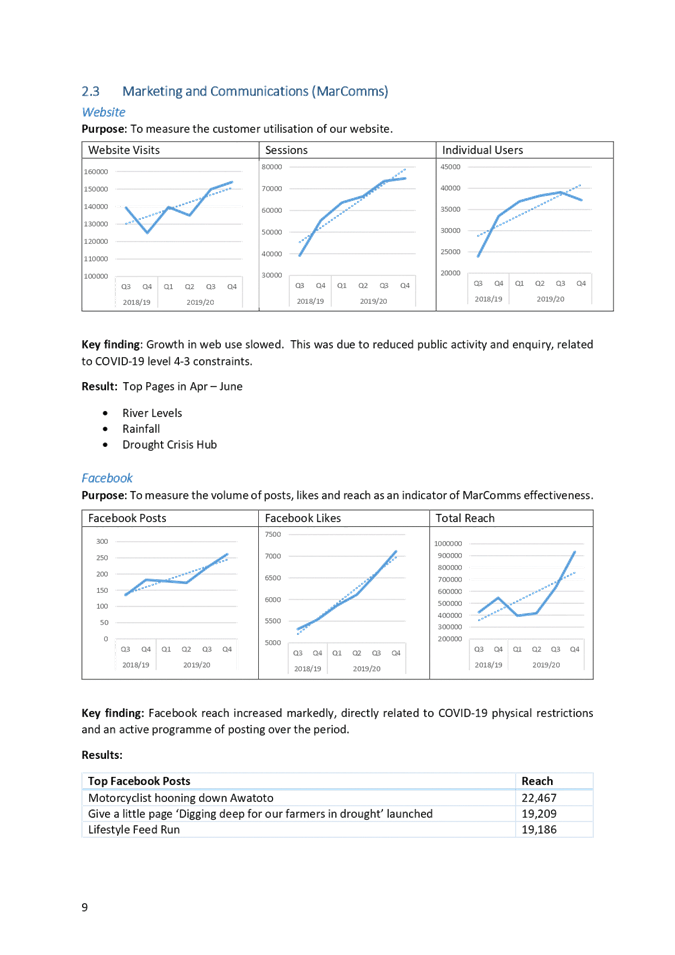
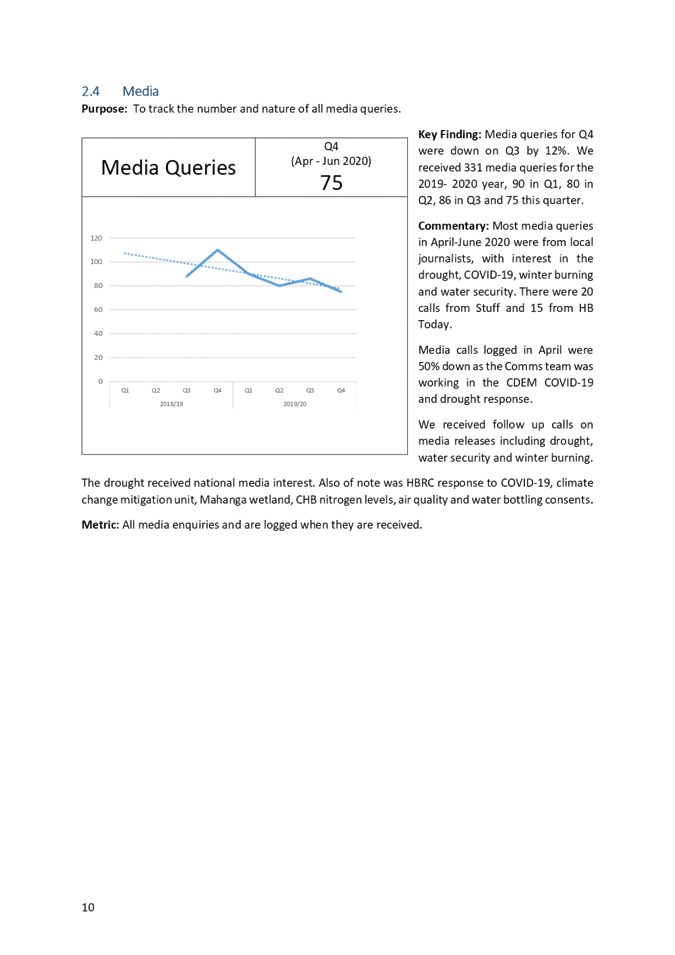
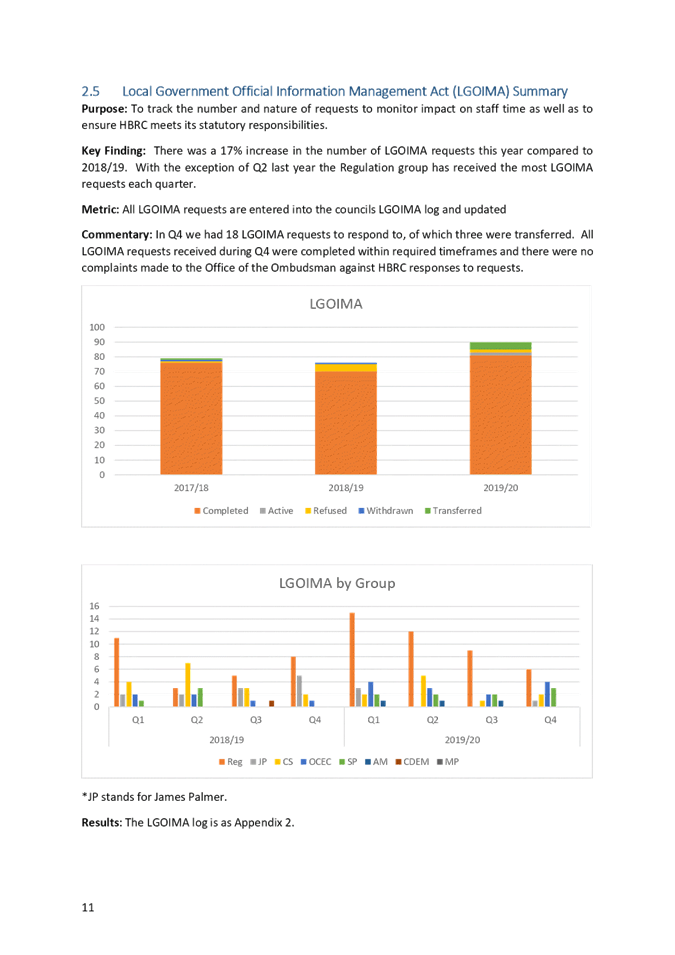
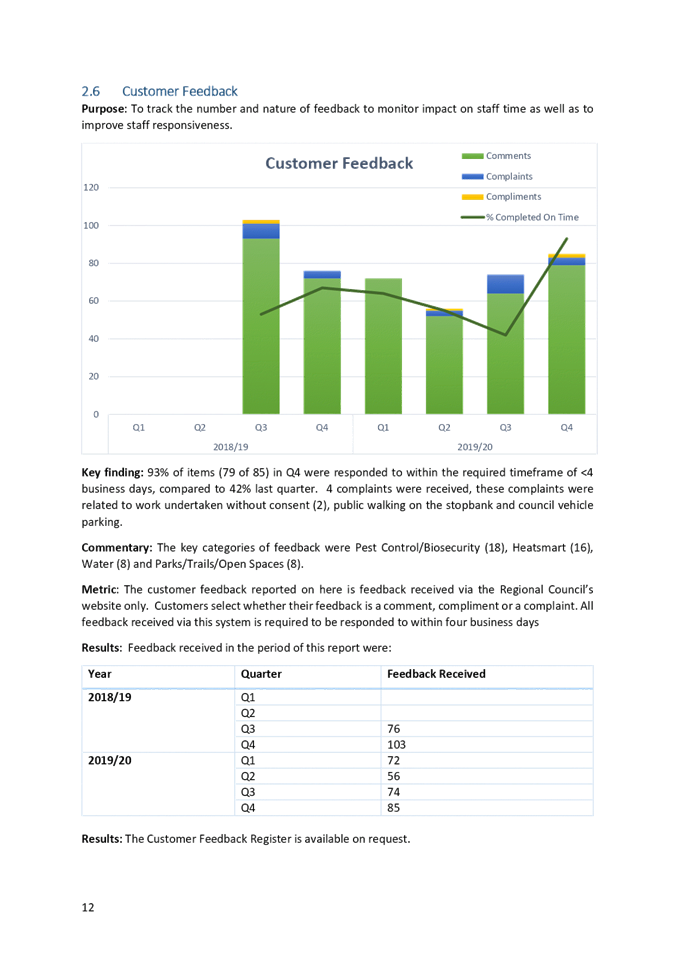

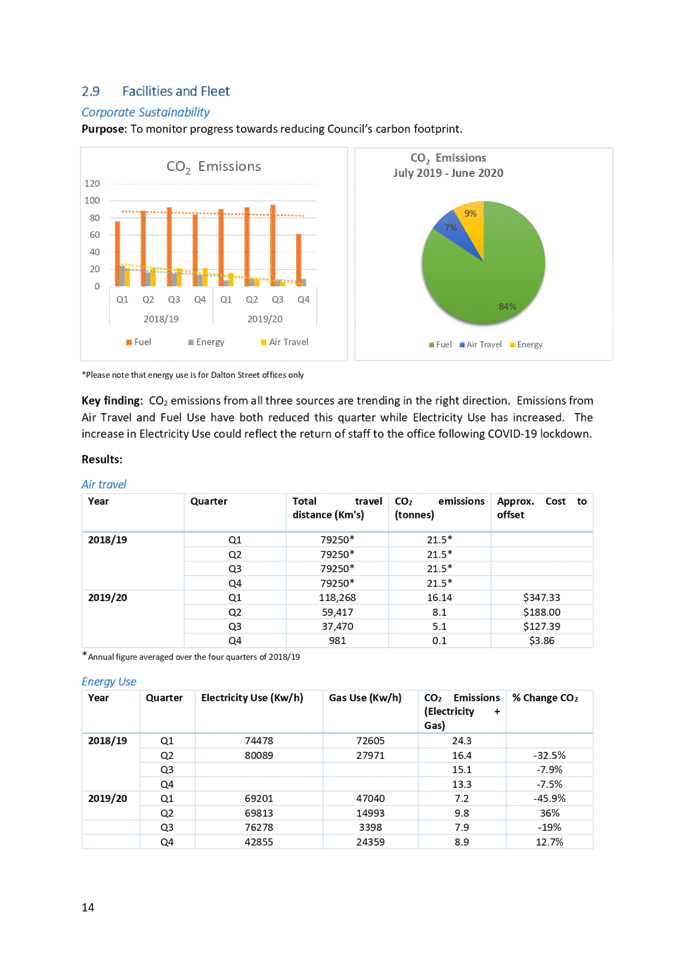
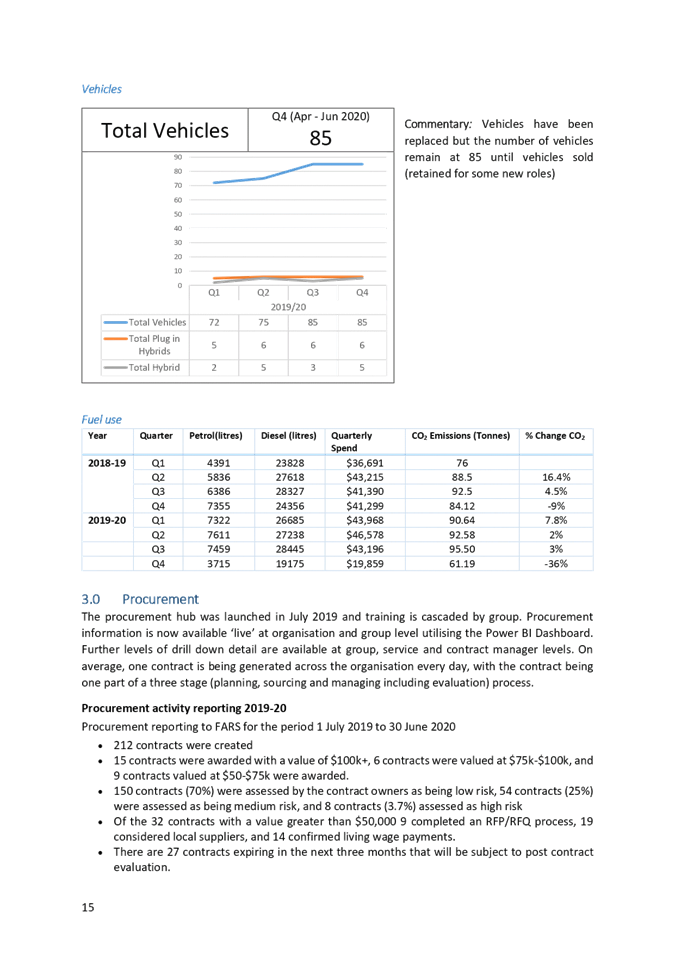
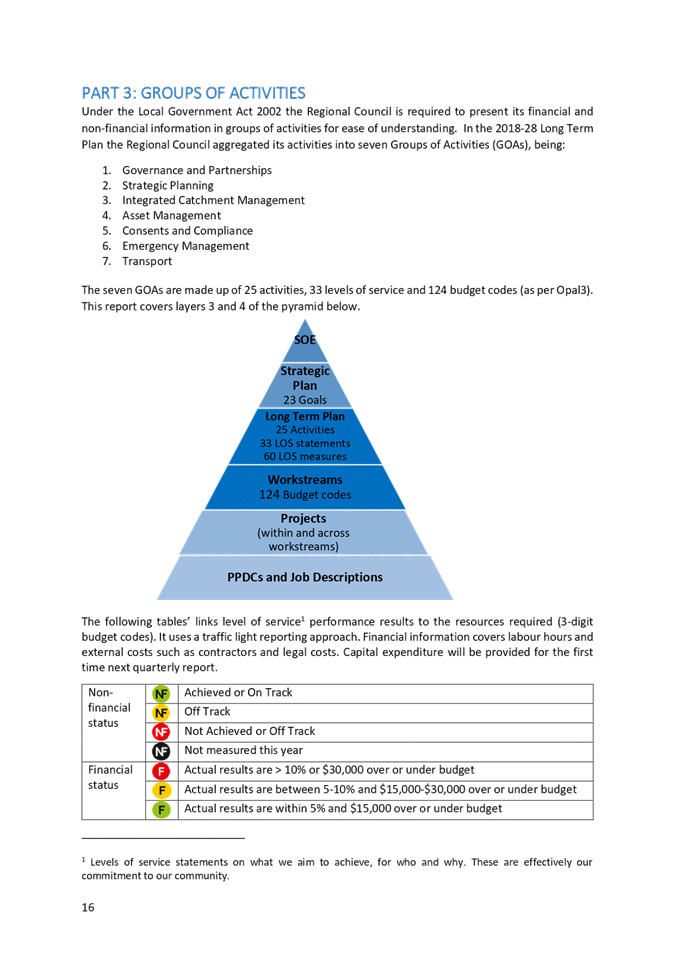
|
HBRC
Organisational Performance Report 1 April - 30 June 2020
|
Attachment 1
|
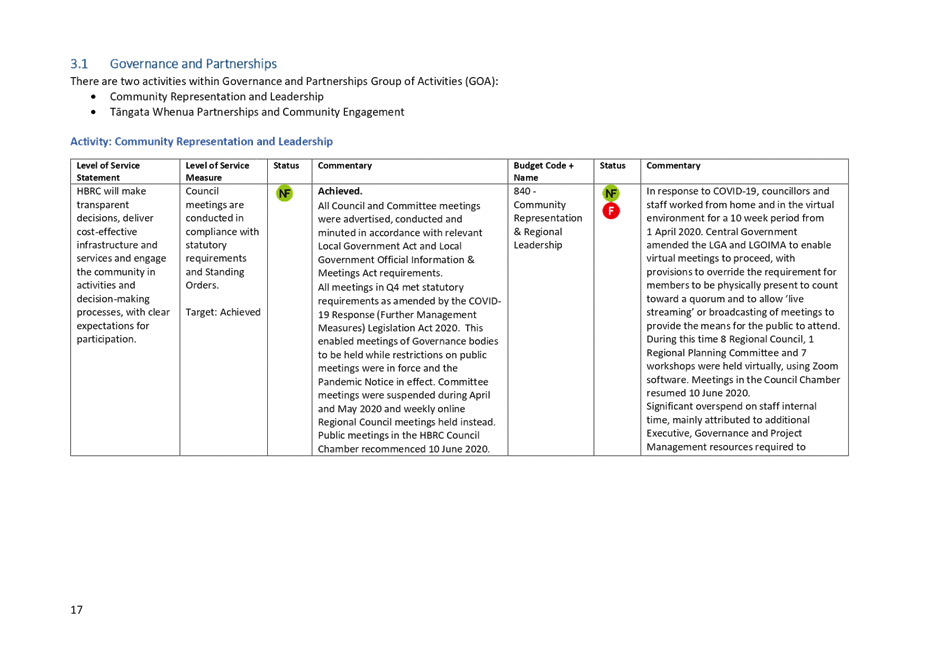

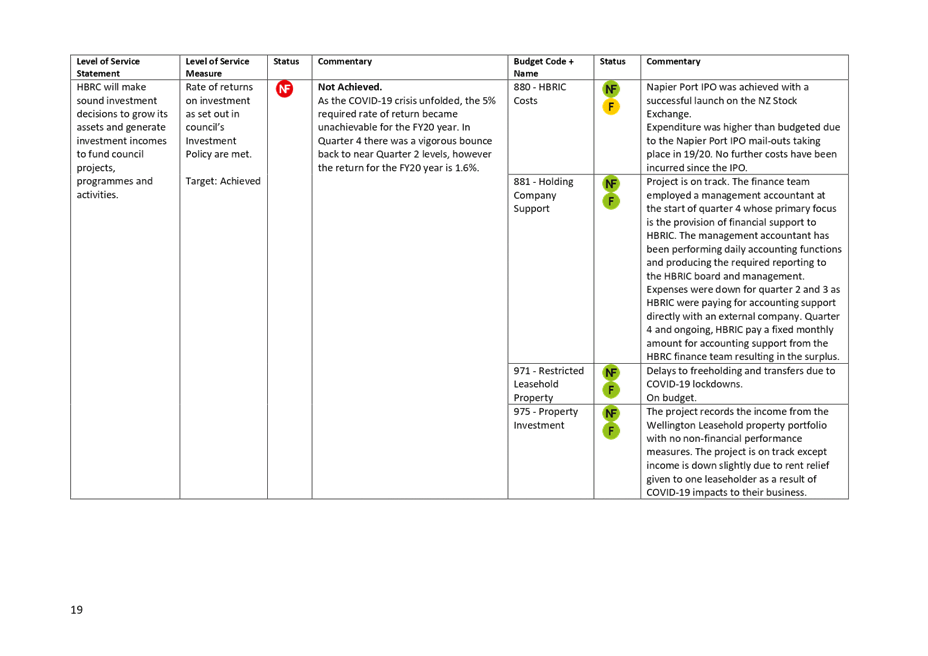
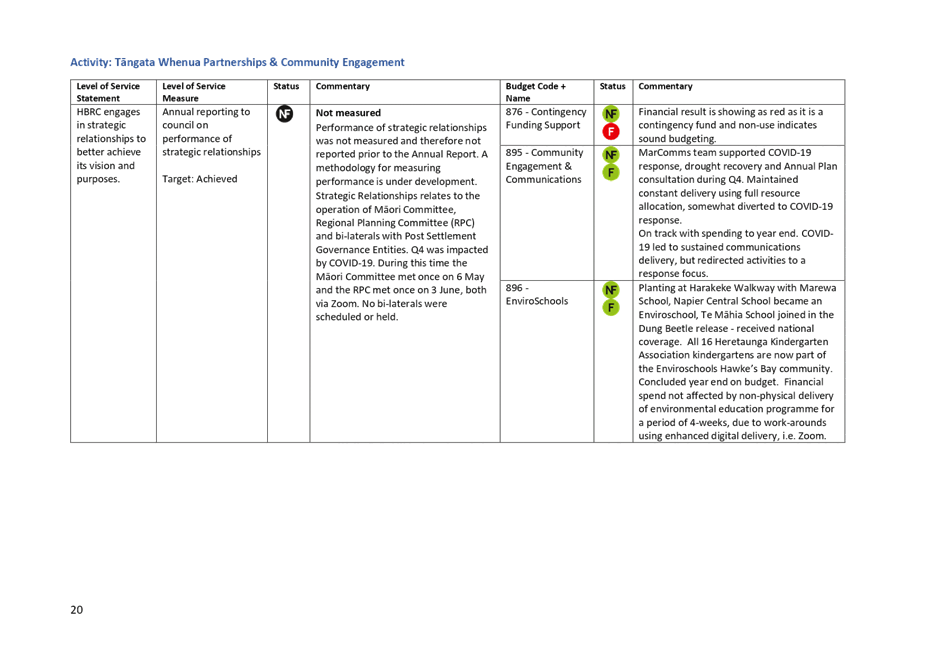
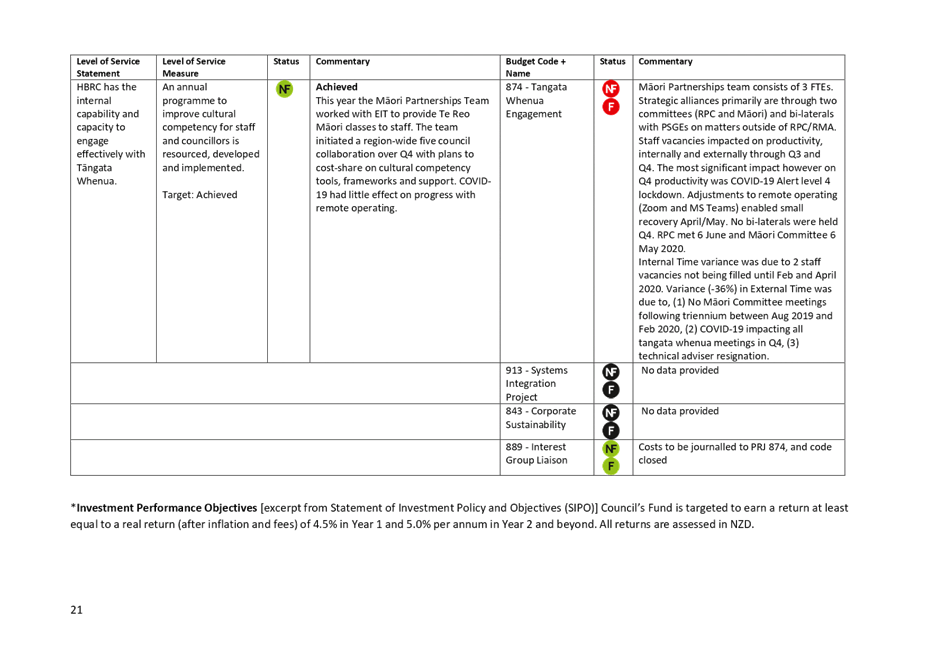
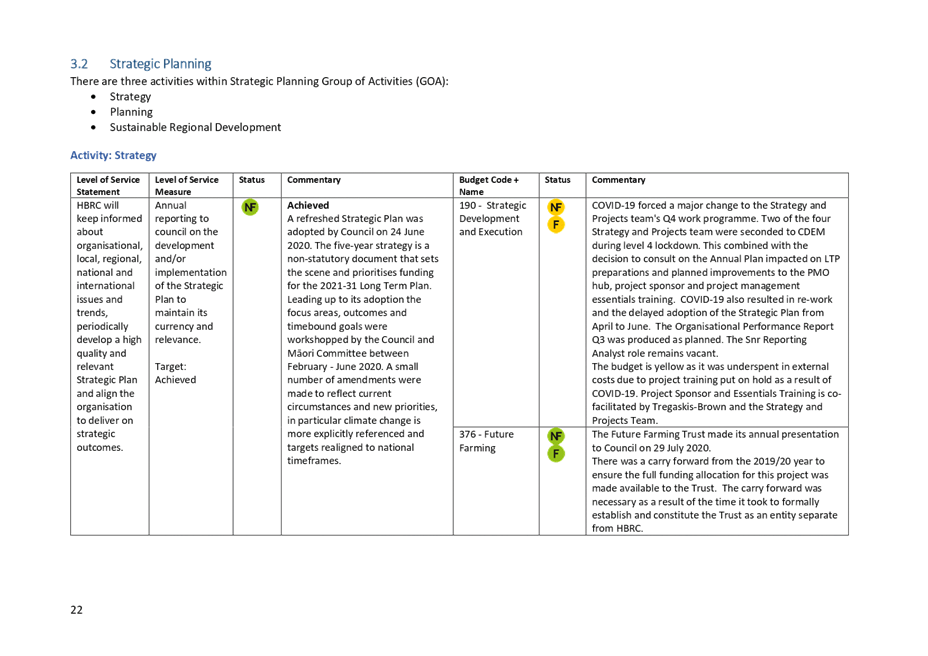

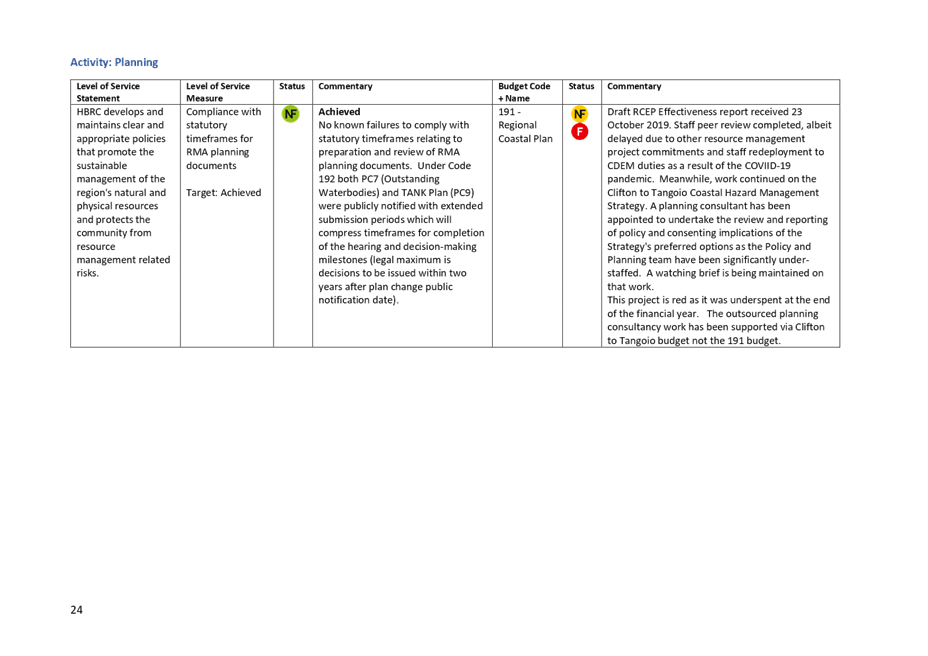
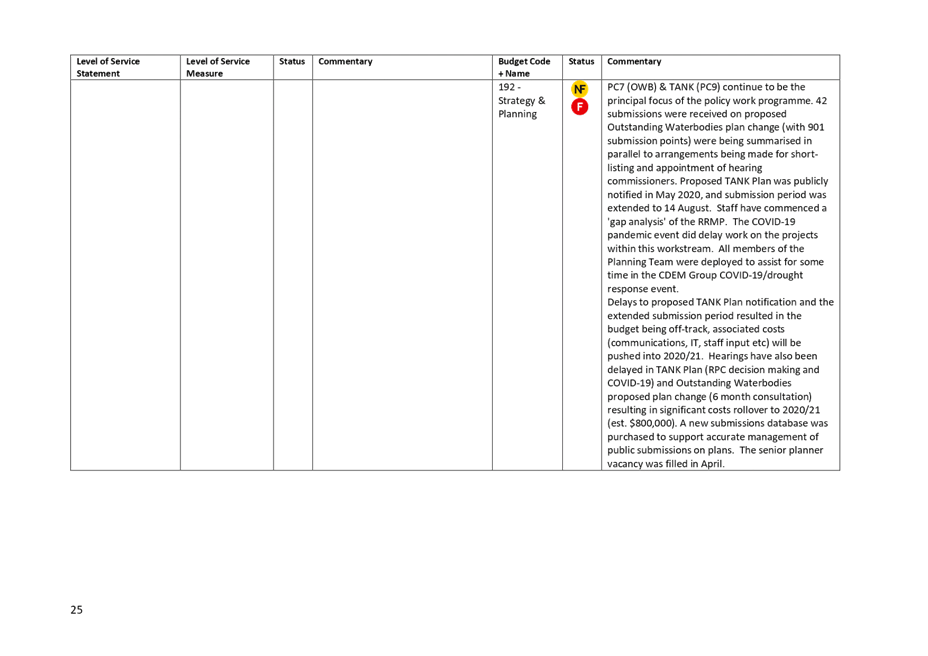
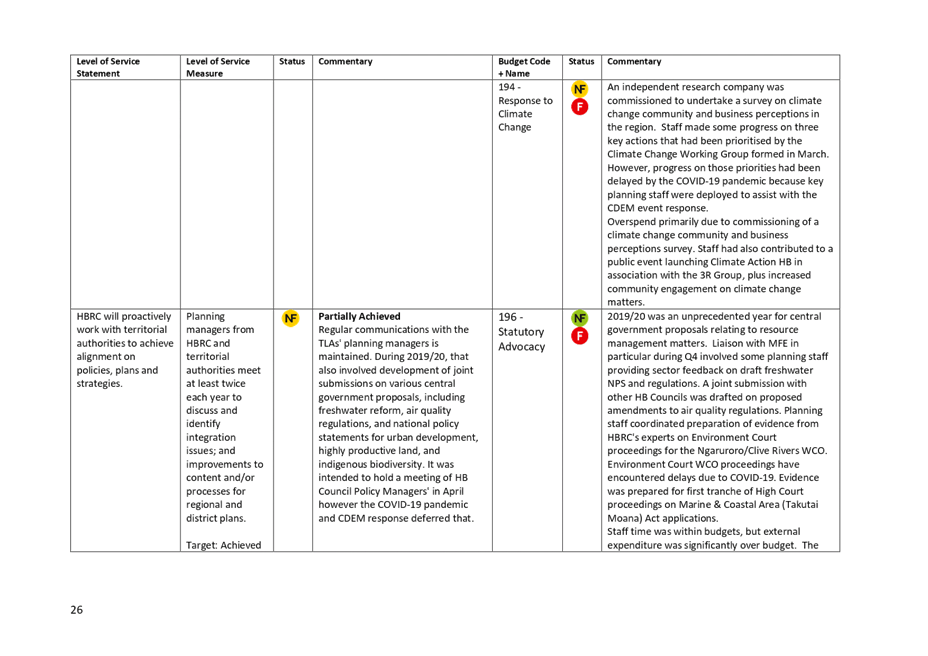
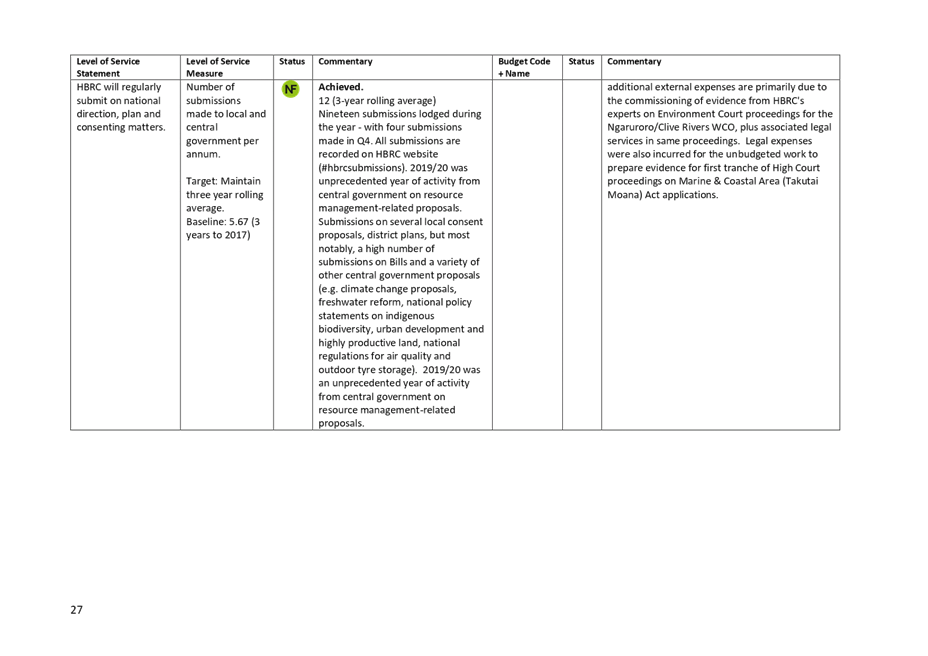
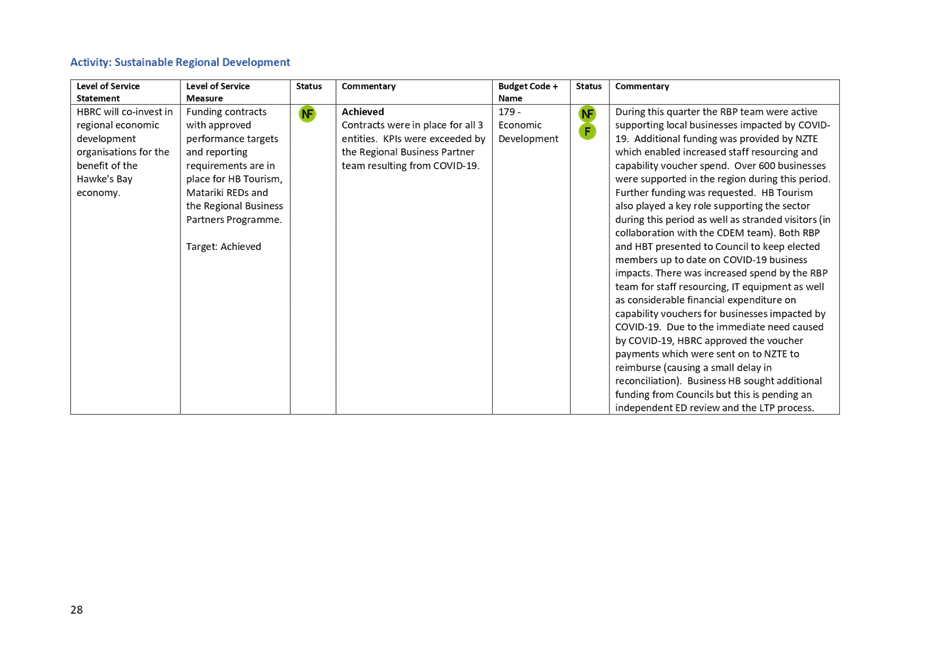
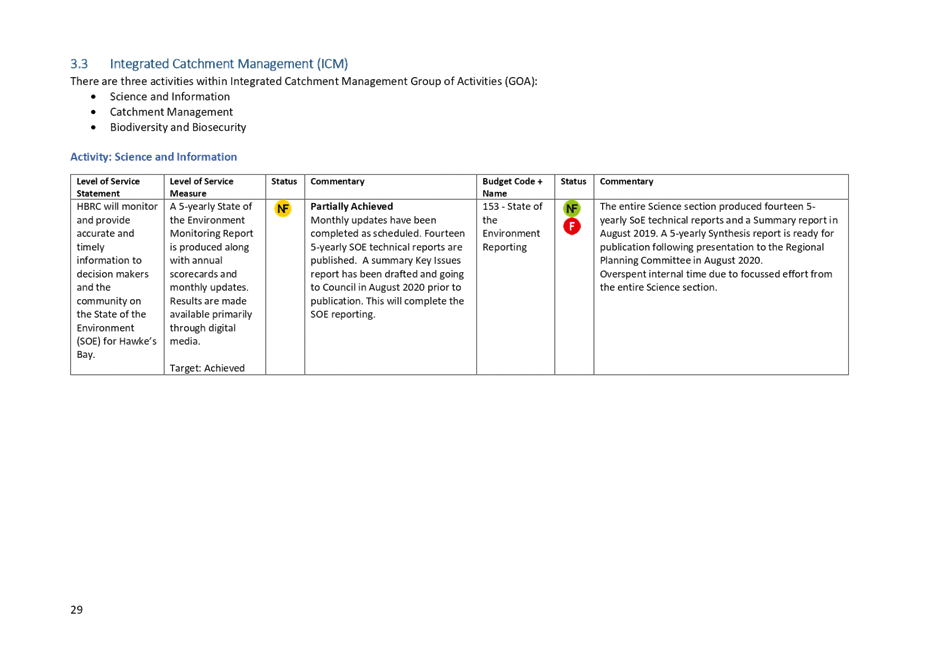
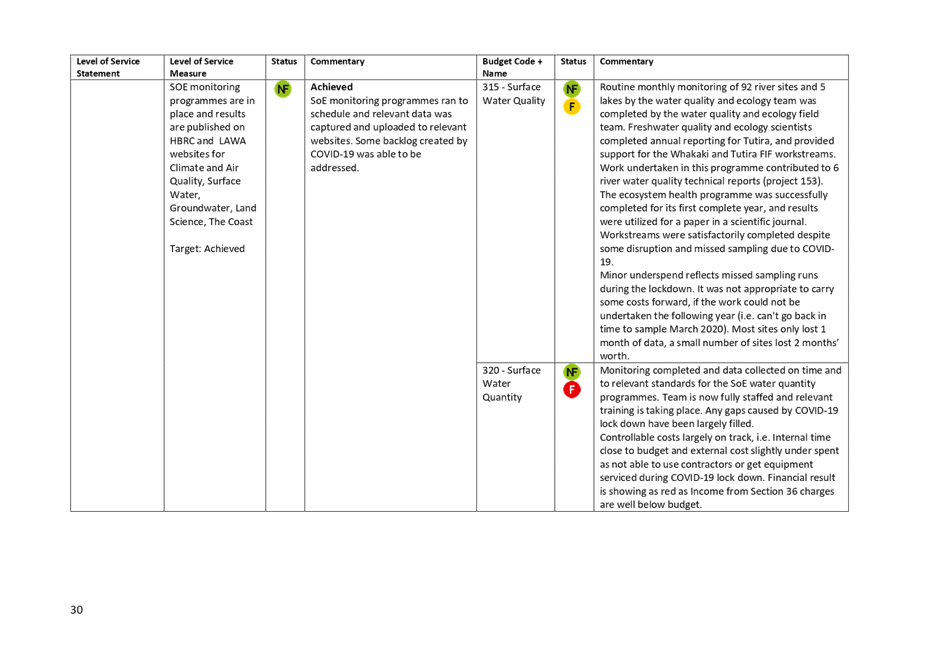
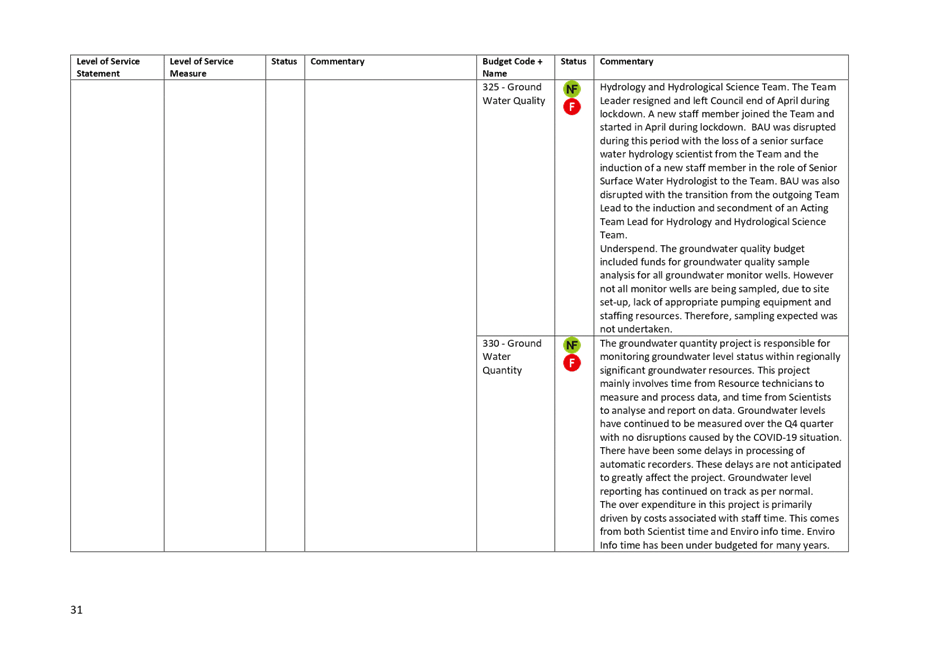
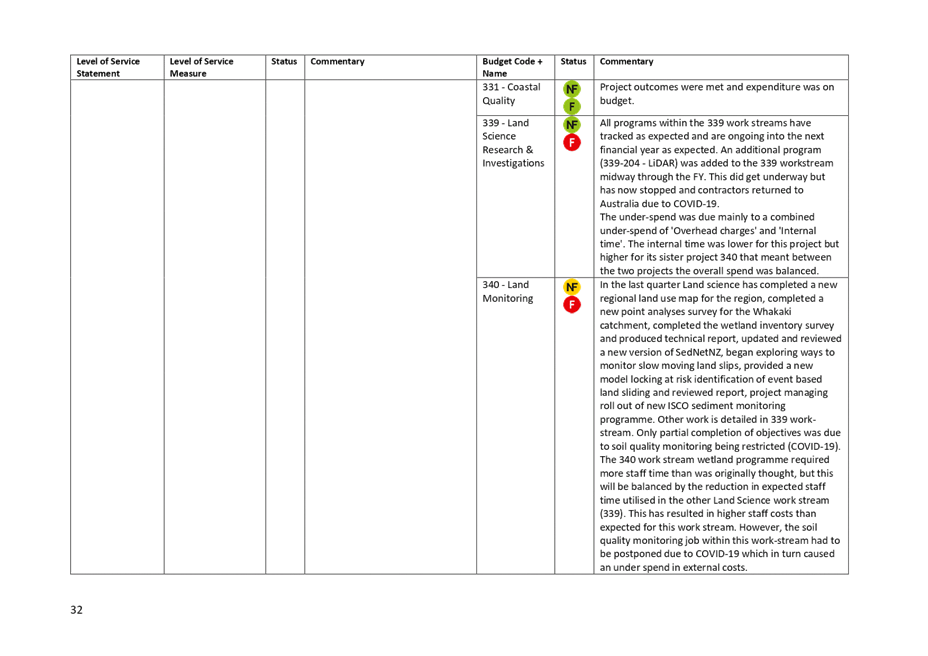
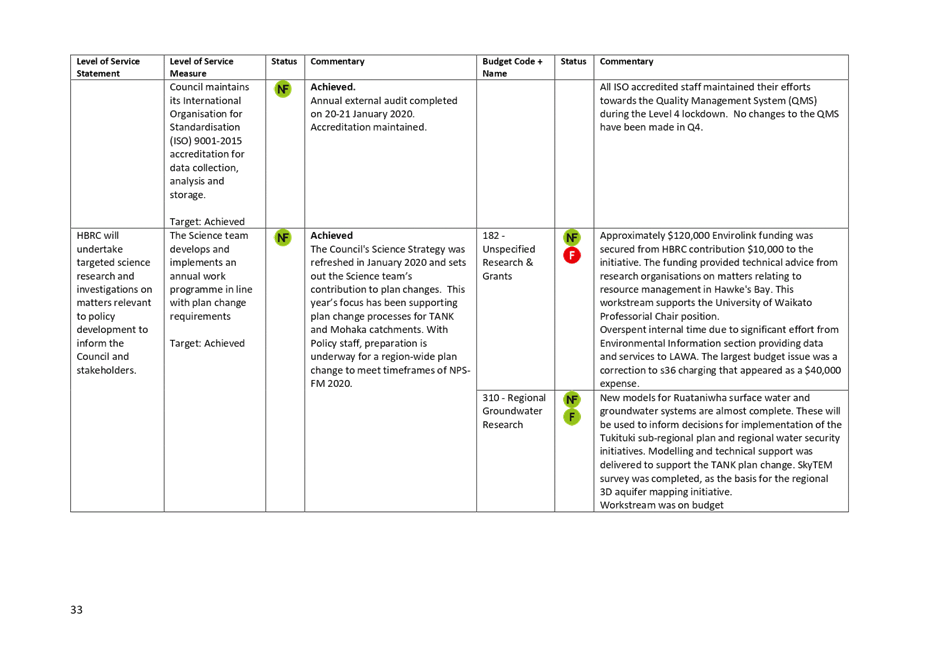
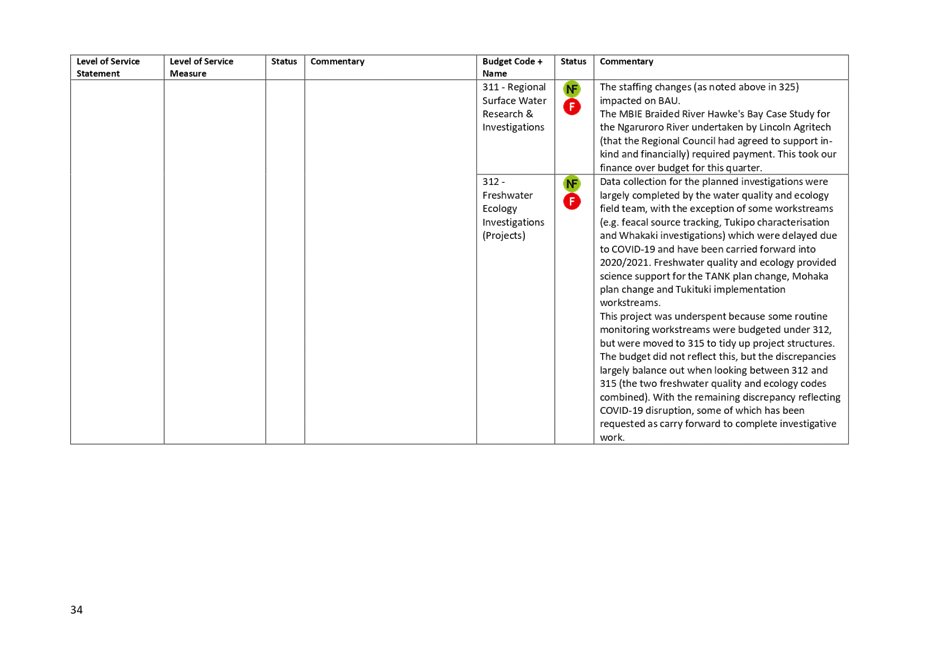
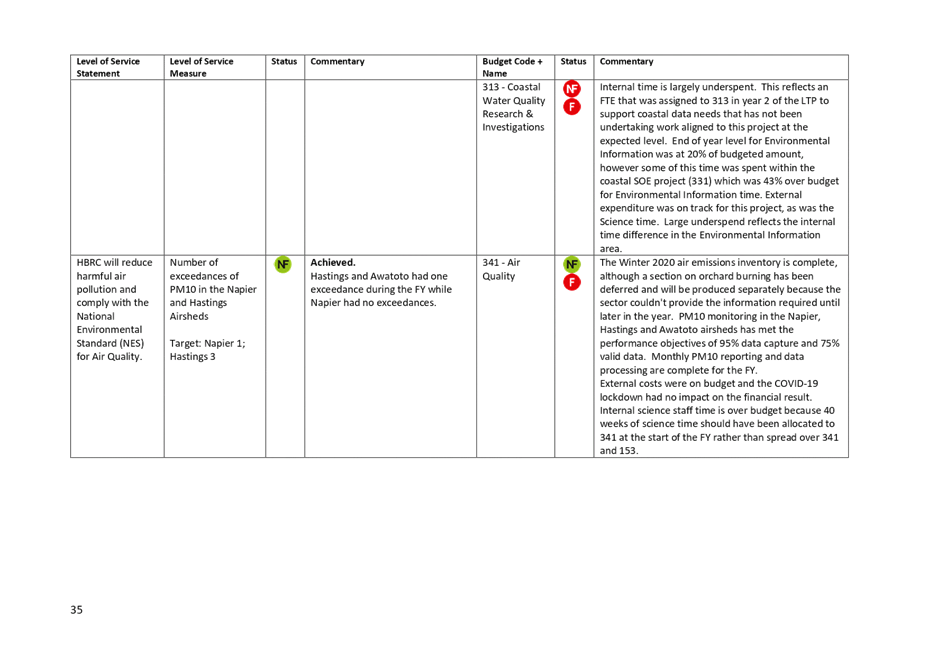
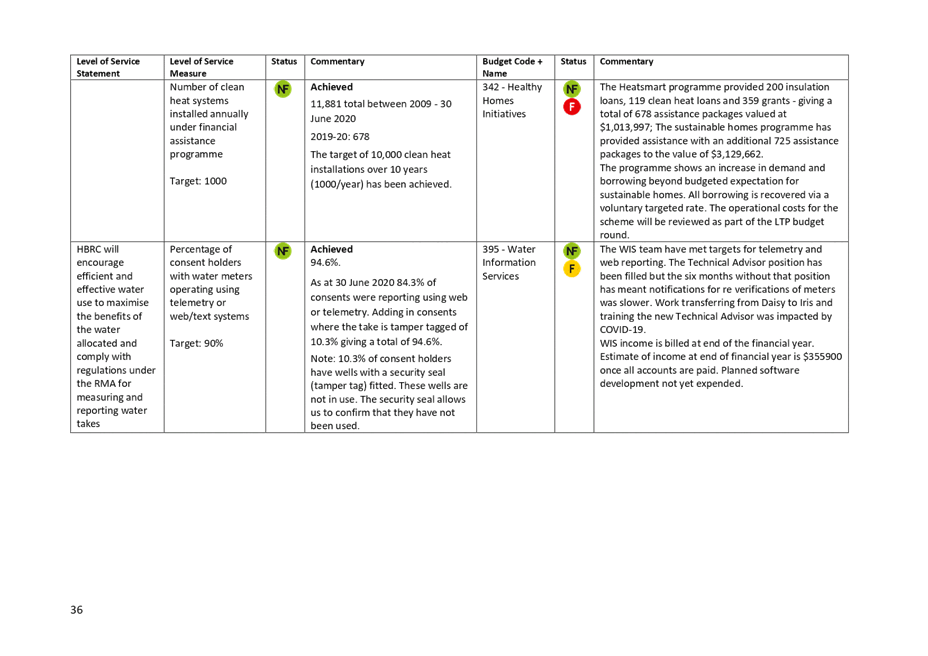
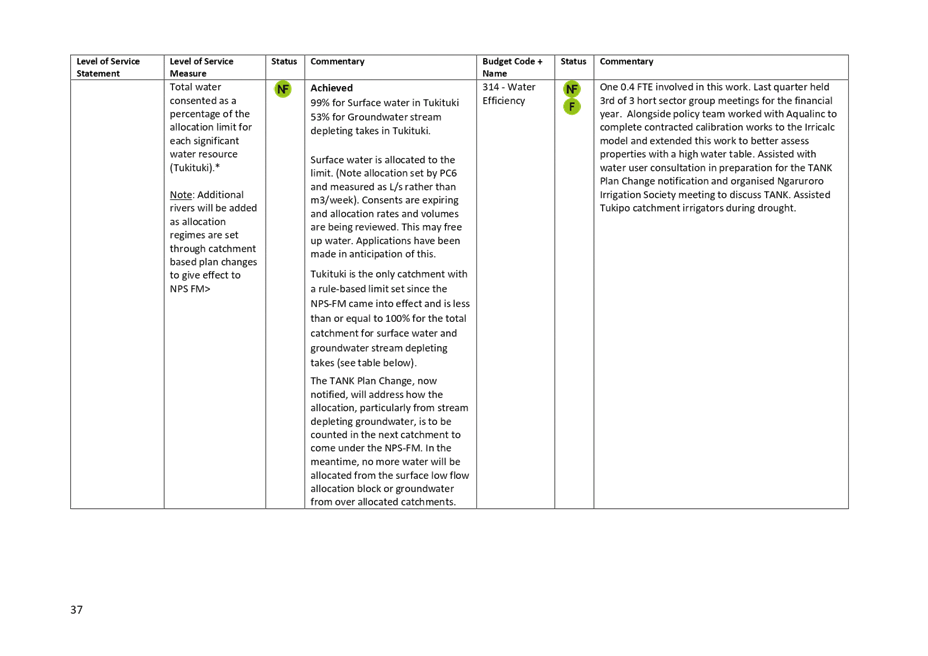
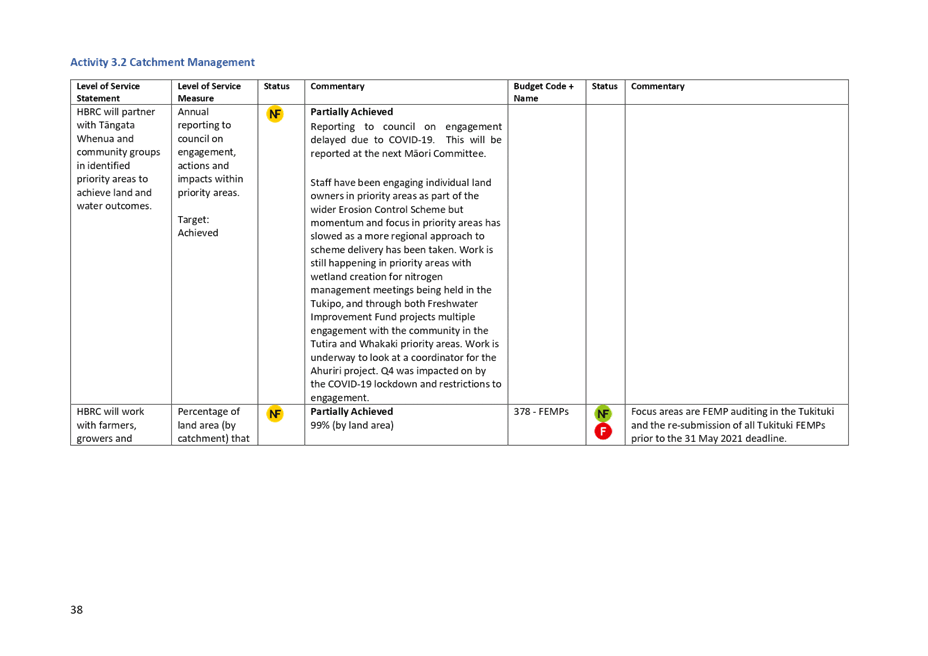
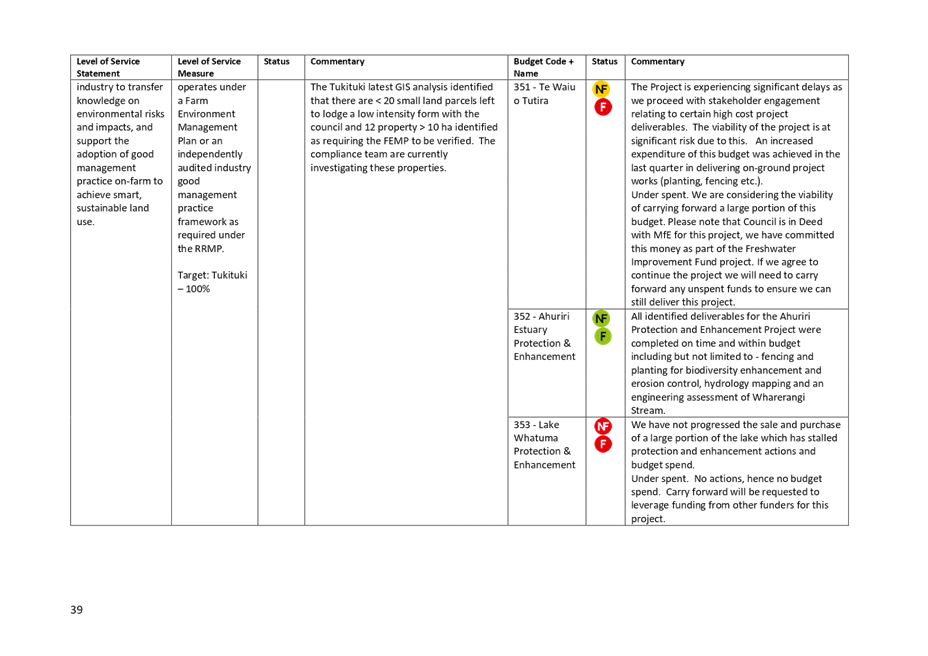
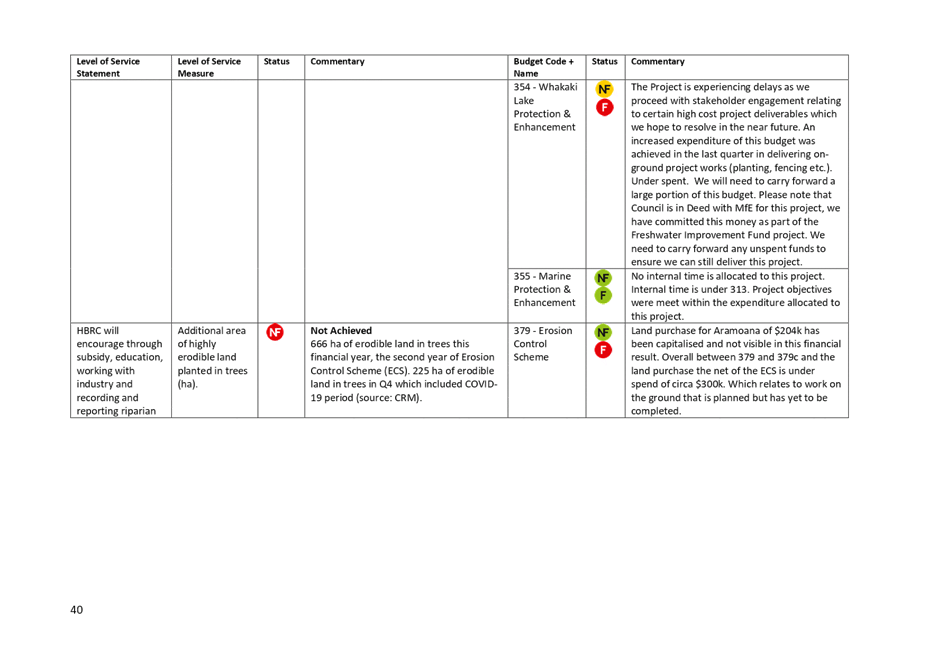
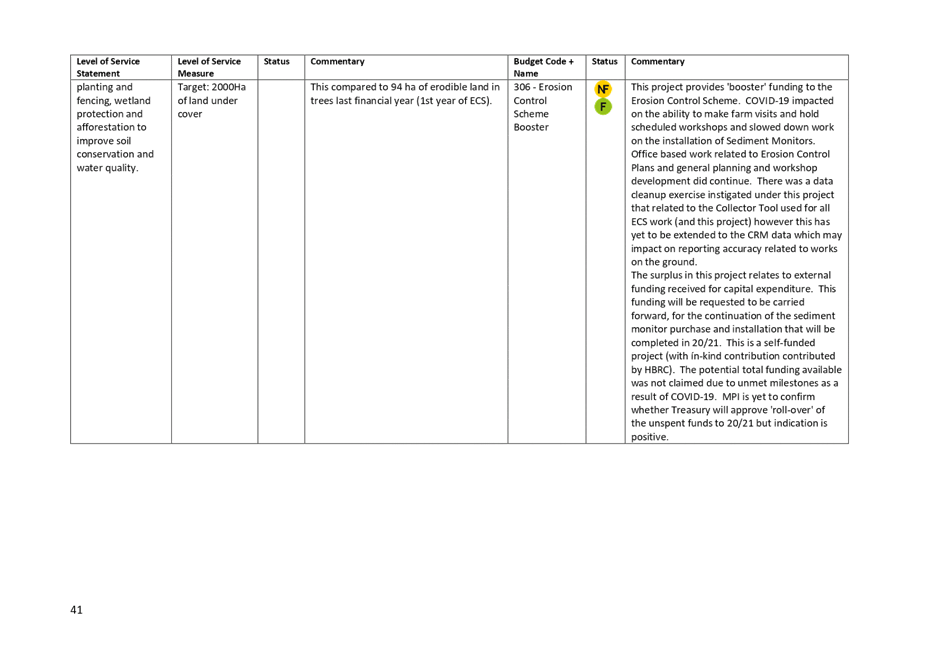
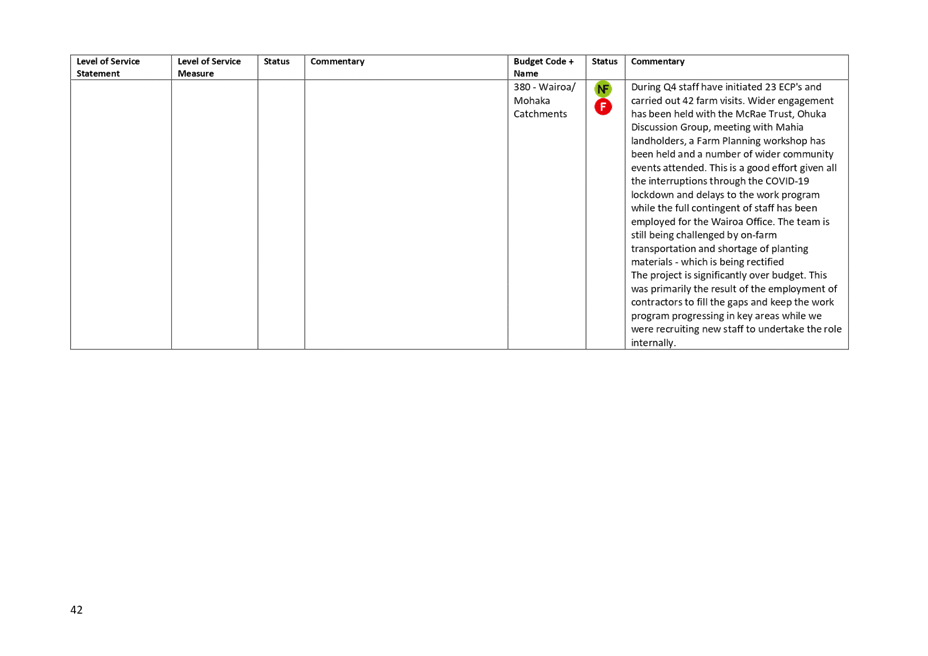
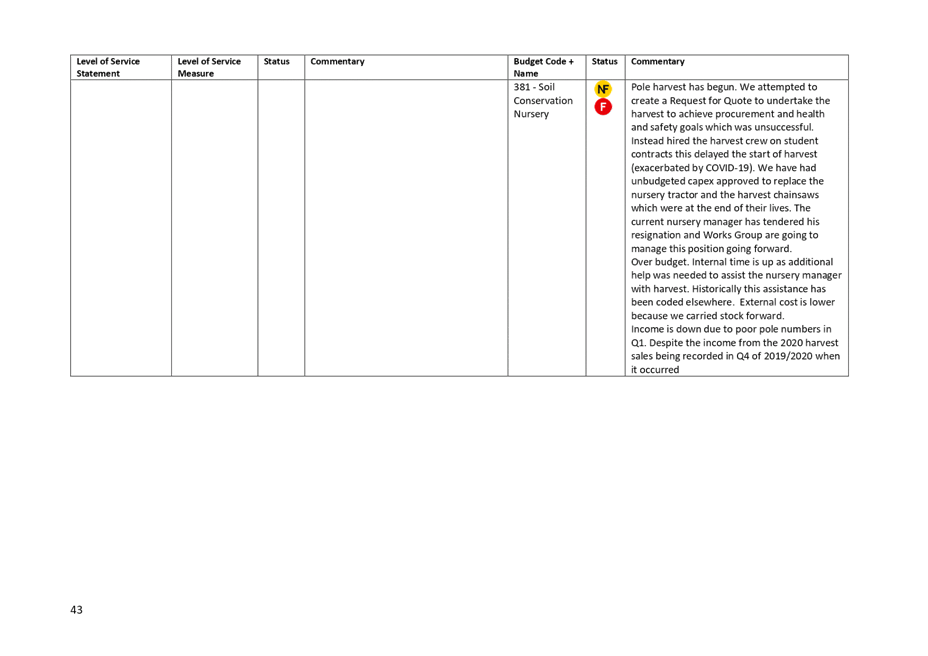
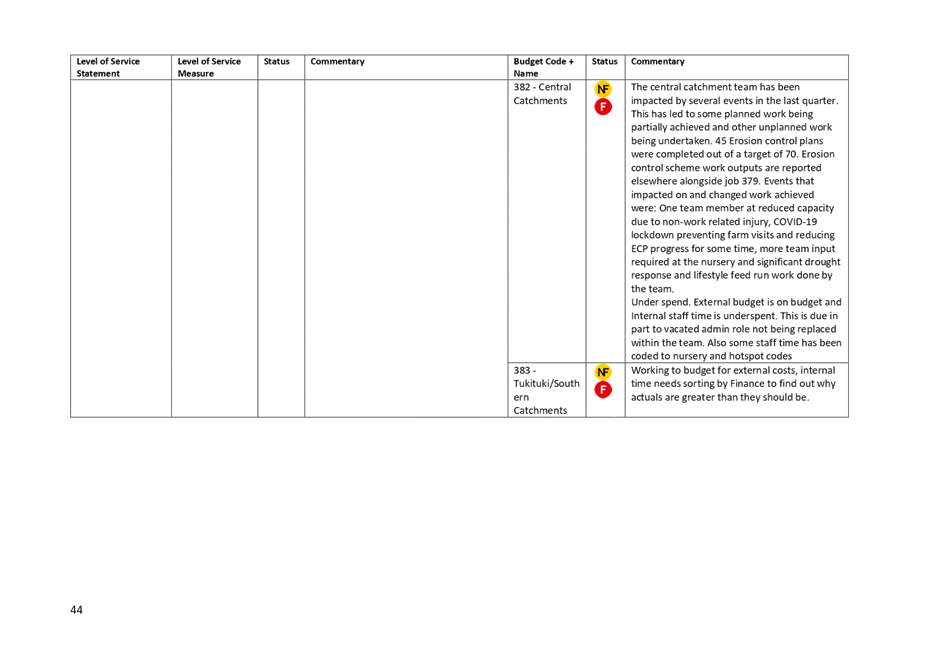
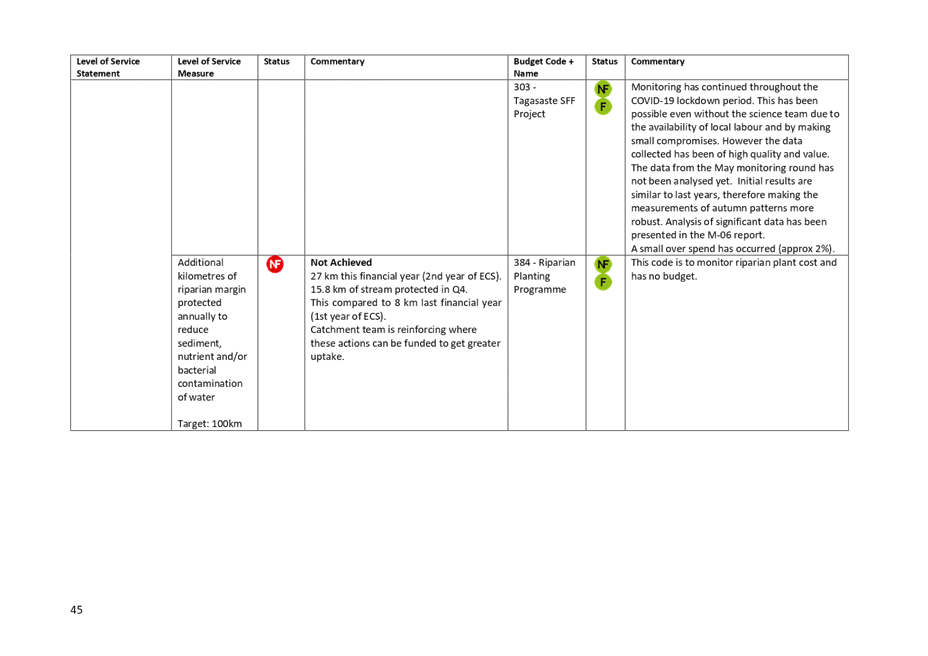
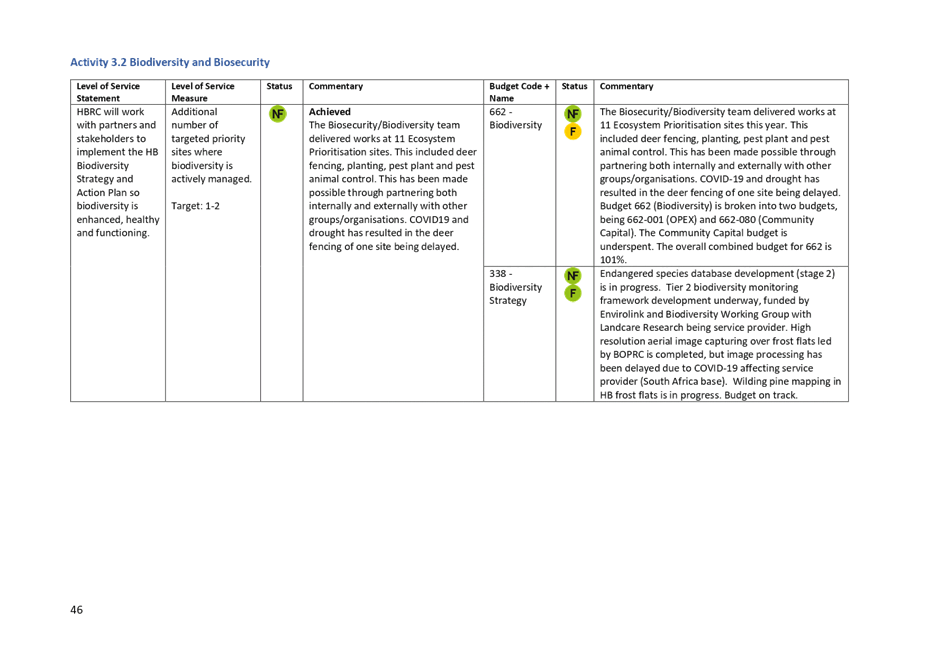
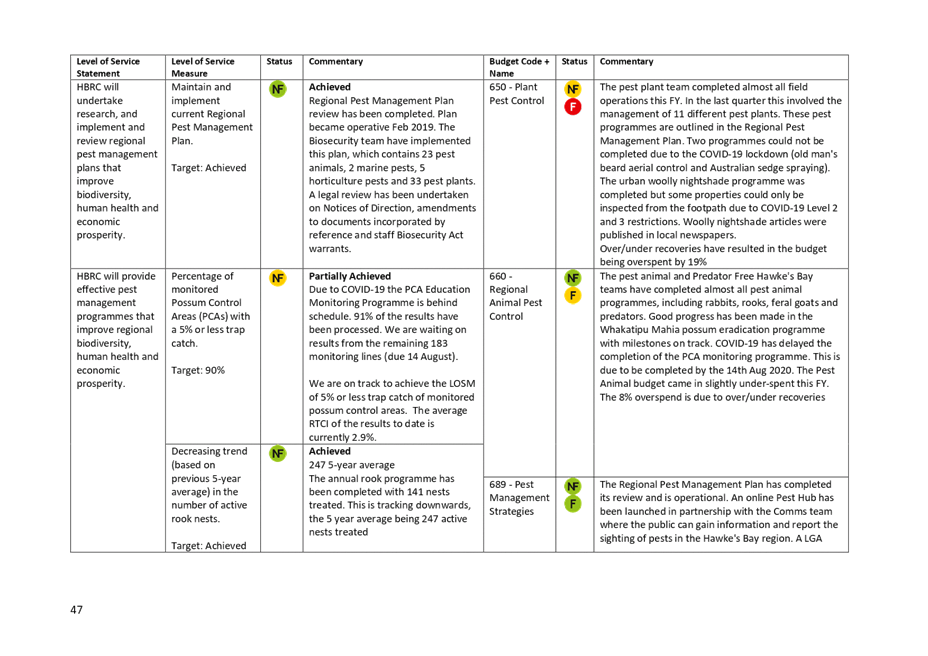
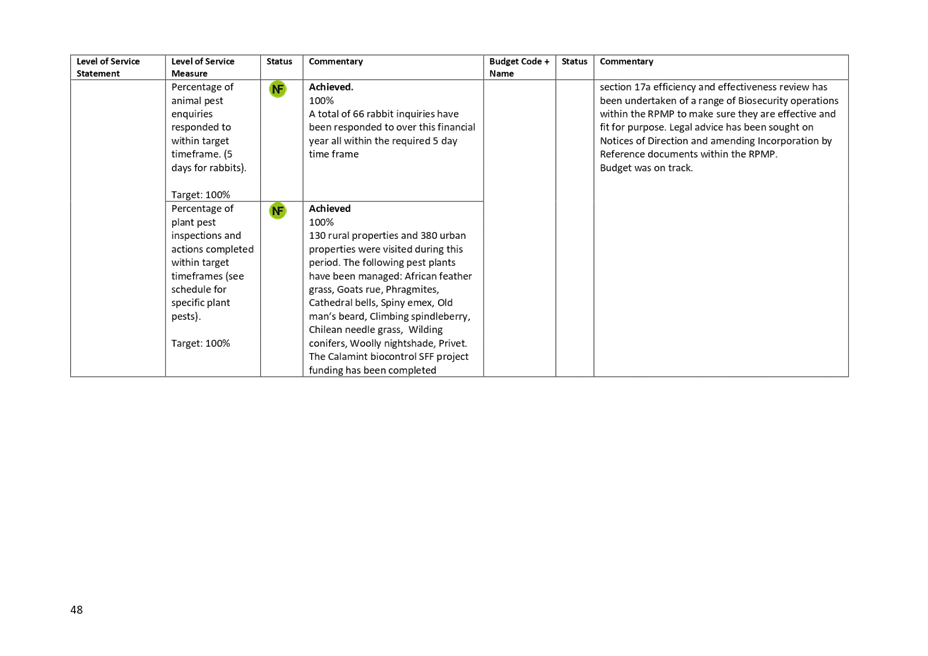
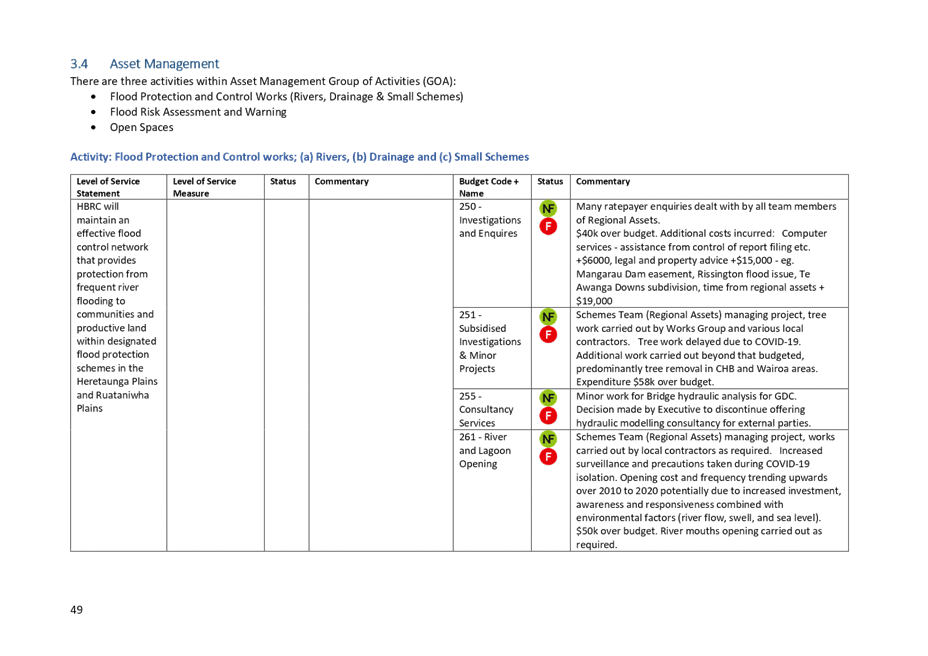
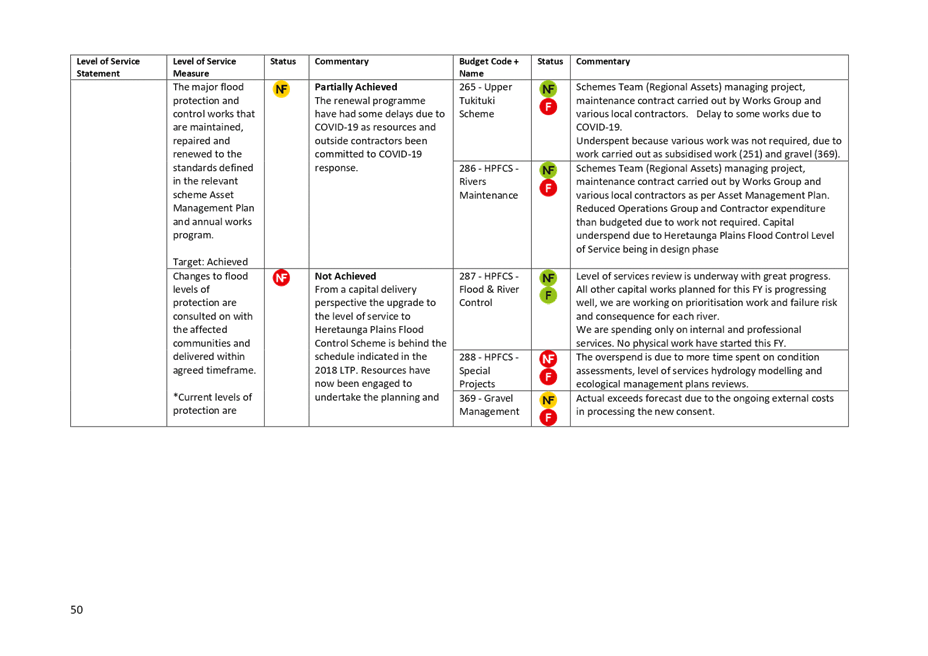
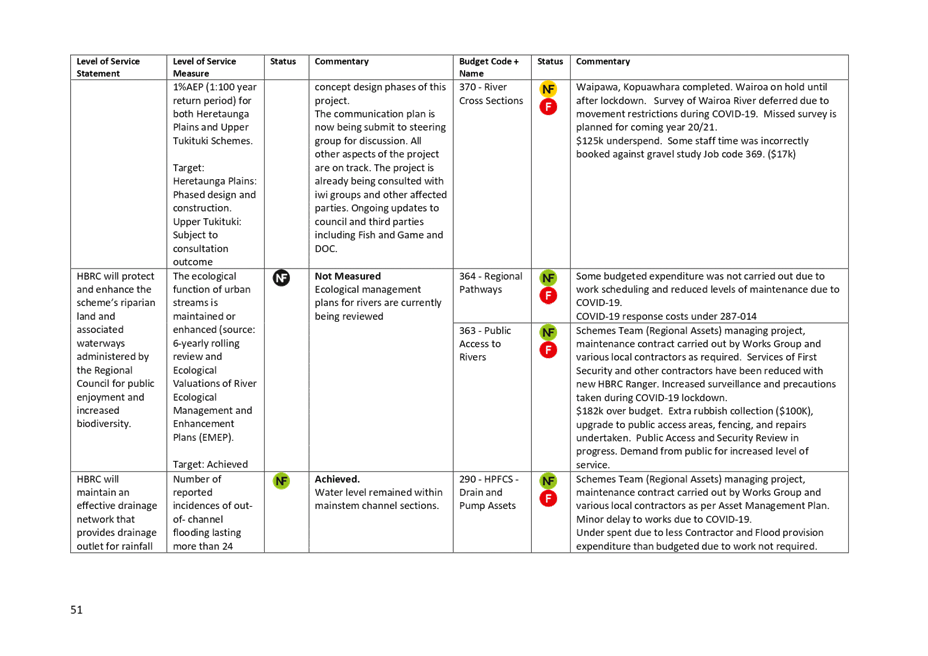
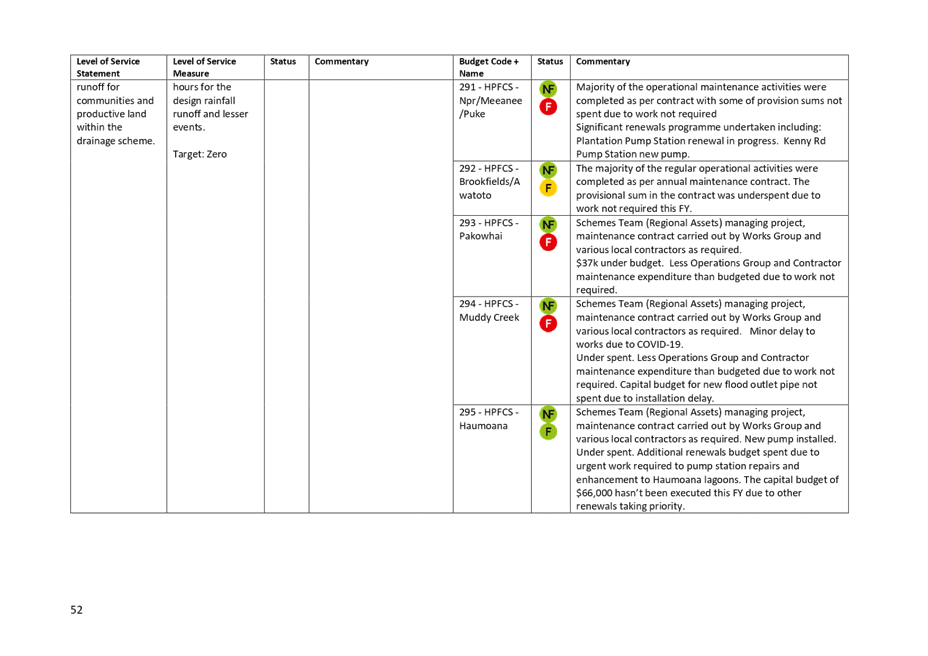
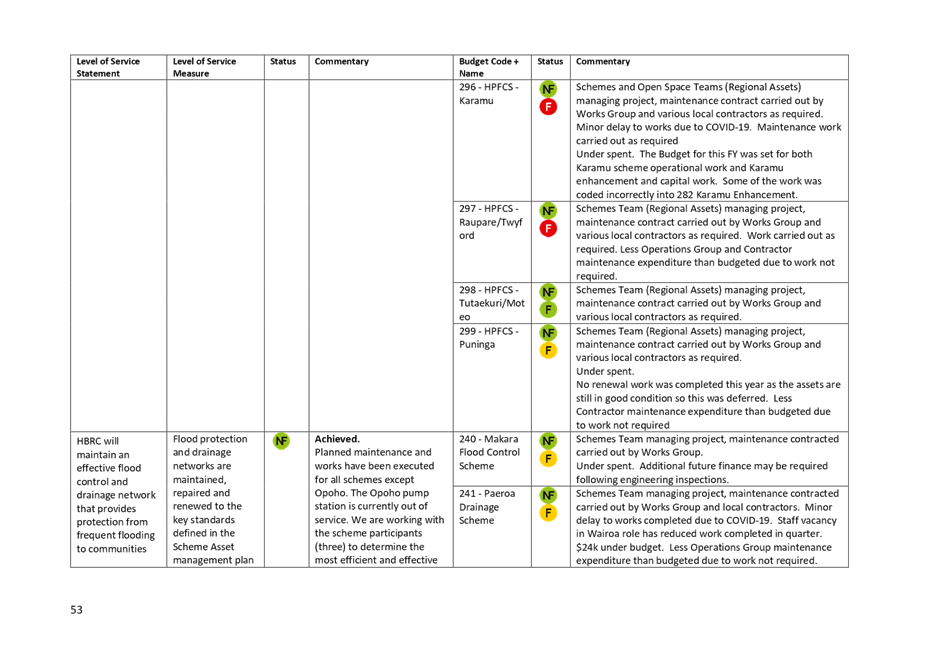
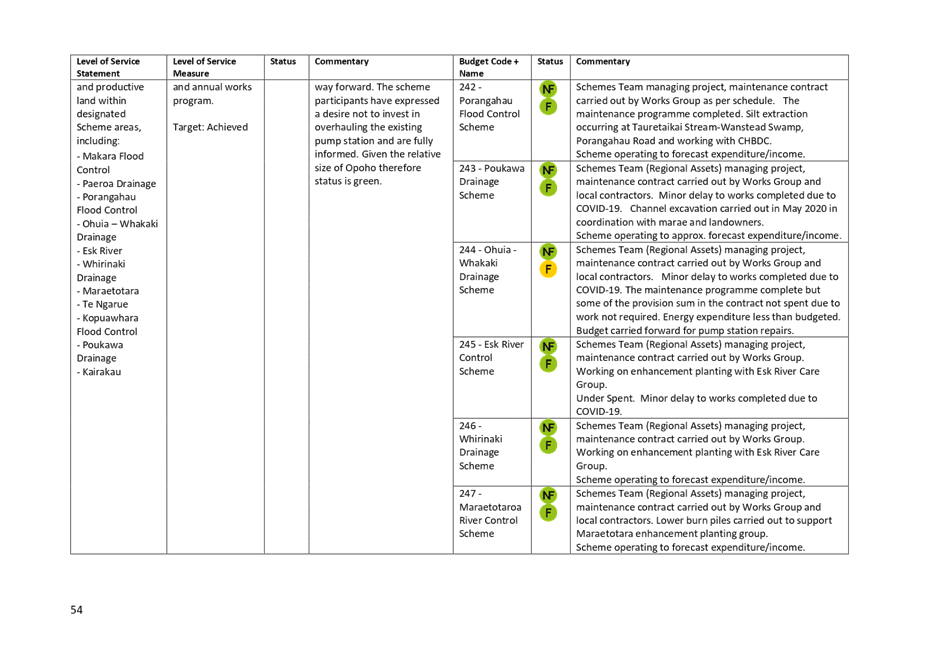
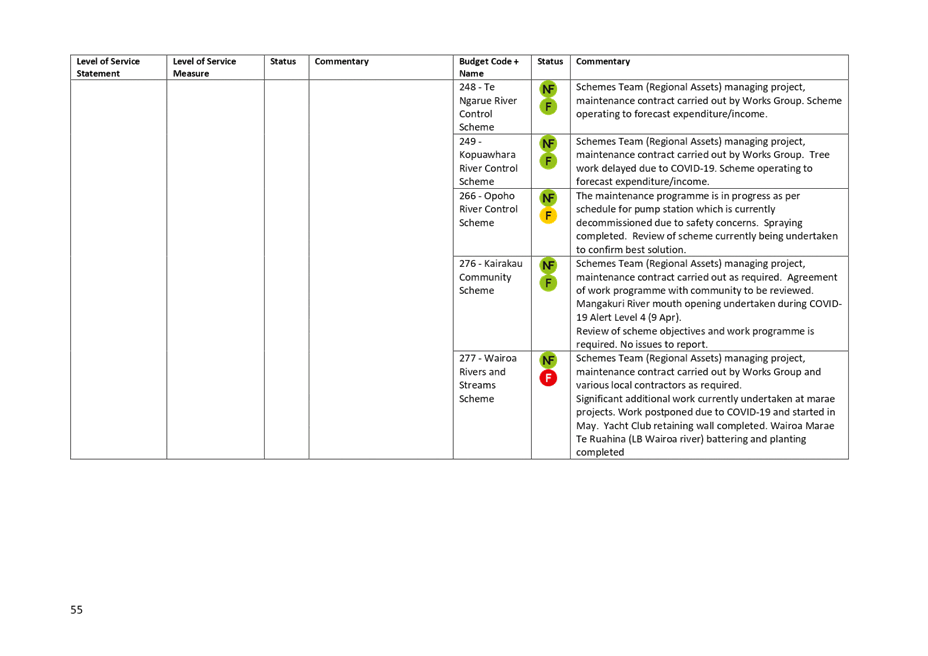
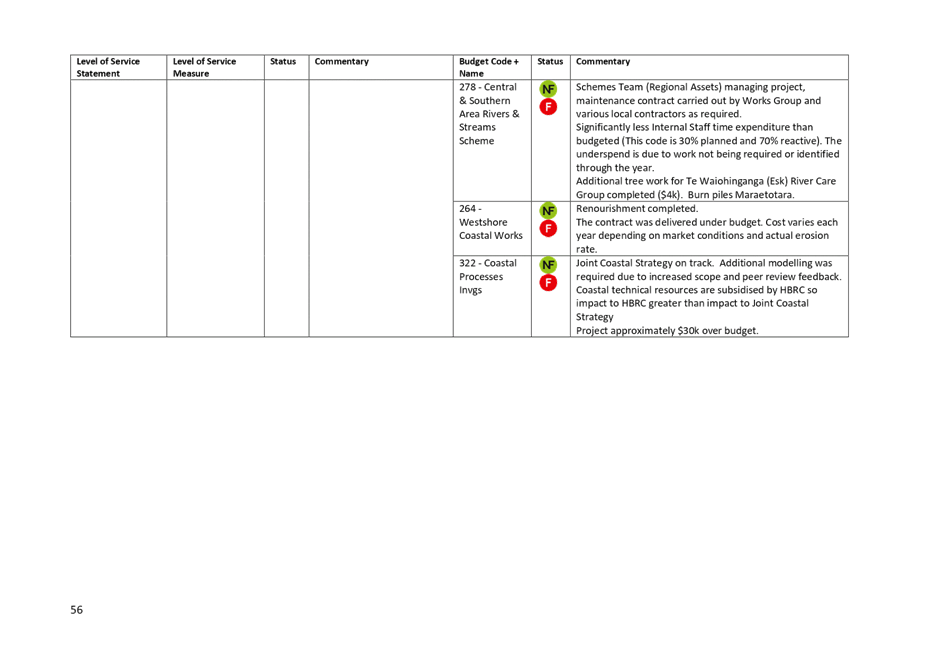
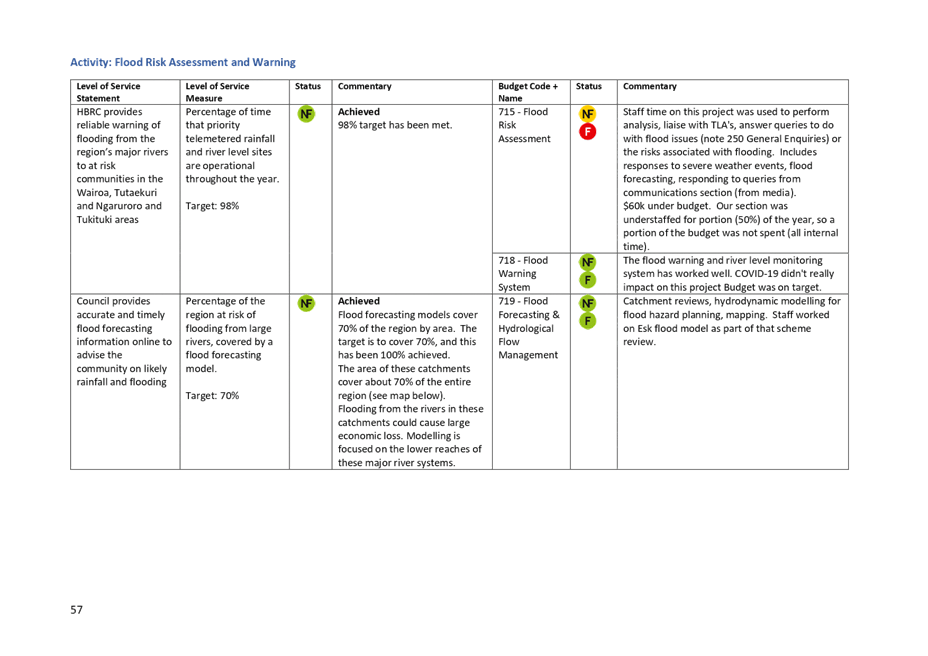
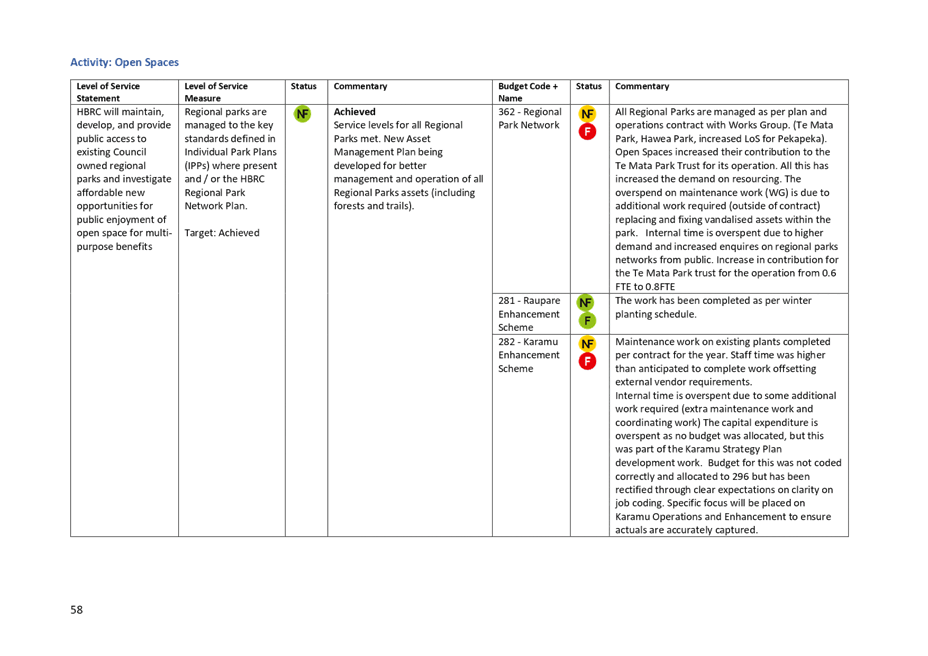
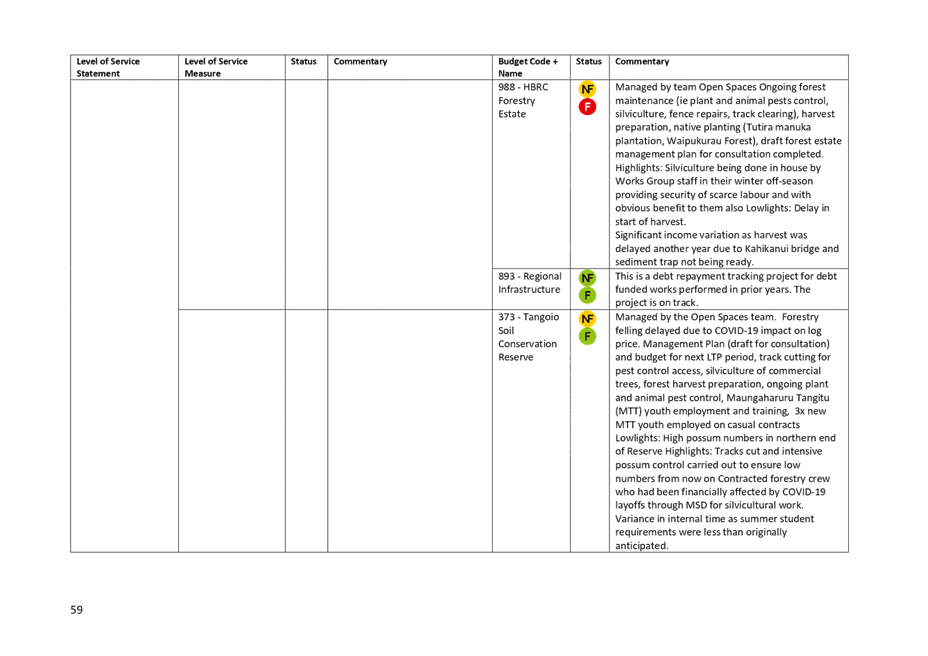

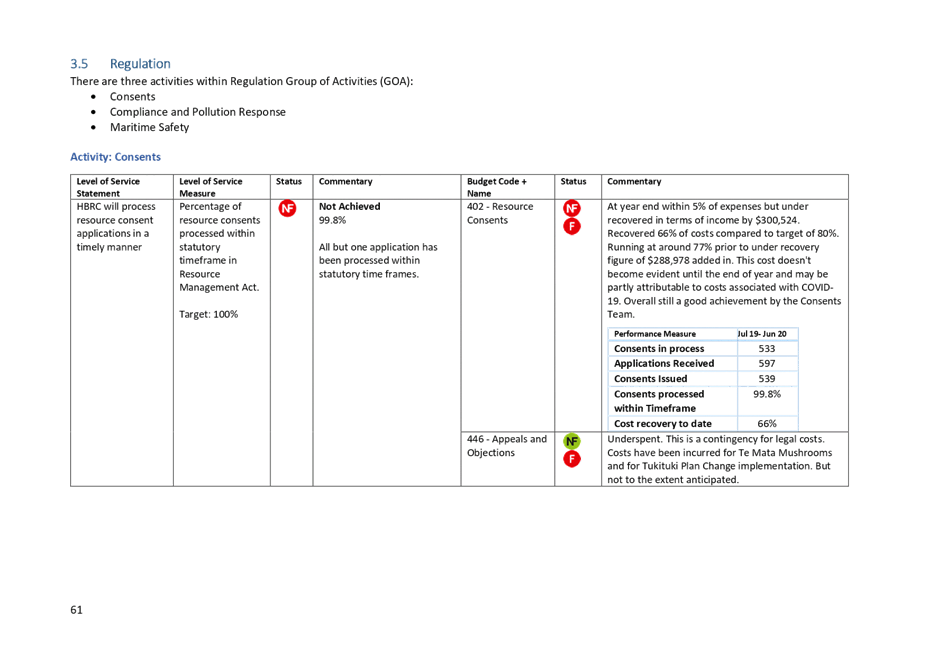
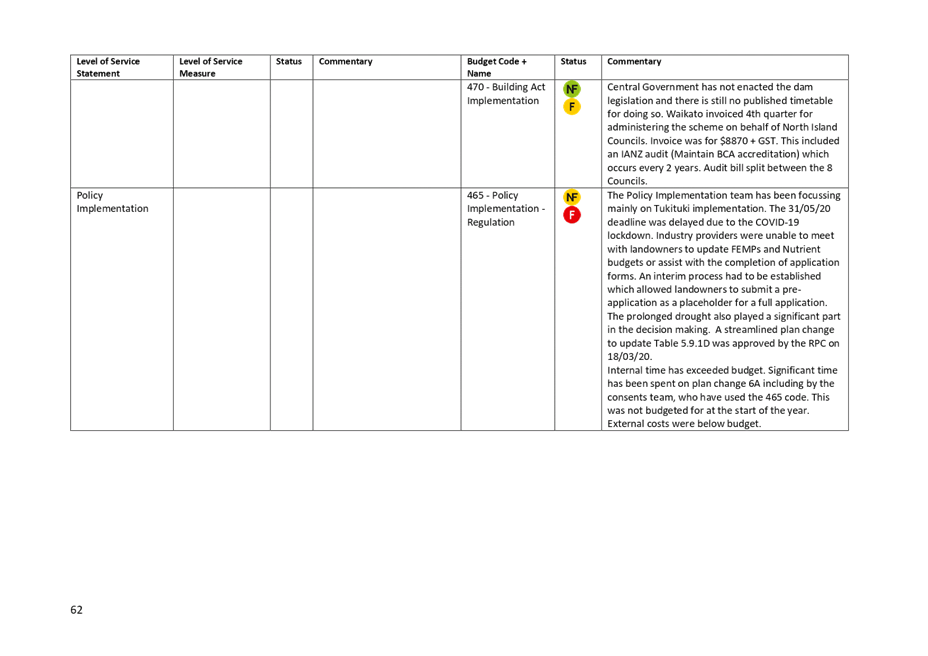
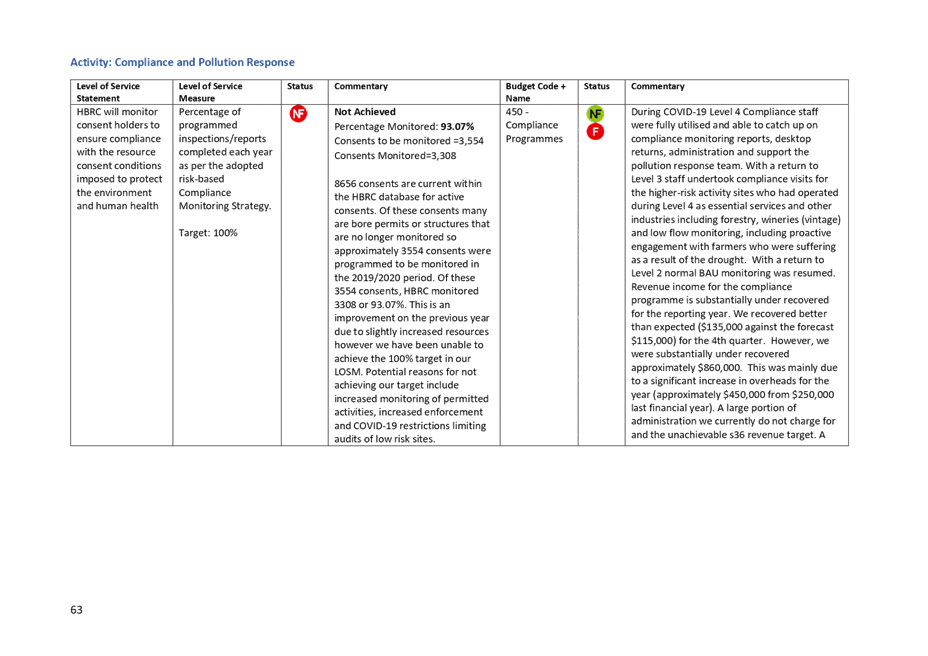
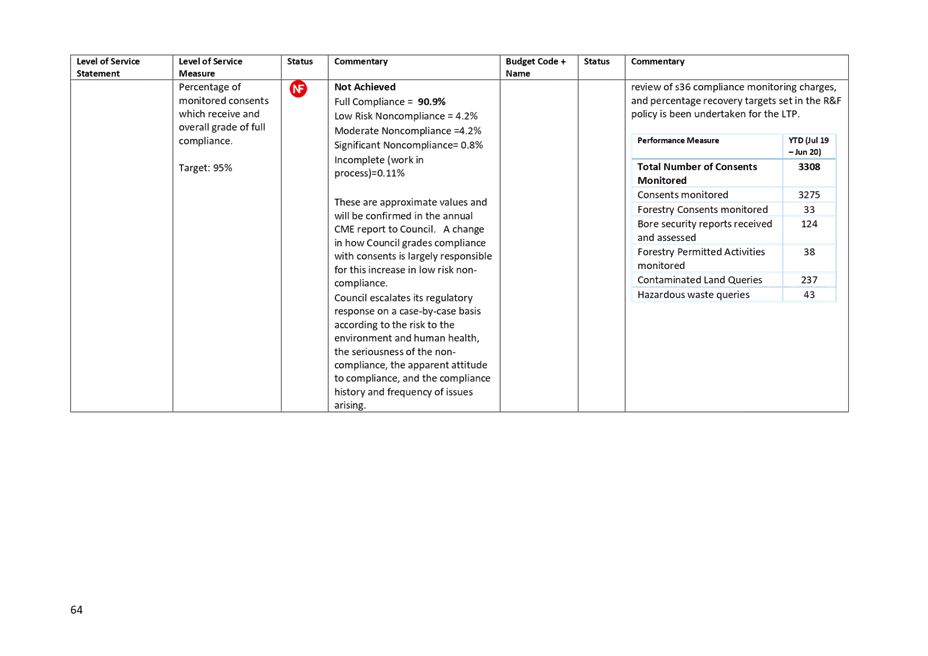
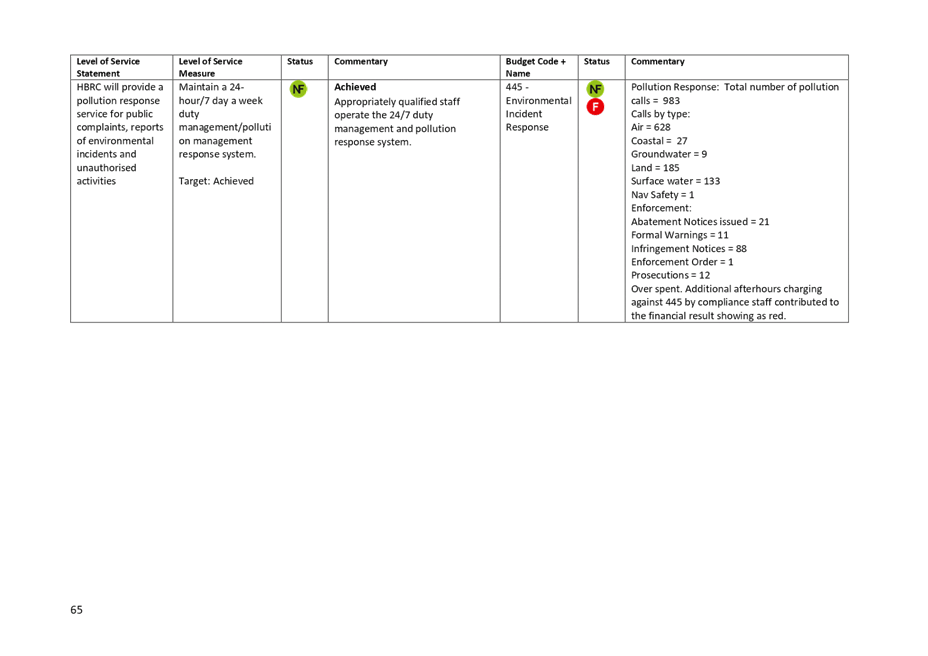
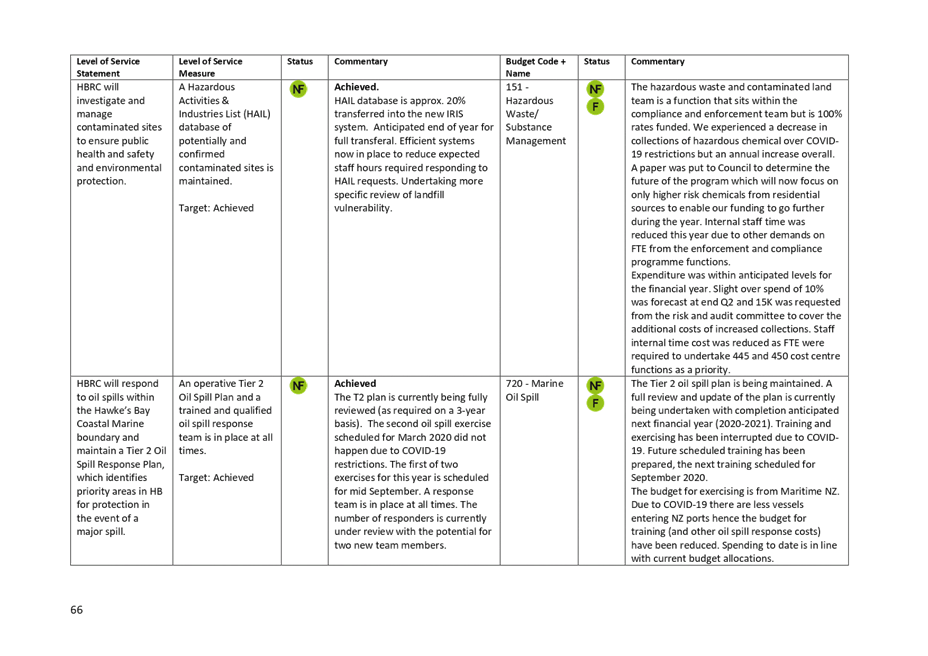
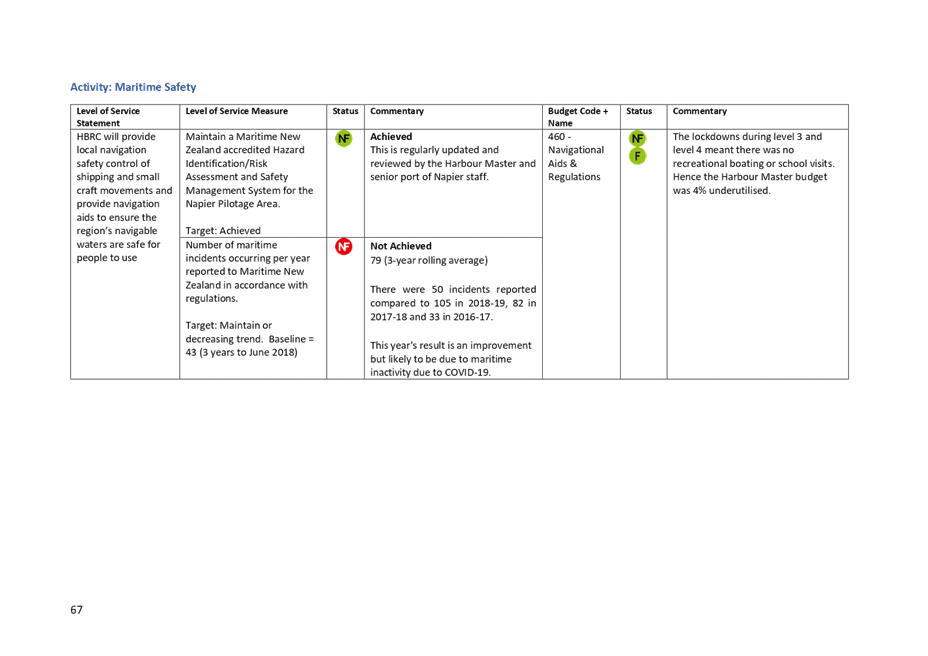
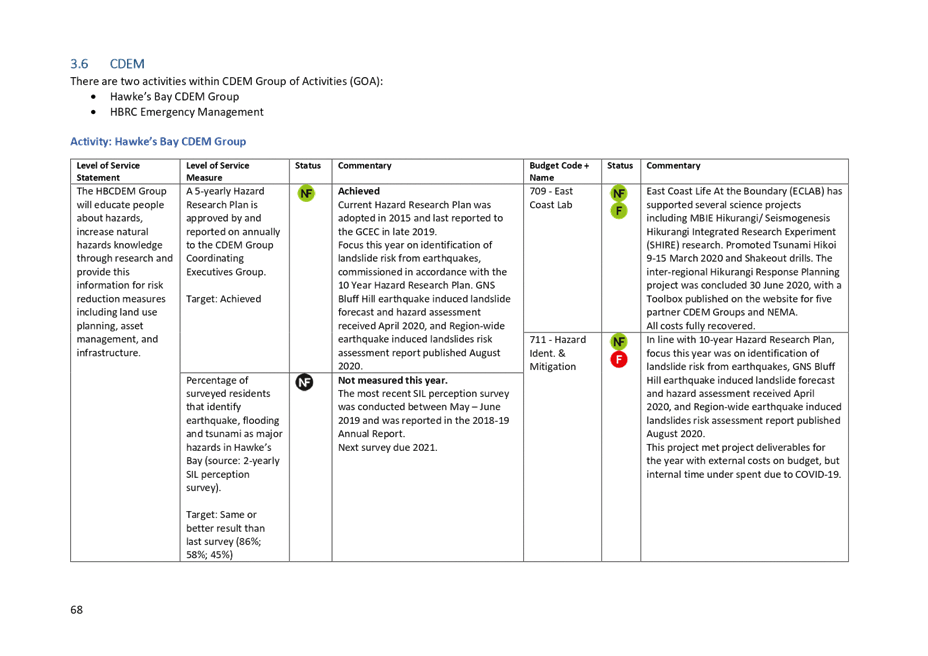
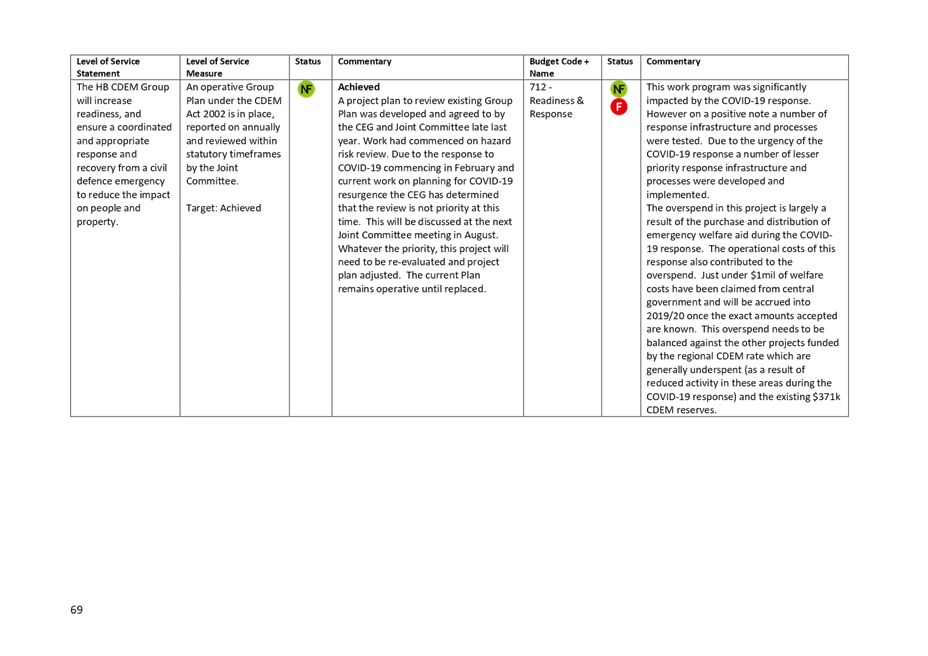
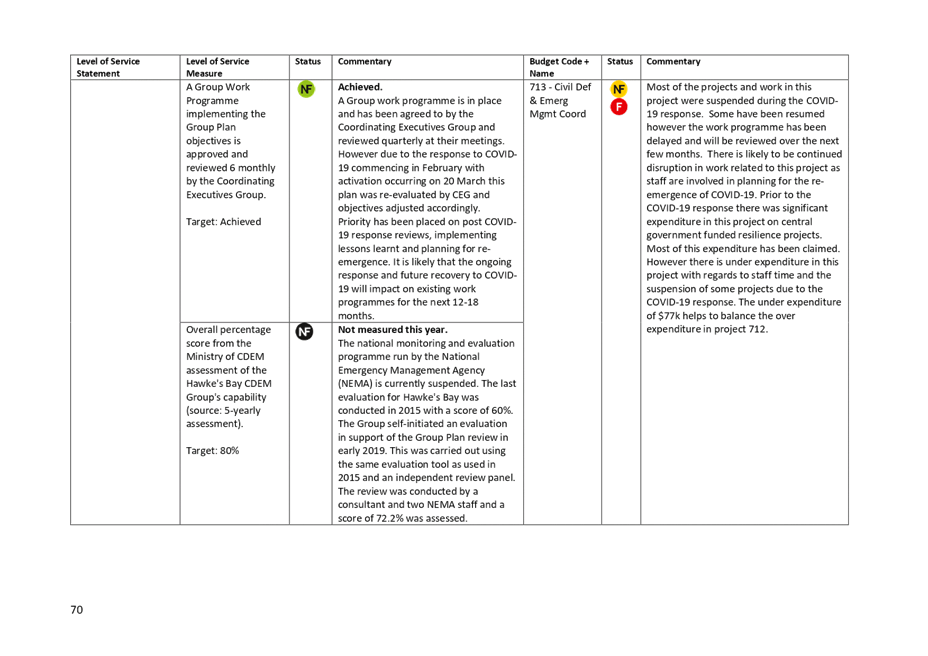
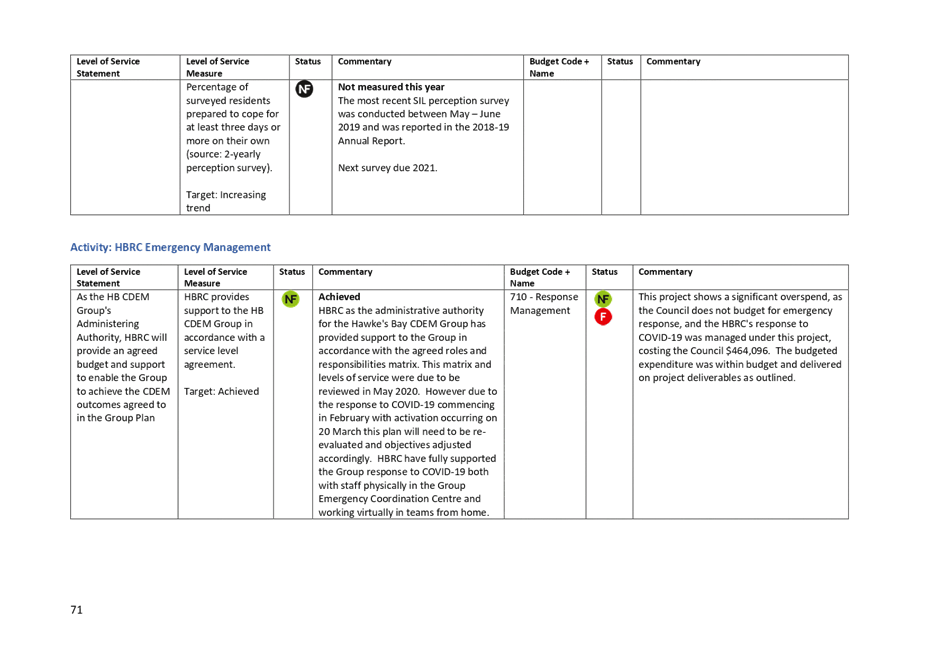
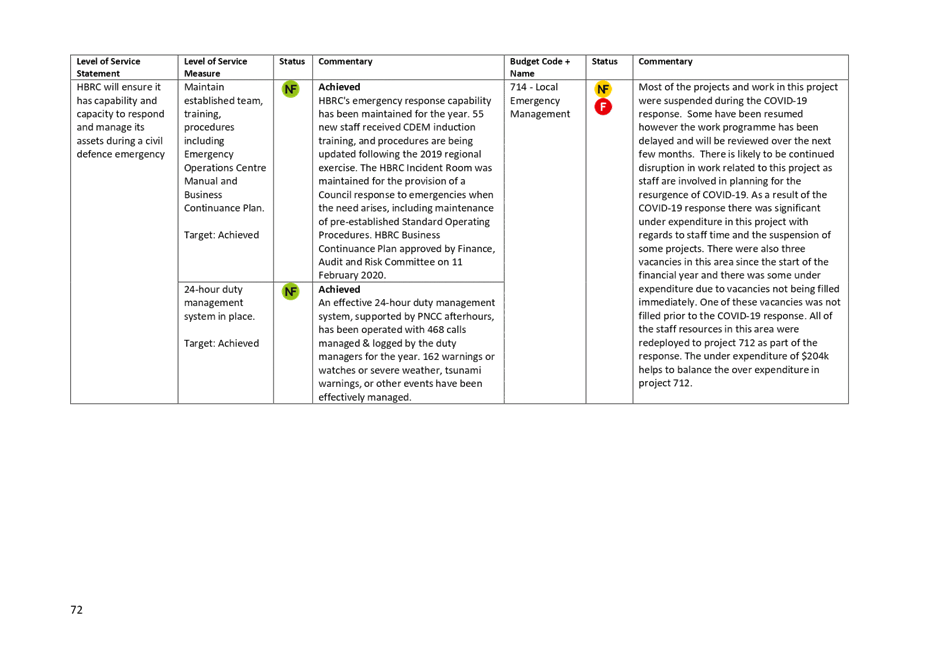
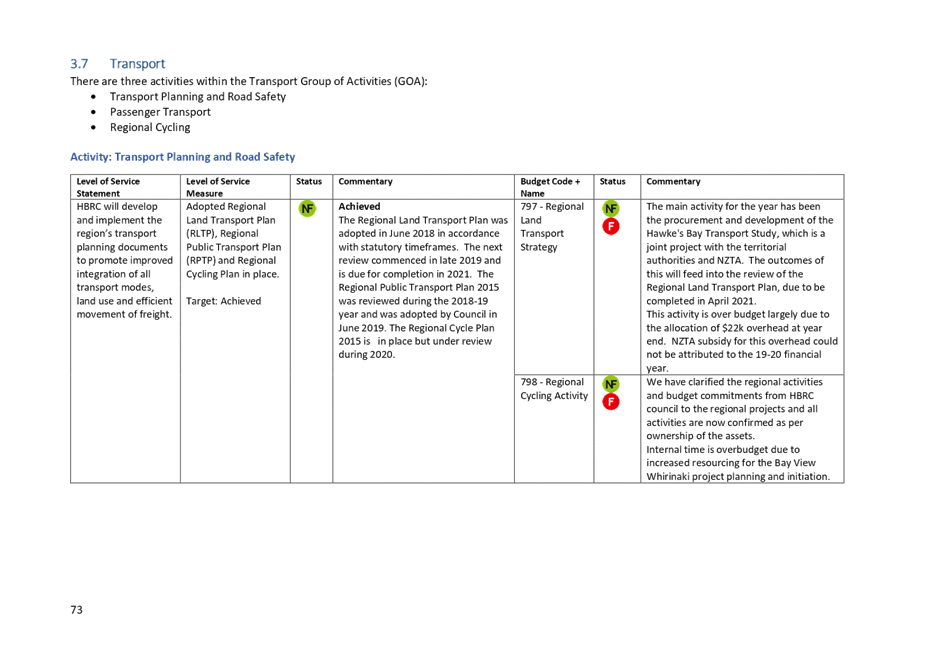
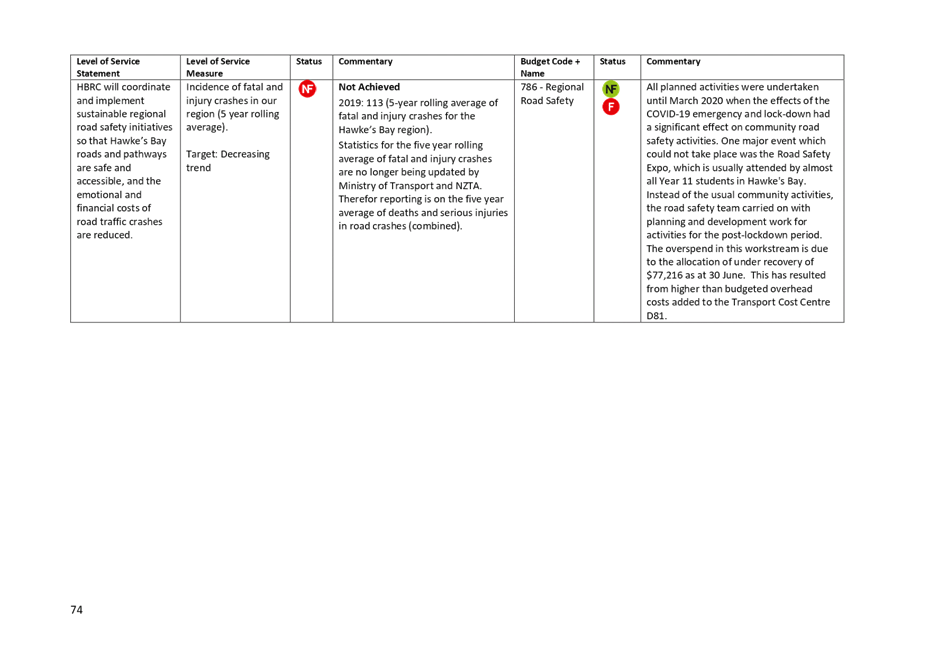
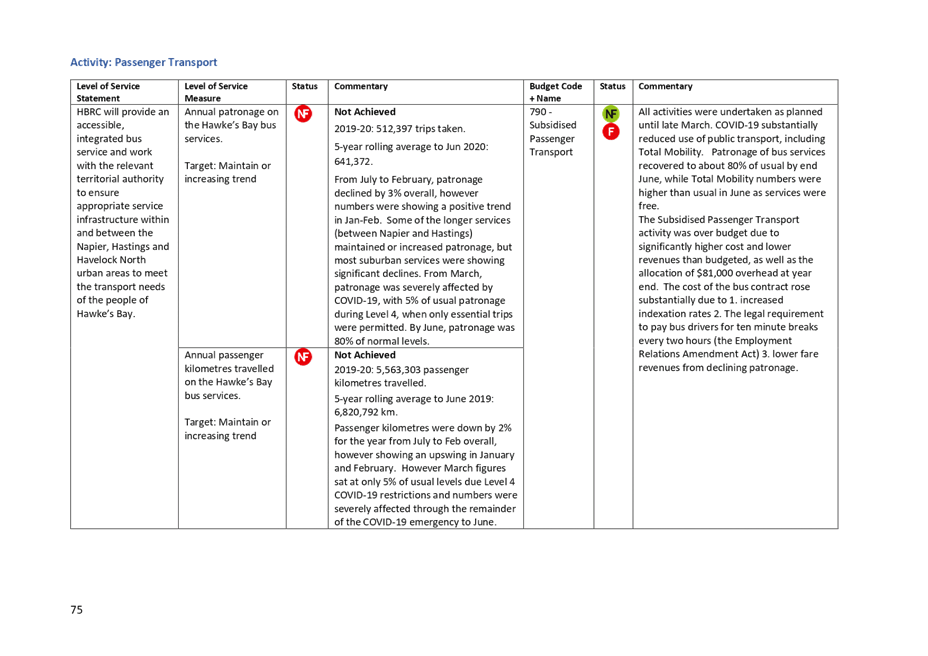
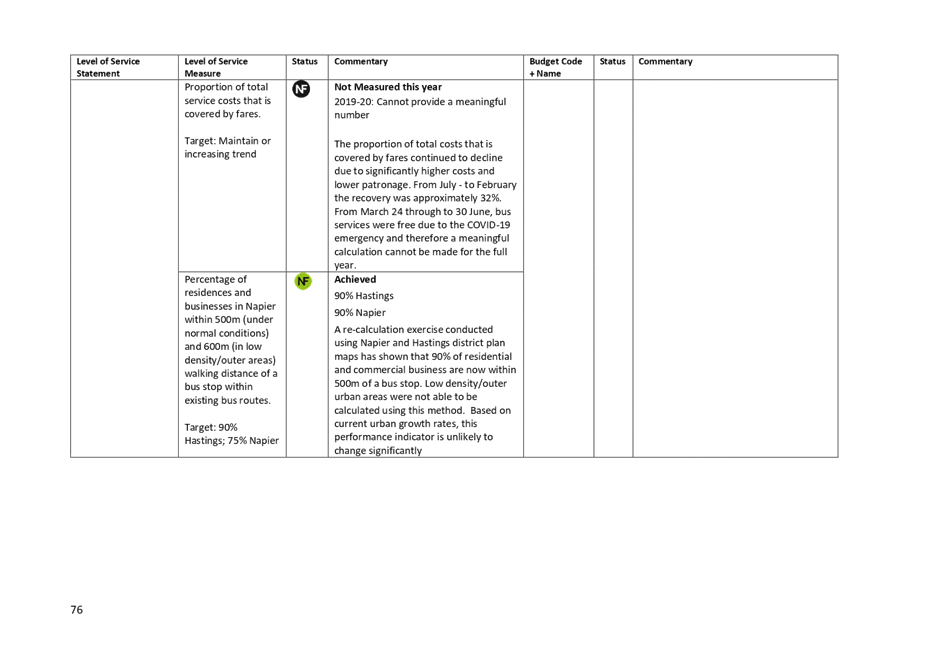
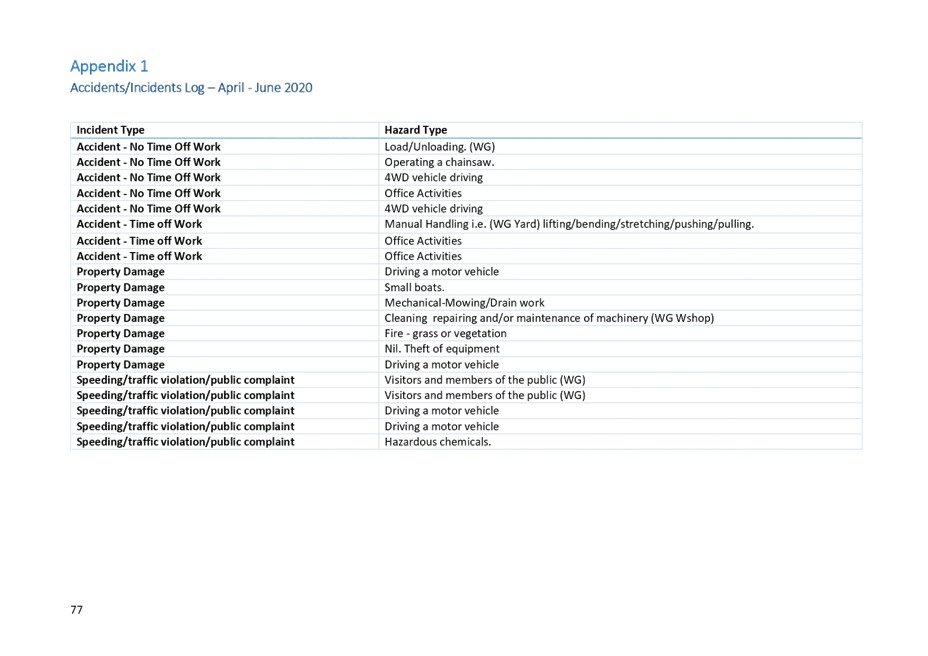
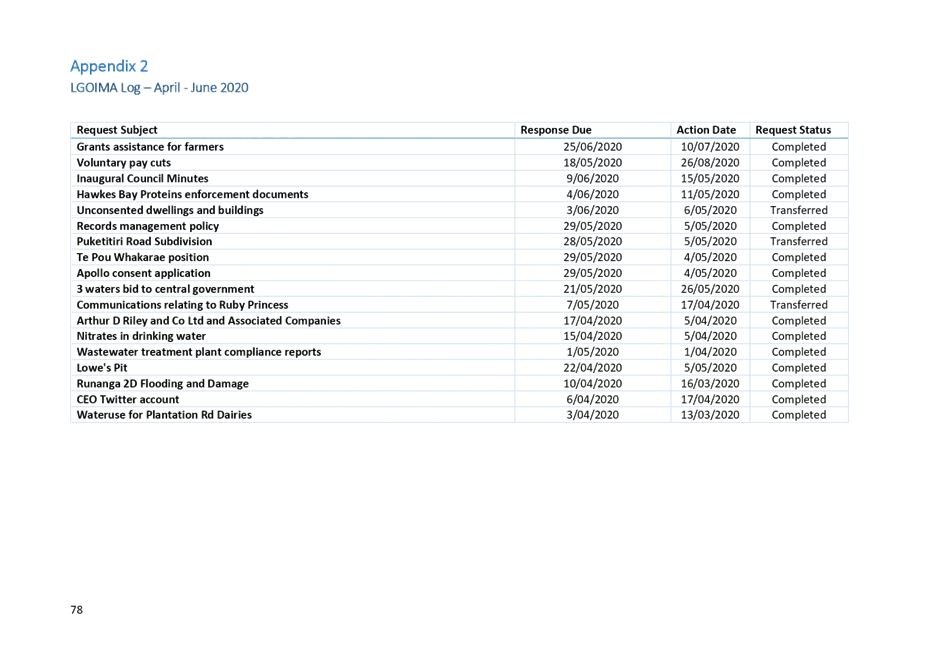
HAWKE’S BAY REGIONAL
COUNCIL
Corporate
and Strategic Committee
Wednesday 02 September 2020
Subject: Update on Covid-19:
CDEM Financial Report and Resurgence Planning
Reason for Report
1. The purpose of
this report is to update the Committee/Council on the financial impacts on the
Hawke's Bay CDEM Group of the recent COVID-19 response and ongoing work in
responding and preparing for the resurgence of COVID-19.
Executive Summary
2. Financial
– The response to COVID-19 has had a significant impact on the Group
finances and work programme. The provision of emergency welfare support
and direct operational response costs resulted in $1,692,324 additional
expenditure in 2019-20. Reimbursement of $530,053 has been approved for
the first welfare cost claim from the National Emergency Management Agency
(NEMA). A further three claims amounting to a total of $409,351 are
currently being assessed.
3. This has
resulted in a net overspend of $374,077 (after Lifelines expenditure has been
removed). The Group currently has $371,515 held in reserves leaving a
deficit of $2,562 in the reserve account.
4. In summary,
while there has been significant unbudgeted expenditure in the CDEM Group
budgets, the decision to hold under-expenditures in recent years as a reserve
has meant this has been managed, without the need to increase the regional
targeted rate. There is however some residual risk for deficits resulting
from any future events.
5. COVID-19
Resurgence Planning and Work Programme – There is an ongoing high
risk of a recurrence of COVID-19 and some form of community transmission beyond
what has already occurred in the future.
6. The Group work
program is being to be re-orientated to help manage the impacts of this risk.
7. The learnings
from the COVID-19 response to 30 June 2020 has helped inform the priorities and
direction of the Group’s work/projects for at least the next 6-12 months.
Background and
Discussion
8. At the last
meeting of the Hawke's Bay CDEM Group Joint Committee on 31 August, two papers
requesting the adoption of the Group’s financial report for 2019/20 and
the endorsement of decisions regarding resurgence planning and the Group work
programme, were presented.
9. These two
papers are attached for the information of the Committee. The Group
Manager/Controller for the Group will be available at the meeting to inform the
committee on the Joint Committee decisions arising from the attached papers and
answer any questions.
Decision Making Process
10. Staff have assessed the
requirements of the Local Government Act 2002 in relation to this item and have
c oncluded that, as this report is for information only, the decision-making
provisions do not apply.
|
Recommendation
That the Corporate and Strategic Committee
receives and notes the “Update on Covid-19: CDEM Financial Report
and Resurgence Planning” staff report.
|
Authored and
Approved by:
|
Ian Macdonald
Group Manager/Controller
|
|
Attachment/s
|
⇩1
|
2019-20 HB
CDEM Group Financial Report
|
|
|
|
⇩2
|
CDEM Group
Covid-19 Resurgence Planning and Future work programme
|
|
|
|
2019-20
HB CDEM Group Financial Report
|
Attachment 1
|
HAWKE’S BAY REGIONAL COUNCIL
HB
CDEM Group Joint Committee
Monday 31 August 2020
Subject: 2019-20 Hawke's Bay
CDEM Group Financial Report
Reason
for Report
1. The purpose of
this report is to provide the final Group financial report for the 2019-20 year
for the approval of the Committee.
Officers’ Recommendations
2. That the
Committee adopts the 2019-20 Hawke's Bay CDEM Group Financial Report.
3. That the
Committee agrees that the 2019-20 overspend from the COVID-19 response be held
as a deficit in the Hawke's Bay CDEM Group targeted rate reserve account.
4. That this
deficit be recovered through the management of expenditure in future financial
years.
Executive Summary
5. The response to
COVID-19 has had a significant impact on the Group finances and work
programme. The provision of emergency welfare support and direct
operational response costs resulted in $1,692,324 additional expenditure in
2019-20. Reimbursement of $530,053 has been approved for the first
welfare cost claim from the National Emergency Management Agency (NEMA).
A further three claims amounting to a total of $409,351 are currently being
assessed.
6. This has
resulted in a net overspend of $374,077 (after Lifelines expenditure has been
removed). The Group currently has $371,515 held in reserves leaving a
deficit of $2,562 in the reserve account.
7. It is
recommended that this small deficit in the reserve be recovered by way of
managing expenditure over the 2020-21 financial year. The risk with this
approach is that further emergency expenditure maybe required as the result of
a resurgence of COVID-19 or another emergency event.
8. In summary,
while there has been significant unbudgeted expenditure in the CDEM Group
budgets, the decision to hold under-expenditures in recent years as a reserve
has meant this has been managed, with some residual risk from future events,
without the need to increase the regional targeted rate.
Background/Discussion
9. Attachment 1
contains the final financial reports for 2019-20 summarising the costs
attributed to the COVID-19 response and more detailed reports for the four
Group project areas that are currently funded by the regional CDEM targeted
rate (711, 712, 713 and 714).
10. Prior to the COVID-19
response, the Group budgets were on track for under expenditure for the 2019-20
financial year. This has also helped in reducing the financial impact of
the COVID-19 response.
11. As part of the COVID-19
response the Group incurred two additional types of expenses. These
include operational response and emergency welfare support expenditure. A
summary of these costs are attached.
12. The operational response
costs included matters such as:
12.1. Short term contracts for
additional welfare staff
12.2. Development and
operation of the welfare 0800 number and the team of needs assessors
12.3. Personnel costs for
extra staff hours
12.4. Miscellaneous response
costs such as food for shifts, extra IT equipment and software licences.
13. Emergency welfare costs
included such items as:
13.1. Grocery items
13.2. Household goods such as
clothing and blankets
13.3. Delivery costs
13.4. Emergency accommodation
13.5. Reimbursement of food
bank costs
14. The extra expenditure due
to COVID-19 has been significantly offset by reduced activity in other areas
such as risk reduction, hazard research, coordination and community engagement.
15. Another factor to be
considered as part of the Group finances is the addition operational
expenditure of $60,000 in supporting the drought response.
16. In summary the additional
COVID-19 and drought operational response costs have been absorbed through
reduced activity in non-response areas and the utilisation of the existing
reserve.
17. 2020-21 Financial Year
Risks – As the CDEM reserve account is now depleted there is a risk
that if another significant event was to occur a large deficit may arise.
18. By far the biggest risk
now, is any response required as part of a resurgence of
COVID-19. Based on our previous experience and the fact that across all
levels of government and the community we are better prepared. It is
probable that any resurgence will not have as large impact and will be better
managed. Given recent work and conversations across the all of government
response there is confidence that the demand on CDEM welfare services in
particular will not be as high as it was in the first response.
19. As the 2020-21 rates have
now been struck there are no real short-term options available to provide for a
reserve. Therefore any emergency expenditure over the next 12 months may
require the reserve account to move further into deficit.
Options Assessment
20. As expected the COVID-19
response has had a significant impact on the finances of the Group. The
gross result of this would have been an approximately $700,000 overspend.
However, after taking out reduced expenditure across the CDEM activity and
using the $371,000 held in reserve a minor deficit remains.
21. There are limited options
available to address this, and the risk of further deficit into 2020-21.
Strategic Fit
22. Under the Group Plan the
Group is required to efficiently and effectively respond to an emergency
event. There is nothing in this paper or recommendations that adversely
impact on this.
Financial and Resource Implications
23. Any financial or resource
implications have been addressed as part of this paper.
Decision Making
Process
24. Committee is required to
make every decision in accordance with the requirements of the Local Government
Act 2002 (the Act). Staff have assessed the requirements in relation to this
item and have concluded:
24.1. The decision does not
significantly alter the service provision or affect a strategic asset.
24.2. The use of the special
consultative procedure is not prescribed by legislation.
24.3. The decision does not
fall within the definition of the Administrating Authority’s (HBRC)
policy on significance and engagement
24.4. No persons can be
identified who may be affected by this decision.
24.5. The decision is not
inconsistent with an existing policy or plan.
24.6. Given the nature and
significance of the issue to be considered and decided, and also the persons
likely to be affected by, or have an interest in the decisions made, the
Committee can exercise its discretion and make a decision without consulting
directly with the community or others having an interest in the decision.
|
Recommendations
That
Hawke’s Bay CDEM Joint Committee:
1. Receives and considers the “2019-20 Hawke's Bay CDEM
Group Financial Report” staff report.
2. Agrees that the decisions to be made are not significant under the
criteria contained in Council’s adopted Significance and Engagement
Policy, and that Council can exercise its discretion and make decisions on
this issue without conferring directly with the community or persons likely
to have an interest in the decision.
3. That the
Committee adopts the 2019-20 Hawke's Bay CDEM Group Financial Report.
4. That the Committee agrees that the 2019-20 overspend from the
COVID-19 response be held as a deficit in the Hawke's Bay CDEM Group targeted
rate reserve account.
5. That this deficit be recovered through the management of
expenditure in future financial years.
|
Authored by:
|
Ian Macdonald
Group Manager/Controller
|
|
Approved by:
|
Ian Macdonald
Group Manager/Controller
|
|
Attachment/s
|
1
|
CDEM Income
and Expenditure 2019-20 Financial Year
|
|
|
|
2
|
Project
Progress Report - Reduction - Hazard Identification and Mitigation
|
|
|
|
3
|
Project
Progress Report - Readiness and Response
|
|
|
|
4
|
Project
Progress Report - Recovery and Coordination
|
|
|
|
5
|
Project
Progress Report - Local Emergency Management
|
|
|
|
6
|
Project
Progress Report - Emergency Management Total
|
|
|
|
7
|
CDEM Reserve
Account
|
|
|
|
2019-20
HB CDEM Group Financial Report
|
Attachment 1
|
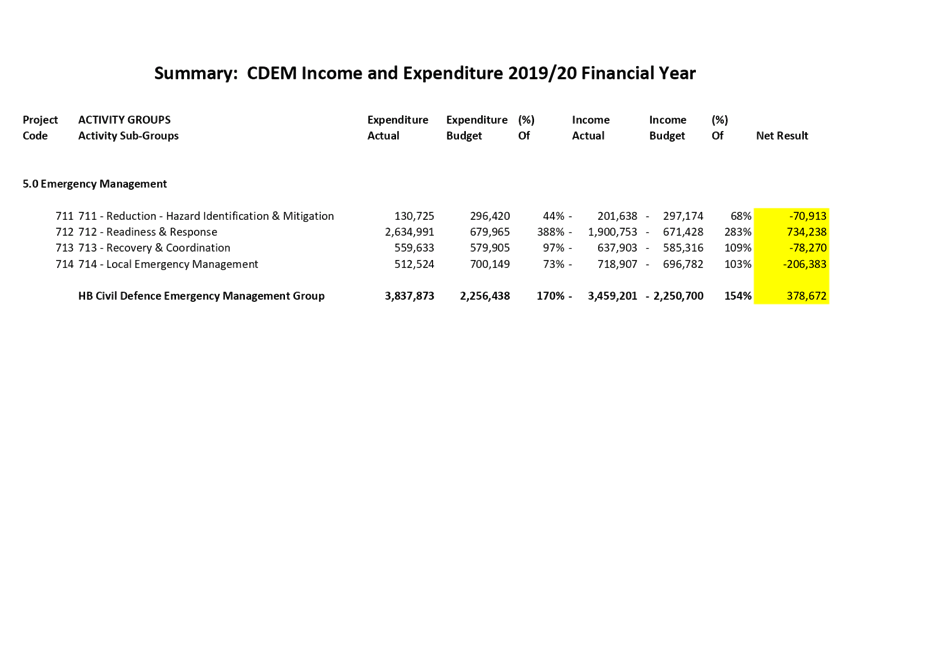
|
2019-20
HB CDEM Group Financial Report
|
Attachment 1
|
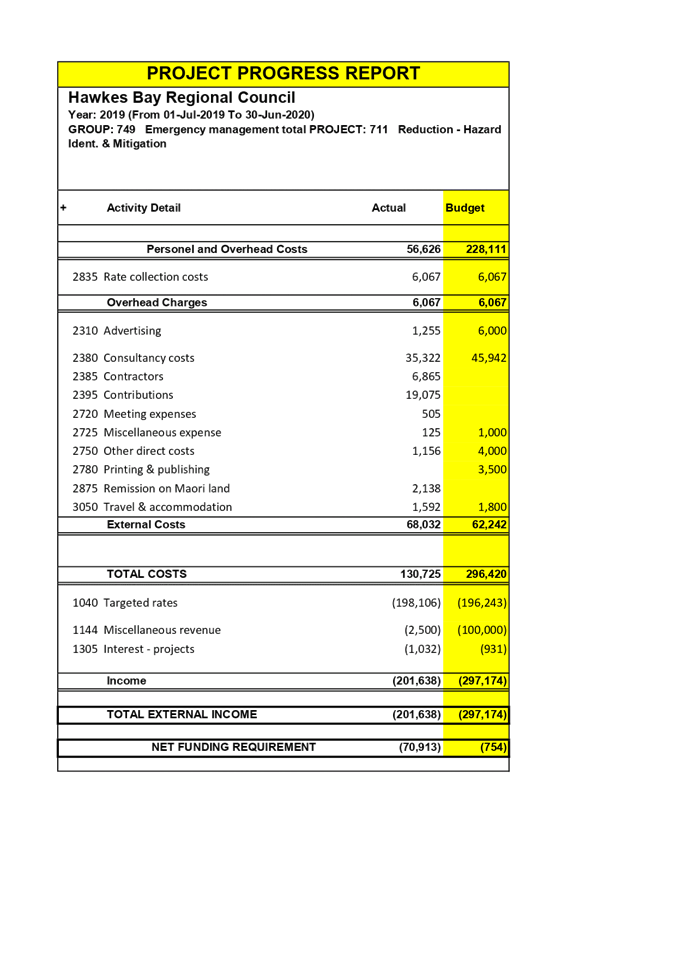
|
2019-20
HB CDEM Group Financial Report
|
Attachment 1
|
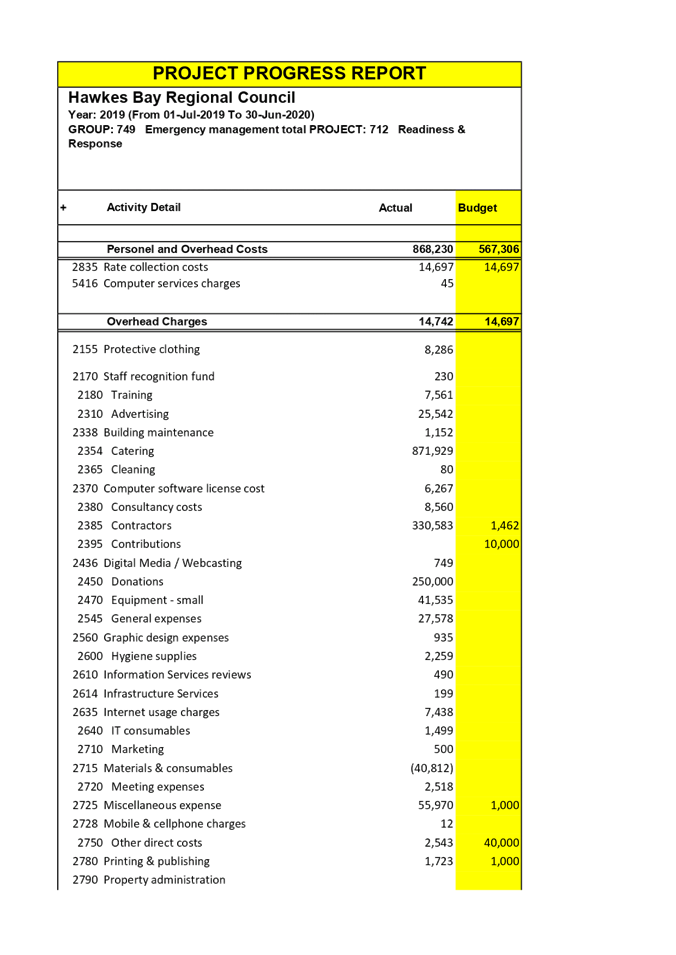
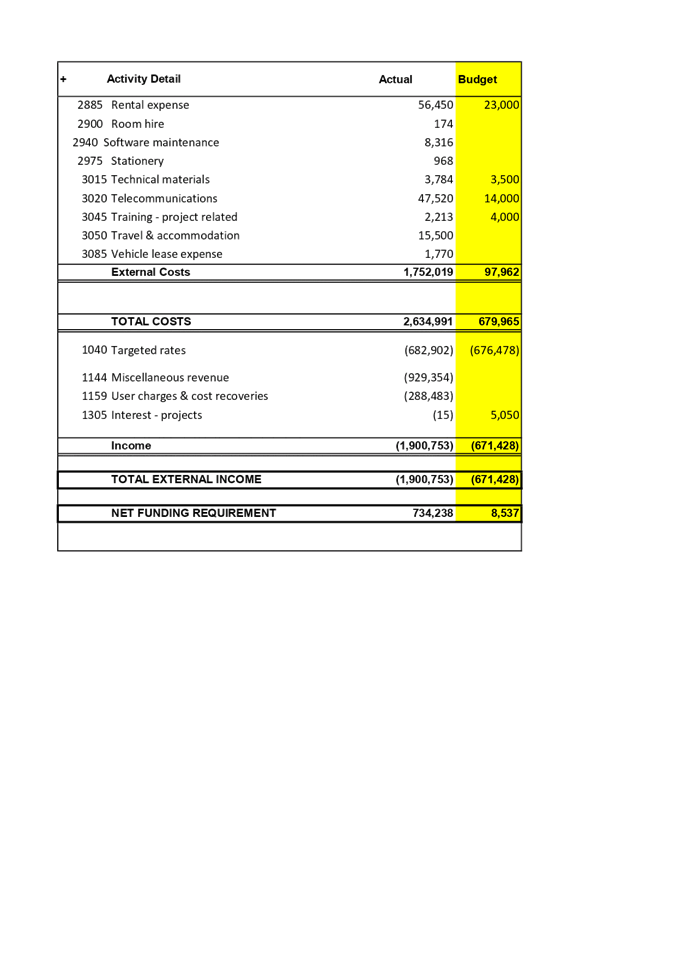
|
2019-20
HB CDEM Group Financial Report
|
Attachment 1
|
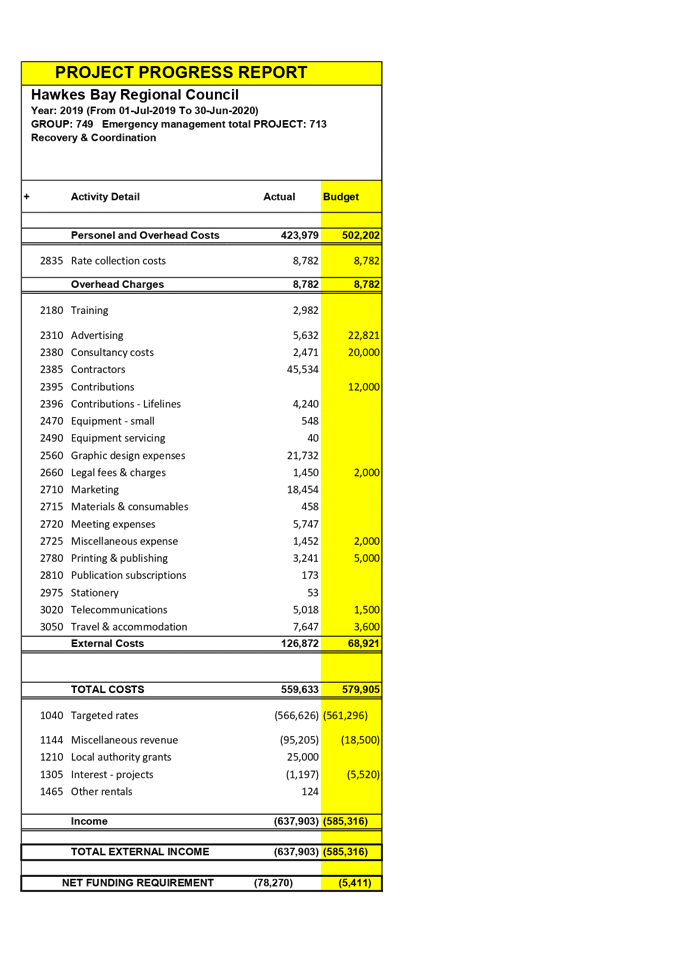
|
2019-20
HB CDEM Group Financial Report
|
Attachment 1
|
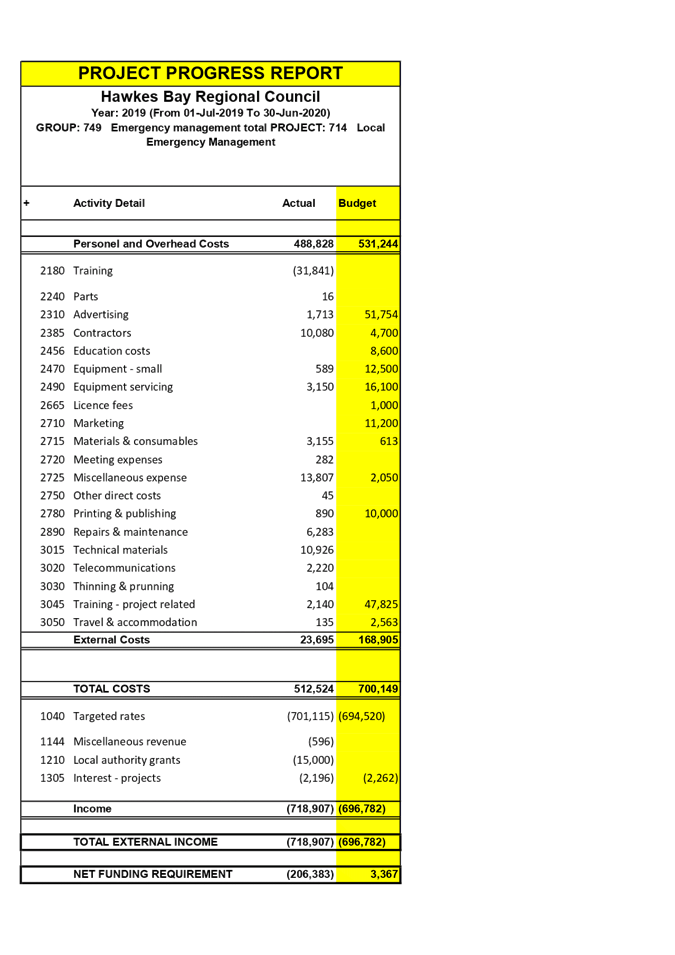
|
2019-20
HB CDEM Group Financial Report
|
Attachment 1
|
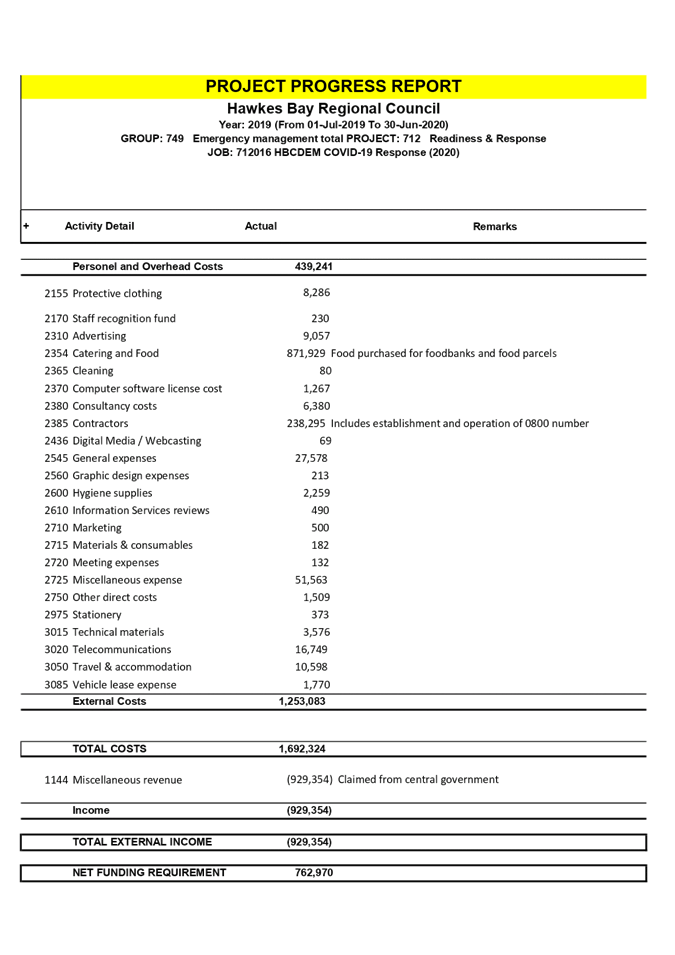
|
2019-20
HB CDEM Group Financial Report
|
Attachment 1
|

|
CDEM
Group Covid-19 Resurgence Planning and Future work programme
|
Attachment 2
|
HAWKE’S BAY REGIONAL COUNCIL
HB
CDEM Group Joint Committee
Monday 31 August 2020
Subject: CDEM Group COVID-19
Resurgence Planning and Future Work Programme
Reason for Report
1. The purpose of
this report is to attain endorsement from the Committee on a decision by the
Coordinating Executives Group (CEG) as to the direction of the Group work
program over the next 6-12 months.
Executive Summary
2. There is an
ongoing high risk of a future recurrence of COVID-19 in Hawke's Bay and some
form of community transmission beyond what has already occurred.
3. The Group work
program needs to be re-orientated to help manage the impacts of this risk.
4. The learnings
from the COVID-19 response to 30 June 2020 has helped inform the priorities and
direction of the Group’s work/projects for at least the next 6-12 months.
Background
5. Post the
initial COVID-19 response it was deemed prudent to review the work being
undertaken by Group office, with the support of Council and partner agency
staff. This work had commenced and CEG provided guidance and decisions at
its 20 July meeting.
6. Subsequently on
12 August community transmission was confirmed in Auckland and Hawke's Bay was
placed back into Level 2 restrictions.
7. National advice
is that there continues to be a high risk of a recurrence
of COVID-19 and some form of community transmission into the future.
8. In mid-June
some initial decisions were made by the Group Manager/Controller to set the
high-level intent for the Group office for the rest of 2020. These are:
8.1. To ensure
Group office staff can support a Group response to a
COVID-19 recurrence.
8.2. To ensure any
work/projects will add value to a Group response to a COVID-19 recurrence.
9. The aim is to
have Group office staff rested and capable of supporting a sustained response,
while also reviewing or developing supporting systems, processes and
relationships to respond to a COVID-19 recurrence.
10. This work commenced with
staff wellbeing initiatives and monitoring, and the commencement of the
COVID-19 response to 30 June after-action review (AAR). Some initial
COVID-19 recurrence response planning was also completed and this was further
prioritised and advanced upon returning to Level 2 on 12 August.
Discussion
11. Decisions on the Group
work priorities over the next 6-12 months also have implications for council
staff and partner agencies. While the Group office staff will play a
significant role, much of what needs to occur also requires commitment and
input from key council staff and partner agencies. As such this work
needs to be given a high priority within organisations.
12. Work has commenced on
reviewing the current Group COVID-19 recurrence plan (dated 14 Aug) in light of
the National Action Plan being released on 19 August. In priority order,
the CEG confirmed the following key work areas for improvement:
12.1. The identification,
selection, onboarding, and staff management policies (e.g. rostering,
contracts, EAP) of staff in the GECC.
12.1.1. Significant work has been
completed in this area.
12.1.2. The Group office has
completed engagement with Councils, controllers and staff have been clearly
identified to play roles within specific functions in the GECC and as needs
assessment analysts. Short training sessions with these staff have
commenced.
12.2. Review of health and
safety for the GECC facility and staff within, safe working methods for those
deployed. Including bubble management and use of PPE.
12.2.1. Work on this review has
commenced. Health and safety staff from HBRC, HDC and NCC have commenced
a review of existing documentation, induction and procedures including ongoing
wellbeing.
12.3. System accessibility,
stability, shared understanding of response systems and data management within
response information systems.
12.3.1. The work in this area are a
number of smaller process/hardware initiatives and training. As mentioned
training is underway and ICT systems are part of this.
12.3.2. A security review of ICT
systems which hold personal information through emergency welfare needs
assessment has just been completed and any implications are being identified.
12.4. Supply chain and
logistical processes, integration of Fast-Moving Consumer Goods systems into
procurement and food package system.
12.4.1. The Hawke's Bay councils
Director, Regional Strategic Procurement has commenced reconnecting with local
supermarkets and gaining an understanding of their capability to support food
distributing if needed.
12.4.2. Further work is required in
this area however to an extent this is driven at a national level.
12.5. Welfare needs assessment
and referrals process. Options analysis of the Āwhina needs
assessment tool vs The Development Hub. Integration and implementation into
Group response systems.
12.5.1. Good progress has been made
in this area. Work has been ongoing with HBRC, HDC and NCC as to how we
might internalise the call centre (the so called 0800 number) by better using
existing staff who will be under utilised should Hawke's Bay move back into
Level 3 restrictions or above.
12.5.2. At this stage it has been
decided not to use the national needs assessment tool (Āwhina) primarily
to maintain continuity for the on-going COVID-19 response. However, we
will be reviewing this decision as Āwhina is developed further by the
National Emergency Management Agency (NEMA).
12.5.3. As mentioned we intend to
use council staff to carry out the detailed welfare needs assessment as people
are referred from the 0800 number. Council staff and two facilities from
HDC and NCC have already been identified. Training packages have been
developed and training of the needs analysis staff will occur over the next few
weeks.
12.6. Embedding community
engagement in response into our wider response framework. Ensuring
networks of networks approach in response is enduring, informs a re-escalation,
and increases long term resilience of Hawke’s Bay.
12.6.1. The Group Welfare Manager
has been working with the wider Welfare Coordination Group (WCG) to review the
roles and responsibilities to help guide and lead the individual
networks. Attachment 1 outlines how this is now structured.
12.6.2. Each of the networks have
met at least once since July and this relationship management will be ongoing.
12.6.3. Feedback from staff has been
that while the NGOs and volunteers involved in the networks are feeling
drained, and are still dealing with the ongoing impacts of COVID-19 on their
communities, there is self-confidence that they will be able to effectively
support their communities should Hawke's Bay move into Level 3 or above again.
12.6.4. This work area has also been
enhanced by the establishment of the Regional Leadership Group (RLG) which is
part of the central government Caring for Communities initiative. The
role of the RLG is to provide support, advice and governance to the overall
regional response to COVID-19. The members of this Committee are also
part of this Group.
13. The recommendations above
are consistent with a number of learnings from the national COVID-19 response
review which was undertaken in late July. Three Group office staff
attended this review.
14. An outline timeframe for
this work is as follows. Due to the August resurgence of COVID-19 much of
this work has been accelerated and where necessary operational decisions made
on actions and priorities in keeping with the intent from CEG:
14.1. 20 July CEG - project
initiation, work program areas of focus for recurrence was approved.
14.2. August - Engaging
with project teams and stakeholders, understanding the problem. Scoping
the work for re-escalation. Due to the current COVID-19 resurgence this
work has been accelerated.
14.3. September –
where developed project plans socialised and consulted with stakeholders.
14.4. 19 October CEG –
Present outstanding project plans and approval for implementation. Review
existing or completed work.
14.5. Ongoing already -
Embed formal COVID-19 to Jun 2020 response lessons, implement and monitor
project plans.
15. At the July CEG meeting,
the point was made that the above should not be viewed as a purely linear
process and where appropriate and within the guidance of this paper, projects
or work may be brought forward or occur concurrently. This is what has
occurred.
16. The implications of
changing the direction of the Group work program for the next 6-12 months are:
16.1. The review of the Group
Plan will need to be delayed until 2021. Given the review of the National
Plan has been further delayed, the current Plan is seen as generally fit for
purpose and has been updated as appropriate, the residual risk of this decision
is low.
16.2. In general current risk
reduction and community engagement work will be delayed by about 6 months
– although some work which was significantly advanced is being completed.
16.3. Significant exercises
will be placed on hold until 2021 and some training will be delayed.
17. The Committee should also
note that the Group Welfare Manager Alison Prins has resigned her position and
will leave on 9 September. Due to the pivotal role of this position in
readiness and response particularly in the COVID-19 response, the Group office
has employed Joanne Lawrence on a short-term contract until the end of the
year. This is to provide continuity in the current response while the
position is reviewed and the market recruitment process completed.
18. Ms Lawrence was an
alternate Group Welfare Manager during the first COVID-19 response and covered
for a couple of weeks while the incumbent was rested. She also held a
leadership position at MSD and was a member of the WCG for a number of years.
Next Steps
19. It is requested that the
Committee endorse the CEG decisions outlined in this report. This will
ensure that the Group is well positioned to continue to respond to the
intermediate risks of an ongoing recurrence of COVID-19.
20. CEG and the Regional
Leadership Group will be kept up to date on the Group COVID-19 Recurrence Work
Plan as it is further developed and implemented.
21. This will also be reported
on at the next Committee meeting.
Strategic Fit
22. Under the Group Plan the
Group is required to respond to emergencies efficiently and effectively within
Hawke's Bay. This paper helps to facilitate this for COVID-19.
Considerations of Tangata Whenua
23. Tangata whenua are
included as part of the Regional Leadership Group and at a more operational
level the networks of networks.
24. There is further work
started in developing a more deliberate approach to working with tangata whenua
across the 4Rs in emergency management.
Financial and Resource Implications
25. There are no significant
resourcing issues as existing budgets should cover any costs in the work
mentioned in this paper.
26. The only risk with funding
is in the response to moving to Level 3 or 4 as the Groups current reserves
were exhausted in the initial response. This has been noted in a previous
paper.
Decision Making
Process
27. Committee is required to
make every decision in accordance with the requirements of the Local Government
Act 2002 (the Act). Staff have assessed the requirements in relation to this
item and have concluded:
27.1. The decision does not
significantly alter the service provision or affect a strategic asset.
27.2. The use of the special
consultative procedure is not prescribed by legislation.
27.3. The decision does not
fall within the definition of the Administrating Authority’s (HBRC)
policy on significance and engagement
27.4. No persons can be
identified who may be affected by this decision.
27.5. The decision is not
inconsistent with an existing policy or plan.
27.6. Given the nature and
significance of the issue to be considered and decided, and also the persons
likely to be affected by, or have an interest in the decisions made, the
Committee can exercise its discretion and make a decision without consulting
directly with the community or others having an interest in the decision.
|
Recommendations
That
Hawke’s Bay CDEM Joint Committee:
1. Receives and considers the “CDEM Group COVID-19 Resurgence
Planning and Future Work Programme” staff report.
2. Agrees that the decisions to be made are not significant under the
criteria contained in Administrating Authority’s adopted Significance
and Engagement Policy, and that Committee can exercise its discretion and
make decisions on this issue without conferring directly with the community
or persons likely to have an interest in the decision.
3. Endorses the CEG decisions on the direction of the Group
work program, including COVID-19 Resurgence Planning, over the next 6-12
months.
|
Authored and Approved by:
|
Ian Macdonald
Group Manager/Controller
|
|
Attachment/s
|
CDEM
Group Covid-19 Resurgence Planning and Future work programme
|
Attachment 2
|
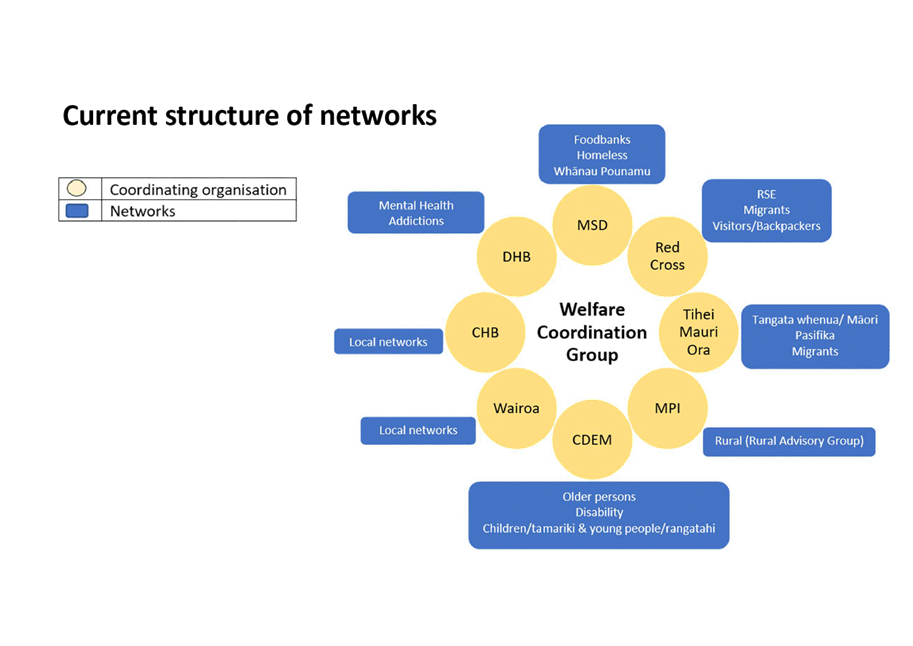
HAWKE’S BAY REGIONAL
COUNCIL
Corporate
and Strategic Committee
Wednesday 02 September 2020
Subject: HBRC Covid-19 Response
Review Update
Reason for Report
1. This item provides an update on the review being carried out on
HBRC’s organisational response to the Covid-19 pandemic.
Background
2. In December 2019 an outbreak of Coronavirus disease (Covid-19) was
detected in Wuhan, China. The virus rapidly spread across the globe. On
30 January 2020 the World Health Organisation (WHO) declared the Covid-19
outbreak a ‘public health emergency of international concern’. On
11 March 2020 WHO declared Covid-19 a ‘global pandemic’.
3. Within New Zealand the first case of Covid-19 was announced on 28
February. The first locally transmitted case was announced exactly one
week later on 5 March 2020.
4. On 19 March 2020 New Zealand’s borders were closed to all
non-residents. In addition to the border closures any returning; citizen,
permanent resident, or non-residents with border exemptions were required to
self-isolate for 14 days.
5. To complement the border restrictions and to control the Covid-19
outbreak in New Zealand the Government in conjunction with the NZ Ministry of
Health (MOH) updated the pandemic New Zealand response plan and four tier alert
system. On 21 March 2020, at the time of the alert level system announcement
the Government also confirmed New Zealand would enter alert level 2 in a
‘go hard and go early’ strategy that attempted to eliminate the
disease. With the alert level system confirmed New Zealand Covid-19 response
has taken the following path:
5.1. 21 March 2020 – alert level 2 (whole country)
5.2. 23 March 2020 – alert level 3 (whole country)
5.3. 25 March 2020 – alert level 4 (whole country)
5.4. 27 April 2020 – alert level 3 (whole country)
5.5. 13 May 2020 – alert level 2 (whole country)
5.6. 8 June 2020 – alert level 1 (whole country)
5.7. 12 August 2020 – alert level 3 (Auckland region only)
5.8. 12 August 2020- alert level 2 (rest of country outside the Auckland
region)
6. Each alert level impacts the way in which organisations can
operate. With the most significant impacts to organisations being at
alert level three and four where non-essential staff are required to work from
home. For a period of nearly two months (from 23 March 2020 to 13 May
2020) New Zealand operated under either alert level three or four. During
this time HBRC operated by activating its Business Continuity Plan (BCP).
Therefore, a review has been undertaken to capture the learnings and possible
improvements to HBRC’s BCP.
Discussion
7. When an organisation operates under business continuity arrangements
it is deemed good practice to review the effectiveness of the response.
The objective of a review is to identify improvement opportunities to ready the
continuity plans to more efficiently respond to future events. At the
FARS meeting on 12 August 2020 the Committee requested the review of
HBRC’s BCP that was activated in response to the Covid-19 lockdown be
undertaken internally by staff rather than by Crowe through the 2020-21
Internal audit plan.
8. The scope and approach to obtain necessary information to undertake
the BCP review included: an organisational wide staff survey, a facilitated
workshop with organisational leaders using outputs from the staff survey, other
key stakeholder insights, and a desktop review of relevant documentation such
as HBRC’s BCP, pandemic plan and response team structure.
9. The scope of the review specifically excludes Hawke’s Bay CDEM
response. However, did include Hawke’s Bay CDEM requests for HBRC
staff time required to staff the Group Emergency Coordination Centre. In
addition, the scope of the review excludes additional business activities
required under alert level one and alert two. The additional practices
under alert level one and two were not deemed extensive and did not require
HBRC to respond under BCP arrangements.
10. To date,
information gathered for the final report indicates that HBRC’s response
to both alert level thee and four was largely effective. No material issues
were immediately apparent that highlight concerns regarding the safe execution
of HBRC’s critical processes over this time. The final report is
unlikely to identify any ‘high’ findings for urgent action that if
remained unresolved could jeopardise HBRC’s execution of critical
processes if the region was to revert back into alert level three or
four. These observations are supported by staff survey feedback and the
facilitated session feedback. The average overall rating for HBRC’s
response to Covid-19 by staff was 8.49 positive on a scale of 1 being poor to
10 being excellent. In addition, staff consistently rated HBRC’s
response positive (greater than 80%) across all survey areas.
11. It is
intended that the final report will be split across five key themes being; BCP
and pandemic plans, communications (internal and external), technology, health
and safety and wellbeing, and work distribution including tension between BCP
and CDEM response. Details of observations within these themes based on
information gathered to dated is outlined below.
Business
Continuity and Pandemic Plans
11.1. There was no documented pandemic plan. Therefore, processes around staff
isolation, segregation and pandemic supplies initiated as part of HBRC’s
Covid-19 response should be documented as reference for any future pandemic or
epidemic.
11.2. HBRC’s
documented business continuity plan identified HBRC’s critical processes
that enabled an effective pandemic response by prioritising those processes.
However, work arounds for critical processes within the BCP could be strengthened
using a ‘denial’ focus; i.e. denial of staff, systems, facilities,
and suppliers/services. This should ensure critical process work arounds
respond to a variety of situations. For example, HBRC’s Covid-19 response
was focused on staff not being able to come to their usual place of work
referred to as ‘denial’ of facilities. However, if the
situation worsened and many staff became ill with Covid-19 this situation could
require an additional response known as ‘denial’ of staff.
Communication
(Internal and External)
11.3. Staff feedback through both the survey and facilitated
session on the effectiveness of internal communication during alert levels
three and four was favourable. Staff scored the effectiveness of internal
communication as 88% positive. Internal communication channel included; formal
Chief Executive Zoom meeting updates, regular HBRC online newsletter (Snappy),
regular Line Manager meetings and check-ins via Microsoft Teams, and informal
staff catchups through Microsoft Teams. Data is
still being collated for the final report to analyse the success of HBRC
external communication.
Technology
11.4. Staff
feedback through both the survey and facilitated session with regards to the
HBRC’s technology; use, capacity, availability, and support during alert levels three and four was favourable.
Staff felt that transition to working from home was smooth. The availability of
IT equipment and help desk support was commendable.
Health,
Safety and Wellbeing
11.5. Overall, the additional
pandemic health and safety processes work well, these processes included;
cleaning and cleansing, segregation, contact tracing, and pandemic PPE
use. However, some improvements to the design of where work activities
are undertaken to ensure ’work bubbles’ remain separated is
required at the Works Group.
Work
Distribution Including BCP and CDEM Response Resource Tensions
11.6. Through the facilitated session with HBRC’s leaders
it was identified that the dependency to staff Hawke’s Bay CDEM with HBRC
staff created some tension. In addition, internally some staff felt the work
distribution between individual staff was not always equitable. The
equitable distribution of work and the tension between CDEM and HBRC resource
requirements will be addressed by the review of the BCP noted in paragraph
11.2.
Next Steps
12. Finalise
the full HBRC Covid-19 Response Review Report, including:
12.1. collating
additional information from key external stakeholders such as external
complaints and compliments data
12.2. compiling
management comments into the full draft report
12.3. presenting
the final draft to the Executive Leadership Team (ELT) for endorsement
12.4. assigning
agreed findings and actions to a responsible staff
12.5. presenting
the final report to the FARS at the 11 November 2020 meeting.
Decision Making
Process
13. Staff have assessed the
requirements of the Local Government Act 2002 in relation to this item and have
concluded that, as this report is for information only, the decision making
provisions do not apply.
|
Recommendation
That the Corporate and Strategic Committee
receives and notes the “HBRC Covid-19 Response Review Update”
staff report.
|
Authored by:
|
Helen Marsden
Risk and Assurance Lead
|
|
Approved by:
|
Jessica
Ellerm
Group Manager Corporate Services
|
James Palmer
Chief Executive
|
Attachment/s
There are no
attachments for this report.
HAWKE’S BAY REGIONAL
COUNCIL
Corporate
and Strategic Committee
Wednesday 02 September 2020
Subject: Regional Drought Relief
Fund
Reason for Report
1. This paper sets out for Council the criteria for the Regional
Drought Relief Fund (RDRF) and associated contributions and expenditure from
this fund.
Executive Summary
2. The RDRF was created through contributions from the Ministry for
Primary Industries ($500K), HBRC ($200K), Central Hawke’s Bay District
Council ($50K), Hastings District Council ($200K), Centralines ($50K) and a
local “Give-a-little” fund ($15,110 as of 26 August
2020). It totals as of 26 August 2020 $1,015,110.
3. The fund was created principally to support the supply of stock feed
on to farms. There is an acknowledgement that given the widespread
drought conditions across the North Island and the lack of normal feed supply
chains in the North Island, the costs to obtain feed, primarily from the South
Island, are significantly elevated.
4. Current expenditure from the RDRF, as of 26 August 2020, is
$627K. Projections indicate that a further $175K will be spent in the
remaining 5 weeks that the fund remains open. It is projected that at the
close of the fund (the end of September) approximately $800K will have been
spent or committed.
Background
5. Drought conditions developed in Hawke’s Bay and across the
North Island during summer 2019-20, leading to the declaration of a
“large scale adverse event” by the Agriculture Minister Damien
O’Connor on 12 March 2020.
6. Hawke’s Bay had below normal rainfall, above average
temperatures and relatively high rates of potential evapotranspiration from
November 2019 to April 2020. Rainfall accumulations from November to April
were lower in 2019-20 than in the 2012-13 drought in all areas of the region,
apart from Waikaremoana and the Kaweka Range.
7. Following the 2012-13 drought, NIWA developed a New Zealand Drought
Index (NZDI) based on four common indices of climatological drought.
Throughout summer 2019-20 the NZDI typically categorised Hawke’s Bay as
very dry or extremely dry, with parts of the region in drought or severe
drought. Drought or severe drought levels were largely along the western
ranges, particularly the Ruahine Range and adjacent hill country and
surrounds. At the end of April the NZDI still categorized eastern
Hawke’s Bay as dry but extremely dry or in drought on the Heretaunga
Plains, the Ruataniwha Plains and southern coastal areas.
8. The funding is to support reliable and appropriate supply chain
logistics for stock feed to come to Hawke’s Bay. A reliable supply
of feed into the region is critical to support animal welfare and to allow
landowners to manage their way through the winter to bridge the lack of on farm
feed.
9. A complication with this current drought is that it has been a North
Island wide event. Whilst many parts of the North Island may well no
longer be in meteorological drought conditions, the effects of that on feed
availability continue to be felt across the North Island. Put simply
there is currently limited feed available in the North Island as a result of
the island wide conditions. Feed is available in some South Island
locations, but the transport costs for this are considerable.
Discussion
10. The RDRF
is held by the Hawke’s Bay Disaster Relief Trust (HBDRT) and administered
by the finance team at HBRC. The HBDRT comprises Mayors of the
Territorial Authorities and Chair of HBRC who is also Chair of the HBDRT.
11. Criteria
for eligibility for individuals to access the fund were developed by the Rural
Advisory Group (RAG) and have been used to apply the funding to date. The
criteria were developed to support the principle of supplying feed to farms.
The criteria were initially very financially conservative as there was no
previous history to draw from to understand what the demand might be.
Recently the criteria were further refined by the RAG to expand the eligibility
in response to feedback from landowners affected by the drought and to make
them less financially conservative as the demand was not as high as
anticipated.
12. Regional
Council data indicated 3,000 farms were in the drought affected area of Central
Hawke’s Bay and outlying areas of Hastings. The RAG made a
conservative assessment that 50% of those farms will need support. This
understanding then informed the scale of the funding initially made available
to individuals.
13. The criteria and process
to access the funding is as follows:
13.1. Applicants
have to apply for funds via an online form on the Hawke’s Bay Regional
Council’s website: https://www.hbrc.govt.nz/environment/farmers-hub/drought-crisis-hub/drought-relief-fund-register
(note this link is unpublished), or by phoning us
13.2. Applicants
need to confirm that they have a feed plan/budget and that this has informed
the feed requirements being supported by their application. This information
is auditable and must be supplied if asked for at a later date
13.3. Applicants
will provide their bank deposit slip and the invoice from the supplier (they
must have the same name on the invoice and bank deposit slip, and the invoice
must have the transport cost separated from the feed cost) and receive an email
to confirm their eligibility
13.4. The
applicants will then be reimbursed as soon as possible for the transport cost
– up to the maximum amount agreed according to the size of their land
13.5. A farm
trading entity can apply for the support up to the indicated maximums below.
13.6. Farms
are split into three categories:
13.6.1. Greater than 150 ha
(eligible for a maximum of originally $1,350, but now increased to $3000)
13.6.2. Between 20 ha –
150 ha (eligible for a maximum of originally $400, but now increased to $1000)
13.6.3. Less than 20 ha (This
funding will be administered directly to support transport operators for feed
supplies for this lifestyle market). No change to this category.
13.7. Originally
landowners could claim funding support from the date of 19 May 2020, which was
the date the RDRF was created, this has now shifted to 12 March 2020 which is
when the adverse drought event was announced by the Minister for Agriculture
13.8. There
is a reserve set aside of ($10) for the Rural Support Trust for on farm
emergency situations and $37K for previously committed donated feed transport
costs.
14. Further
recent changes have been to:
14.1. To not
on-charge transportation costs to the recipients of donated feed ($141,000 to
date). Note that this has resulted in over 2,200 large bales of feed
being brought into the region
14.2. To fund
the transportation of stock to properties outside the region to graze and then
transport back on farm. Note that the amount paid is the same using the
same size thresholds as the feed transport costs in paragraph 13. A
property can claim only once for either the transport of feed or stock, not
twice for both.
15. As noted
in the summary for this paper, it is envisaged that the fund will be under
spent. It is important to remember that HBRC has an interest in only 20%
of any remaining funding. At the time the fund closes staff will bring
back further advice on the remaining funding and suggested options for
this. Staff would highlight now that there is the potential to tag this
funding to the development of the regional drought resilience strategy work
that is beginning in September. Funding could be leveraged off MPI and
other sources to fund both the strategy development and strategy
implementation.
Decision Making
Process
16. Staff have assessed the
requirements of the Local Government Act 2002 in relation to this item and have
concluded that, as this report is for information only, the decision making
provisions do not apply.
|
Recommendation
That the Corporate and Strategic Committee
receives and notes the “Regional Drought Relief Fund”
staff report.
|
Authored and
Approved by:
|
Iain Maxwell
Group Manager Integrated Catchment
Management
|
|
Attachment/s
There are no
attachments for this report.
HAWKE’S BAY REGIONAL
COUNCIL
Corporate
and Strategic Committee
Wednesday 02 September 2020
Subject: Regional Economic
Recovery
Reason for Report
1. This item provides an update of the economic and social impact of
the COVID-19 pandemic and drought for the Hawke’s Bay Region, and
regional recovery insights and activities.
Executive Summary
2. COVID-19 and the 2020 drought have contributed to one of the
greatest economic shocks our region has seen and predictions suggest the worst
is yet to come. Hawke’s Bay is in a better position than some
regions, but uncertainty remains high.
3. Throughout the response $330m has been paid in wage subsidies across
the region, with 52% of jobs covered in the first payment and 10% in the
extension. Job seeker (work ready) numbers are up 58% versus this time
last year and there is a significant increase in income relief payments,
accommodation supplement support and special food grants in July 2020 versus
prior months and this time last year.
4. Severe drought conditions saw 177 farmers utlise the feed transport
relief and 143 requesting feed budgeting assistance. The flow on impacts
from water and feed shortages and low stock numbers combined with global
uncertainty influencing commodity prices, is a concern.
5. Hawke’s Bay GDP as a result is forecast to contract further,
also impacted by reduced visitor numbers/spend and increased unemployment
levels. Currently 2,200 more people have lost their jobs versus this time
last year and 67% of work ready job seekers are Māori and Pacific peoples.
6. A high performing food and fibre industry and booming construction
sector puts Hawke’s Bay in good position for economic recovery.
There is a significant pipeline of capital projects and in more cases than not
the issue is filling jobs not creating them. Workforce planning and
linking training and development/redeployment to labour needs, requires
regional collaboration and a procurement strategy aligning with recovery
priorities.
7. On the ground recovery at council level is focused on driving
forward projects to stimulate economic activity and capitalising on the current
Government funding pool. The social and economic development action plan
already operating under the Matariki framework has been re-prioritised with a
recovery focus and a refined 12-month programme of action is being finalised.
8. HBRC is focussing on expanding current programmes and what is
already been done well. In addition - supporting Business Hawke’s Bay,
Regional Business Partners and Hawke’s Bay Tourism through their on the
ground recovery activities. HBRC have received $20.7m funding toward recovery
projects, with another $10.6m currently pending.
Background
9. Hawke’s Bay has weathered the storm well in comparison to
other regions with diversity across key contributors to GDP, a significant
percentage of the workforce classed as essential and able to work throughout
alert levels, lower exposure to tourism spend, dominant food and fibre presence
and tapped out construction sector.
10. The
resurgence has caused angst across businesses and the community. Adapting
between response and recovery moving forward is key, with a focus on building
resilience and thriving in a ‘new normal’.
11. Regional
alignment on recovery priorities, procurement, upcoming project pipeline and
key sector issues / barriers is front of mind for recovery planning.
12. The five
Hawke’s Bay councils have appointed a Regional Recovery Manager to
support coordination and regional recovery efforts across councils –
particularly where there is duplication or missed opportunity to engage at a
regional level, and sit on the Matariki Recovery Taskforce.
13. The
Director of Regional Strategic Procurement, also a regional role across all
councils and a member of the Taskforce, is developing a progressive procurement
strategy and ‘bird’s-eye’ view of the regional pipeline.
Decision Making
Process
14. Staff have assessed the
requirements of the Local Government Act 2002 in relation to this item and have
concluded that, as this report is for information only, the decision making
provisions do not apply.
|
Recommendation
That the Corporate and Strategic Committee
receives and notes the “Regional Economic Recovery” staff report.
|
Authored by:
|
Sarah Tully
Regional Recovery Manager
|
|
Approved by:
|
Jessica
Ellerm
Group Manager Corporate Services
|
|
Attachment/s
|
⇩1
|
Regional
Recovery Presentation
|
|
|
|
Regional
Recovery Presentation
|
Attachment 1
|
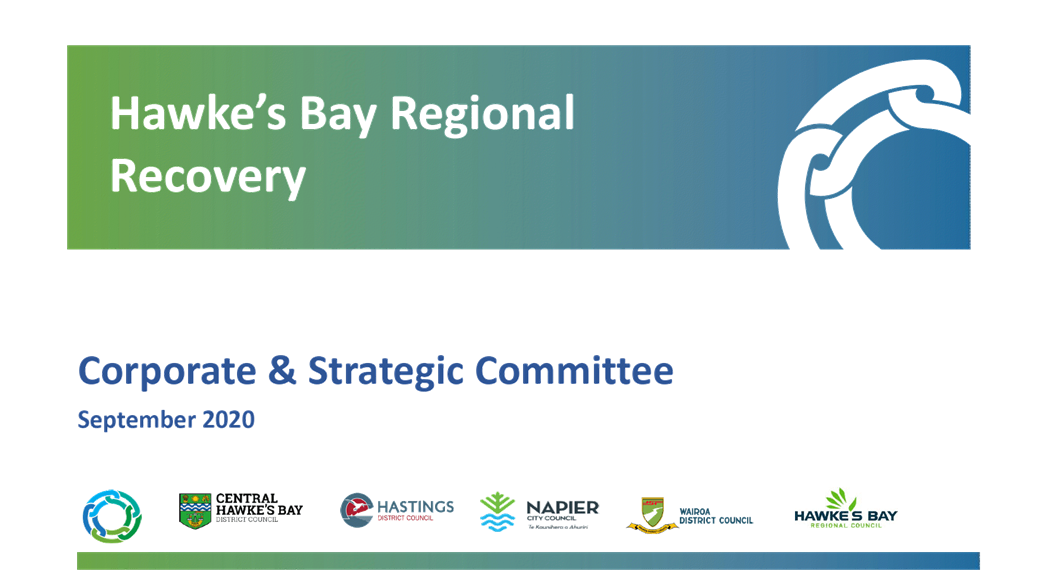
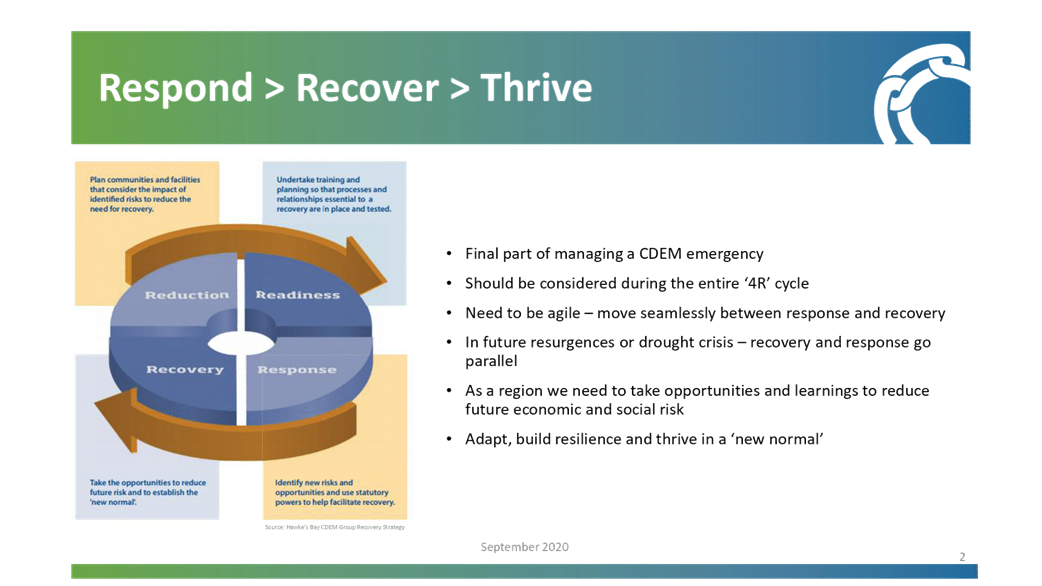
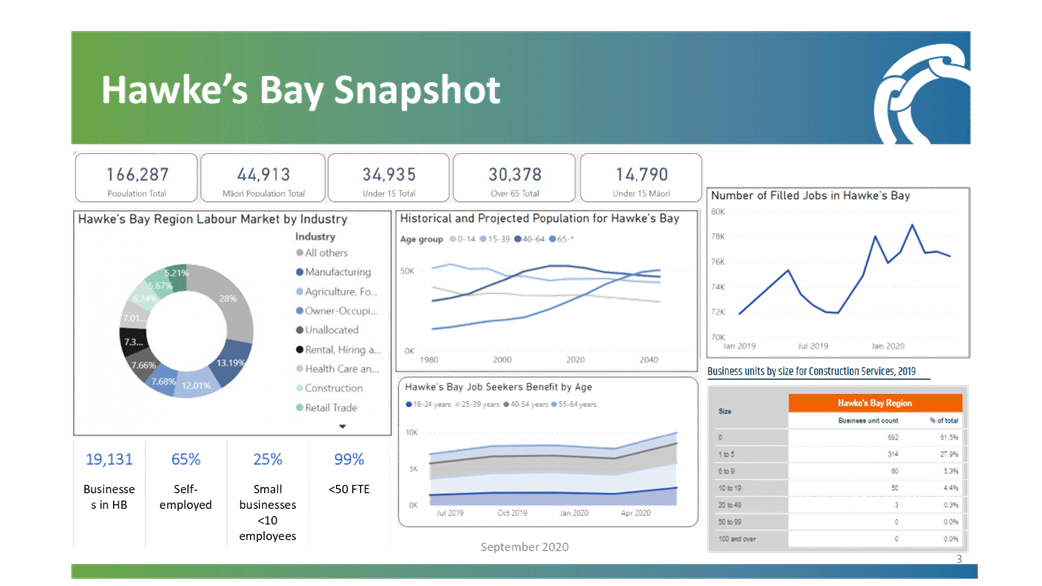
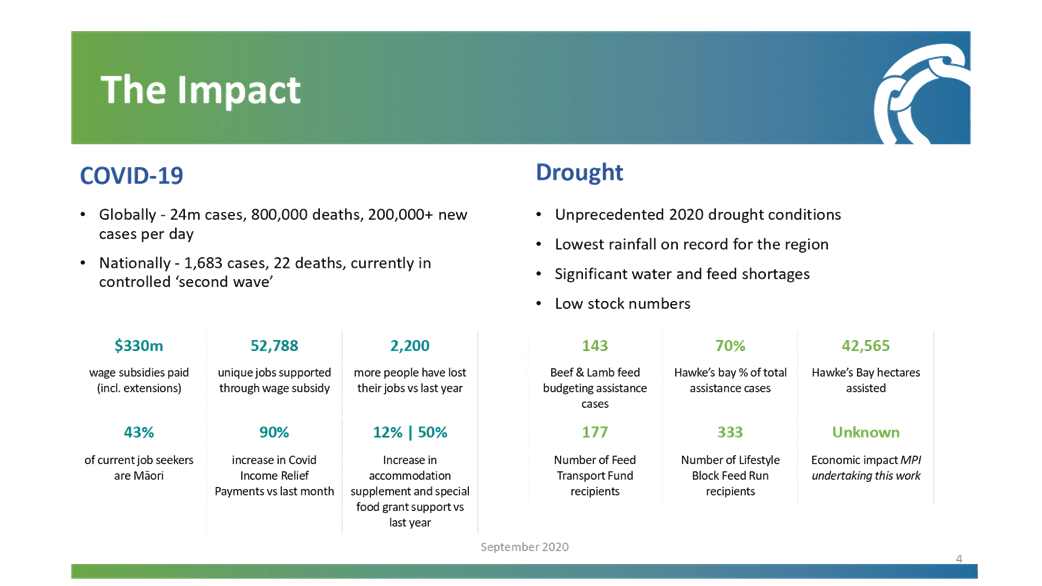
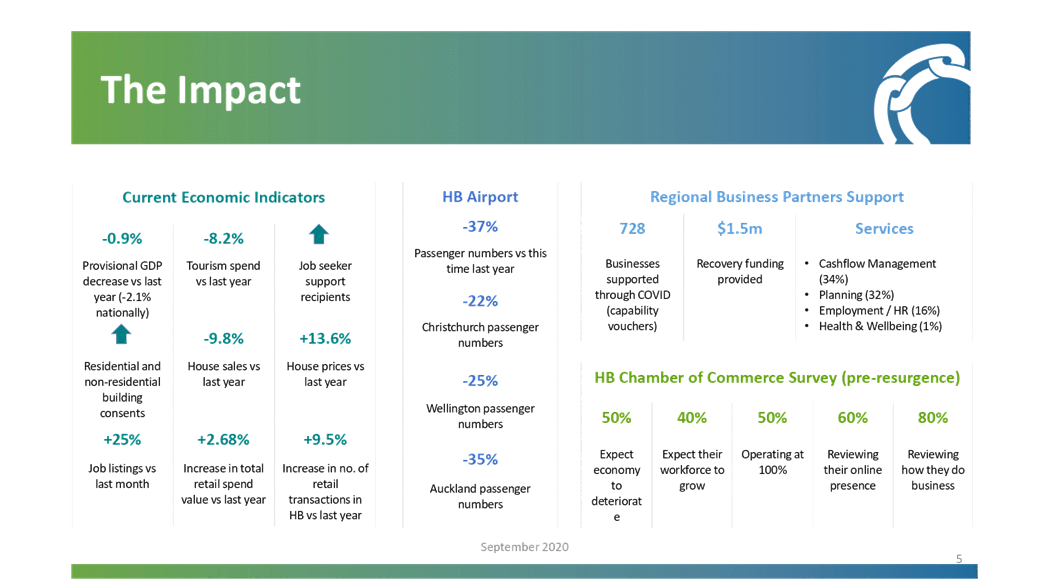
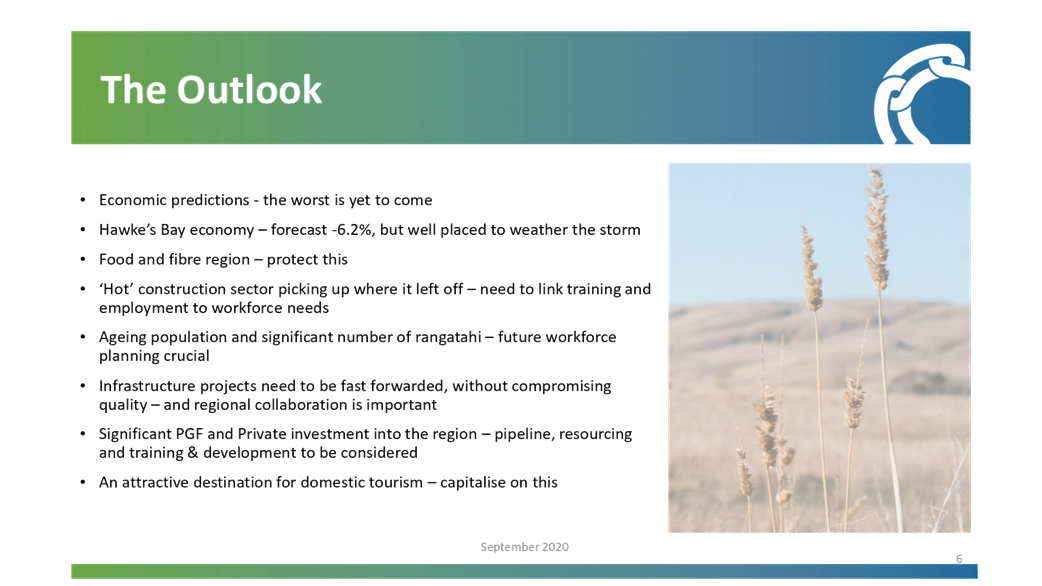
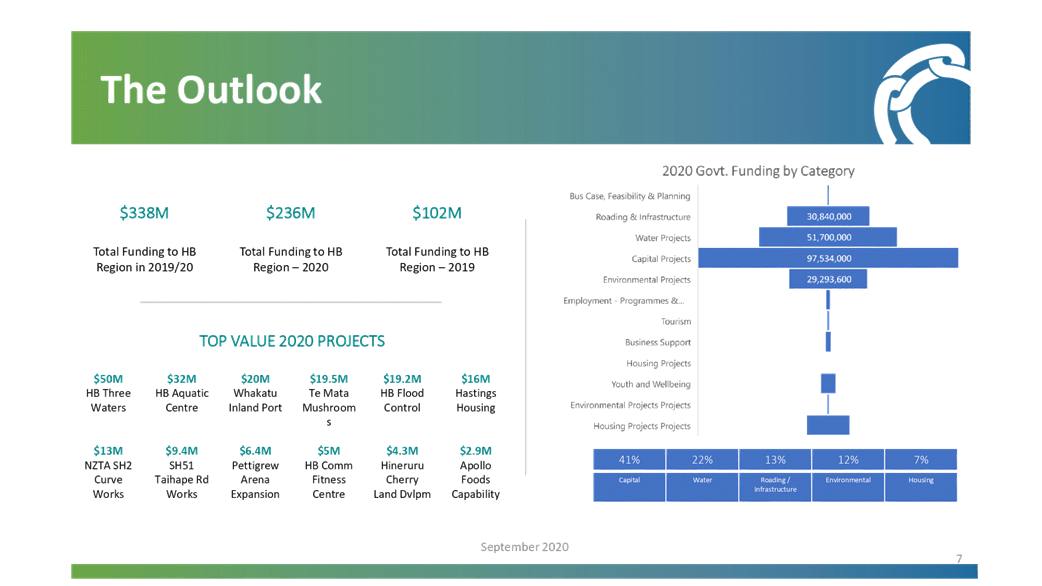
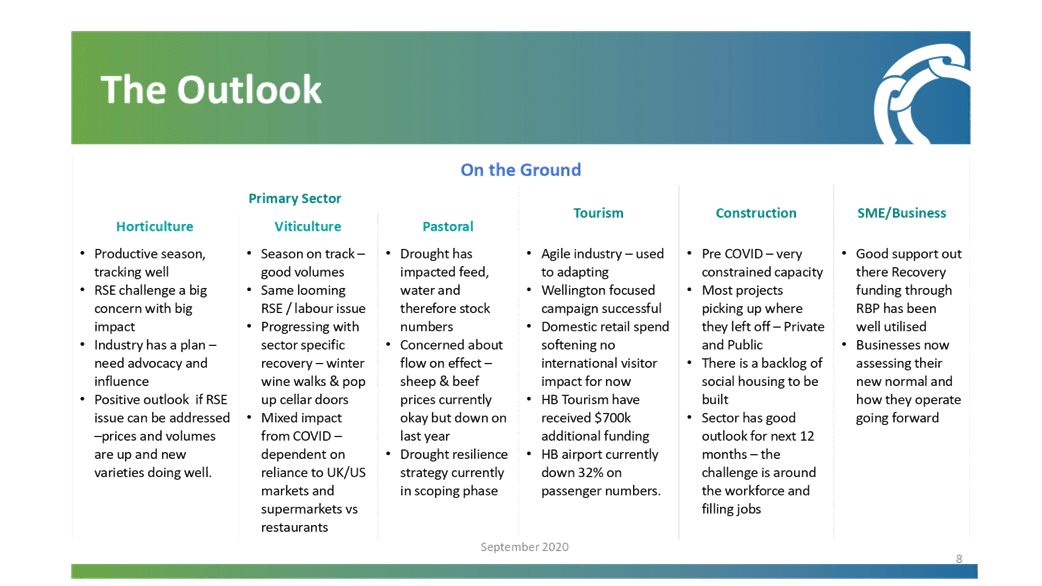
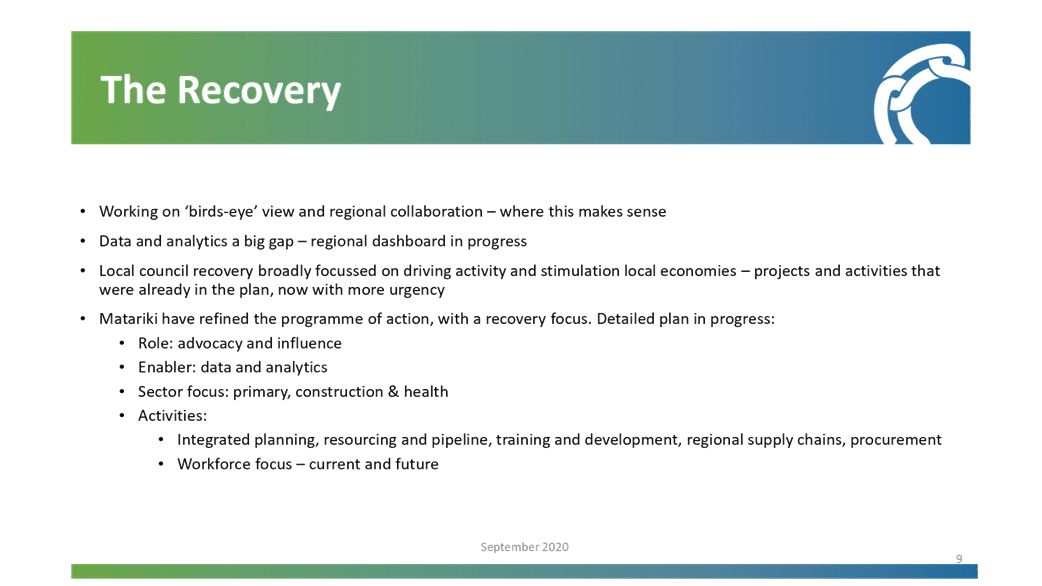
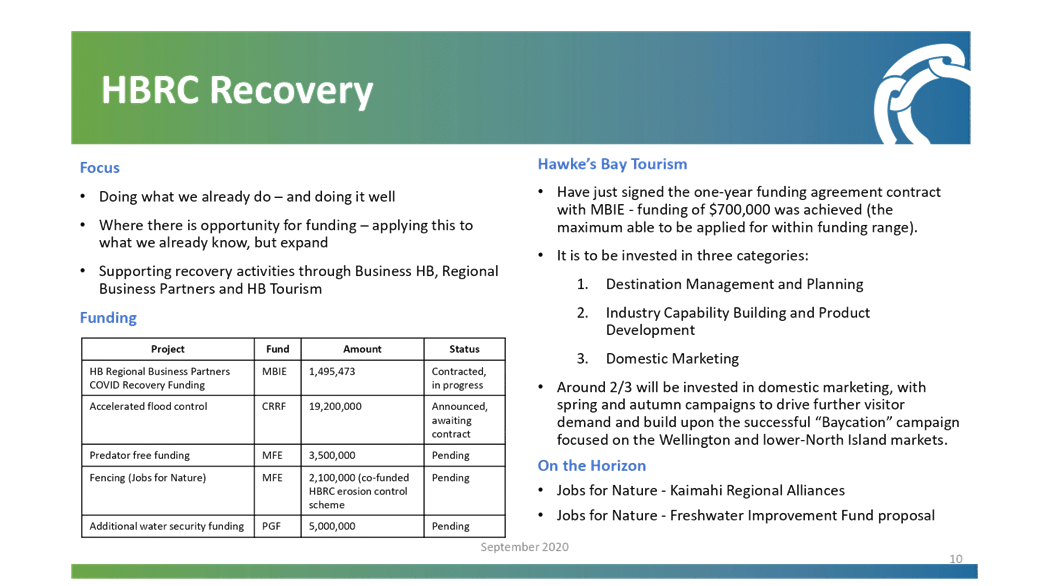
HAWKE’S BAY REGIONAL COUNCIL
Corporate
and Strategic Committee
Wednesday 02 September 2020
Subject: Eastern Screen Alliance
Deputation: Building a Regional Screen Industry in Hawke's Bay
Reason for Report
1. This item introduces a presentation by Patrick Sherratt, Daniel
Betty and Derek Slade from Eastern Screen Alliance (ESA).
Background
2. Eastern Screen Alliance has been approached by a New Zealand company
wanting to build production studios in Hawke’s Bay. They were also
advised that the company’s connections with the big US companies also
means they can potentially funnel big-budget productions into the region.
Because Covid has shut down the US industry, the industry is looking to NZ to
keep making productions (and keeping up with an increasing consumer demand for
screen content) and it has been suggested that if there was a studio complex in
Hawke’s Bay, the door would be open to bringing them here.
3. Patrick Sherratt of Eastern Screen Alliance has been helping this
company find land and they are close to starting the process of purchase and
obtaining resource consents. ESA advises that Hastings District Council has
been supportive of the proposition and has granted the company $10,000 to get a
new website up and going, which should be ready in a few weeks
4. Further information is attached.
Decision Making
Process
5. Staff have
assessed the requirements of the Local Government Act 2002 in relation to this
item and have concluded that, as this report is for information only, the
decision making provisions do not apply.
|
Recommendation
That the Corporate and Strategic Committee
receives and notes the “Eastern Screen Alliance Deputation: Building
a Regional Screen Industry in Hawke's Bay” presentation.
|
Authored and
Approved by:
|
Leeanne
Hooper
Team Leader Governance
|
|
Attachment/s
|
⇩1
|
Eastern
Screen Alliance Proposal Summary Information
|
|
|
|
Eastern
Screen Alliance Proposal Summary Information
|
Attachment 1
|
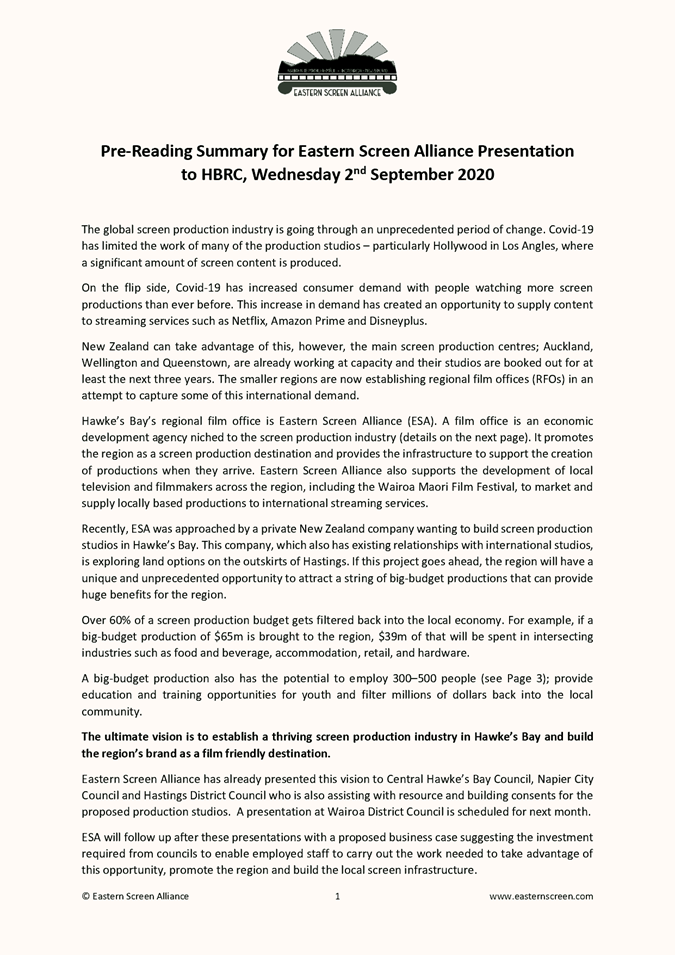
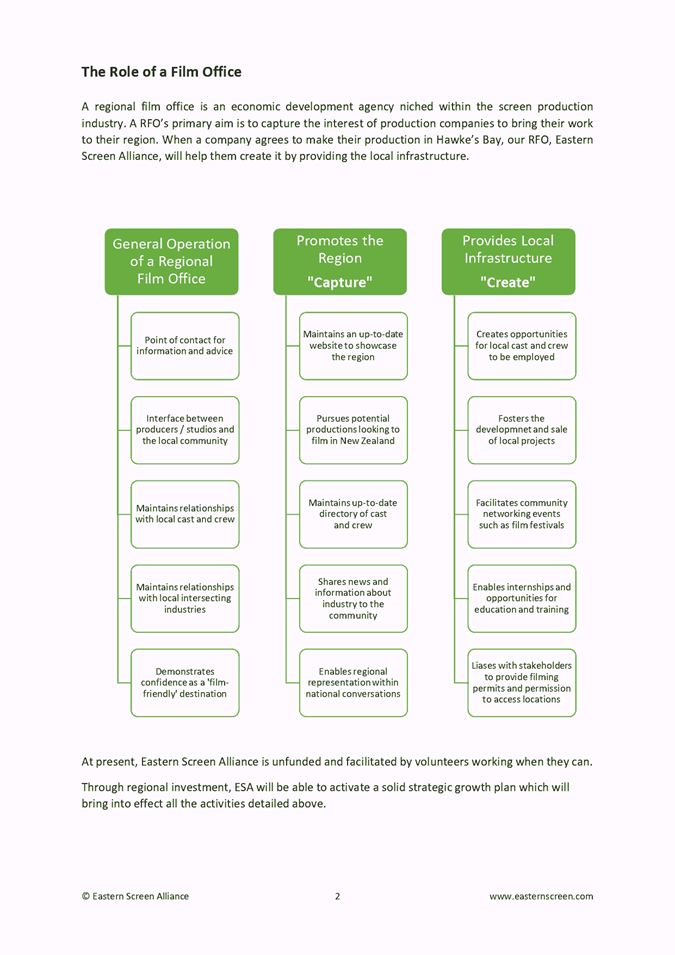

HAWKE’S BAY REGIONAL COUNCIL
Corporate
and Strategic Committee
Wednesday 02 September 2020
Subject: Discussion of Minor
Matters Not on the Agenda
Reason for Report
1. This document has been prepared to assist
Committee members note the Minor Items Not on the
Agenda to be discussed as determined earlier in Agenda
Item 5.
|
Item
|
Topic
|
Raised
by
|
|
1.
|
|
|
|
2.
|
|
|
|
3.
|
|
|
HAWKE’S BAY REGIONAL COUNCIL
Corporate
and Strategic Committee
Wednesday 02 September 2020
Subject: HBRIC Ltd and Napier
Port Quarterly Update
That Hawke’s Bay Regional
Council excludes the public from this section of the meeting, being Agenda Item
16 HBRIC Ltd and Napier Port Quarterly Update with the general subject of
the item to be considered while the public is excluded; the reasons for passing
the resolution and the specific grounds under Section 48 (1) of the Local
Government Official Information and Meetings Act 1987 for the passing of this
resolution being:
|
GENERAL SUBJECT OF THE ITEM TO BE
CONSIDERED
|
REASON FOR PASSING THIS RESOLUTION
|
GROUNDS UNDER SECTION 48(1) FOR THE
PASSING OF THE RESOLUTION
|
|
HBRIC Ltd and Napier Port Quarterly Update
|
s7(2)(h) That the public conduct of this agenda item would
be likely to result in the disclosure of information where the withholding of
the information is necessary to enable the local authority holding the
information to carry out, without prejudice or disadvantage, commercial
activities.
s7(2)(i) That the public conduct of this agenda item would
be likely to result in the disclosure of information where the withholding of
the information is necessary to enable the local authority holding the
information to carry out, without prejudice or disadvantage, negotiations
(including commercial and industrial negotiations).
|
The Council is specified, in the First Schedule to this
Act, as a body to which the Act applies.
|
Authored by:
|
Kishan
Premadasa
Management Accountant
|
Blair
O'Keeffe
HBRIC Ltd Chief Executive
|
Approved by:
|
Jessica
Ellerm
Group Manager Corporate Services
|
|
HAWKE’S BAY REGIONAL
COUNCIL
Corporate
and Strategic Committee
Wednesday 02 September 2020
SUBJECT: CONFIRMATION
OF PUBLIC EXCLUDED MINUTES OF THE 10 JUNE 2020 CORPORATE AND STRATEGIC
COMMITTEE MEETING
That Hawke’s Bay Regional
Council excludes the public from this section of the meeting being Confirmation
of Public Excluded Minutes Agenda Item 17 with the general subject of the item to be
considered while the public is excluded; the reasons for passing the resolution
and the specific grounds under Section 48 (1) of the Local Government Official
Information and Meetings Act 1987 for the passing of this resolution being:
|
|
GENERAL SUBJECT OF THE ITEM TO BE
CONSIDERED
|
REASON FOR PASSING THIS RESOLUTION
|
GROUNDS UNDER SECTION 48(1) FOR THE
PASSING OF THE RESOLUTION
|
|
Heretaunga Water Security Scoping
Report
|
s7(2)(i) That the public
conduct of this agenda item would be likely to result in the disclosure of
information where the withholding of the information is necessary to enable
the local authority holding the information to carry out, without prejudice
or disadvantage, negotiations (including commercial and industrial
negotiations)
s7(2)(j) That the public
conduct of this agenda item would be likely to result in the disclosure of
information where the withholding of the information is necessary to
prevent the disclosure or use of official information for improper gain or
improper advantage
|
The Council is specified, in the First
Schedule to this Act, as a body to which the Act applies.
|
|
HBRIC Ltd 2019-20 Statement of Intent
|
s7(2)(b)(ii) That the public
conduct of this agenda item would be likely to result in the disclosure of
information where the withholding of that information is necessary to
protect information which otherwise would be likely unreasonably to
prejudice the commercial position of the person who supplied or who is the
subject of the information
|
The Council is specified, in the First
Schedule to this Act, as a body to which the Act applies.
|
|
Napier Port Verbal Update
|
s7(2)(b)(ii) That the public
conduct of this agenda item would be likely to result in the disclosure of
information where the withholding of that information is necessary to
protect information which otherwise would be likely unreasonably to
prejudice the commercial position of the person who supplied or who is the
subject of the information
|
The Council is specified, in the First
Schedule to this Act, as a body to which the Act applies.
|
|
Request for Remission of Leasehold Rent
– Wellington Property
|
s7(2)(i) That the public
conduct of this agenda item would be likely to result in the disclosure of
information where the withholding of the information is necessary to enable
the local authority holding the information to carry out, without prejudice
or disadvantage, negotiations (including commercial and industrial
negotiations)
|
The Council is specified, in the First
Schedule to this Act, as a body to which the Act applies.
|
|
Confirmation of 11 March 2020 Public
Excluded Minutes
|
|
|
|
Authored by:
|
Leeanne
Hooper
Team Leader Governance
|
|
Approved by:
|
James Palmer
Chief Executive
|
|






























































































































































































































